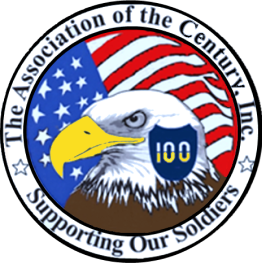Home » Corridor of the Century » Past Inductee List
Past Inductee List
Alma L. Roby
Colonel Alma L. Roby was commissioned a Second Lieutenant on 9 July 1942. During World War II he served in the European Theater with the 85th Evaluation Hospital, the 136th Evacuation Hospital and as Medical Officer of the 332nd Engineer Regiment.
In the Korean War he saw service in the 15th Station Hospital in Japan and the 8824th Engineer Construction Group. In August 1951 he joined the 100th Airborne Division as Commander of the 325th Medical Battalion. In September 1961 he was made Division Surgeon and went on active duty immediately at Fort Chaffee, Arkansas with the Division on its recall during the Berlin Crisis.
He served as Division Surgeon until September 1974 when he was reassigned to the 100th Division Maneuver Training Command as its Surgeon. Colonel Roby was active in that capacity at the time of his death on 3 April 1982.
In his long and productive military career he distinguished himself by exceptional service and dedication far beyond that of most. When the Division was recalled to active duty in 1961 Colonel Roby quickly made plans to have his large civilian pediatric practice transferred to others and arrived at the activation site with the unit. He quickly molded the medical section into one whose effectiveness was a great asset to the Division success. He had a total responsibility for medical matters involving the 3,500 division members and their families as well as for the more than 32,000 trainees who passed through the system in an eleven month period.
As the Maneuver Training Command Surgeon, Colonel Roby had the responsibility for planning, writing, coordinating, and conducting numerous exercises for army reserve, national guard and active army medical units. His creative leadership brought high praise to the Maneuver Training Command and resulted in a marked improvement in the readiness of the units involved.
His good nature and sense of humor properly tempered the military toughness and dedication of this most unusual and dedicated officer. He leaves a lasting influence on those exposed to his professional ability as a medical officer as well as a civilian doctor.
Few people who pursue a time demanding profession have displayed the tenacity and durability to wear that “second hat” as faithfully and effectively as did Colonel Alma L. Roby.
Colonel Roby was one of a very few medical officers awarded the “A” prefix to his Military Occupational Specialty.
During his career he earned the following awards and decorations.
Purple Heart
Meritorious Service Medal
Army Commendation Medal
National Defense Service Medal
Armed Forces Reserve Medal with two Hourglass Devices
United Nations Service Medal
American Campaign Medal
European-African-Middle Eastern Campaign Medal
World War II Victory Medal
Army Occupation Medal with Germany Clasp
Army Occupation Medal with Japan Clasp
Korean Service Medal with five Bronze Service Stars
Meritorious Unit Commendation
Republic of Korea Presidential Unit Citation
Posthumous Decoration:
Legion of Merit
Deceased
1983—Inducted into Corridor of the Century.
James L. Cheatham
Command Sergeant Major James L. Cheatham served on active duty in World War II from May 1944 to June 1946. During his passage from England to France, his ship was torpedoed and sunk with a loss of life of more than half of the 1,500 troops on board.
He served in the 66th Infantry Division and the 1277th Engineer Battalion in France and Germany.
In May 1950 he joined the 100th Military Police Company of the 100th Airborne Division (Organized Reserve). When the Division was reorganized from Airborne to Infantry, he was reassigned to the Assistant Chief of Staff, G-2 section where he remained until he was appointed Division Command Sergeant Major on 23 August 1965. He remained in that capacity until his untimely death on 3 March 1974.
Command Sergeant Major Cheatham’s most significant contribution to the 100th Division was his unrelenting diligence in his quest to more firmly entrench the noncommissioned officers in their rightful place of dignity, respect, and authority, thus enabling them to truly be the “backbone of the Army.” His efforts in this direction have produced a lasting effect on the character and competence of the Century Division and have been instrumental in enhancing the mission readiness of the units.
Command Sergeant Major Cheatham always portrayed the epitome of the ideal soldier in both appearance and actions. His character, rigid self-discipline, calmness under duress and logical analysis of each situation properly overshadowed the soldierly toughness of this soldier’s soldier.
During his career, he earned the following awards and decorations.
Good Conduct Medal
Meritorious Service Medal
Army Commendation Medal
European-African-Middle Eastern Campaign Medal with 2 Bronze Service Stars
World War II Victory Medal
Army of Occupation Medal with Germany Clasp
American Theater Medal
National Defense Service Medal
Armed Forces Reserve Medal with Ten-Year device
Deceased
1983—Inducted into Corridor of the Century.
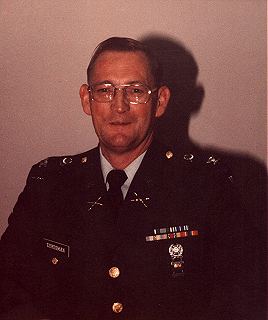
Norman D. Ehresman
Colonel Norman D. Ehresman received his commission from Senior ROTC at Purdue University and was commissioned as a Second Lieutenant on 6 August 1956 to begin a career spanning nearly three decades.
His first assignment was Battery Motor Officer of the 393rd Field Artillery Battalion. For the next twenty-seven years he served as a beacon not only to the army reserve but to his community as well.
His dedication to education led to his appointment to many leadership positions in the Army Reserve.
He joined the 100th Division in July 1971 as Operations Officer in the 2nd Battalion, 399th Regiment of the 1st Brigade and was named Battalion Commander in December 1976.
After serving as Assistant Chief of Staff, G-3 for the 100th Division and as Deputy Commander for the 2nd Brigade, Colonel Ehresman left the Division to become the Commandant of the 2074th USAR School, where he received his Colonel’s insignia in December 1980.
Upon his return to the 100th Division from the 168th Support Group in August 1983, Colonel Ehresman was named Assistant Division Commander-2, a tribute to his leadership abilities.
He was serving in this capacity at the time of his tragic death on 20 November 1983.
Known for his warmth and his enthusiasm for duty, Colonel Ehresman left a void in the lives of those with whom he served and those who knew him, not only as a fine educator, but as a great leader, a skilled officer and a professional soldier.
During his military career, Colonel Ehresman earned the following awards and decorations.
Army Commendation Medal
Army Reserve Component Achievement Medal with an Oak Leaf Cluster
Army Achievement Medal
National Defense Service Medal
Armed Forces Reserve Medal with Ten- Year device
Army Service Ribbon
Deceased. COL Ehresman died 20 November 1983.
1984—Inducted into Corridor of the Century.
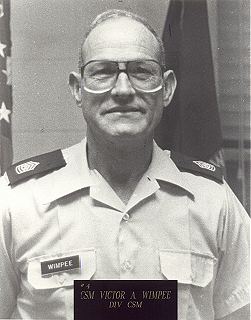
Victor A. Wimpee
Command Sergeant Major Victor A. Wimpee entered the Army in 1951 during the Korean War, beginning thirty-two years of dedicated service to his country. After the completion of his basic combat training, he was sent to Korea where he served with the 45th Infantry Division.
When the Korean War ended he returned to his native Kentucky and joined the 8830th Military Police Recruit Training Command in Bowling Green. In 1957 he became a member of the 2nd Battalion, 399th Infantry Regiment, 100th Infantry Division when the 8830th was inactivated.
Command Sergeant Major Wimpee returned to active duty again at Fort Chaffee, Arkansas when the 100th Division was called to active duty during the Berlin Crisis in 1961. During this period, CSM Wimpee’s outstanding qualities as a soldier became strikingly apparent to all who knew him. His perpetual smile and “Can Do” attitude permeated all those privileged to serve with him. Cadre, officers and trainees alike held him in the highest regard. He remained with this until 1973 when he was named Battalion Command Sergeant Major. He was appointed as Brigade Command Sergeant Major of the 1st Brigade, 100th Division in 1979.
Command Sergeant Major Wimpee’s life-time of service culminated in his appointment as Division Command Sergeant Major of the 100th Division, the Division’s highest enlisted position. He was serving in this capacity at the time of his tragic death on 20 November 1983.
Command Sergeant Major Wimpee distinguished himself as a leader and as an exceptional soldier during his long and productive military career. In his thirty two years of military service to the active army, the reserve and his country, he displayed a dedication to duty that is found in only a few persons.
During his military career, Command Sergeant Major Wimpee earned the following awards and decorations.
Bronze Star Medal
Meritorious Service Medal
Army Commendation Medal
Good Conduct Medal
Presidential Unit Citation
National Defense Medal
Korean Service Medal
Armed Forces Reserve Medal with Ten-Year device
Army Reserve Components Achievement Medal
Senior NCO Course Achievement Medal
Republic of Korea Presidential Unit Citation
Posthumous Decoration:
Legion of Merit
Deceased. CSM Wimpee died 20 November 1983.
1984—Inducted into Corridor of the Century.
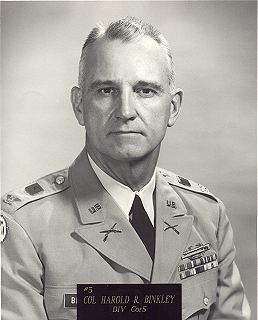
Harold R. Binkley
Colonel Binkley was one of the aggressive stalwarts in the formative days of the 100th Division as a reserve unit. Few, if any, exceeded his ability at organizing, supervising and recruiting.
His civilian occupation, professor in the Department of Vocational Education at the University of Kentucky (later head of that department) equipped him extremely well to enhance the instruction and instructors of the units of his assignment. It also put him in contact with many reserve members of the faculty and potential recruits in the student body, many of whom he brought into the division.
Colonel Binkley was a tireless, diligent, intelligent and uncomplaining worker who had an unbelievable capacity to achieve much in a short span of time. He served thirteen years as Regimental Executive Officer without complaint because there were no vacancies for promotion.
As Regimental Commander of the 400th Regiment (AIT) he did an outstanding job. Those trained under his supervision at Fort Chaffee in advanced infantry did exceptionally well when they were assigned to regular units. Reports of their superior training were numerous.
Colonel Binkley served his last two years as Chief of Staff before he mandatory retired in 1968. In that capacity his mastery of the skill of organizing and directing was at its apex. Most of the Division’s Operating Policies and Procedures (DOPP) were developed during this period. He traveled from his home in Lexington to Division Headquarters twice each week devoting almost two full days per week to the affairs of the unit.
His forceful and stern manner in conjunction with a keen sense of humor led him to be a respected favorite among the troops.
His character, devotion to duty and intellectual insight have all left a mark of excellence on the 100th Division
Now retired, Colonel Binkley was a long time faculty member of the University of Kentucky. In the last several years of his distinguished career, he was head of the Department of Vocation Education.
He and his wife have been active in community and church affairs.
His awards and decorations include the following:
Legion of Merit
Bronze Star Medal
Army Commendation Medal
European-African-Middle Eastern Campaign Medal with 2 Bronze Service Stars
World War II Victory Medal
American Campaign Medal
National Defense Service Medal
Armed Forces Reserve Medal
Deceased
1984—Inducted into Corridor of the Century
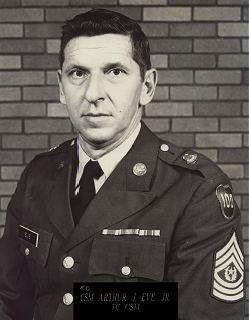
Arthur J. Eve, JR.
Command Sergeant Major Arthur J. Eve, Jr. joined the 100th Division Artillery of the 100th Division in 1947 after serving on active duty as a Section Chief of an Artillery unit. He assumed a similar duty in the 100th Division.
By 1956 his outstanding qualities as a soldier had elevated him to Battalion Command Sergeant Major, having been rapidly promoted in grade to Master Sergeant (E-7) by 1954.
When the 100th Division was called active duty in 1961, he was the Battalion Sergeant Major of the 1st Battalion, 100th Regiment, which assignment he occupied until 1964. His military bearing and expertise contributed in a large measure to the success of the mission in the active duty exercise. His calm and efficient manner, coupled with a deep concern for those who served with him made him one of the most respected members of the unit.
In August 1965, Sergeant Major Eve was promoted to the ultimate enlisted grade of Sergeant Major (E-9). In 1968 he became Command Sergeant Major of the 100th Committee Group in which assignment he remained until his death.
It was in this assignment that his true excellence was climaxed. He established a program of NCO development that resulted in an extremely high percentage of individually qualified personnel.
Additionally, he was instrumental in developing a preparatory program for enlisted MOS qualification. More than 90 percent of assigned personnel attained a passing score on the comprehensive written examination.
Command Sergeant Major Eve was respected by his fellow Noncommissioned Officers as well as all the other enlisted personnel. Additionally, he was held in the highest regard by all the officers who knew him.
His effective and faithful service will forever leave its imprint of excellence on the 100th Division.
His military awards and decorations include the following.
Meritorious Service Medal
Army Commendation Medal
Army Achievement Medal
National Defense Service Medal.
Armed Forces Reserve Medal
Deceased
1984—Inducted into Corridor of the Century.
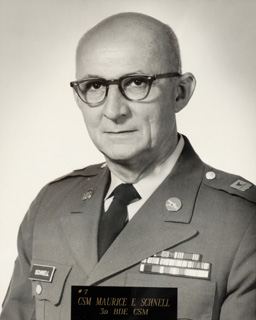
Maurice E. Schnell
Command Sergeant Major Maurice E. Schnell began his military career in October of 1943 and saw duty in Japan as part of the occupation force.
He signed up for a second three-year tour with the 397th Airborne Infantry of the 100th Airborne Division in 1946.
He served with the 397th Regiment and the 399th Regiment before joining the 1st Battalion, 400th Regiment which later became part of the 3rd Brigade in Lexington.
He was the Sergeant Major for the lst Battalion, 400th Regiment when the 100th Division (Training) was called to Active Duty during the Berlin Crisis and trained troops in advanced infantry at Fort Chaffee, Arkansas.
In 1962, he was promoted to the grade of Command Sergeant Major and held this position with the 1st Battalion of the 400th Regiment, 3rd Brigade at Lexington until his retirement in April 1974.
During his service with the 100th Division, Command Sergeant Major Schnell led his unit during Annual Training at six different army posts.
Command Sergeant Major Schnell distinguished himself as an exceptional soldier and leader during his long and very successful military career. His thirty years in the service produced a list of well-trained troops in both the active army and the army reserve.
His record stands as a model for those reservists in his unit and in the division.
His military awards and decorations include the following.
Army Commendation Medal
Good Conduct Medal
National Defense Service Medal
Army Reserve Components Achievement Medal
Asiatic-Pacific Theater Medal
World War II Victory Medal
Army of Occupation Medal with Japan Clasp
Armed Forces Reserve Medal
Deceased
1984—Inducted into Corridor of the Century.
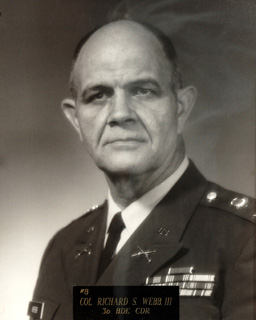
Richard S. Webb III
A dedicated, dynamic, imaginative and forceful officer, Colonel Webb’s outstanding contributions to the 100th Division have left their permanent imprint on it.
His loyalty and work ethic serve as a model for all to follow. It was not uncommon for him to arrive at the armory almost daily several hours before scheduled opening time. There he formulated his plans, made job assignments and fully exercised his command responsibilities. He then proceeded to his civilian responsibilities arriving before his employees.
In the early days of the Division, he served as a Platoon Leader in the 397th Parachute Infantry Regiment for four years. He was transferred to an MP unit and rose to the position of Battalion Commander. In 1969 he was brought back to the 100th Division as a Brigade Commander. In the ensuing five years his accomplishments were phenomenal.
He established the REP training program for enlistees awaiting space for training at the Active Army BCT training centers. This activity attracted national recognition and commendation for the Division.
He developed the ROTC Leadership Program at the University of Kentucky, Eastern Kentucky University and Western Kentucky University for which he received the Legion of Merit and special recognition from the Chief of Staff of the Army.
His Brigade was the first to convert from Infantry to Armor. He established a two year program for this which many thought to be an impossible goal. After one year 90 percent of the personnel were MOS qualified in their new assignment.
Another noteworthy innovation includes the initiation of the “Golden Hat” award for outstanding drill sergeants. He also was responsible for organization of Junior ROTC rifle marksmanship matches. He was the first to enlist a female into the Division and the first officer to receive the Benjamin J. Butler Community Service award.
Colonel Webb is truly one of the 100th Division’s superior members.
His awards and decorations include the following:
Legion of Merit with Bronze Oak Leaf Cluster
Army Commendation Medal
Army Achievement Medal with two Bronze Oak Leaf Cluster
Good Conduct Medal
European-African-Middle Eastern Campaign Medal with two Bronze Service Stars
World War II Victory Medal
National Defense Service Medal
Armed Forces Reserve Medal
Deceased. COL Webb died 13 March 1999.
1984—Inducted into Corridor of the Century.
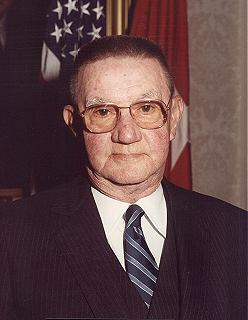
Caperton Shouse
Following several years of active duty of stateside service during World War II, Mr. Shouse joined the 100th Division on 9 May 1954 as a member of the 925th Field Artillery Battalion and as a Unit Technician. From that date until this his loyalties, generosity and ability to get the job done are exceptional.
Often working quietly behind the scenes, without fanfare or notice, he was achieving and acquiring for the benefit of the unit. He was ever alert to the requirements of the regulations under which the unit operated and was of irreplaceable value to the commanders he served. Among that group have came five Division Commanders as well as numerous Brigade Commanders.
He received five superior performance awards as civilian Supervisory Staff Administrative Assistant.
Mr. Shouse has been a tireless worker for the Association of the Century and has personally recruited many of its life members. His presence at every Executive Board meeting is almost automatically insured.
Mr. Shouse as a life member of the Reserve Officers Association of the United States, has been highly active in the Department of Kentucky for many years and continues through this date.
Additional, he has, over the years, been a prime mover in the social affairs of the division, the Association of the Century and the Department of Kentucky, Reserve Officers Association, seeing that all facets of the event were in proper order and that everything proceeded as scheduled.
Mr. Shouse personally recruited many of the members of the unit, particularly in the formative years when this task was an additional one for unit members and there were no recruiters as such.
His awards and decorations include the following.
Army Commendation Medal with Bronze Oak Leaf Cluster
Good Conduct Medal
American Defense Medal
American Campaign Medal
Army Reserve Components Achievement Medal
Armed Forces Reserve Medal
World War II Victory Medal
Deceased. CW4 Shouse died 25 December 1999.
1984—Inducted into Corridor of the Century.
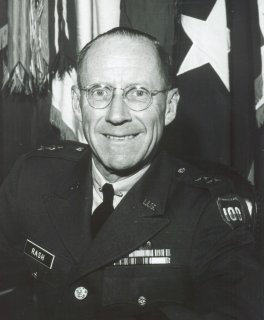
Dillman A. Rash
General Rash is perhaps best known for his accomplishments during the Berlin Crisis call-up of 1961-62. He was the Division commander during that exercise which proved that the Reserve forces were indeed viable, worthy and a necessary part of the military forces of America.
General Rash was born 21 July 1907 at Earlington, KY.
Prior to his assignment in the 100th Division, General Rash had served many years in the Artillery and Quartermaster units of the Army National Guard of Kentucky.
He was commissioned a Second Lieutenant from Princeton University ROTC in 1930.
He entered on active duty January 1941 in World War II and served in the European Theater of Operations in highly responsible logistical positions which were of critical importance in keeping the combat units properly supplied. His assignments included Instructor, Command and General Staff College; a Battalion Commander in 113th Quartermaster Regiment; Acting G-1, 38th Infantry Division and service with the G-4 Section, European Theater of Operations as Supply and Evacuation Officer; Executive Officer of Procurement Division Supply Branch; Executive Officer, Assistant G-4 and Chief, Distribution Branch. Prior to his European assignments, he had served some two years on the faculty of the Command and General Staff College at Fort Leavenworth, Kansas.
General Rash, then a Colonel, was assigned to the 100th Division in January 1949 as Division Artillery Commander. The division was then airborne and he soon enrolled in the Parachute School at Fort Benning, Georgia, where he received his Parachutist Badge after successfully completing the course and setting a pace for the rest of the class who were much younger than he.
In May 1959, he assumed command of the 100th Division and guided it through reorganization from an Infantry Division to a Training Division. He set high standards and lived by them. He extracted maximum results from his subordinates through his “Three-C” program of “Courtesy”, “Correctness” and “Completion.”
By 1961, the 100th Division had established itself as a formidable unit under his expert tutelage. It was this high state of readiness that prompted the Secretary of the Army to activate the division in the 1961 call-up. The division was the choice of the thirteen such units in the Reserve. This was the largest reserve unit to be activated in that period.
General Rash is well known in business circles, not only locally, but state wide and nationally as well. For a businessman of his stature to absorb himself so deeply and successfully in the reserve structure added the greatest of creditability to the military forces.
His awards and decorations include the following.
Legion of Merit with Bronze Oak Leaf Cluster.
Bronze Star Medal.
American Defense Service Medal.
American Campaign Medal.
European-African-Middle Eastern Campaign Medal with two Bronze Service Stars.
World War II Victory Medal.
Army Occupation Medal with Germany Clasp
Armed Forces Reserve Medal with two Hourglasses Devices
Parachutist Badge.
French Medaille de Reconnaissance.
Deceased. General Rash died 7 September 1998.
1984—Inducted into Corridor of the Century.
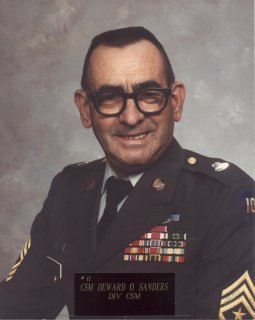
Deward O. Sanders
|
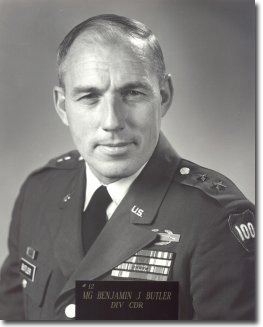
Benjamin J. Butler
A distinguished and highly decorated combat veteran of World War II, General Butler is known in the military as well as the civilian community as “Mr. 100th Division”. Perhaps no other person has had the impact on the 100th Division as he.
A veteran of more than 400 days of front line combat in Africa and Italy, he rose rapidly to become one of the youngest battalion commanders in World War II. His units were noted for their successes that were often achieved by his personal participation, twice leading bayonet assaults to reach difficult objectives.
He joined the 100th Division as Regimental Executive Officer in 1946 after leaving active service. Shortly thereafter he became Commander of the 397th Regiment, a position he was to occupy for thirteen years. He set high standards and demanded full performance of all. Attention to duty, discipline, the basics of soldiering, alertness to correct weaknesses, a keen sense of humor, a true concern for others and an ability to absorb names were all his forte. These he imparted to many of his subordinates, six of whom have become general officers.
In 1960 he became Assistant Division Commander and was serving in that capacity when the division was called to active duty in September 1961. General Butler assembled an advance party of some 120 persons and was on site with them in nine days after the call was announced. Some twelve days later the mobilization site was changed so he had the herculean task of preparing another post to receive the main body in only nine days.
There he was put in charge of all basic combat training. Despite numerous obstacles, which were overcome in due course, the 100th produced the finest of soldiers to the complete amazement of the active forces. It was not unusual to see General Butler in bivouac, barracks, mess hall, training area or test area where he developed great rapport with cadre and trainee alike.
In 1964 he assumed command of the Division. One of his first objectives was to implement a career management program which was in later years to be followed by the entire reserve program. The division stood at the top of the list in strength and readiness.
In 1970 General Butler stepped aside to give the command to his Assistant Division Commander. This was in consonance with the career management program he had helped devise. For the next three years he served as Assistant Deputy Chief of Staff for Operations and Training, a mobilization designee position at Department of the Army.
In 1973 General Butler was returned to assume command of the 100th which assignment he held until his retirement in 1977.
From 1963 to 1967 General Butler served on the General Staff Committee of the National Guard and Army Reserve Policy Board. It was during this period that the merger of the Army National Guard and Army Reserve was set forth by the Secretary of Defense. He was at the “eye of the storm” in this controversy and one of the outspoken stalwarts in the opposition to it. He dared take strong issue with the Secretary of the Army and the Secretary of Defense. His promotion to Major General lay on the desk of the Secretary of the Army for almost one year. This performance typified the man who always placed principal above personal gain.
General Butler has been a key figure in the Association of the Century, serving as Chairman of the Board since its inception. He has made numerous contributions to it in a variety of ways.
The MG Benjamin J. Butler USAR Training Center is the end result of some thirteen years of effort by General Butler. The David Barrow USAR Training Center in Lexington was also a product of his initiative.
His awards and decorations include the following:
Distinguished Service Cross
Distinguished Service Medal
Silver Star Medal
Legion of Merit
Bronze Star Medal
Purple Heart
Army Reserve Components Achievement Medal
National Defense Service Medal
Armed Forces Reserve Medal
American Defense Service Medal
American Campaign Medal
European-African-Middle Eastern Campaign Medal with five Bronze Service Stars
World War II Victory Medal
Combat Infantry Badge
Glide Badge
French Croix de Guerre
Italian Cross of Military Valor
Deceased. General Butler died 14 October 1998.
1984—Inducted into Corridor of the Century
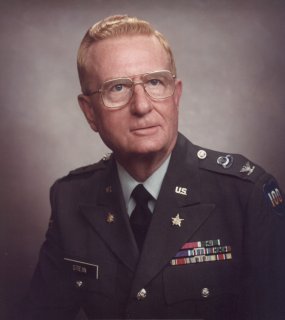
Frank B. Stein
Colonel Stein served in the 1st Armored Division in Africa and Italy during World War II after receiving his commission from OCS in 1942. Initially commanding a tank platoon, he was later assigned to the 81st Recon Squadron. In the latter days of the Italian Campaign, he was wounded by a land nine and returned to the United States.
In 1946, he joined the Army Reserve where his abilities and expertise advanced him to the position of Commander, 2045th Reception Station, later redesignated as the 100th Reception Battalion. This unit was noted for its innovative procedures, its efficiency and high state of readiness.
In 1968, this unit was made a part of the 100th Division. In due course, Colonel Stein was mandatory promoted to his current rank for which there was no vacancy. He requested permission to remain in the 100th Division on a non-pay status. For some eighteen months he served in that status, being in charge of the Awards Board.
His enthusiasm in this capacity was not diminished and he continued to contribute to the success of the unit in many ways. In 1973, he was made Chief of Staff and in that assignment his true worth became most evident.
Almost daily, he appeared at the armory where he meticulously checked on all items of concern to the unit. His use of the staff was superior and he kept the commander informed almost daily of actions being considered and taken. He never brought to a him a problem without also having suggested a practical solutions.
His quiet, unflappable manner and deep sense of humor increased the favorable results he sought to achieve. He had the great ability to say “No” at the proper time without causing offense nor resentment.
Colonel Stein enjoyed fine rapport in the community and from this was able to enlarge the image of the division in the civilian section. He has stood ever ready to assist in any function of the unit and has been a valued asset to the Association of the Century in its activities. His contributions over years have greatly enhanced the stature of the 100th Division.
His awards and decorations include the following:
Legion of Merit
Purple Heart
Army Commendation Medal with Bronze Oak Leaf Cluster
American Campaign Medal
European-African-Middle Eastern Campaign Medal with three Bronze Service Stars
World War II Victory Medal
Army Reserve Components Achievement Medal
Armed Forces Reserve Medal with two Hourglass Devices
Deceased. Colonel Stein died 23 February 2006.
1984—Inducted into Corridor of the Century.
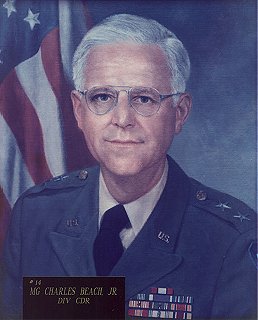
Charles Beach Jr.
A veteran of World War II service and the epitome of an American Citizen Soldier, General Beach had a most distinguished military and civilian career while providing courageous leadership for soldiers in combat and peacetime as well as for members of the civilian community.
General Beach graduated from the Virginia Military Institute (VMI) in 1940 and was commissioned a 2d Lieutenant in the Field Artillery which at that time was composed of pack mule artillery and ski troops operating in mountain warfare. His first unit, the 602nd Pack Artillery Battalion entered into World War II by deploying to the Aleutian Islands. The unit later transferred to the European Theater in January 1944. Seriously wounded in Italy on May 8,1945, General Beach was evacuated and remained in a Army Hospital for eight months. Beach returned to duty and was assigned to the 262d FA Battalion, Camp Shelby, Mississippi. At the time of his release from Active Duty on March 6, 1946, Major Beach was a battery commander with the 46th FA Battalion at Fort Campbell, Ky.
Answering the ‘call to duty’ once more, General Beach was re-commissioned as a Major in 1957 and in 1959 joined the Army Reserve’s 100th Division (TNG) as Executive Officer of the 1st Battalion, 397th Regiment (BCT). In September of 1961, his unit was called to Active Duty at Fort Chaffee, Arkansas as part of the 100th Division call up for the Berlin Crisis. In October of 1961, Beach assumed command of the 1st Battalion, 397th Regt. The unit reverted to reserve status in August 1962 and Beach remained the Commander until being assigned as Executive Officer of the 397th Regiment in November of 1964. In December, 1966 Beach took command of the 397th Regiment in Lexington, Ky. In January 1968, he was selected to command the newly formed 1st Brigade, 100th Division in Lexington and later served as Commander of the 3d Brigade, 100th Division in Lexington. General Beach became the Assistant Division Commander of the Century Division in April of 1971 and was promoted to Brigadier General in May of 1972. He assumed command of the 100th Division on July 30, 1976 and was promoted to Major General that same year.
Commanders at higher levels of command recognized the programs initiated by General Beach and used them as standards and guides for other reserve units to follow. General Beach gained much recognition for the 100th Division throughout the nation. Because of his well thought out programs and initiatives, General Beach was selected as the President of the Senior Army Reserve Commanders Association and had the responsibility for advising the Chief of Staff of the Army on problems unique to the Reserve Components. Needless to say, the success of the Division program was shared at the highest levels in the army and many were adopted for implementation.
General Beach focused on strength maintenance and quality training during his command. To overcome recruiting and retention difficulties and anti-military sentiment, he personally directed an all out campaign to elicit support for the division from college and university officials, business and civic leaders, elected officials and former members of the division. This program formed the idea and basics when General Beach began the organization of the Association of the Century.
A most significant and far reaching program, developed and implemented by General Beach was his recommendation to the Commander of Fort Knox and the Department of the Army that the 100th Division conduct a major reorganization of the 1st and 2d Brigades of the 100th Division to train armor soldiers for the army because of readily available armor facilities. In 1977-1978, the Division reorganized and the soldiers trained in armor skills far exceeding the expectations of his superiors. General Beach fostered a very close working relationship with the active component counterparts, which continues to exist and has had a significant impact on the Division and the Army as a whole. Many of his training techniques and programs adopted for this transition are currently being used by many other reserve units and commands as they conduct reserve training.
Perhaps the best description of General Beach and his contribution was summed up by General Caldwell, Commander Fifth U.S. Army, when he stated, “Charlie is the most respected and professional commander I know. He is wise, knowledgeable and dedicated. He is our finest.”
Awards and Decorations Include:
Distinguished Service Medal
Purple Heart
Army Commendation Medal
American Campaign Medal
Asiatic-Pacific-Campaign Medal
European-African-Middle Eastern Campaign Medal
World War II Victory Medal
Army Reserve Components Achievement Medal
National Defense Service Medal
Armed Forces Reserve Medal
1984—Inducted into Corridor of the Century.
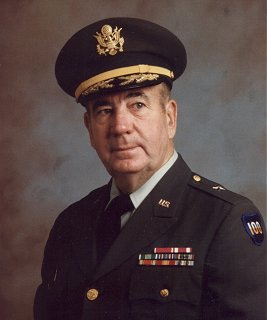
Edward W. Gaupin, Jr.
General Gaupin entered the army in August 1942 as a private and through his junior ROTC background was soon selected for Engineer OCS, graduating in February 1943. His foreign service in the ETO during the period June 1943 to November 1945 included assignments as an Administrative Officer, Engineer Depot Operations Officer on delivering and erecting large steel bridges throughout the First and Third Armies, to include demolition preparation of the Port of Antwerp during the Battle of the Bulge,
In 1946, he was assigned to the 100th Division and distinguished himself in both staff and command assignments until retirement in March 1976. During the Berlin Crisis, he served as Division Assistant Chief of Staff, G-1; and Executive Officer, 399th Regiment at Fort Chaffee.
As Commander, 399th Regiment, General Gaupin distinguished himself that within 18 months after assumption of command, the 399th became the most outstanding regiment in the division. This was achieved through countless hours and many miles of travel visiting his fifteen subordinate units stressing high standards of performance within the regiment. Many of these trips were at no expense to the Government.
General Gaupin’s foresight for a need of a provisional committee group within the division resulted in a group being formed from units within the division and satellited upon the active counterparts during Annual Training at Fort Jackson in 1967. This group received recognition by not only training instructors, but also completing all engineering surveys of the combat ranges at Fort Jackson.
In June 1968, the Committee Group was activated and General Gaupin was assigned to command the “Cadre” of officers and enlisted soldiers. By August, this unit was expanded to full authorized strength who were unskilled in their new assignments. It was through his unsurpassed knowledge of training techniques that enabled him to develop this group within eight months to attain a high proficiency plateau.
His willingness to accept dual responsibilities with vigor, determination and meticulous pursuit resulted in his making tough decisions without fear or bias.
He held a concurrent assignment as Executive Officer, Provisional Brigade that had primary responsibility as a reaction force to control rampant civil disturbances for the City of Louisville and contingency support plans for other major cities within the state.
The success of the Field Training Exercise and Command Post Exercise conducted in riot control in May 1969 received laudatory comments from higher headquarters for his well planned operations and accomplishments.
In April 1970 he became an Assistant Division Commander and was promoted to Brigadier General. He motivated the units under his supervision into a high state of readiness.
General Gaupin was most active in a wide variety of civic affairs and military associations. He was President of the Department of Kentucky, Reserve Officers Association; Chairman of the Louisville Armed Forces Committee; Chairman of the Military Committee working with the Louisville Chamber of Commerce and president of several civic associations in the community.
His awards and decorations include the following:
Legion of Merit.
Meritorious Service Medal.
Army Commendation Medal.
American Campaign Medal.
European African Middle Eastern Campaign Medal with three Bronze Service Stars.
World War II Victory Medal.
Army of Occupation Medal with Germany Clasp.
National Defense Service Medal.
Armed Forces Reserve Medal with two Hourglass Devices.
Deceased. General Gaupin died 22 October 1998.
1985—Inducted into Corridor of the Century.
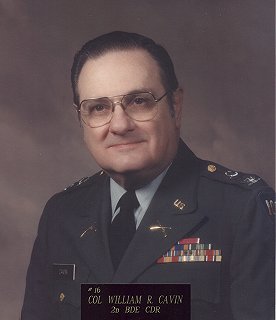
William R. Cavin
Colonel Cavin was a faithful servant to the Army Reserve program and to the 100th Division for a period covering nearly thirty-three years. He was a pioneer in the establishment of a reserve program in the city of Owensboro, Kentucky.
Colonel Cavin enlisted in the U.S. Army Air Corps on December 7, 1942, being commissioned a Second Lieutenant on August 12, 1944. He served in the ETO from February 1945 until August 1945 as a Bombardier/Navigator. He was released from active duty to the Reserve in 1945. While in the Reserve, he served in the Quartermaster, Civil Affairs and Infantry branches. He completed the Command and General Staff Officers Course in 1968. He serve as Adjutant of the 311th Military Government Group from 1955 to 1959, and as Adjutant of the 398th Regiment from 1959 to 1965. He commanded the 1st Battalion, 398th Regiment from 1966 to 1970 and as Executive Officer, 2nd Brigade from 1965 to 1966 and April 1970 to July 1970. He assumed command of the 2nd Brigade in 1970 and served in that position until his retirement in 1975. He served on active duty with the 100th Division during the Berlin Crisis as the Adjutant of the 398th Regiment.
During his entire service with the 100th Division, Colonel Cavin displayed outstanding leadership and devotion to duty. This was reflected by the increase of morale, esprit de corps, personnel strength, high reenlistments and the dramatic increase of MOS qualification. At the time Colonel Cavin assumed command of the Brigade, esprit de corps was very low, but because of his dynamic leadership, strong personality and desire for unit accomplishment, he raised the attitude of the unit to “Can Do” of the highest degree. His jovial personality, keen sense of humor and tremendous drive for achievement made Colonel Cavin one of the favorites of the division.
The Brigade under Colonel Cavin’s direction, started many new training concepts which greatly increased the MOS qualification. He personally came up with the idea of using a “Wheel of Fortune” as a means of increasing MOS knowledge as well as that of basic subjects. This was used in the form of a game or contest between individuals and units. Units of the brigade worked on weekends with BCT training units at Fort Knox, using the “Helping Hand” concept later adopted by the Army. This was of great benefit not only to the reservist, but also to the cadre and trainees at Fort Knox.
Colonel Cavin kept all of his subordinate units active in community relations. In 1972 one unit of the brigade won the First U.S. Army Small Unit Community Relations Award and was first runner-up at the Department of Defense competition. Another unit was featured on the front cover of the Army Reserve Magazine and participated in a Department of the Army film. His command was most active in many areas including Boy Scouts, 4H Clubs, blood drives and competitive pistol matches.
Colonel Cavin always maintained outstanding relations with his active army counterparts both during and after Annual Training. His brigade received many commendations, maintained high ratings and was mobilization ready. His never quit attitude earned him the name of “Charlie Brown” which, to this day, he is affectionately called by former associates.
His awards and decorations include the following:
Legion of Merit
Air Medal
Army Commendation Medal
Army Reserve Components Achievement Medal
National Defense Service Medal
Armed Forces Reserve Medal
American Campaign Medal
European-African-Middle Eastern Campaign Medal
World War II Victory Medal
Army of Occupation Medal with Germany Clasp
1985—Inducted into Corridor of the Century.
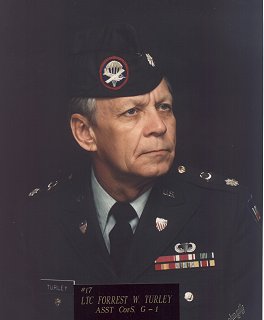
Forrest W. Turley
FORREST W. TURLEY
Lieutenant Colonel, AGC, AUS, Retired
Lieutenant Colonel Turley began his military career by enlisting in the Indiana National Guard in April 1948. He rose through the enlisted ranks from Private to Sergeant during a three and a half year period. He completed the Officer Pre-Commission requirements and was commissioned a Second Lieutenant in the Medical Service Corps, then served as the Medical Platoon Leader for an Infantry Battalion.
He transferred from the Indiana National Guard to the 325th Medical Battalion of the 100th Division in November 1955. While assigned to this unit he served as a Platoon Leader in the Clearing Company, Assistant Training Officer and then Training Officer/S3, receiving a citation for his outstanding accomplishment in upgrading the quality and standards of training for the battalion.
He was assigned to the Adjutant General’s section of Headquarters 100th Division in 1958, filling the position of Division Postal Officer. During the Berlin Crisis in 1961, he volunteered to serve as the Coordinating Officer for the AG Section Advanced Detachment to first Fort Polk and then to Fort Chaffee. During this tour of duty he supervised and coordinated all postal service for the Division and in addition performed extensive services in all other sections of Division Headquarters. He was very active in the Fort Chaffee Jump Club and when the 100th Division reverted to Reserve status, he extended his tour of duty to attend Airborne School at Fort Benning. Upon returning to an reserve status he held various positions within the AG Section, continuing his practice of freely giving of his personal time to enhance the operations of the entire division. He developed the program for personnel management policies that later formalized the forerunner of the present officer/NCO personnel management program.
During the eight. years he held the position as Division Adjutant General, he developed an extremely strong corps of enlisted and officer personnel in MOS qualification and job performance. The spirit of unit and devotion to the AG Section was evident in the high degree of productivity and willingness of section personnel to be a part of the “Vo1unteer Extra Night Meetings.” As Adjutant General he was responsible for establishing a line of communication that improved the work relationship and flow of administrative matters between division headquarters and subordinate commands.
As Assistant Chief of Staff, G-1, he directed the NCO retention boards for the division. Conducted personnel workshops requiring numerous hours of unscheduled periods of time, displayed exceptional competence and service to the command to provide high quality recommendations regarding the placement of key personnel within the division, and excelled in all administrative matters pertaining to the functions of the division.
His tenure as Adjutant General and G-1 is one of the longest periods of duty in these positions by a Reservist. He served six consecutive division commanders in such capacity.
He is one of the charter members responsible for the forming of the Association of the Century, and through his additional efforts, a system of perpetually financing was established to recognize outstanding personnel of the division.
In retirement he unhesitatingly continues to contribute his time and efforts to assist the 100th Division wherever and wherever the need arises.
His awards and decorations include the following:
Legion of Merit
Meritorious Service Medal
Army Commendation Medal with Bronze Oak Leaf Cluster
Army Reserve Components Achievement Medal
National Defense Service Medal
Armed Forces Reserve Medal with two Hourglass Devices
Parachute Badge
1985—Inducted into Corridor of the Century.
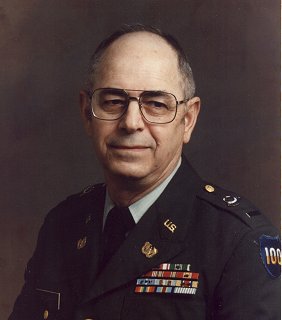
Victor L. Richey
Mr. Richey performed in positions of great responsibility during a career spanning over 38 years. At the time of his retirement, December 31, 1983, Mr. Richey was Personnel Officer, Headquarters 2nd Brigade of the 100th Division. During his distinguished military career, most of which, 26 years, with units of the 100th Division in western Kentucky, he was assigned to and developed expertise in positions involving personnel and administration. Mr. Richey served three periods of active duty, the last being with the 100th Division during the Berlin Crisis of 1961-1962. During that period, he was Personnel Officer, Headquarters 399th Regiment. His reserve time in the 100th Division was spent with the 399th Regiment, 2nd Battalion in Bowling Green and the 3rd Battalion in Hopkinsville; the 398th Regiment in Owensboro and after reorganization, the 2nd Brigade in Owensboro.
While serving in the various personnel positions, Mr. Richey performed assigned duties in a manner which far exceeded command expectations, achieving outstanding results in all instances. His loyalty to his commanders was totally unquestionable. Thoroughly versed in all regulations and policies concerning his area of responsibility, he applied this knowledge in such a way that produced a smooth operation within the command to which he was assigned. Overlooked or missed suspense dates were unknown to him.
Most noteworthy during his career, was his success in motivating and teaching his peers and subordinates in all facets of his specialized field. Throughout his tenure, he conducted many classes and helped numerous individuals, one-on-one, because he was truly interested in people and their accomplishments and proficiency.
Over this period of time, Mr. Richey never rested on past laurels. He took every advantage to increase his knowledge and ability utilizing many schools, seminars, and conferences. He brought to all his assignments a fresh perspective, an inquiring mind, a professional approach and a capacity for hard work which enabled him to make an unsurpassed contribution to his command’s mission accomplishment.
Mr. Richey’s outstanding performance of duty during this span of years exemplifies a most distinguished career and reflects great credit upon himself, the 100th Division and the United States Army Reserve.
His awards and decorations include the following:
Meritorious Service Medal
Commendation Ribbon with Medal Pendant
Army Commendation Medal with Bronze Oak Leaf Cluster
Good Conduct Medal
National Defense Service Medal with Bronze Oak Leaf Cluster
Army Reserve Components Achievement Medal with two Bronze Oak Leaf Clusters
Korean Service Medal with three Bronze Service Stars
Armed Forces Reserve Medal with two Hourglass Devices
United Nations Service Medal
World War II Victory Medal
1985—Inducted into Corridor of the Century.
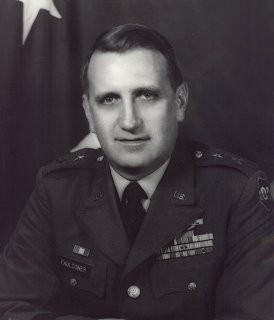
James B. Faulconer
General Faulconer was born in Fayette County, Kentucky. He graduated from the University of Kentucky in 1939 with an AB Degree in Journalism.
His military career began with completion of Senior ROTC at the University of Kentucky where he was tendered an appointment as Second Lieutenant on 8 April 1940 with his acceptance. He entered on active duty 19 June 1941 and received a battlefield promotion to the rank of Lieutenant Colonel in May 1945 at age 26.
Serving throughout World War II with the 33rd Infantry Division, his assignments included Company Commander, Regimental S 1, S2 and S3, Regimental Executive Officer, Battalion Commander and Division Assistant Chief of Staff, G-3. He was the youngest Division Assistant Chief of Staff, G-3 at age 26 in World War II.
General Faulconer served in the Army Reserve since from active duty 27 March 1946 and performed in several positions, including Chief of the Command and General Staff Department and Assistant Commandant, 2085th USAR School prior to joining the 100th Division. When the division was reorganized in 1959 as a training division, General Faulconer was selected to command the 397th Regiment.
During the Berlin Crisis, he commanded the 397th Regiment when the division mobilized. Reverting to reserve duty, he continued to command the regiment until 1965 when he was named Assistant Division Commander of the 100th Division.
He served as Division Commander from 1970 to 1973.
General Faulconer served on the Reserve Forces Policy Board, Advisory Group to the Secretary of Defense 1972 to 1975.
He served as a Mobilization Designee as Deputy Commanding General (Mobilization), Headquarters U.S. Training and Doctrine Command 1974 to 1976.
He is very active in civic affairs.
In 1946 he received an Honorary Life Membership in the Lexington Junior Chamber of Commerce for his lasting contribution to that organization. In 1947 General Faulconer was named the most outstanding young man in Lexington by the Junior Chamber of Commerce and that same year was named one of the three most outstanding young men in Kentucky by the State Junior Chamber of Commerce.
In 1965 he was one of forty lettermen to receive the University of Kentucky Achievement Award for Leadership and Service, becoming a Distinguished Alumnus of the University.
General Faulconer is a Member of the Wall of Fame, University of Kentucky ROTC.
His awards and decorations include the following:
Legion of Merit with two Bronze Oak Leaf Clusters.
Bronze Star Medal for Valor with Bronze Oak Leaf Cluster.
Meritorious Service Medal.
Army Commendation Medal.
American Campaign Medal.
European-African-Middle Eastern Theater Medal.
World War II Victory Medal.
Army of Occupation Medal with Germany Clasp.
National Defense Service Medal.
Armed Forces Reserve Medal with two Hourglass Devices.
Deceased. General Faulconer died 5 December 2000.
1986—Inducted into Corridor of the Century.
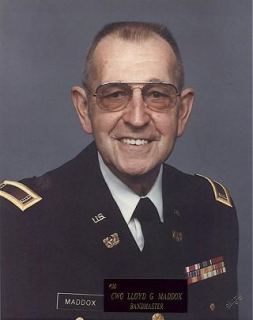
Lloyd G. Maddox
Mr. Maddox attended the University of Cincinnati Conservatory College of Music for two years prior to enlisting in the U.S. Navy as a Musician 2nd Class on November 6, 1942. On December 12, 1945 he was discharged from the U.S. Navy in the grade of Musician 1st Class.
He enlisted in the USAR on August 8, 1956 as a clarinet player and was appointed Warrant Officer Junior Grade May 10, 1957. On May 22, 1957 he became Bandmaster of the 100th Division Band, serving with great distinction in that position until retirement June 30, 1978.
When ordered to active duty with his unit during the Berlin Crisis, he assumed the responsibility of fulfilling all requirements of an Army Band for the 100th Division, and Fort Chaffee for all the troops stationed there from September 24, 1961 until August 15, 1962. Besides playing for parades, various formations and dances on post, the Centurymen musicians were in demand throughout the Arkansas and Oklahoma area. The highlight of the year was being selected to play “Hail to the Chief” for President John F. Kennedy on his visit to Potean, Oklahoma.
Under his direction the Band was judged as the best small unit in the entire USAR when it received the USAR Outstanding Small Unit Award in 1974.
Mr. Maddox personally designed and supervised the construction of a band training facility which was dedicated on September 18, 1977 as a USAR Training Center in Hebron, Kentucky. This facility is typical of his efforts and is considered the best of its kind in the USAR.
During his last Annual Training at Fort Knox in 1978, he was honored by the Division with June 16, being designated as “Lloyd Maddox Day.”
During the period October 1, 1962 to July 1, 1978, he worked with the Band and other 100th Division units, in a civilian status, as an Administrative-Supply Technician.
Throughout his many years of service to the 100th Division in both civilian and military status, Mr. Maddox was recognized and admired by all as one who demanded the stamp of “Excellence” on all that he did. He shall ever be known as “Mr. 100th Division Band.”
His awards and decorations include the following:
Meritorious Service Medal
Army Commendation Medal
Good Conduct Medal (Navy)
American Campaign Medal
Asiatic-Pacific Campaign Medal
Foreign Service Medal
World War II Victory Medal
Army Reserve Components Achievement Medal
National Defense Service Medal
Armed Forces Reserve Medal
Deceased. CW4 Maddox died 2 March 2002.
1986—Inducted into Corridor of the Century.
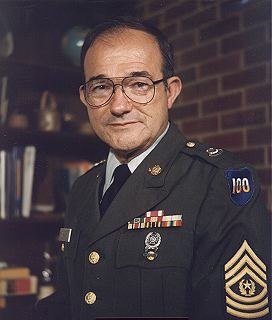
Charles P. Kaltenthaler, Sr.
From July 1950 to March 1984, Command Sergeant Major Kaltenthaler has consistently performed in an exemplary manner. He served in many positions while a member of the 100th Division including Command Sergeant Major 100th Support Battalion and 100th Division Maneuver Training Command.
He was the first Command Sergeant Major of the 100th Support Battalion. He was responsible for the assignment of all senior non-commissioned officers and was instrumental in the training of the young inexperienced staff officers. He was also the project NCO for the design of the unit’s crest and motto, First and Last.
As the second Command Sergeant Major of the 100th Division Maneuver Training Command, he evaluated and directed the reassignment or all senior NCO’s, resulting in improved performance of the NCO Corps. He created a Professional Development Course for senior NCO’s . which was eventually adopted by the Department of the Army for use in all units of the Army. Because of his direct influence, the NCO’s captured many individual awards from the Division, Fifth U.S. Army and even the Department of the Army.
Command Sergeant Major Kaltenthaler was tough and unrelenting in his duty performance. There were many win/lose situations where he was unable to assuage the “loser.” However, there were many more that were win/win, and for this reason he is held in high regard by the NCO’s with whom he served.
His awards and decorations include the following:
Army Reserve Components Achievement Medal
National Defense Service Medal
Armed Forces Reserve Medal
1986—Inducted into Corridor of the Century.
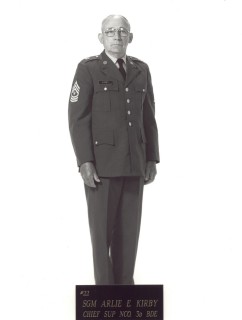
Arlie E. Kirby
From January 1956 to September 1975, Sergeant Major Arlie E. Kirby consistantly served the Division in an exemplary and noteworthy manner. His division assignments included Regimental Intelligence Sergeant, Brigade Chief Supply NCO and Battalion Operations Sergeant.
He was the Intelligence Sergeant Major of the 400th Regiment when the division was mobilized in 1961. Additionally, he put his outstanding knowledge and experience at the disposal of’ the S4 Section and was assigned responsibility for warehouse pick-ups and turn-ins for the regiment. His contribution to the mobilization effort was so distinctive that he was one of the few members of the division awarded the Army Commendation Medal for that period of duty.
When the 400th Regiment was reconstituted as the 3rd Brigade in January 1968, Sergeant Major Kirby was assigned to that unit as Chief Supply NCO. He continued to perform in his distinctively hard-working, dedicated and knowledgeable manner as he applied his best efforts to the logistical activities of the command. He traveled widely to subordinate units. He organized section activities and supported the command in a highly competent and dedicated manner.
In March 1969, he was reassigned to lst Battalion, 400th Regiment as Battalion Operations Sergeant and produced the premier S3 program in the Brigade and Division.
Sergeant Major Kirby was widely known throughout the Division and particularly in the 397th and 400th Regiments as a Supply and Administrative Specialist who had the interests of the individual at heart. He was also known as a person who would not stop until the job was completed to his high level of expectations. He was especially respected for his integrity and abiding sense of loyalty, honesty and moral values. He was always pleasant, human, sympathetic and helpful. He went far out of his way and he did more than expected to make sure the individual and the unit were properly cared for in a quiet and unobtrusive manner.
He exemplified the “No-Nonsense, Common Sense” approach and provided invaluable assistance, counsel, guidance, wisdom and humor to many commanders, staff officers and unit members. He was distinctive in his work schedule, placing emphasis on meeting job requirements instead of his personal life and needs. He gave friendship and assistance to all who needed it, often without their knowledge and without counting the cost to himself. He gave the best he had to his unit and to the Division. His unimpeachable integrity and his attitude to keep working until the job was done were examples of the very best in the military and civil servant tradition.
His awards and decorations include the following:
Army Commendation Medal
American Campaign Medal
World War II Victory Medal
Army of Occupation Medal
National Defense Service Medal
Army Reserve Components Achievement Medal
Armed Forces Reserve Medal
Deceased. SGM Kirby died 29 Sep 98.
1986—Inducted into Corridor of the Century.
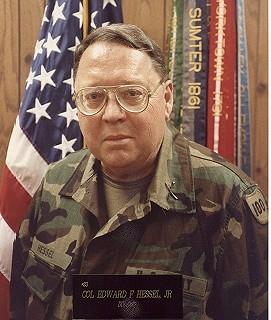
Edward F. Hessel, Jr.
Colonel Hessel joined the 100th Division as a PFC in December 1949, while concurrently being a cadet in the ROTC at the University of Kentucky. Two and a half years later he interrupted his reserve assignment, to accept his commission in August 1951 to go on active duty, returning to the reserve in April 1955 with the 95th Infantry Division, USAR, until December 1959, when he rejoined the 100th Division. He retired in September 1981.
His military career ranged from the Assistant Division Information Officer; Information Officer; Headquarters Commandant; Battalion Commander; Assistant Chief of Staff, G-2; Commander, 100th Committee Group and Division Chief of Staff.
During this span of time he was involved in many innovative ideas to promoted the Division and create quality programs that were “firsts” in their existence. Some of them are as follows: Century News Day, inviting news media throughout Kentucky to visit their “Home Town Folks” at Fort Knox annual training to elevate news coverage on a broad base; he pursued the development and composition of the music score “The March of the Century;” introduced the identity phrases “The All Kentucky 100th Division” and “Kentucky’s Own Division,” prepared an entry for the Public Relations Society of America “Silver Anvil Award,” his efforts led to the completion and erection of a historic marker at Fort Jackson, commemorating the site of the World War II activation of the 100th Division. Perhaps his single most important contribution to the Division while Chief of Staff was to coordinate the rewriting of the Division Operating Policies and Procedures (DOPP) into simple layman language.
As Chief of the Combat Support Division of the 100th-Division Maneuver Training Command, he was given the task to form a team to write the general scenario to produce the field document that would meet the Kentucky National Guard’s requirement to test their ability to mobilize and move to ports of embarkation. The written program was put to the test in action, resulting in highly successful conclusions and was repeated by them a few years later, employing primarily the same document.
He designed the logo used by the Association of the Century and coined the motto “Perpetuating the Excellence of the 100th Division.”
Because of the many community service programs performed by his command, as well as his personal community involvement, including a period as Executive Director of the Louisville U.S.O. and Chairman of the Louisville Armed Forces Committee, he received the “Benjamin J. Butler Community Relations Award.”
He has served on the Executive Committee of the Association of the Century and is now President of that organization.
His awards and decorations included the following.
Legion of Merit
Meritorious Service Medal
Army Commendation Medal w/Bronze Oak Leaf Cluster
Army Reserve Components Achievement Medal
Armed Forces Reserve Medal with two Hourglass Devices
National Defense Service Medal
Deceased. Colonel Hessel died 22 August 2001.
1987—Inducted into Corridor of the Century.
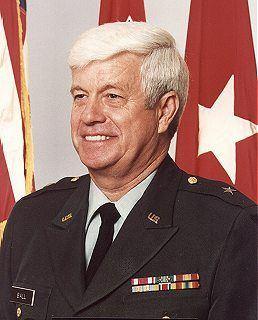
James D. Ball
Brigadier General James D. Ball served with the 100th Division from June 1956 to January 1983. He served with the 4th Armor Division in Fort Hood, Texas, on active duty, before joining the 100th Division and served as Deputy Commander, 83rd U.S. Army Reserve Command, for two years after leaving the Division for a total military service record of over thirty-one years.
During more than twenty-six years as a member of the 100th Division, he served in unit command positions over fourteen years, ranging from company, battalion, brigade, Maneuver Training Command and Assistant Division Commander. Other important responsibilities in staff positions of operations, logistics and executive officer at battalion and brigade levels fill out the balance of his military career.
His innovative approach to highly successful training operations and dedicated attention to unit readiness posture during his battalion command resulted in his selection to conduct pilot training projects for the division.
Throughout his assignments, he constantly applied well thought out principles to meet his responsibilities and methodically worked out. satisfactory conclusions to any projects or problems.
Dependability was his long suit of accomplishment with willingness and sincerity complimenting his attitude.
His awards and decorations include the following:
Meritorious Service Medal
Army Commendation Medal
Army Reserve Components Achievement Medal
National Defense Service Medal
Armed Forces Reserve Medal
1987—Inducted into Corridor of the Century.
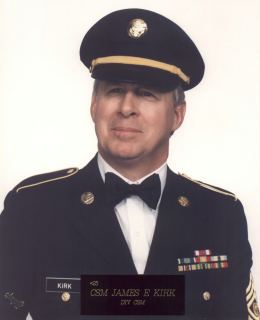
James E. Kirk
From April 1959 to October 1983, Command Sergeant Major James E. Kirk displayed outstanding qualities in leadership and loyalty in his assignments in the 100th Division. His innovative ideas, especially in the field of planning and training, resulted in numerous successful programs in his units, and were radiated throughout the division. He proved to be a valuable adviser and liaison to the Division Commander.
He spent many hours establishing lines of communications through the NCO ranks and helped to advance their important status through a non-commissioned officer development program which was adopted by Department of’ the Army and afforded army wide implementation.
He was one of a committee of four NCOs that initiated a color guard competition program in 1971 within the Division and was the coordinator of this activity from 1974 through 1976, and again in 1979 through 1983.
He played a key role in the activation and development of the 100th Committee Group in 1968, continued as Operations/Intelligence Sergeant and then Committee Group Command Sergeant Major, always progressively and with extraordinary success, caring the respect of both the enlisted and officer personnel of the unit and all units of the Division.
His devotion to his duties as the Division Command Sergeant Major for three and one half years is certainly noteworthy and unexcelled. He has served on the Executive Committee and is a former President of the Association of the Century.
CSM Kirk has served as Mayor of a small city in Jefferson County, Kentucky, Cubmaster and Scoutmaster of both Cub Scouts and Boy Scouts units , Manager and Director of Youth Baseball program and is a member of Bullitt County JAYCEES.
His awards and decorations include the following:
Legion of Merit
Meritorious Service Medal with Bronze Oak Leaf Cluster
Army Commendation Medal with Bronze Oak Leaf Cluster
Army Reserve Components Achievement Medal with Bronze Oak Leaf Cluster
National Defense Service Medal
Armed Forces Reserve Medal with Hourglass Device
NCO Professional Development Ribbon
Other citations included:
Runner-up, Centuryman of the Year, 1968
Centuryman of the Year, 1969
Runner-up Benjamin J. Butler Community Relations Award, 1972
1987—Inducted into Corridor of the Century.
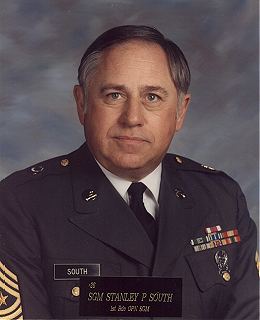
Stanley P. South
Sergeant Major Stanley P. South began his military career at age 16 in August 1955, as a Private in the Kentucky Army National Guard, continued later in the Missouri Army National Guard and then transferred back to Kentucky until November 1965 when he joined the 100th Division.
His exemplary achievements were quickly recognized in every phase of his progression through the enlisted ranks, covering duties from machine gunner, supply, administration, operations and planning to Brigade Sergeant Major, leaving the 100th Division in April 1987.
He served as First Sergeant of Company D, 2nd Battalion, 400th Regiment, 1st Brigade, for more that sixteen of the twenty-one years with the 100th Division. His distinguished service included assignments for eight Brigade Commanders, ten Battalion Commanders, and ten Company Commanders. His efforts were instrumental to receiving numerous unit satisfactory ratings in all types of inspections with never an unsatisfactory area. He helped activate new units in the division and contributed extensively to the NCO career development program.
He participated in National Rifle Matches, both in the National Guard and the Army Reserve, and finished second in overall small bore competition for three consecutive years. As a new shooter, he placed ninth in his first match.
In 1980, Sergeant Major South received the 100th Division “LTC Forrest W. ‘I’urley Administrative Management Award.”
Sergeant Major South has served in over seventeen various organizations ranging from county school Boards of Education, church, athletic associations, Boards of Realtors, design and drafting and several lodges.
Prior to his military and civilian careers he reached the pinnacle of youth programs by attaining the Eagle Scout rank in Boy Scouts at an early age.
His awards and decorations include the following:
Meritorious Service Medal
Army Commendation Medal with Bronze Oak Leaf Cluster
Army Achievement Medal
Army Reserve Components Achievement Medal
National Defense Service Medal
Armed Forces Reserve Medal with two Hourglass Devices
Deceased. SGM South died 27 Jul 98.
1987-Inducted into Corridor of the Century.
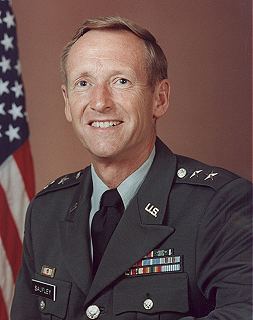
Zack C. Saufley
General Saufley, while serving with the United States Army and Army Reserve for over 31 years, has distinguished himself by exceptionally meritorious service of great responsibility and trust.
From his initial assignment to the 100th Division as a Platoon Leader, through every rank level of command and staff positions to include a small unit commander, major unit commander, battalion and brigade staff, division Chief of Staff, Assistant Division Connnander and Division Commander, his competence, courageous leadership and administrative management procedures identify him as one of the outstanding leaders to exercise command of the Division.
As Division Conunander, he was the driving force behind the division obtaining new and improved training facilities and equipment – and most noteworthy of the major accomplishments under his dynamic and innovative leadership was the initiation of tactical association training with the 2nd Armored and 1st Cavalry Divisions postures of the division. Under his leadership the result-producing programs for strength maintenance, the Division’s strength steadily increased over his four year tenure from 93% to 116% assigned.
As a highly successful and respected training division commander, his counsel and expertise were often sought at the highest echelons of not only the reserve components but the active army as well.
Through his devotion to duty, perseverance, and untiring efforts, he established a harmonious relationship between the 100th Division, the Kentucky National Guard and state and local officials, as well as the active army and sister services. Many noteworthy accomplishments of units and individuals within the division on local and national levels were the result of his profound and unparalleled success in motivating, counseling and molding the men and women into outstanding citizen-soldiers. We now proudly address him as “Honorable” Zack C. Saufley, Civilian Aide to the Secretary of the Army for the Commonwealth of Kentucky.
During his career he earned the following awards and decorations.
Distinguished Service Medal
Army Commendation Medal with two Bronze Oak Leaf Clusters
National Defense Service Medal with Bronze Oak Leaf Cluster
Army Reserve Components Achievement Medal with two Bronze Oak Leaf Clusters
Korean Service Medal
Armed Forces Reserve Medal with Hourglass Device
Army Service Ribbon
United Nations Service Medal (Korea)
1988—Inducted into Corridor of the Century.
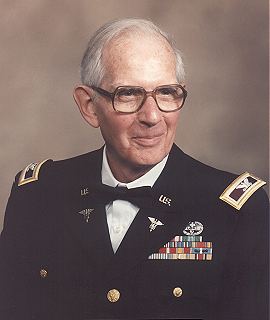
Frank D. Stone
Colonel Stone began federal service as a civilian employee with the United States Navy in Hawaii in November 1941, and was present during the Japanese attack on Pearl Harbor on 7 December 1941.
He then enlisted in the United States Army on 6 January 1943, performing duties that were varied, completing officers candidate school in 1945. He was then assigned duties throughout the United States and Germany through 1946.
After a short period as a reservist, 1947-1949, Colonel Stone again served on active duty during 1950 and 1951, and again reverted to reserve duty in 1952. During this short period of active duty he served in the Occupational Forces in Japan.
In 1964, he joined the 100th Division and performed dual responsibilities in his reserve assignment and his civilian position of Supervisory Staff Administrator (SSA), holding this position until 1980.
During his military career he continuously sought self-improvement programs through a wide range of civilian and military schools at graduate levels to include Command and General Staff College and the Industrial College of the Armed Forces both non-resident courses.
During the period of June 1964 through August 1980, he served under six Division Commanders and eight Chiefs of Staff. He received two outstanding superior civilian awards and one quality step increase.
His extreme devotion to the division has been unexcelled, developing programs, advising command and staff, and controlling positions and activities of all civilian personnel assigned.
During his career he earned the following awards and decorations.
Meritorious Service Medal
Army Commendation Medal
Good Conduct Medal
Army Reserve Components Achievement Medal
Armed Forces Reserve Medal with Hourglass
American Campaign Medal
United National Service Medal
Korean Service Medal with four Bronze Service Stars
World War II Victory Medal
Army Occupation Medal with Germany Clasp
Army Occupation Medal with Japan Clasp
National Defense Service Medal
Combat Medical Badge
Meritorious Unit Citation
Deceased. Colonel Stone died 23 June 2000.
1988—Inducted into Corridor of the Century.
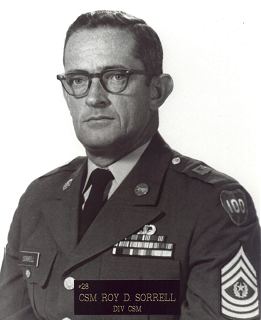
Roy D. Sorrell
Command Sergeant Major Roy D. Sorrell has had a most distinguished military record. He rose rapidly in rank during his service with the 11th Airborne Division in Japan in 1946-1947, served in the Kentucky National Guard, followed by service with Army Reserve units and rounding out his military career by returning to “Jump Status” in both land and sea jumps with the U.S. Army Special Operations Command (Atlantic), 7th Special Forces Group.
He joined Company G, 397th Infantry Regiment, 100th Infantry Division, in Mount Sterling, Kentucky in 1957 as the First Sergeant and later, when that company was redesignated Company C, 400th Regiment, he continued as First Sergeant for six years and was instrumental in maintaining strength, morale and a high state of readiness. While in this position he was recalled to active duty with the 100th Division during the Berlin Crisis where his superior abilities were apparent to all who observed him and his military appearance, bearing, knowledge and ability to express himself clearly and effectively. For theses attributes he was one of five enlisted soldiers, a very select group, to visit Berlin in 1962 to observe first hand, the situation at that time.
In 1963, he was selected as Command Sergeant Major for the 400th Regiment, a position he held very ably, assisting four regimental commanders over a period of ten years. In that assignment he developed and implemented a training program to improve the performance of senior NCOs in MOS testing and qualification.
In 1974, he was chosen to be the Division Command Sergeant Major where he initiated many positive programs enhancing the position of the enlisted personnel in the division. In 1975 a civilian employment transfer necessitated a relocation to Iowa and he continued his reserve service there as Commandant of the NCO Academy of the 5041st USAR School. In this position he was cited for his training program of Junior NCOs; for the establishment of an enlisted promotion board and for counseling junior NCOs on career development and promotion potential. He retired in 1987 with over thirty years service.
During his career he eared the following awards and decorations.
Army Commendation Medal with Bronze Oak Leaf Cluster
Good Conduct Medal
Army Reserve Components Achievement Medal
Asiatic Pacific Theater Medal
World War II Victory Medal
Army of Occupation Medal with Japan clasp
National Defense Service Medal
Armed Forces Reserve Medal with Hourglass Device
American Campaign Medal
Parachute Badge
1988—Inducted into Corridor of the Century.

Joseph B. Brill
Command Sergeant Major Roy D. Sorrell has had a most distinguished military record. He rose rapidly in rank during his service with the 11th Airborne Division in Japan in 1946-1947, served in the Kentucky National Guard, followed by service with Army Reserve units and rounding out his military career by returning to “Jump Status” in both land and sea jumps with the U.S. Army Special Operations Command (Atlantic), 7th Special Forces Group.
He joined Company G, 397th Infantry Regiment, 100th Infantry Division, in Mount Sterling, Kentucky in 1957 as the First Sergeant and later, when that company was redesignated Company C, 400th Regiment, he continued as First Sergeant for six years and was instrumental in maintaining strength, morale and a high state of readiness. While in this position he was recalled to active duty with the 100th Division during the Berlin Crisis where his superior abilities were apparent to all who observed him and his military appearance, bearing, knowledge and ability to express himself clearly and effectively. For theses attributes he was one of five enlisted soldiers, a very select group, to visit Berlin in 1962 to observe first hand, the situation at that time.
In 1963, he was selected as Command Sergeant Major for the 400th Regiment, a position he held very ably, assisting four regimental commanders over a period of ten years. In that assignment he developed and implemented a training program to improve the performance of senior NCOs in MOS testing and qualification.
In 1974, he was chosen to be the Division Command Sergeant Major where he initiated many positive programs enhancing the position of the enlisted personnel in the division. In 1975 a civilian employment transfer necessitated a relocation to Iowa and he continued his reserve service there as Commandant of the NCO Academy of the 5041st USAR School. In this position he was cited for his training program of Junior NCOs; for the establishment of an enlisted promotion board and for counseling junior NCOs on career development and promotion potential. He retired in 1987 with over thirty years service.
During his career he eared the following awards and decorations.
Army Commendation Medal with Bronze Oak Leaf Cluster
Good Conduct Medal
Army Reserve Components Achievement Medal
Asiatic Pacific Theater Medal
World War II Victory Medal
Army of Occupation Medal with Japan clasp
National Defense Service Medal
Armed Forces Reserve Medal with Hourglass Device
American Campaign Medal
Parachute Badge
1988—Inducted into Corridor of the Century.
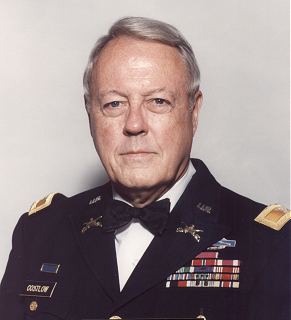
Owsley C. Costlow
Colonel Costlow was born and educated in Louisville, Kentucky, graduating from the University of Louisville in 1949 with a BA in History. After three years of Junior ROTC at Louisville Male High School and two years as a Second Lieutenant in the Kentucky Active Militia (the State Guard that assumed the duties of the Kentucky Army National Guard that had been federalized in 1940), he enlisted in the army on 24 September 1942. He received armor basic training at Fort Knox, Kentucky, was selected for Armor OCS, graduating on 11 December 1943, as a Second Lieutenant, Infantry, Medium Tanks. He trained with the 7th Armored Division at Fort Benning, Georgia and the 20th Armored Division at Camp Campbell, Kentucky. It was while he was with the 20th that he had his first contact with the 100th Division when his tank battalion was sent to Fort Bragg, North Carolina to train the 100th Division in working with armor. Shortly thereafter he was sent overseas to Europe as a replacement, joining the 12th Armored Division in France on 11 December 1944 exactly one year to the day of his OCS graduation. At the 12th, he was assigned as Platoon Leader, 3rd Platoon, Company A, 23rd Tank Battalion. On 26 December 1944, he. again encountered the 100th Infantry Division at Rimling, France. It was where he and his platoon were awarded the Distinguished Unit Citation when the 3rd Battalion, 397th Infantry Regiment was cited for its stand at Rimling during New Year’s week of 1945.
On 18 April 1945, he was wounded, for the second time, outside Ansbach, Germany while leading the attack on that city. Then after two years and three different Army Hospitals, he was released from Active Duty and joined the Army Reserve on November 1947. He served in several non-divisional units rising to Lieutenant Colonel in August 1961. In 1966, General Butler asked him to transfer to the 100th Division as Assistant Chief of Staff, G-3. He served in that position from December 1966 to August 1968, when he was assigned command of the 4th Brigade (CST), where he brought it from the least effective brigade to the most productive in the division. In December 1969, he was selected to become the Division’s Chief of Staff, and assignment he held for almost four years, returning the the 4th Brigade in 1973 to reorganize it into the 100th Maneuver Training Command. Under his leadership, the MTC achieved operational readiness in the very minimum of time through hard, time consuming work and dedication. It received an Inspector General’s rating of Superior and a letter of commendation from the Fifth U.S. Army Commander after only six months from activation.
Colonel Costlow retired in May 1974 after 32 years of combined active and reserve service. In civilian life he retired as Vice President for Personnel from the R. L. White Publishing Company in 1983. He has been very active in military oriented organizations having been Chapter and State President of the Reserve Officers Association; Chapter and State Commander, The Military Order of the World Wars; a life member of the Retired Officers Association, the Association of the Century and the 12th Armored Division Association where he was awarded their Blue Ribbon Award for 1985.
He is also active in his Church, the Leukemia Society of America, the Civil War Round Table and is Vice President of the Patton Museum Board.
During his career he has earned the following awards and decorations.
Legion of Merit
Bronze Star Medal
Purple Heart with Bronze Oak Leaf Cluster
Meritorious Service Medal
Army Commendation Medal
Good Conduct Medal
Army Reserve Components Achievement Medal
Armed Forces Reserve Medal with two Hourglass Devices
American Campaign Medal
European-African-Middle Eastern Medal with three Bronze Service Stars
World War II Victory Medal
Army Occupation Medal with Germany Clasp
Distinguished Unit Citation
Medaille Commemorative Francais
French Liberation Medal
Combat Infantry Badge
Deceased. Colonel Costlow died 10 July 2000.
1989—Inducted into Corridor of the Century.
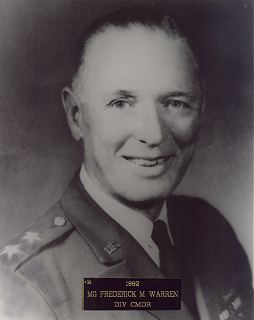
Frederick M. Warren
Major General Frederick M. Warren served his Country during World War II in the ETO. He enlisted in the Ohio ARNG and served five years then was commissioned a Second lieutenant, Cavalry in Kentucky ARNG. He commanded an Armored Group, a Combat Command of 7th Armored Division, a Separate Tank Battalion of’ 12th Armored Division, on the Staff of 9th Army and the Assistant Chief of Staff, G-4, 3rd Army.
He is graduate of the Cavalry School, Anti-aircraft Artillery School, Armor School, Airborne Infantry School and Command and General Staff College.
Following the end of the war, he became very active in the Army Reserve. He followed Brigadier General Donald B. Adams as Commander of the 100th Airborne Division on February 16, 1948. He took the Division on its first Summer Camp at Fort Bragg hosted by the 82nd Airborne Division in July 1948.
He worked with the Reserve Officers Association, Air Force Reserve Association, the Kentucky Air and Army National Guard and contacted over 600 businesses to encourage authorization for military leave to attend reserve and guard summer training without losing infringing on regular leave or losing pay differential. Thus the beginning of the Employer Support for the reserve components.
He directed a massive recruiting campaign with support from community that moved the Division from Class “C” to “B” status.
As Division Commander, General Warren guided the division through its service as airborne, infantry, replacement training command and to the training division concept.
He was instrumental in securing the construction of an airborne training facility which included a C-82 mockup, a glider mockup and a 34-foot jump tower which was completed in September 1948.
During his command tenure he pushed for better reserve centers and dedicated the red brick armory, the first new division reserve center at Bowman Field in 1951.
He was promoted to Major General in 1955. His tenure encompasses the early, difficult times for the reserves.
General Warren was selected and served on active duty, as the first Chief, Army Reserve and ROTC Affairs, Department of the Army on 20 September 1958. and held this position until early 1963.
General Warren served his country with valor during World War II and made equally great contributions to his community during peace. Until his death, he served with distinction as a State District Judge in the Northern District of Kentucky.
This outstanding citizen-soldier and general officer achieved a first that has not been equaled. He took command of the division during the turbulent post World War II years. What has never happened before and is likely never to happen again is that for 10 consecutive years General Warren successfully command the 100th Division.
His awards and decorations include the following:
Silver Star
Bronze Star Medal with V Device
Army Commendation Medal
American Campaign Medal
European-African-Middle Eastern Campaign Medal with four Bronze Service Stars
World War II Victory Medal
Army of Occupation Medal with Germany Clasp
National Defense Service Medal
Armed Forces Reserve Medal
Combat Infantryman Badge
Glider Badge
Army Staff Identification Badge
French Croix de Guerre
Belgian Croix de Guerre
1992—Inducted into Corridor of the Century.
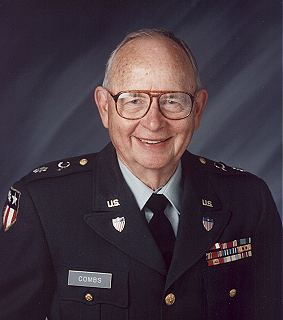
James R. Combs
Lieutenant Colonel Combs is a veteran of both World War II and the Korean War. He was a member of the 100th Division when it was called to active duty in 1961. As commander of the 100th Signal Company, he increased its strength from 24 enlisted men and officers to 110 enlisted men and officers during a period when recruiting was necessary to maintain strength in the reserve program.
He was in charge of the Adjutant General’s Special Action Section which did an outstanding job of screening records to release undesirables who had entered on active duty during the 1961-62 Berlin Crisis.
As the Division Special Service Officer, Assistant Inspector General and Finance Officer, Lieutenant Colonel Combs created many innovative programs which were a credit to the 100th Division and the United States Army.
During the period 7 June 1973 to 27 January 1975, LTC Combs distinguished himself by rendering exceptional service as Deputy S-1, 100th Division Maneuver Training Command (MTC). Under “Operation Steadfast,” the mission was to convert a unit of 68 officers and 467 enlisted soldiers to a unit of 140 officers and 171 enlisted soldiers and through the leadership of LTC Combs and his concentrated effort toward mission accomplishment, his section greatly enhanced the organization of the MTC by proper and accurate assignment of personnel. He implemented improved procedures which greatly enhanced the efficiency of the MTC. His patriotism and exemplary performance of duty reflect credit upon himself, the 100th Division and the United States Army.
His awards and decorations include the following:
Good Conduct Medal
American Campaign Medal
World War II Victory Medal
Korean Service Medal
United Nations Service Medal
National Defense Service Medal
Army Commendation Medal
Armed Forces Reserve Medal
Army Reserve Components Achievement Medal
1992—Inducted into Corridor of the Century.
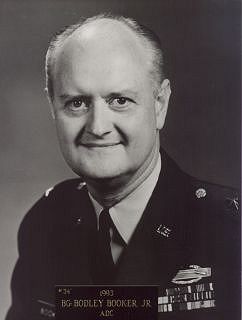
Bodley Booker, Jr.
Brigadier General Bodley Booker, Jr. served in both the 399th Infantry and 400th Infantry Regiments prior to World War II. He entered on active duty as a Second Lieutenant with the Regular Army in July 1940 and was assigned to Iceland prior to Pearl harbor with the first contingent of American troops to enter the European combat zone. During combat he served as a Battalion S-3 and Battalion Executive Officer during the Battle of the Bulge, the Colmar Pocket and the Ruhr Valley offensive. He became a member of the 100th Division in 1955 and assumed command of the 399th Regiment. He successfully brought the 399th Regiment through the turmoil of those days and established a firm foundation on which the regiment would grow to maturity.
General Booker was selected as Division Chief of Staff in 1959. It was in this capacity that he rendered his most noted service to the 100th Division. He played an invaluable role in preparing the division for activation in the September 1961 Berlin Crisis call-up.
A number of projects he conceived and guided are worthy of note. He developed the idea of creating a pre-commission school where highly qualified enlisted men would study the Army Pre-Commission Course. The first school of its kind, it was fully approved by the Infantry School and successfully provided a large number of outstanding lieutenants for the Division.
When the 100th Division arrived at Fort Chaffee, General Booker soon detected that there was a lack of logistical support and technical advice. To correct this problem, he conceived and initiated the “100th Division Logistical Control Center.” This again was the first of its kind in the Army. It’s operation proved highly successful. It was General Booker who organized the “Provisional Battalion” from the six companies that had no designated intermediate headquarters between them and the division.
General Booker sensed the potential value to the other training divisions of the experiences of the 100th Division on active duty and the army sent selected command and staff officers from the other divisions to observe the 100th Division in action. Additionally, he was instrumental in developing a program for training the 95th Division (Training) at their ANACDUTRA 1962, by satellization on the 100th Division.
General Booker’s professional qualifications, his dedication to duty, his foresight, integrity and penchant for perfection contributed greatly to the success of the 100th Division over many years, particularly during the supreme test of the Berlin Crisis of 1961-1962. Few individuals contributed more to the achievements of this exercise than he. He was named Assistant Division Commander while the Division was on Active Duty at Fort Chaffee. He currently heads the Museum and Archives Committee of the Association of the Century.
His awards and decorations include the following.
Legion of Merit
Bronze Star Medal with Bronze Oak Leaf Cluster
Army Commendation Medal
American Defense Service Medal with Foreign Service Clasp
American Campaign Medal
European-African-Middle Eastern Campaign Medal
World War II Victory Medal
Army of Occupation Medal with Germany Clasp
National Defense Service Medal
Armed Forces Reserve Medal
Combat Infantryman Badge
1993—Inducted into Corridor of the Century.
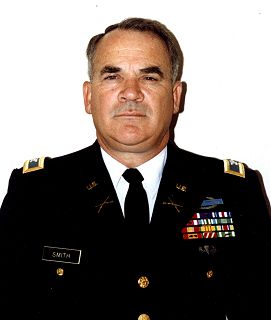
Donald J. Smith
Colonel Smith joined the 100th Division in 1970 from staff and infantry command in Vietnam. He has 24 years of active service, 18 years of active duty and 6 years of reserve service. Military schools include basic, advanced, Command and General Staff College, Senior College equivalent, Infantry Officer Basic Goals, Infantry Officer Career Goals, and Command and General Staff College. Civilian education includes University of Louisville, Advanced Degree: Juris Doctor. His duty assignments include Division Retention and Recruiting Officer; Deputy Chief of Staff; Assistant Chief of Staff, G-3; Commander, 100th Support Battalion; and S-3, 100th Committee Group.
During his assignment as Division Retention and Recruiting Officer the division was used as a model for Army retention and recruiting, hired all new recruiters, exceeded all strength goals established by U.S. Army Forces Command, won the retention and recruiting awards six times, maintained division strength over 100 percent. As Division Assistant Chief of Staff, G-3, he accomplished REPTRAIN 1976, the first time a reserve unit training IET trainees in a reserve status resulting in army-wide mobilization training concept, developed program for ROTC visibility with all Kentucky Universities to obtain Lieutenants involved in Simultaneous Membership Program (SMP), enhanced the reserve Drill Sergeant program and NCO development for the Division. As Commander, 100th Support Battalion, he increased unit strength from unsatisfactory to superior and received highest rating on Annual General Inspections.
His awards and decorations include the following:
Silver Star Medal
Bronze Star Medal with Bronze Oak Leaf Cluster
Purple Heart with Bronze Oak Leaf Cluster
Meritorious Service Medal with four Bronze Oak Leaf Clusters
Joint Service Commendation Medal
Army Commendation Medal with Bronze Oak Leaf Cluster
Army Reserve Components Achievement Medal
Combat Infantry Badge
Parachutist Badge
Ranger Tab
1993—Inducted into Corridor of the Century.
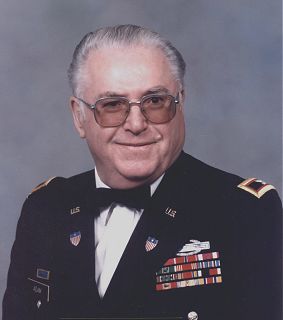
Edwin K. Adam
Colonel Adam was born May 6, 1926, the second son of John F. and Celesta F. Adam, in Harrison County, Indiana near Byrneville.
He attended Crandall Elementary and New Salisbury High schools and following World War II, Indiana University Southeast.
He entered the Army August 8, 1944 at Camp Atterbury, Indiana and underwent basic and advanced infantry heavy weapons training in the IRTC at Camp Blanding, Florida.
Following completion of training and a delay enroute to visit his family, he arrived in Scotland aboard the RMS Queen Elizabeth on January 14, 1945. On January 28, 1945 he arrived at and was assigned to Company A, 1st Battalion, 15th Infantry Regiment of the 3rd Infantry Division. At that time the unit was in the Reidwihr Woods during the battle for Colmar.
He experienced his first combat in that battle and served in the 15th Infantry Regiment to the end of the war at Abentau, Austria. He was reassigned to the Medical Detachment, 1st Battalion, 15th Infantry Regiment on March 18, 1945. Later he was reassigned to Division Headquarters first to the chaplain’s section and then to the Adjutant General’s Section. When the 3rd Infantry division was returned to the U.S., he was reassigned to the 1st Infantry Division and on detached service with the 7719th Theater School. He returned to the U.S. on February 9, 1947 and was discharged April 26, 1947 in grade of T/4.
On April 13, 1950, he enlisted in the 100th Airborne Division as a Corporal. He quickly rose to the grade of Master Sergeant (E-7) and was commissioned a Warrant Officer Junior Grade in June 1953, then he was commissioned a First Lieutenant, AGC, in April 1958. He rose through the ranks to Colonel in December 1975.
He served in many positions including Chief NCO, Adjutant General’s Section; Personnel Management Officer; Assistant Adjutant General; Adjutant General; Assistant Chief of Staff, G-1; Acting Chief of Staff during AT-1970, all in Headquarters 100th Infantry Division. He served as Commander, 2nd Battalion, 399th Regiment; served as Executive Officer, 1st Brigade, and S-1 and S-3, 100th Division Maneuver Training Command, the position he retired from in May 1981.
During the period 1957 to 1967, Colonel Adam directed the Division Marksmanship Program and represented the Division, XX U.S. Army Corps and First and Second U.S. Armies in national competition.
During the Berlin Crisis, Colonel Adam served as Chief, Trainee Personnel Branch and formulated the program of receiving recruits, assigning to training companies, reporting training recommnendations to DA and reassigning after completion of training.
In his civilian employment, prior to transferring to the Department of the Army, he worked for the Veterans Administration Louisville Regional Office from September 26, 1947 to April 14, 1955.
During over 35 years as a civilian technician, he earned the Department of the Army Commander’s Award for Public Service, four quality step increases, five outstanding performance awards and three suggestion monetary awards.
Colonel Adam is active in many organizations–a life member of the Association of the Century, Veterans of Foreign Wars Post 3291 and the Reserve Officers Association. He is a member of the 15th Infantry Regiment Association serving as a Trustee and of the Society of the 3rd Infantry Division.
Colonel Adam is married to the former Deanna M. Hardin and they reside in Clarksville, Indiana. They have four children–Terri, Eddie, April and Cheri and six grandchildren–Greg, Adam, Jordan, Logan, Codie and Kiley and a great-granddaughter Marrisa.
The following are among his awards and decorations.
Legion of Merit
Bronze Star Medal
Meritorious Service Medal with Bronze Oak Leaf Cluster
Army Commendation Medal with Bronze Oak Leaf Cluster
Good Conduct Medal
Army Reserve Components Achievement Medal
European-African-Middle Eastern Campaign Medal with three Bronze Service Stars
World War II Victory Medal
Army of Occupation Medal with Germany Clasp
National Defense Service Medal
Armed Forces Reserve Medal with two Hourglass Devices
Presidential Unit Citation with Bronze Oak Leaf Cluster
American Defense Service Medal
Combat Infantry Badge
Combat Medical Badge
French Fourragere with Palm
Deceased. Colonel Adam died 12 July 2000.
1994—Inducted into Corridor of the Century.
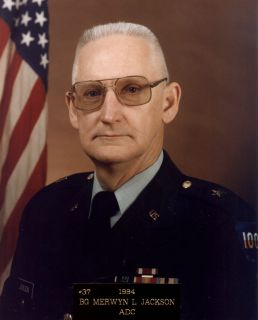
Merwyn L. Jackson
Brigadier General Jackson has distinguished himself by over thirty-three years of exceptionally meritorious service in numerous positions of demanding responsibilities within the 100th Division.
He has had the unique opportunity to command two of the division’s three brigades, serving consecutive assignments in the 1st and 3rd Brigades during 1978 through 1982.
Through his personal involvement, these brigades achieved remarkable advancement in the areas of training, administrative accountability and logistical support.
General Jackson has always led by example and geared complex coordination efforts in a fashion that produced missions that were well-planned, highly organized and efficiently accomplished. His dedication to mobilization readiness keynoted his selection in 1983 as Assistant Division Commander for Maneuver.
General Jackson’s mark of excellence has been placed on each of the existing brigades with the division and every soldier has recognized the invaluable contributions he has freely given.
General Jackson is active in community affairs, the Association of the Century and the Reserve Officers Association having served as Department of Kentucky President. He has built a foundation of trust in the civilian community that is seldom enjoyed by an individual. He assumed his challenging military and civilian responsibilities with demonstrated concern and never faltered in his resolve to provide caring and effective leadership.
His untiring efforts, enthusiasm and devotion to duty reflect great credit upon himself, his unit and the United States Army Reserve.
His awards and decorations include the following:
Legion of Merit
Meritorious Service Medal
Army Commendation Medal with Bronze Oak Leaf Cluster
Army Reserve Components Achieve Medal with three Bronze Oak Leaf Clusters
National Defense Service Medal
Armed Forces Reserve Medal
Armed Service Ribbon
Overseas Service Ribbon
1994–Inducted into Corridor of the Century.
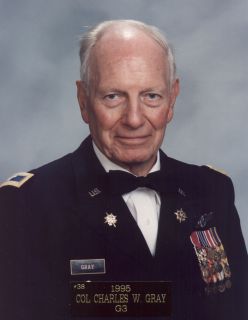
Charles W. Gray
Colonel Charles W. Gray enjoyed a long and distinguished military career. He served three tours of active duty. The first was during World War II. He was drafted into the U.S. Army Air Corps in May 1943 at the age of nineteen. His most significant experience was in the China-Burma-India (CBI) theater of operations, serving as tail gunner on a B-25 Bomber, flying 42, mostly low level combat missions over Burma.
After being discharged as a Sergeant at the end of the war, he entered Eastern (KY) State Teachers College and enrolled in senior ROTC. He was commissioned as a Second Lieutenant in Field Artillery in June 1950. He was called to active duty in June 1951 during the Korean Conflict while attending Graduate School at Colorado University in Boulder, CO. He was assigned to Camp Carson, CO. He attended the Basic Field Artillery Officers Course at Fort Sill, OK. After a short tour in Japan he was assigned to the 73rd FA Bn, First Armored Division at Fort Hood, TX. The 73rd FA Bn was a distinguished non-integrated all black unit at that time and as Battery Commander, 1LT Gray, played an important role in the successful integration of the battalion into a completely non-segregated unit.
After two years of active service he returned to Evarts, KY and was employed as an industrial arts teacher. His first assignment in 100th Division (Infantry) was in C Battery 925th FA Bn in Hyden, KY. While assigned there he was responsible for organizing a new unit for the Division: C Battery 373rd FA Bn in Evarts, KY. In 1958 he moved to the Louisville area and was assigned to Hq&Hq Battery of the 373rd FA Bn. Upon the reorganization of the Division from infantry to training in 1958, he was selected as Company Commander of A Company, 100th Regiment (CST) in LaGrange, KY.
The last period of extended active duty was with the 100th Division (Tng) during the Berlin Crisis of 1961-1962. During this period, Captain Gray was Commander of C Company, 100th Regiment (CST). He was also selected to serve as an Inspecting Team Officer for the CST and AIT units. In addition he was assigned additional responsibilities as Regimental Marksmanship Coordinator, then Division Marksmanship Coordinator and next as Post Marksmanship Coordinator. The Division Rifle and Pistol Teams distinguished themselves in many matches during that tour of duty.
Upon return from active duty in 1962, CPT Gray was assigned as Regimental S-2 for the 399th Regiment (BCT). In 1964 when a new USAR technician program was approved, CPT Gray was employed as the first Staff Training Assistant (STA) for the 100th Division (Tng) and transferred to Division Headquarters as Assistant G-3 with specific responsibilities for mobilization planning. During this period he completed the Officer Advanced Course in Military Intelligence and made a branch transfer from Artillery to Military Intelligence. While being employed as STA for ten years he served in most positions within the G-3 Section, as well as Director of the Leadership Academy and became the Assistant Chief of Staff, G-3 in 1972.
He served as ACofS, G-3 for only seven months. When the mission of organizing and developing Maneuver Training Commands was assigned to training divisions, he was selected as the S-3 for the MTC and worked closely with the MTC commander and the Division commander in staffing the new unit. He then transferred his civilian employment to the 100th Division MTC as Staff Administrative Assistant (SAA).
His accomplishments are a legend. He conceived and instituted the annual best instructor competition, wrote the program of instruction for “REP Train”, coordinated the first unit readiness reporting system, coordinated the initial drill sergeant program and was officer-in-charge of the first “hands-on training” program. While assigned to the MTC, he was the catalyst for the development of the team concept and organization of exercise teams and procedures for conducting exercises.
During Colonel Gray’s entire career he distinguished himself through his leadership ability, ideas, creativity, inventiveness, enthusiasm and continuous striving for perfection. He was well recognized for his traits of character and excellence by the awarding of the many awards and decorations. His many accomplishments and personal integrity brought credit upon himself, his family, the Army Reserve and the United States.
His awards and decorations include the following:
Legion of Merit
Distinguished Flying Cross
Meritorious Service Medal
Air Medal
Army Commendation Medal
Asiatic-Pacific Campaign Medal
World War II Victory Medal
National Defense Service Medal
Armed Forces Reserve Medal
Army Reserve Components Achievement Medal
1995—Inducted into Corridor of the Century.
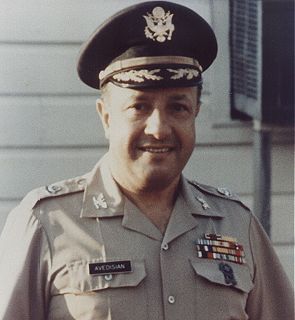
Michael Avedisian
Colonel Avedisian is a veteran of World War II from 1941-1946 in the China-Burma-India Theater. He served as the Division SJA from July 1968 until May 1977 under the commands of three different Division Commanders and reserve duty of over 30 years and earned 14 awards and decorations.
His legal advice and services to the command were highly respected and completed in the most effective and efficient professional manner and was transacted with dispatch and complete accuracy. Being totally dedicated, his knowledge of the military was not limited to Staff Judge Advocate duties, but rather, he participated in all facets of the Division to include being a member of the Division Awards Board along with higher Army special assignments.
During Annual Training-1974, he distinguished himself being assigned by the Commander of USAARMC and Fort Knox to a special project regarding the legal status of general officers quarters number 1 in the performance of military functions, which was ultimately accepted and distributed to the active component CONUSA wide. In addition, he assumed several post assignments and carried them out in such manner as to receive USAARMC and Fort Knox’s finest commendation.
While the Division SJA, he graduated from JAGRC General Staff Course, the Command and General Staff Course and the Advanced Infantry (Short Course) which reflected his being a truly outstanding officer in the JAG reserve.
He continued to demonstrate highly desired leadership qualities, being nominated as Assistant Chief, Army Reserve, DA, as Assistant to Judge Advocate General, DA; as Claims Officer, U.S. Army Claims Division worldwide and as post SJA, U.S. Army Garrison at Fort Indiantown Gap as Mobilization-Designee (MOB-DES) assignment.. Evaluation of these special assignments was that “he has demonstrated that he can be fully relied upon in times of crises to assume any JAG position required and perform in a thoroughly professional manner.”
Colonel Avedisian is a charter life member of the Association of the Century and he excelled in the performance of his duties while assigned to the 100th Division (Training).
His awards and decorations include the following:
Meritorious Service Medal
Army Reserve Components Achievement Medal
Army Commendation Medal
Armed Forces Reserve Medal
Good Conduct Medal with Clasp and two Loops
American Defense Service Medal
American Campaign Medal
World War II Victory Medal
Army of Occupation Medal with Japan Clasp
Asiatic-Pacific Campaign Medal with Bronze Service Star
Philippine Independence Medal
Philippine Liberation Medal with three Bronze Service Stars
Deceased.
1995—Inducted into Corridor of the Century.
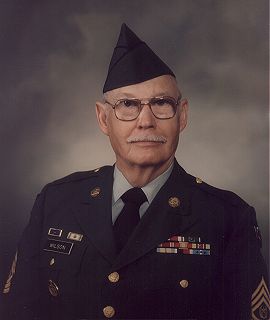
Marvin H. Wilson
Command Sergeant Major Marvin Wilson began his noteworthy military career in August 1948 undergoing infantry and AAA training where he served as a Squad Leader in an AA AW Crew. Because the quad .50 caliber machine guns burn out barrels quickly, he, using his electrical knowlege and ability, rewired the quad .50 so that two guns could be fired at a time, thereby extending the life of the barrels.
CSM Wilson re-enlisted in July 1950 and was assigned to the Japan Logistical Command under General MacArthur. Later, he was assigned to the 3rd Infantry Division when it formed a defensive perimeter for the Marines and other troops during their withdrawl from the Chosin Reservoir in 1950. He served 13 months in Korea and took part in three major campaigns.
During his career, CSM Wilson held assignments in Military Police, Signal and Medical units. Later, he was a Training NCO, Drill Sergeant, First Sergeant, Battalion Sergeant Major and lastly as a Command Sergeant Major for a number of years. He received a high academic score while in Drill Sergeant School and was a graduate of the Senior NCO School as well. He received the 2nd Brigade Commander’s award in 1980. CSM Wilson retired in July 1966 with over seven years active duty and a total of 33 years service, after a long distinguished, inspiring and impressive career.
CSM Wilson continues to support the 100th Division through his active participation in the Association of the Century serving as a member of the Board of Directors. He was instrumental in the formation of the first chapter, the Western Chapter in Paducah of the Association. He served as Chapter President for three years and presently serves as Secretary/Treasurer. He generated 22 new members for the Association in his first two years as Chapter President in 1992 and 1993.
In addition to his outstanding leadership and dedication in the military and the Association of the Century, CSM Wilson has distinguished himself in his civilian life as well. He attended Paducah Community College, Murray State University and Mid-Continent Bible College. In 1970 he was ordained a Baptist Minister. He retired as City of Paducah Safety Officer and continues to serve the city on numerous planning committees.
His awards and decorations include the following:
Meritorious Service Medal with Bronze Oak Leaf Cluster
Army Commendation Medal with Bronze Oak Leaf Cluster
Good Conduct Medal
United Nations Service Medal
Korean Service Medal with three Bronze Service Stars
Army of Occupation Medal with Japan Clasp
Army Reserve Components Achievement Medal
Armed Forces Reserve Medal
Drill Sergeant Badge
1996—Inducted into Corridor of the Century.
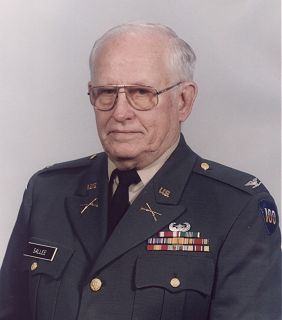
Donald L. Sallee
Colonel Donald L. Sallee joined the 100th Division in 1946 following his service in World War II. He served in the 397th Regiment in a highly effective manner as Headquarters Commander, Assistant S-3 and S-3, and Commander of 1st and 3rd Battalions. He served as Executive Officer and Commander, 3rd Brigade and Commander, 1st Brigade. Later he served as Chief, Combat Support Group, 100th Division Maneuver Training Command.
During the Berlin Crisis, Colonel Sallee served as the S-3 of the 397th Regiment. The 397th Regiment was the first to receive troops following mobilization. He developed, structured and implemented the eight-week Basic Combat Training curriculum. Being the first unit to receive troops resulted in meticulous observation by all elements of the Army particularly units of the 100th Division who would assume like missions in the near future. Working tirelessly, Colonel Sallee displayed imagination, commitment and thoroughness in the development and implementation of the program. This required vigilant monitoring of the training to ensure that it met standards. His outstanding performance provided him with the opportunity to command two brigades of the Division an a most responsible position in the 100th Maneuver Training Command.
Some of Colonel Sallee’s other most significant achievements are: completed glider training; supervised and prepared the 397th Regiment’s Mobilization Plan; prepared and implemented “Trap Line” and “Tobacco Leaf'” plans and orders; served on the 397th Regiment advanced party during mobilization; supervised the preparation of training areas at Fort Chaffee; established an instructor group to ensure uniform training throughout the Regiment.; served as Executive Officer of the rear detachment upon release from active duty; member and captain of the 397th Regimental Pistol Team; marksmanship coordinator for the division for six years; and captain of the First Army Pistol Team for two years.
Colonel Sallee is a life member of the Reserve Officers Association, the Association of the Century and of the National Rifle Association.
His awards and decorations include the following:
American Campaign Medal
World War II Victory Medal
Army of Occupation Medal
Armed Forces Reserve Medal with two Hourglass Devices
Army Reserve Components Achievement Medal
National Defense Service Medal
Glider Badge
1996—Inducted into Corridor of the Century.
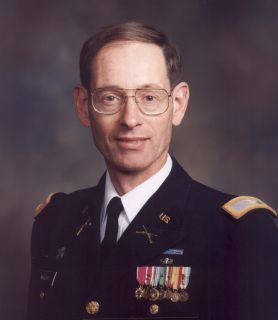
William G. Willis
While serving as Division Information Officer in 1968, Colonel Willis arranged to name the street adjacent to the Division Headquarters ‘Century Division Way” as part of an initiative for a 50th Anniversary Celebration of the end of World War I. He instituted quarterly publication of 4Century Notes in 1968. He also prepared and produced a quarterly five minute “News of the Century” program which ran on 14 Kentucky radio stations. He proposed and drafted the Invitation of General William C. Westmoreland to visit the 100th Division. The event resulted in a 100th Division photo on the cover of Reserve Officers Association of the United States The Officer magazine. Colonel Willis represented the USAR as a panelist at a DOD Domestic Action Conference at the National War College in April 1971 which became the DOD Reserve Forces Policy, and later establish the National Committee for Employer Support of the Guard and Reserve.
Colonel Willis also planned and conducted two Century News Day events m 1971 for 14 reporters at Fort Jackson on June 24, to dedicate a 100th Infantry Division historical marker and at Fort Knox August 12, 1971, for 25 reporters and the visiting Chief, Army Reserve Major General J_ Milnor Roberts.
In April 1973, when assigned as Chief, S-3 Plans in the newly activated 100th Division Maneuver Training Command, Colonel Willis proposed and developed a plan for the organization into functional teams, each with responsibility for writing and conducting exercises. He drafted the functional team’s section of the exercise management regulation; gave the MTC sales presentation to every General Officer Command (GOCOM) and Adjutant General m the Army Readiness Region VI area to arrange for exercise support. While briefing the 38th Infantry Division command and staff on the MTC capabilities, arranged for a Division level CPX by the 75th MAC with the MTC supporting; recommended annual goals with 30 actually conducted m FY 1974, the first full year of operation; and he served as Infantry Team Leader and Test Director for the first written and conducted by the MTC for the 73rd Infantry Brigade, Ohio Army National Guard at Camp McCoy, Wisconsin in 1974.
As Commander, 2nd Squadron, 302nd Cavalry, 3rd Brigade, in Georgetown, Colonel Willis organized a Squadron Orienteering FTX during weekend drill and met strength and qualification goals.
Colonel Willis attended the US Army War College resident course graduating in June 19787. He evaluated the Leadership Academy during AT77 and subsequently served an ADT tour as Reserve Teram Chief, DOC All Volunteer Force Study Group until AT78. Colonel Willis also served as Chair, 100th Division New Ideas Committee 1977-78. Further, he updated the “Story of the Century” community briefing and served as action officer for “Fort Chaffee Activation Debriefing” held 16 June 1978 at Fort Knox.
Colonel Willis is a member of the Infantry OCS “Hall of Fame” He is active in the Lions Club, church: Gideons, and various other community activities. As Department of Indiana President, Reserve Officers Association, he led them to first place nationally in membership: a fact that attests to his dynamic leadership, especially when most other states were experiencing sharp membership declines.
His awards and decorations include the following:
Legion of Merit
Meritorious Service Medal with two Bronze Oak Leaf Clusters
Joint Services Commendation Medal
Army Commendation Medal with Bronze Oak Leaf Cluster
National Defense Service Medal
Armed Forces Reserve Medal with two Hourglass Devices
Army Reserve Components Achievement Medal With Bronze Oak Leaf Cluster
Expert Infantry Badge
Parachutists’ Badge
OSID Identification Badge
1996 Corridor of the Century Inductee #42
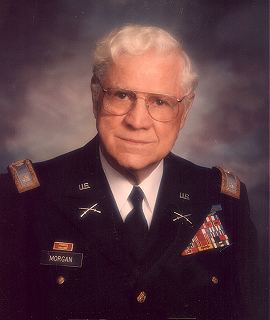
Ernest H. Morgan
Lieutenant Colonel Morgan entered the service in the ERC 1942 while a student at the University of Kentucky until 1943. He then entered OCS and graduated as a Second Lieutenant in 1944 and served as a rifle platoon leader in the 90th Infantry Division during the Battle of the Bulge in Belgium in January 1945. He joined and served in the 100th Division as S-l, 397th Infantry Regiment from 1946 to 1949. He then served as a Company Commander in Germany from 1949 to 1953. In 1956 to 1958 he served in Korea and in Vietnam 1967 to 1968 and then became an advisor to the lst Brigade, 100th Division in 1972; to the 3rd Brigade in 1973 and the 100th Division Maneuver Training Command in 1974-1977.
LTC Morgan is a graduate of the associate Infantry Officer Course, the Advanced Infantry Officer Course and the resident Command and General Staff Officer Course.
During his service as an advisor to the Division he devoted his entire energies to the improvement of the training and operation of the units. He contributed significantly to the outstanding two weeks of Annual Training by the lst Brigade at Fort Polk and greatly assisted the 3rd Brigade in preparing for their Annual General Inspection (AGI) particularly in the areas of unit funds, training, supply and administrative records.
As Deputy Senior Advisor and Acting Senior Advisor for the 100th Division MTC from Aug 1973 to Aug 1977, LTC Morgan’s performance was consistently distinguished by his outstanding judgment, keen foresight, marked managerial ability and an unwavering sense of personal and professional integrity. As the first officer Advisor assigned to the MTC, his initiative and professionalism contributed greatly to the MTC becoming operational within eight months.
While serving with the MTC, his loyalty to the Division was very apparent along with his attention to detail, personal interest and close working relationship with both officers and enlisted personnel helped prevent many situations from becoming problems.
LTC Morgan’s patriotism, sense of responsibility and exemplary performance of duty reflect credit upon the United States Army, the 100th Division and himself.
His awards and decorations include the following:
Silver Star
Legion of Merit
Bronze Star Medal with V Device and Bronze Oak Leaf Cluster
Meritorious Service Medal
Joint Service Commendation Medal
Army Commendation Medal
Good Conduct Medal
European-African-Middle Eastern Medal with three Bronze Service Stars
World War II Victory Medal
Army of Occupation Medal with Germany Clasp
American Campaign Medal
Vietnam Service Medal with five Bronze Service Stars
National Defense Service Medal
Republic of Vietnam Gallantry Cross Unit Citation
Combat Infantry Badge
1997—Inducted into Corridor of the Century.
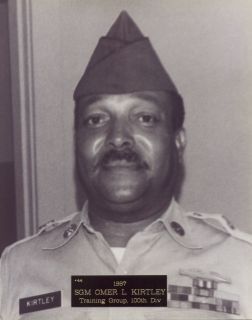
Omer L. Kirtley
Sergeant Major Omer L. Kirtley enlisted in the Army, December 15, 1950 and served with the 24th Infantry Division in the Korean War and was separated from service September 14, 1952. He was the first African-American Sergeant Major in the 100th Division. He retired from the 100th ‘Training Command in February 1981 at ceremonies in Shelbyville. His transfer to the Retired Reserve ended over 31 years of service. He died February 10, 1996.
He joined the Army Reserve in 1952 and transferred to the 100th Division in 1958. When the 100th Division was called to Active Duty, he became the Acting First Sergeant, Test Section. His career in Test Company, later Test Section of HHC, is respected by all who served with him. In a farewell article in the Summer 1996 issue of The News of the Century members of his unit saluted him with respectful wording following notification of his death. ‘I’hese soldiers who served with SGM Kirtley remember him as being a whole man not a half man. He was a person with passion who always looked after his people. He could be depended on to stand behind and support his troops. SGM Kirtley was a man, a soldier, who respected himself, respected others and demanded respect. He believed in good manners, both from a military courtesy and civilian standpoint. He smoked a pipe and would say, “You know what I got to do, you take care of us, I’ll take care of you.”
SGM Kirtley, a native of Scott County, was a retired Superintendent of Custodial Services at the University of Kentucky. He retired in December 1989 after over 42 years of’ service. He worked up the ladder from janitor to department head and when he retired had over 250 employees which included an Assistant, 24 supervisors, 39 crew leaders and the rest employees. He was an Honorable Kentucky Colonel, BSA Scoutmaster, a charter member of the Northside Lions Club, a member of Bethel Baptist Church, where he served as chairman, trustee board and financial serrate.
His awards and decorations include the following:
Silver Star
Bronze Star Medal
Army Commendation Medal with Bronze Oak Leave Cluster
Good Conduct Medal
Army Reserve Components Achievement Medal with four Bronze Oak Leaf Clusters
Korean Service Medal with Bronze Service Star
United Nations Service Medal
Army of Occupation Medal with Japan Clasp
Armed Forces Reserve Medal with Hourglass Device
NCO Professional Development Ribbon with Number 4
Combat Infantry Badge
Deceased. SGM Kirtley died 10 Feb 96.
1997—Inducted into Corridor of the Century.
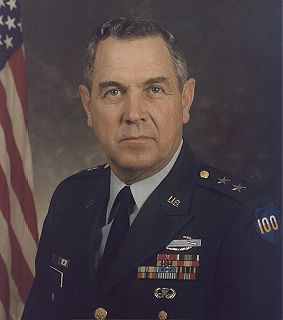
Roy C. Gray, Jr.
During General Gray’s 33 years of service in the Army, active and reserve, his contributions have been noteworthy and highlighted by professionalism and dedication to the excellence of the units to which he was assigned.
He served as a Platoon Leader and Company Commander in an Infantry Division during the Korean War.
He served in both the National Guard and the Army Reserve with the preponderance of his assignments in the 100th Division. He has served in a number of command and staff positions; Battery Commander, 203rd Artillery, S-3 at regiment and brigade, battalion and brigade commander, and Chief, Combat Support Division, of the 100th Division MTC. His illustrious military career was capped by his service as Assistant Division Commander, both ADC1 and ADC2 and lastly as Division Commander during the period July 1983 through July 1987.
General Gray’s devotion to superior performance of the 100th Division extended to the Association of the Century and during his tenure as Division Commander, he was personally responsible for generating more life members than any other single person. His dedication and zeal concerning the welfare of the association unfortunately brought a negative cast upon his career preventing him from receiving a well earned and deserved award upon his retirement.
In his civilian career, General Gray has a doctorate degree in Animal Nutrition and is Associate Profession of Extension at the University of Kentucky.
His decorations and awards include the following:
Bronze Star Medal with V Device
Army Commendation Medal
Army Reserve Components Achievement Medal with two Bronze Oak Leaf Clusters
National Defense Service Medal
Korean Service Medal
Armed Forces Reserve Medal with Hourglass
Army Service Ribbon
United Nations Service Medal
ALNG National Emergency Service Medal
Combat Infantry Badge
Parachutist Badge
1998—Inducted into Corridor of the Century.
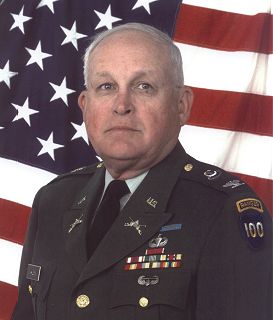
Chappell R. Wilson
Colonel Chappell R. Wilson was commissioned a Second Lieutenant 30 May 1960 through ROTC at University of Kentucky as a distinguished graduate.
His military career magnifies the commitment of citizen-soldiers through his continued participation in diverse military pursuits by participation and complimenting that effort with academic pursuits.
He entered on active duty in October 1960 and attended the Infantry School qualifying as an infantry officer, ranger and airborne. He completed the Infantry Officer Advanced, Special Forces Officer, Command and General Staff Officer, Defense Language Institute (Spanish), National Security Management, National Security, and Army War College Courses in a non-resident status. He completed the Jumpmaster, Air Assault, Armor Pre-Command, and Advanced Armor Officer Courses in residence.
During his 29 years of military service, both active and reserve, he has held several position with advancing responsibilities. He served as an Executive Officer and Commander of a Training Company at Fort Jackson in 1961 and 1962.
He first joined the 100th Division in November 1962 serving as a Platoon Leader in the 400th Regiment. He has served as a Special Forces Detachment Commander; a mobilization designee as Assistant Operations Officer, KY CD, and Assistant G-3, 101st Airborne Division (Air Assault); and commanded both the 2nd Battalion and 3d Battalion, 398th Regiment; was Chief, OPFOR/Security Branch, 100th Division MTC; Assistant Chief of Staff, G-2, 100th Division; Chief, Combat Support Division, 100th Division MTC; and Commander, 2nd Brigade, 100th Division from October 1988 to June 1990. He retired in June 1990.
He rose in grade from a Second Lieutenant on 30 May 1960 through all the grades to Colonel on 14 April 1985.
In civilian life, Colonel Wilson is Chief District Judge, 56th Judicial District, Commonwealth of Kentucky that covers a four county area in western Kentucky.
He is active in military affairs being on the Board of Directors of the TEN-KY Chapter of the Association of the United States Army; Board of Directors, Don F. Pratt Military Museum Foundation, Inc. at Fort Campbell; and Chairman, Military Affairs Committee for Cadiz and Trigg County in Kentucky.
His decorations and awards include the following:
Meritorious Service Medal with Bronze Oak Leaf Cluster
Army Commendation Medal
Army Reserve Components Achievement Medal
National Defense Service Medal
Armed Forces Reserve Medal with Hourglass
Army Service Ribbon
Parachutist Badge (Senior)
Ranger Tab
Air Assault Badge
Expert Infantry Badge
1998—Inducted into Corridor of the Century.
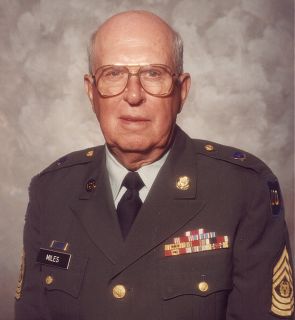
Robert L. Miles
CSM Robert L. Miles enlisted in the Army Reserve 20 August 1942 and entered on active duty after completing Signal Corps School at Lexington, KY on 28 May 1943. He was discharged from service on 14 November 1945 after serving as a Staff Sergeant for 18 months in the Pacific Theater. He enlisted in the Kentucky National Guard in 1949 and served until mid-1950 at which time he enlisted in the Army Reserve and entered active duty at Fort Campbell, KY as billeting NCO. Leaving active duty in 1951, he served in various units of the Army Reserve until 15 April 1953 when he was assigned as First Sergeant of Company I, 3rd Battalion, 399th Regiment. On 12 September 1966, he was assigned as Battalion Sergeant Major of Headquarters 3rd Battalion, 399th Regiment and on 1 August was appointed as Command Sergeant Major.
CSM Miles retired from the 100th Division on 24 December 1981 with 35 years and 6 months total service. During his service with the 100th Division, CSM Miles held the position of Administrative-Supply Technician for the 3d Battalion from 1967 until his retirement. As First Sergeant, Sergeant Major and then Command Sergeant Major, CSM Miles was known as “Mr. 3/399th”. His knowledge and expertise in all matters of reserve duty was sought and heeded by officers and enlisted soldiers alike.
During his 18 years tenure with the 3rd Battalion, 399th Regiment, 2nd Brigade, 100th Division, much to his oversight and leadership, the following were accomplished:
Companies of the 3d Battalion led JROTC units summer camps at Fort Knox
Satellization of 3d Battalion companies with active duty BCT companies
Drill Sergeant Program trained outstanding Drill Sergeants,
He received recognition from MG Benjamin J. Butler for his outstanding supervisory and logistical support to theU.S. Army Training Center, Fort Campbell during January 1968. He received a “Sustained Superior Performance Award” from MG Zack C. Saufley for the period 3 September 1979 to 2 September 1980.
His initiative, superior performance, inspiring example and devotion to duty contributed greatly to the success of the 3rd Battalion, 399th Regiment over many years. Few individuals contributed more to these successes than he. CSM Miles is a life member of the Association of the Century and continues to support the 100th Division as an advocate of the local unit in Hopkinsville.
His decorations and awards include the following:
Meritorious Service Medal
Good Conduct Medal
Army Reserve Components Achievement Medal with three Bronze Oak Leaf Clusters
American Campaign Medal
Asiatic-Pacific Campaign Medal with three Bronze Service Stars
World War II Victory Medal
National Defense Service Medal
Armed Forces Reserve Medal with two Hourglass Devices
1998—Inducted into Corridor of the Century.
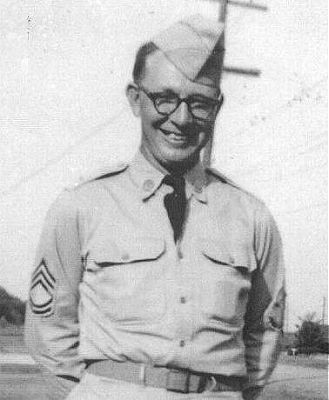
Sheril E. Douglas
Command Sergeant Major Sheril E. Douglas was the first Command Sergeant Major of the 100th Division. He also was one of the first soldiers to be advanced to the rank of E-9. He was born 23 May 1919 in Spencer, WV, and attended high school there. He graduated from the University of West Virginia.
CSM Douglas enlisted in the U.S. Army in 1939 at Fort Hayes, OH, serving during WWII. After completion of basic and advanced individual training, he was assigned as a radio and communications instructor at Fort Knox, KY, and later at Fort Ord, CA.
Following WWII, he joined the 399th Airborne Infantry Regiment of the 100th Airborne Division in its early days as a reserve unit. He served in the 399th Regiment until the reorganization of the division into a training division in 1959.
When the new enlisted grades of E-8 and E-9 were established, CSM Douglas was one of the first soldiers to be promoted to E-8 and later to E-9.
He served with distinction as the first Division Command Sergeant Major during the 1961-62 Berlin crisis at Fort Chaffee, AR.
As the first Division CSM, he was highly instrumental in breaking new ground and pioneering the development of the duties of the Command Sergeant Major position.
He as an avid pistol shooter and competed within the division from 1957 until 1963 when he left the division. He represented the division in regional, state, corps and army matches. After leaving the division he continued as a competitor with the XX U.S. Army Corps and Second U.S. Army pistol teams.
In civilian life, he was first a partner in a radio and television appliance repair business and later worked for Facett-Dearing Printing and lastly for World Color Press. He retired in 1981.
CSM Douglas died 13 August 1982 and is buried in Calvary Cemetery in Louisville, KY. His widow, Ria, resides in Louisville.
His decorations and awards include:
Army Commendation Medal
Good Conduct Medal
National Defense Service Medal
Armed Forces Reserve Medal with two Hourglasses Devices
American Defense Service Medal
American Campaign Medal
1999—Inducted into the Corridor of the Century.
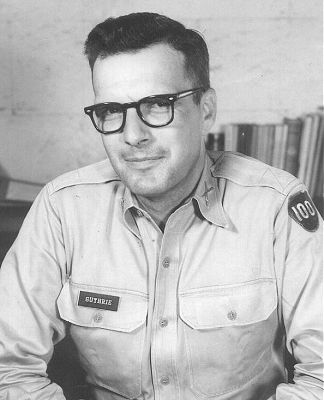
Blaine A. Guthrie, Jr.
Major Blaine Allen Guthrie, Jr. joined the 100th Division in 1953 as Commanding Officer, Company A, 1st Battalion, 399th Infantry Regiment in LaGrange, KY.
In the 1960s, he was reassigned to Division Headquarters as the Division Information Officer where he served when the Division was recalled to active duty during the Berlin Crisis in 1961-62. He organized the “Century News Day” for hometown news personnel so they could see and report on their local citizen-soldiers both in a reserve and an active duty status. He later served as an Assistant G3 in the Assistant Chief of Staff, G3 Section.
Chairman BG Bodley Booker, Jr. appointed Blaine to the Association of the Century Museum Committee in early 1993. He was highly instrumental in the organization of the 100th Division Museum and Archives, now the Century Division Historical Holding Center and an element of the Center for Military History. He served as the first curator until March 1995. As such, he devised the current system of cataloging, storing and displaying artifacts and memorabilia relating to the 100th Division. He continued on the committee as the historian and worked diligently on the center’s holdings.
Blaine was a life member of the Association of the Century.
He was active in genealogy, having developed and published a book on the current generations of the Guthrie-Wetherby families. Blaine was highly interested in history, particularly of the local community. He founded a history preservation group, Historic Middletown, and served as its first president in 1966.
As president of the historic group, he helped start Middletown’s historic marker program for buildings and homes with historic significance. He has been chairman of the Middletown Preservation Commission and a docent at Locust Grove Historic Home. He served as president of the Louisville Civil War Round Table and a member of the World War II Round Table.
Major Blaine was employed in advertising, having worked for United Mercantile Agency, Madison Advertising Agency and a partner in Boone Advertising Agency.
He was married to the former Cornelia “Connie” Wetherby and they have two sons. Blaine died on 10 August 1997.
His awards and decorations include the following:
Army Commendation Medal
National Defense Service Medal
Armed Forces Reserve Medal
1999—Inducted into the Corridor of the Century.

O. J. Jennings III
Colonel O. J. Jennings III was commissioned a Second Lieutenant on 4 June 1962 through the ROTC at Murray (KY) State University as a distinguished military graduate.
He entered on active duty in August 1962 and attended the Transportation School qualifying as Transportation Corps officer. He attended the Transportation Officer Advance Course, Command and General Staff College, Armor Officer Advance Course, Transportation Corps Field Grade Officer Course, Reserve Components National Security Course, and Senior Officer Preventive Logistics Course.
During his 30+ years of military service both active and reserve, he has held many positions each with greater responsibilities. While on active duty he was the U.S. Army Aerial Support Center’s Comptroller in Europe (France) from 1962 through 1964.
He joined the 100th Division in January 1963 serving as a platoon leader in Co. L, 3rd Bn, 398th Regt, 2d Bde. He later was advanced to company commander of the redesigned Company C. He held the S3 position at the 398th Regt. He relocated to central Kentucky where he was the adjutant of Hq, 1st Bn, 399th Regt for a short time until the unit reorganized and he became the adjutant of the Leadership Academy. He became Test Section Commander; an assistant G-3 in division headquarters; commandant of HHC; assistant chief of staff, G-4; division finance officer, commander of 2nd Sqdn, 302nd Cav, 3rd Bde and assistant chief of the combat exercise division in MTC. He completed his career as the commander of the 1667th IMA Detachment. He retired August 1992.
His most stellar performance was his devotion and achievements in his USAR civilian technician positions held within the 100th Division from his initial employment in June 1971 until his retirement in January 1998. He served with distinction as the Resource Management Officer (RMO) in the Deputy Chief of Staff, Resource Management (DCSRM), of division headquarters from January 1976 until January 1998. In his early years he was an Administrative-Supply Technician (AST) in Paducah and Shelbyville. In 1989 and 1991 the division was awarded the Second U.S. Army Outstanding Resource Management Award (MUSARCs). He was awarded the Commander’s Award for Civilian Service in December 1992 by MG Lindsay M. Freeman for tenure as Resource Management Officer.
COL Jennings is active in The Association of the Century, Inc., serving as the treasurer and a member of the Board of Directors. He is a life member. He is a life long adult volunteer leader in the Boy Scouts of America (BSA) and was awarded the MG Benjamin J. Butler Community Relations Award in 1976 for his community service to scouting. He is married to the former June Shrader and they have two sons.
His decorations and awards include the following:
Meritorious Service Medal with 3 Bronze Oak Leaf Clusters
Army Commendation Medal
Army Reserve Components Achievement Medal with 5 Oak Leaf Clusters
National Defense Service Medal
Armed Forces Reserve Medal with 2 Hourglass Devices
Army Service Ribbon
Overseas Service Ribbon
1999—Inducted into the Corridor of the Century.
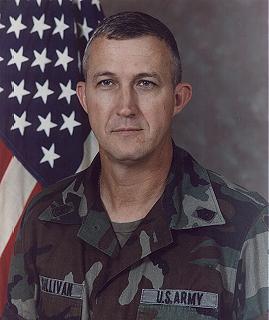
David N. Sullivan
Command Sergeant Major David Norris Sullivan enlisted in the 100th Division in February 1964 and retired in October 1996 after more than 32 years of service. Displaying at all times high professional competence, strong initiative and unfailing devotion to duty and consistently performing in an exemplary manner, he has served in many positions while a member of the 100th Division. Among his assignments were positions of Instructor, Chief Instructor, Command Sergeant Major and Division Command Sergeant Major.
Being a young non-commissioned officer in the 100th Division Committee Group, he was an Instructor on the Close Combat Range and the Individual Tactics Training Range. His exceptional professional competence and outstanding organizational ability resulted in receipt of numerous superior ratings from evaluators and counterparts. As Chief Instructor in the Training Command, his standards of appearance, military courtesy, and exceptional knowledge of instructing, helped immensely in preparing all Instructors for their “murder” boards thus leading to a very successful annual training periods.
CSM Sullivan served as Command Sergeant Mayor in the following units: the 100th Training Command from February1982 to January 1987, 100th Reception Battalion from February1987 to December 1990, and the 1st Brigade (OSUT) (AR) from January 1991 to September 1992.
While serving in these positions and under his dynamic leadership these three units won four out of nine color guard competitions from 1983 to 1992 with no team ever finishing less than fourth place. In January 1991 until March 1991, the brigade was activated for Operation Desert Storm where he was the Task Force 100 Command Sergeant Major under the Command of COL William E. Barron.
Task Force 100 had over 1100 Division soldiers assigned. Because of Command Sergeant Major Sullivan’s untiring efforts, working very long hours with very capable leadership, made the mission a great success.
As the Division Command Sergeant Major from October 1992 to October 1996, he met all challenges and overcame all problems that arose through his ability to consistently take the “common sense” approach in resolving the numerous and diverse problems that are usually associated with someone in that position.
He was instrumental in setting up the U.S. Army Reserve Drill Sergeant of the year program. The 100th Division won the title for four consecutive years, unprecedented among this national competition.
Under his outstanding leadership abilities the division was able to keep NCO’s trained in their MOS, NCOES and Drill Sergeants qualified at a high percentage to remain the number one training division in the USAR.
CSM Sullivan’s military schooling included MOS training at Fort Jackson, SC and Fort Benning, GA; instructor training course at Fort Knox, KY; the Battalion Training Management School and the Senior Non-Commissioned Officer Course.
His civilian activities show his responsibility, his vision and his commitment toward a team effort in perpetuating the image of the Century, which spanned decades and he actively continues this role in retirement. He is a life member of the Association of the Century and serves on the Board of Directors. He a member of the Mt. Washington’s First Baptist Church.
He is married to the former Vivian I. Jones and they have three children. They reside in Mt. Washington, KY. CSM Sullivan was born in Greensburg, KY on 10 November 1944. He graduated from Taylor County High School in Campbellsville, KY, in 1963. In civilian life he retired from Ford Motor Co. in 2000 after more than 35 years with the manufacturing firm in Louisville. His last assignment was as hourly material controller.
Command Sergeant Major David N. Sullivan will be remembered as truly the CSM for the soldiers.
His decorations and awards include the following:
Legion of Merit
Meritorious Service Medal with 3 Oak Leaf Clusters
Army Commendation Medal with 2 Oak Leaf Clusters
Army Achievement Medal with Oak Leaf Cluster
Army Reserve Components Achievement Medal with 5 Oak Leaf Clusters
National Defense Service Medal, 2nd Award
Armed Forces Reserve Medal with Hourglass Device
NCO Professional Development Ribbon, Level 3
Army Service Ribbon
2000-Inducted into the Corridor of the Century.
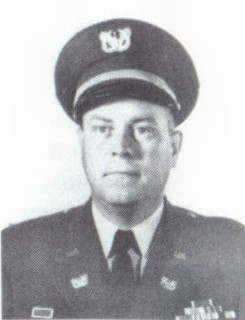
Coleman R. Tussey
Chief Warrant Officer Coleman R. Tussey volunteered for the U.S. Army in August 1944 and received his basic training at Camp Wolters, TX. After basic training he was shipped overseas and assigned to Company B, 325th Combat Engineers, 100th Division on 7 January 1945 as an electrician. He was wounded on 17 March 1945 in the battle for the Citadel of Bitche in France (Battle of Bitche). He rejoined the unit in April 1945 and remained with Company B, until August 1945. He returned to the U.S. and was discharged in July 1946.
Coleman Tussey rejoined the 100th Division on 9 April 1958 as a Warrant Officer with Company A, 1st Battalion, 397th Regiment, 1st Brigade in Richmond, KY. When the Division was recalled to active duty in 1961 for the Berlin Crisis, CW2 Tussey was ordered to Fort Stewart, GA. He served with Headquarters and Headquarters Detachment, 418th Ordnance Battalion. Upon his release from active duty on 14 August 1961, he was reassigned to Headquarters and Headquarters Company in Richmond, KY, as the food service advisor.
CW4 Coleman R. Tussey retired in July 1975 with 31 years of service.
At the time of his retirement, CW4 Tussey was the last member of the 100th Division from WWII to still be serving in the division. He had the distinction of wearing the division patch on both shoulders of his uniform. He died 22 July 1999 and is buried in the Florida National Cemetery in Bushnell, FL.
Mr. Tussey was born 26 April 1925 and graduated from Jackson County High School in McKee, KY in 1943. From April 1943 to August 1944 he attended Eastern Kentucky Teachers College and worked as an electrician before joining the army. He was employed as a civil service employee for the U.S. Army Reserve serving as the Administrative-Supply Technician (AST) for the 1st Battalion in Richmond from October 1964 to July 1975.
CW4 Tussey was a life member of the Association of the Century. He and his wife Louise have two children and five grandchildren.
His awards and decorations include the following:
Purple Heart
Good Conduct Medal
European-African-Middle Eastern Campaign Medal with two Service Stars
World War II Victory Medal
Army of Occupation Medal
Army Reserve Components Achievement Medal
National Defense Service Medal
Armed Forces Reserve Medal
Presidential Unit Citation
In September 1991 he returned to France and Germany and was able to retrace many steps he had made there during WW II. He visited the Citadel of Bitche and was able to tour the interior of this never before defeated historical fortress. It became most evident to him why it was so difficult for the 100th Division to capture. He saw the plaque dedicated to the nearly 3,000 men of the 100th Division wounded and killed in the siege.
Deceased. CW4 Tussey died 22 July 1999.
2000-Inducted into the Corridor of the Century.
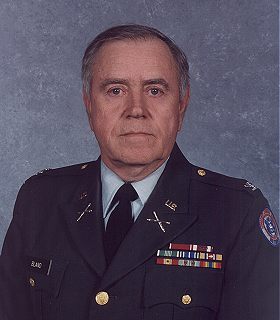
Francis H. Bland
Colonel Francis Henry Bland enlisted in the 100th Division in 1961 and was called to active duty at Fort Chaffee, AR, where he served as a basic training Platoon Sergeant and an Administrative Assistant. He was commissioned a Second Lieutenant upon completing the First Artillery Officer Candidate School at Fort Sill, OK, in May 1965.
He was born 3 December 1938 in Lebanon, KY. He graduated from Saint Charles High School in that central Kentucky city. He earned an Associate’s Degree from Jefferson Community College in Louisville, KY, and later received his Bachelor’s of Arts degree in Business Administration from McKendree College in Lebanon, IL.
His 28+ years of commissioned service have been filled with a myriad of positions to include: Platoon Leader; Commander of Company A, 2nd Battalion, 397th Regiment; Assistant Adjutant General; Military Personnel Officer; Assistant Chief of Staff, G-3; Commander of 2nd Battalion, 397th Regiment, 1st Brigade; Division Deputy Chief of Staff; and Chief of Plans, Operations and Training, Maneuver Training Command. He was assigned as Commander, 4th Brigade (Training Support) from May 1988 to August 1991. It was during this timeframe that he was mobilized again with his brigade to support Desert Storm and served on active duty from January through March 1991. He is one of only a few to have been mobilized twice with the 100th Division. Colonel Bland’s last assignment was Division Chief of Staff from August 1991 until his retirement in December 1993, completing 37 years of military service.
He completed the Field Artillery Officers Advance Course, the Armor Conversion Course and the Command and General Staff College.
In civilian life, Colonel Bland served more than 30 years as an Army Reserve technician. During this period he served in positions at battalion, brigade and division levels. In his last 12 years of civilian service5 he was the Command Executive Officer (CXO) for the 100th Division, having served as both a civilian employee and active military Colonel during that term.
Colonel Bland is married to the former Shirley Hamilton and they have four children.
His decorations and awards include the following:
Legion of Merit
Meritorious Service Medal with 3 Oak Leaf Clusters
Army Commendation Medal
Army Reserve Components Achievement Medal with 5 Oak Leaf Clusters
National Defense Service Medal
Armed Forces Reserve Medal with 2 Hourglass Devices
Army Service Ribbon
2000—Inducted into Corridor of the Century.
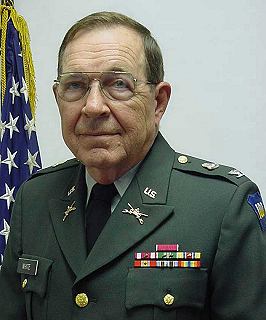
William C. White
Colonel William C. White joined the 100th Division’s 3d Battalion, 399th Regiment, in Hopkinsville, KY, on 9 August 1960, as a PFC. Following basic and advanced infantry training, he was released from active duty to his unit for three months and was activated with the 100th Division call-up to Fort Chaffee, AR, during the Berlin Crisis in September 1961. Serving as the Training NCO for Company M, 3d Battalion, 399th Regiment, he was instrumental in the company’s training of three cycles of basic trainees and was promoted to Sergeant.
On 28 October 1962, he was commissioned a Second Lieutenant and rose in rank to Colonel on 3 August 1987. During his 32 years of military service, all of which while wearing the 100th Division shoulder patch, Colonel White held positions with advancing responsibilities.
He served as Platoon Leader, Battalion Adjutant and Training Officer, Operations Officer, Company Commander, Supply Officer, Executive Officer and Battalion Commander, all with the 3d Battalion, 399th Regiment, 2nd Brigade. He also served as an Assistant G3, Headquarters, 100th Division; Executive Officer, 2nd Brigade; Executive Officer, Headquarters, 100th Training Group; and Assistant Chief of Staff, G1, Headquarters, 100th Division. His last assignments were as Chief OPFOR, Combat Exercise Division, 100th Maneuver Training Command and from 1 September 1989 to his transfer to the Retired Reserve on 24 February 1992, was Chief of the Combat Exercise Division, 100th Maneuver Training Command. In his last assignment, Colonel White led seven Combat Army Training and Evaluation Teams to greatly expand their capabilities to execute all Army combat training exercise missions from platoon through brigade.
In civilian life, Colonel White is Director, Bluegrass Station Division, Department of Military Affairs, Commonwealth of Kentucky. In this position, he is responsible to the Adjutant General for the economic development of the former Lexington Blue Grass Army Depot at Avon, which closed in 1995.
Colonel White is active in many organizations—a life member of the Association of the Century, Reserve Officers Association, American Legion, Military Order of the World Wars, Army Reserve Association, The Retired Officers Association, Louisville Armed Services Committee, National Association of Installation Developers, University of Kentucky Alumni Association, and is active in his church, Frankfort United Methodist.
Colonel White is married to the former Joan Baker and they have four children and nine grandchildren.
Colonel White is remembered best by those 100th Division soldiers, officers and non-commissioned officers, with whom he served as a leader who led by example and one who provided help and encouragement to excel in their mission and exceed their own expectations.
His decorations and awards include the following:
Legion of Merit
Meritorious Service Medal with Bronze Oak Leaf Cluster
Army Commendation Medal with two Bronze Oak Leaf Clusters
Army Reserve Component Achievement Medal with four Bronze Oak Leaf Clusters
National Defense Service Medal
Armed Forces Reserve Medal with Hourglass
Army Service Ribbon
2001—Inducted into Corridor of the Century.
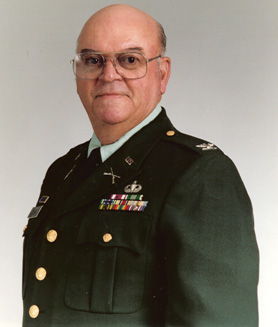
Lee G. Harris, Jr.
Colonel Lee G. Harris Jr. enlisted in the Army on 16 April 1953 in Company I, 119th Inf, 30th Infantry Division, NCARNG. Between his enlistment in 1953 and April of 1974 Harris held a number of positions in Special Forces Units (Abn) and Military Police Units in the NCARNG. On 28 October 1956 Harris received a Direct Commission and was promoted to 2nd Lieutenant in Company I, 119th Inf, 30th Infantry Division, NCARNG.
Harris was transferred with his civilian employment to Lexington, Kentucky in January of 1974. Not wanting to be out of uniform too long Harris found a position in the 100th Division Maneuver Training Command as an Assistant Operations Officer in April of 1974. He was assigned as a Team Leader, Infantry Team #2 and conducted ATT’s, CPX’s and practice ATT’s for numerous USAR, ARNG and RA units. Infantry Team #2 of the 100th MTC worked closely with Readiness Group Knox in the development and application of combat simulation exercises. COL Harris served as Team Leader for Infantry Team #2 from 26 April 74 until 2 January 76 when he was assigned as Chief of Operations Division (S-3), MTC. During Harris’ tenure as S-3 the 100th Division MTC increased the number of ATT’s, CPX’s, TEWT’s, CAAMS and other exercises for USAR, ARNG and RA units to over 100 per year. This was more exercises than any other USAR MTC was conducting per year. Colonel Harris was assigned as Brigade Commander, 1st Brigade,100th Division in Lexington, Kentucky on 1 May 1980 where he remained until leaving command on 31 August 1982. Under Colonel Harris’ leadership the 1st Brigade met or exceeded all recruiting and retention goals established for the Brigade. During TY 1981, the 100th Division established the training goal to maximize MOS qualification. The Brigade with the best MOS qualification rate in an armor battalion or a cavalry squadron would be allowed to send those units to conduct annual training with an active duty counterpart unit at Fort Hood, Texas. The 1st Brigade won both the Armor and Cavalry challenges and conducted annual training in 1982 at Fort Hood. During Harris’ command tour, the 1st Brigade led all units in the Division as far as strength by some 10% (125%), and retention of NCO’s ranked very high as well (91%). Harris had his unit conduct a hands-on FTX in preparation for SQT testing that was very effective in raising the pass rate on the record SQT. Colonel Lee Harris was known as a solid leader who understood the value of realistic training. The high strength, retention numbers, and MOS qualification percentages were indicators of the positive command climate within the 1st Brigade under Harris’ leadership.
Upon departing 1st Brigade Command Colonel Harris assumed the position of Chief, Kentucky Office of Emergency Management until his transfer to the Retired Reserves in November of 1986.
Military Schools attended by Colonel Harris include Infantry School Advanced NCO Course; Infantry Officer Basic Course; Basic Airborne Course; Infantry Officer Career Course, USASWC; Special Forces Officer Course; Special Forces Jumpmaster Course; Command and General Staff College; NDU National Security Management Course; Air War College; FEMA Emergency Management Course.
Colonel Harris is a past President of the Association of the Century (2000-2001); Assistant Secretary of the AOC 2000 – 2006 and member of the 100th Division Museum Committee since 1998. Lee Harris currently serves as the Curator for the Century Division Museum since 2000. Lee lives in Louisville, Kentucky with his wife Carol.
Awards and Decorations Include:
Meritorious Service Medal w/ Oak Leaf Cluster
Army Commendation Medal w/ Oak Leaf Cluster
Army Achievement Medal
Reserve Component Achievement Medal w/ Oak Leaf Custer
Armed Forces Reserve Medal w/ 2 Hourglass Devices
NCO Professional Development Ribbon
Army Service Ribbon
NCARNG Service Ribbon w/ Ten Year Device
Parachutist Badge
Senior Parachutist Badge
2001 – Inducted into the Corridor of the Century
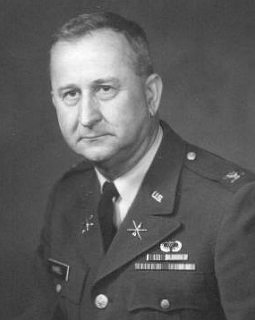
David M. Kimbel
Forty-six years from enlistment in the Kentucky National Guard in 1937 to retired reserve including seven years on extended active duty and four Army schools and 20 years (1947 to 1967) with the 100th Division provided the opportunity for COL David M. Kimbel to register an enviable and prideful effort, a record which results in his selection for inclusion among those patriots of the Corridor of the Century.
LTC Marshall B. Hardy, Jr. (Ret) has assembled the military career of Colonel Kimbel. The positions he held in the 100th Division included:
Div Arty, Assistant S-2, Captain, 1947
S-3, 1950
S-4, Major, 1950-1956
Executive Officer, 373rd FA Bn, 1956-1959
Division G-2, Lieutenant Colonel, 1959-1962
Commanding Officer, 2nd Bn, 397th Regt, 1962-1963
Executive Officer, 100th Regt CST, 1963-1967
Other service included his enlistment in the 138th FA Regt KyNG (Private to Instrument Sergeant), 1937-1942; Instructor at the Artillery School, Fort Sill, OK (Second and First Lieutenant), 1942-1945; Field Artillery Instructor, USMA, West Point, 1945; aide to BG C. E. Hart, First U.S. Army (Captain), 1945-1946; MobDes U.S. Army, General Staff, Pentagon (Colonel) 1967-1969; and USAWC, Carlisle Barracks, 1969.
Colonel Kimbel’s contributions to the division began when the division was designated Airborne. He was the only division officer, except for BG Dillman A. Rash, to earn the Parachutist Badge. While on the DivArty staff, he was undoubtedly the top instructor in the division for both Field Artillery and Airborne subjects.
He was assigned Executive Officer of the 373rd FA Bn in October 1956. The three howitzer batteries were scattered to Shelbyville, Hyden and Owensboro and manned with local reservists, a few of whom had been Artillerymen (in one battery, none). Command was exercised and training was conducted only with extreme difficulty. David instilled in all personnel a love of the guns, and the desire to master them. By his brilliant insistence upon concurrent training, the new officers and men were made proficient in FA at home station in less than a year; the batteries fired service practice at Annual Training that summer. The Battalion grew in strength and proficiency by continuing its intensive concurrent training.
When the 100th Division was redesignated as a Training Division in 1959, the 373rd FA Bn was disbanded; and LTC Kimbel became the Division G-2. As he worked to prepare for Airborne service, he promptly took the Intelligence courses at Fort Sill, OK. In 1961 the 100th Division (alone among USAR Training Divisions) was mobilized at Fort Chaffee, AR for the Berlin Wall Crisis. The threat of nuclear war; of subversion and riots; to personnel, mostly raw draftees; and even constant VIP command and staff briefings; established close liaison with Division Provost Marshal; initiated effective Division counterintelligence; set up, trained and operated a Visitors Bureau. Upon release from active duty in 1962, he attended C&GS College, where he wrote a staff study of the 100th Division’s activation. It was so superior that the Commandant General H. K. Johnson (later, Chief of Staff) recommended its inclusion into the C&GS curriculum.
In 1963 Colonel Kimbel was made Executive Officer of the 100th Regiment (CST). With so many draftees for Vietnam, the Regular Army stopped basic training for USAR and NG recruits. This task was given to the 100th Regiment to be done at the KyNG Armory in Frankfort and at Bowman Field in Louisville. This regiment was organized to train specialists, not recruits. Nonetheless, he hastily identified potential Drill Sergeants and a dual command and staff groups were concocted for the two training sites. It was a great success, processing for a year more than 100 recruits at a time at each site.
His awards and decorations include the following.
American Defense Service Medal
World War II Victory Medal
American Campaign Medal
Good Conduct Medal
National Defense Service Medal
Armed Forces Reserve Medal with Gold (Hourglass Device)
Parachutist Badge
Deceased. COL Kimbel died 1 Apr 97.
2001—Inducted into Corridor of the Century.
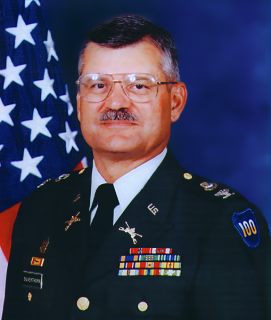
Robert S. Silverthorn, Jr.
Colonel (now Major General) Robert S. Silverthorn, Jr. was commissioned a second lieutenant,Military Intelligence Corps, as a Distinguished Military Graduate, thorough the ROTC programat Dickinson College, Carlisle, PA, on 20 January 1970. He was promptly detailed to theArmor Branch, and reported for active duty in February 1970 at the U.S. Army Armor School, Fort Knox, KY, to attend the Armor Officer Basic Course. This was to be followed by the
Military Intelligence Officer Basic Course at Fort Holibird, MD, before reporting to the 5th Infantry Division, subsequently the 4th Infantry Division (Mech), Fort Carson, CO. MG Silverthorn was then deployed to the Republic of Viet Nam, where he reported in on 4 July 1972 to the 2nd Squadron, 11th Armored Cavalry Regiment, where he would serve as the Squadron Intelligence Officer (S-2). Upon completion of his tour of duty, in 1972, he left active duty, and joined the 100th Division in April of 1972. He was twice decorated with the Bronze Star and also received the Air Medal for combat aerial operations while in Viet Nam.
On 15 December 1974 he was promoted to Captain while serving as Assistant Plans and Operations Officer of the 100th Maneuver Training Command of the 100th Division in Louisville, KY. He then rose in ranks being promoted to the grade of Brigadier General on 10 November 1997 and to Major General on 7 October 2000, while serving as Commanding General of the 95th Division (Institutional Training), Headquartered in Oklahoma City, OK, his presentduty assignment.
While assigned to the 100th Division, Major General Silverthorn served as General’s Aide to the Assistant Division Commander; Executive Officer and Commander of Headquarters and Headquarters Company; Commander of HHC, 100th Committee Group; Cavalry Team, 100th Maneuver Training Command; Secretary of the General Staff; S2/3 for the 100th Service and Support Battalion; Executive Officer of the 100th Logistic Group; Commander of 100th Reception Battalion; Executive Officer of the 2nd Brigade; Assistant Chief of Staff for Resource Management; Commander of the 1st and 3rd Brigades; and Acting Chief of Staff and Assistant Division Commander-Schools.
MG Silverthorn also served as Chief, OPFOR, Combat Service Support Division, 87th Maneuver Area Command, later the 87th Division (Exercise).
Upon his nomination by the President for promotion to flag rank he was reassigned as Assistant Division Commander-Operations and later Acting Commanding General of the 84th Division (Institutional Training), headquartered in Milwaukee, WI; from which we was transferred to his present assignment as Commanding General, 95th Division (Institutional Training) on 16 April 2000.
MG Silverthorn is a lifetime member of and a former two-term President of the Association of the Century. He presently is the national President of the Senior Army Reserve Officers Association; and has been a lifetime member of the Reserve Officers Association since he was a lieutenant. He is an active member of both the U. S. Army Armor Association and a recipient of the Silver Medallion Order of St. George and the U.S. Army Artillery Association and a recipient of the Order of St. Barber. He is an active member of the Sovereign Military Order of the Knight’s Templar of Jerusalem, St. George the Martyr Priory, Washington, D.C.; the Association of US Army and the Order of the Spur. He is also the past president of the Louisville Armed Forces Committee, Louisville, KY.
He has served on the Department of Defenses’ Reserve Component Roles and Missions study group and the Army G-3 Training and Leadership General Officer Steering Committee (TL-GOSC).
In civilian life, Major General Silverthorn received a BA Degree in American Studies from Dickinson College. Later he received a Juris Doctor Degree from the University of Louisville, Brandeis School of Law. He is admitted to practice in Kentucky and before the United Stated District Courts for Eastern and Western Kentucky, Southern Indiana, Southern Texas and Northern Ohio, and the United States Supreme Court. He currently has a private practice at Silverthorn Law Office in Louisville, KY.
Major General Silverthorn has received numerous U.S. decorations and badges, which include the following:
· Bronze Star Medal (with oak leaf cluster)
· Meritorious Service Medal (with Silver plus One Oak Leaf Cluster)
· Air Medal
· Army Commendation Medal (with 2 Oak Leaf Clusters)
· Army Achievement Medal
2002-Inducted into Corridor of the Century.
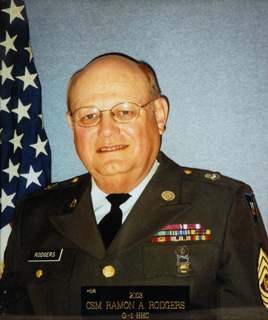
Ramon A. Rodgers
Command Sergeant Major Ramon A. Rodgers enlisted in the 100th Division (Inf) on 5 September1956 while still in high school. He was the 100th person to enlist in the 100th Division under the Reserve Forces Act of 1955. Throughout his career, CSM Rodgers has displayed a high degree of professionalism, providing the leadership necessary to ensure the development of noncommissioned officers and the successful accomplishment of his unit’s mission. His demonstrated professional competence, technical knowledge, high standards, devotion to duty and overall concern for the members of his organization established a model for others to emulate.
During his 35 year career with the 100th Division, CSM Rodgers served in many positions. Among the varied assignments were Field Wireman, Instructor, Senior Instructor, Battalion Operation Sergeant, First Sergeant, Battalion Command Sergeant Major, Brigade Command Sergeant Major and G-1 Staff Sergeant Major at 100th Div HQs.
As a young NCO in the 100th during the Berlin Crisis call-up, CSM Rodgers served as an instructor for Chemical, Biological, Radiological Classes; Tactics; and General Subjects Sections of the 398th Regiment’s Instructor Group during the period 25 Sept 1961 to 15 May 1962. During the period 16 May 1962 to 10 August 1962, Rodgers served as a platoon sergeant for the last cycle of soldiers trained by the 100th Division during it’s Berlin Crisis activation.
From 11 August 1962 to 9 October 1965 CSM Rodgers served as Instructor and Senior Instructor for Company G, 2d Bn, 398th Regt, 100th Div (Tng).
During the period 10 October 1965 through 7 January 1976, Rodgers served as Battalion Operations Sergeant for HHD, 2nd Bn, 398th Regt, 2d Bde(OSUT)(AR), 100th Div (Tng). It was during this period that
Command Sergeant Major Raymond A. Rodgers (Cont)
his excellent organizational and leadership skills and professional competence contributed greatly to his unit’s highly successful back-to-back Annual Training periods at Fort Jackson, SC in 1967 and 1968. CSM Rodgers ability to organize, lead and communicate with all Active and Reserve personnel involved contributed greatly to the very successful and highly complimented Operation REPTRAIN at Ft. Polk, LA in 1972.
As Battalion Command Sergeant Major for HHD, 2d Bn, 398th Regt, 2d Bde (OSUT) (AR) from 1 July 1976 through 31 July 1985, CSM Rodgers provided the leadership so necessary in ensuring the development of his subordinate noncommissioned officers and the successful accomplishment of his unit’s mission regardless of what that mission consisted of. Serving as a role model and mentor, CSM Rodgers encouraged his subordinates to set and meet the highest of standards for themselves, the unit and the Army Reserve. As a result, many of his former subordinates continued on to serve in senior leadership positions and brought great credit upon the 100th Division and the US Army Reserve.
While serving as Brigade Command Sergeant Major for 2d Bde, 100th Division (TNG) during the period 1 August 1985 to 31 October 1989, CSM Rodgers provided strong leadership to his unit which conducted training for Armor Crewmen at Ft. Knox and Ft. Campbell in both initial entry and MOS reclassification skills. His concern about the welfare of his soldiers and their families caused the unit strength to increase to over 100% and maintain the lowest attrition rate in several years for the unit.
As a result of his unique and exceptional qualifications in the field of Army Personnel as a USAR Unit Administrator, CSM Rodgers was awarded a 75Z50 Senior Personnel NCO MOS and assigned to the Staff G1 position at the 100th Division Headquarters from 1 November 1989 until his retirement on 4 October 1991. During this period, CSM Rodgers was instrumental in implementing the new Enlisted Promotion System and the NCO Evaluation Report. CSM Rodgers
Command Sergeant Major Raymond A. Rodgers (Cont)
conducted many workshops for 100th Division units and continued to be an outstanding mentor for junior soldiers. He continued to lead by example setting and enforcing high standards of moral conduct, performance and appearance. He willing accepted the responsibility for his decisions.
CSM Rodgers military schooling included Basic and MOS training at Ft. Knox, Kentucky. Methods of Instruction training, CBR School at Ft. Chaffee, AR; USAR Admin-Supply Technician School; Infantry NCO Career Development Course, Battalion Training Mgmt Supervisors Course, Senior NCO Development Course; AARTC Supply Course.
In civilian life, CSM Rodgers is a member of the Masonic Lodge and the American Legion. He is married to the former Norma J. Nance and they have one son. Rodgers served as a US Army Reserve Admin-Supply Technician in Madisonville, Ky from Oct 1966 to Oct 1993. He served as a Staff Admin Asst for HHC, 2d Bde from Oct 1993 to Nov 1994 and later as a Staff Operations and Training Specialist from Nov 1994 until his retirement from the Department of the Army Civil Service on 29 December 1995.
Decorations and Awards Include:
Legion of Merit
Meritorious Service Medal w/ one Oak Leaf Cluster
Army Commendation Medal
Army Achievement Medal
Army Reserve Components Achievement Medal with five Oak Leaf Clusters
National Defense Service Medal, 2d Awd
Armed Forces Reserve Medal w/ 2 Hourglass Devices
NCO Professional Development Ribbon, Level 3
Army Service Ribbon
2003 – Inducted into the Corridor of the Century
Inductee # 60
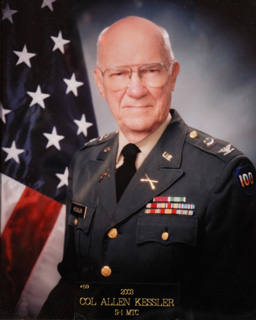
Allen R. Kessler
Allen Kessler was inducted into the Army on November 3, 1942. He was released from active duty in WW II as a 2d Lieutenant on March 13, 1946
Kessler joined the 100th Airborne Division, USAR on March 10, 1948 and was assigned as a platoon leader in the 399th Regiment. During the next thirteen years he served as XO and CO of Company D, 1st Bn, 399th Regt.
On April 12, 1954 Kessler was assigned as the Asst IG, HQs, 100th Division.
When the Division was called to active duty at Fort Chaffee, Arkansas then Major Kessler was serving as the Asst G-3, overseeing the Basic Training Program of Instruction for incoming inductees.
Major Kessler was selected as the Project Officer for the Division Review for the Retirement of MG Dillman A. Rash, CG of the 100th Division at Fort Knox, Kentucky on August 1, 1964. Kessler was later assigned as Division Inspector General on July 1, 1966. Under Kessler’s direction, a plan was instituted for regularly scheduled unit IG inspections. The result was an increase in the number of superior ratings throughout the Division.
In April of 1966, the Commanding General of the 100th Division made the decision to combine Test Company, Transportation Company, Support Company, Receiving Company, The Division Band and HQ & HQ Company into a Provisional Battalion. Kessler, then a Major was selected to command this new unit resulting in an improvement in IG inspection results, MOS qualifications and strength across all companies.
During the years 1965-1968, Colonel Kessler was coordinator for the 100th Division Pistol Team during annual XX Corps matches at Fort Knox each year. Under Kessler’s leadership the team performed well and won First Place Trophies for two years and Second Place Trophies for two years.
On Sept 1, 1968, Kessler was assigned as Asst Chief of Staff, G-1 for the Division. During his tenure as G-1, the strength of the Division had greatly improved by the time Kessler was selected to become the Asst Chief of Staff, G-2 on Jan 1, 1970. While serving as G-2, Kessler established a process to screen, forward and account for security clearances that had been issued. He received a Letter of Commendation from the 100th Division Chief of Staff stating “ Many tangible results have been achieved due to your personal efforts and the fact that the Division’s security clearances are at an all time high is testimony to your efficiency and determination.”
When the 100th Division Maneuver Training Command was activated in 1973, Colonel Kessler was assigned as Chief, ADM/LOG Division until his retirement on June 18, 1980 completing 34 ½ years of military service.
In the summer of 1981, Colonel Kessler headed a four man team to locate addresses for members of the 100th Division that served at Fort Chaffee for a 20th Anniversary Banquet. In March of 1993, he became a member of the 100th Division Museum and Archives Committee. Kessler joined the MG Ben Butler Scholarship Committee in April 2000 and became Chair of that Committee in Oct 2002.
Decorations and Awards Include:
Legion of Merit
Army Commendation Medal
Good Conduct Medal
Army Reserve Components Achievement Medal
American Campaign Medal
World War II Victory Medal
National Defense Service Medal
Armed Forces Reserve Medal w/2 Hourglass Devices
2003 – Inducted into the Corridor of the Century.
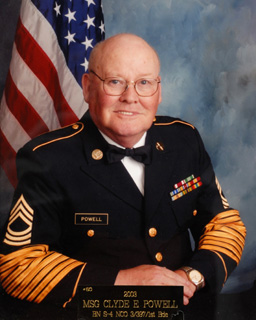
Clyde E. Powell
MSG Clyde E. Powell joined the 100th Division on 12 February 1959 as a unit cook in Company B, 1st Battalion, 397th Regiment, 100th Division in Berea, Kentucky. On 13 September 1961 Powell was called to active duty as a Cook with the 100th Division when the Division was mobilized to Fort Chaffee, Arkansas for the Berlin Crisis Call-Up where he served until 20 August 1962.
Following a year of mobilization, Powell returned to Company B, 1st Bn, 397th Regiment and served as a Mess Sergeant from 13 October 1963 until 8 August 1968. In August of 1968 Powell was transferred to 1st Brigade Headquarters in Lexington, Kentucky where he served as Brigade Food Service Supervisor until 2 January 1978. In March of 1978 Powell transferred to Eastern Kentucky and took a civilian position with the Army Reserve as the Admin and Supply technician for the Hqs, 3d Squadron, 397th Regiment, 1st Brigade, 100th Division in Pineville, Kentucky which he held until 8 December 1983. Since his civilian job required him to also be a Reservist with the unit Powell assumed the position of BN Operations NCO for 3/397 which he held from 12 March 1978 to 11 April 1979. Powell’s next Army Reserve assignment with the “Mountain Squadron” was that of Personnel Services NCO from 11 April 1979 to 3 March 1980 and later as the Logistics NCO from 3 March 1980 to 8 December 1983 which culminated his Reserve service with the 100th Division. Powell continued to serve the Army in several IMA positions in the logistics field at various installations around the country until 1994.
On the civilian side of his long career, Powell transferred to the Admin and Supply technician position for the 2 Bn, 397th Regiment, 100th Division in Bowling Green, Kentucky on 8 December 1983 where he served until 31 March 1986. His final assignment as a civilian was as the Admin and Supply Technician position for 1st Bn, 397th Regt, 100th Division from 31 March 1986 to 4 January 1999 in Richmond Kentucky.
MSG Powell has always had a reputation of being a hard worker and one who was always willing to go the extra mile to take care of soldiers. In his later years he authored a book chronicling stories about the 100th Division during the early 1960’s and later days. Throughout his career as both a civilian and a soldier MSG Clyde Powell has always supported the 100th Division and the Association of the Century whenever called upon. His tireless efforts to establish an “Eastern Kentucky” arm of the Association of the Century have met with much success.
Awards and Decorations Include:
Army Commendation Medal w/ 3 Oak Leaf Clusters
Army Achievement Medal w/ 4 Oak Leaf Clusters
National Defense Service Ribbon
Armed Forces Reserve Medal
NCO Professional Development Ribbon
Army Service Ribbon
2003 – Inducted into the Corridor of the Century
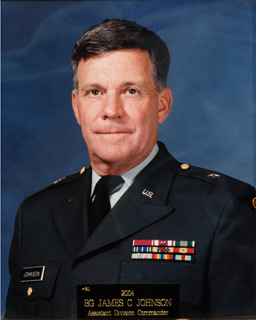
James C. Johnson
A native of Lexington, Kentucky, BG Johnson completed a long and successful military career after having served in both enlisted and commissioned officer ranks that allowed him to lead at all levels from squad to Division.
General Johnson began his enlisted service in July 1956, before graduating from high school and served continuously until his retirement in 1996. His enlisted service included six months basic and advanced training with the 6th Cavalry at Fort Knox in 1957 and eleven months with the 100th Division at Fort Chaffee, Arkansas when the 100th Division was ordered to Active Duty to support the Berlin Call Up in 1961. During this time Johnson completed the Army Pre-commissioning Course and received a direct appointment as a Second Lieutenant on 4 October, 1962.
He gained Junior Officer experience as a platoon leader, assistant S-1 and S-4 in the 397th Regiment, First Brigade, 100th Division in Lexington, Kentucky from October 1962 to November 1970. Following these assignments, he was Test Officer and then Chief Test Officer for the 100th Division from December 1970 to April 1972. During this time, General Johnson implemented new training and testing initiatives to improve the job qualification levels of 100th Division soldiers.
General Johnson was later assigned as the S-2/3 Operations Officer for the First Brigade, 100th Division from May 1972 to August 1974. During this assignment Johnson planned the training and intelligence programs for the brigade. The battalions of the First Brigade were among the top performing units in the 100th Division. A major operation during this time was the highly successful movement of the entire Brigade to Fort Polk, Louisiana in 1972 for two weeks of Annual Training.
Johnson’s next assignment was Executive Officer, First Brigade, 100th Division from August 1974 to August 1975. In this assignment he directed the Brigade staff in planning and implementing the Brigade missions. In August, 1975 he was selected to command the 1st Battalion, 397th Regt, 100th Division in Richmond, Kentucky where he served until July 1978. During this assignment Johnson led the 1st Battalion in a very intense change of mission from Basic Combat Training to Armor and Cavalry One-Station Unit Training (OSUT). In addition to this major change of mission, his Battalion participated in a complete cycle one station unit training of recruits at Fort Polk, Louisiana in 1976. During this period, Johnson completed training in the Armor Cross-Training Program at Fort Knox, Ky.
Johnson’s next assignment was Commander, 2d Battalion, 399th Regiment, 100th Division from August 1978 to June 1979 where he continued training the 399th in Armor OSUT.
His next series of assignments were with the 100th Division’s Maneuver Training Command (MTC) from July 1979 to March 1986. During this time, he held the following positions; Executive Officer; Chief, Opposing Forces Officer, Combat Division; Chief, Plans/Operations Training Division and finally that of MTC Commander from July 1983 – March 1986. During his command, Johnson visited each of the Reserve and National Guard customer units in the MTC’s four state mission area to insure that proper lines of communication had been established between
units to maximize the use of the MTC in training and qualifying their units for combat, combat support and combat service support missions. From April 1986 to May 1988, Johnson commanded the 100th Division Training Group. During this assignment he not only directed the instructors and Test Section for the Division but also planned for a reorganization of the Training Group into a Training Support Brigade. This reorganization was accomplished after his departure from command.
From June 1988 to May 1991, Johnson served as 100th Division Chief of Staff and Assistant Division Commander for Support. In these assignments, he exercised his leadership abilities in directing the planning and executing of the 100th Division missions.
General Johnson concluded his outstanding career as Deputy Commander of the 83d Army Reserve Command which had subordinate units in several states. Johnson was promoted to Brigadier General on 9 November 1991. After successfully completing this very challenging assignment he retired on 16 September 1996.
In civilian life, Johnson received his AB degree in Education from the University of Kentucky. He served as a Army Reserve Technician with the 100th Division for almost 30 years. He was also Operations Officer for the Keeneland Association and President of Johnson Investments, Inc of Lexington.
General Johnson and his wife Virginia reside in Nicholasville, Kentucky and Melbourne, Florida. They have three daughters and a son.
Awards and Decorations Include:
Legion of Merit w/ Oak Leaf Cluster
Meritorious Service Medal w/ 2 Oak Leaf Clusters
Army Commendation Medal
Army Achievement Medal
Army Reserve Components Achievement Medal w. 6 Oak Leaf Clusters
National Defense Service Medal w/ Bronze Star Device
Armed Forces Reserve Medal w/ 3 Hourglass Devices
Army Service Ribbon
Army Reserve Components Overseas Training Ribbon
2004 – Inducted into the Corridor of the Century
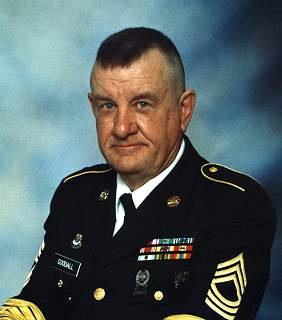
James E. Goodall
Following four years as a member of the Civil Air Patrol, James E. ‘Goody’ Goodall enlisted in the U.S. Air Force in June of 1960 where he served until his discharge in May, 1964. Goodall enlisted in 1978 as an E-4 with Co E, 398th Regt, 2d Bde, 100th Division in Owensboro, Kentucky. As an Armor crewman, MSG Goodall has served on M-48, M-60, M-60 A1, M-60 A2, M-1 and M-1 A2 series of tanks.
After nine years with Company E, 398th Regiment, Goodall was assigned in 1988 as a M-1 Abrams Senior Tank Instructor in Co D, 1/100/4 at Fort Knox Kentucky until 1991. Mobilized for duty in Operation Desert Shield/Desert Storm Goodall reported for duty as a M-1 A2 Abrams Senior Tank Instructor with TF 100 assigned to 5/12 Cavalry.
Following his release from Active Duty in early 1991, Goodall saw duty as a Senior Tank Instructor 19K4H with Co B, 1/100/ 3d TSB at Fort Knox from 1991 to 1995. From 1995 -1996 he served as the NCOIC of the ROTC Basic Camp Mission at Fort Knox. Returning to the 2d Brigade, Goodall served as the S-3 Operations NCO with HHC, 1Bn, 398th Regiment in Owensboro from 1996 – 1997. His last assignment with the 100th Division was as the S-3 Operations NCO with HHC, 7th Brigade, 100th Division, Fort Knox, Kentucky where he retired on 3 August 1999 after some 28 years of dedicated service.
Military Schools that MSG Goodall attended include ANCOC, BNCOC and numerous instructor train-up courses on a number of U.S. Army Armor Vehicles and simulation devices. He holds a BA in Art degree from Brescia College along with a minor in history.
SGM Goodall retired from his civilian occupation as a Visual/Video Commercial Artist with Texas Gas Transmission Corporation in
Owensboro in 1995. Goodall is well known for his many drawings and illustrations that he produced for the 100th Division on numerous occasions. Goodall has served many years as a volunteer with the Fort Knox Patton Museum where he is actively involved as a re-enactor and also works on historic vehicles at the museum. He is a member of the Association of the Century and has served on the Board of Directors since November of 2007. He stays actively involved within his community and is a member of several local Veteran’s organizations. When there is anything to be done that supports Active Soldiers or Veterans, “Goody” can be counted on to be there. MSG Goodall resides in Utica, Kentucky.
Decorations and Awards Include:
Meritorious Service Medal w/Oak Leaf Cluster
Army Reserve Components Achievement Medal w/ Oak Leaf Cluster
Army Service Ribbon
Army Commendation Medal w/ 3 Oak Leaf Clusters
Army Achievement Medal w/ Oak Leaf Cluster
NCODP Award w/ Numeral 3
2004 – Inducted into the Corridor of the Century
Inductee #62
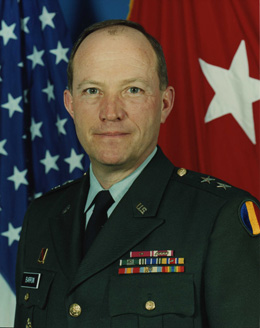
William E. Barron
With over 38 years of faithful service as a “Citizen Soldier”, Major General William E. Barron has distinguished himself by his unfailing devotion to duty, professional expertise and compassion for fellow soldiers. His career is unique in that 33 years of uninterrupted USAR service was spent with the United States Army Reserve’s 100th Training Division. MG Barron enlisted in Company E, 2d Bn, 398th Regt, 2d Brigade as a Private in Madisonville, KY on 26 May 1966 and completed his 33 years with the 100th with a four year tour as Commanding General of the 100th Division in June of 1999.
Upon completion of three years of enlisted time as a 11 Bravo infantryman in the 2d Brigade, MG Barron attended the Kentucky Army National Guard Officer Candidate School and received his commission as a Infantry 2d Lieutenant in June 1969. His first assignment as an officer in the 100th Division was as a Training Officer in Company A, 1st Bn, 397th Regt, 1st Brigade in Richmond, Kentucky. General Barron rose rapidly through the ranks during the next 20 years of commissioned service. His assignments consisted almost totally of command or operational positions and he received “unit vacancy” promotions to the grade of Major in 1979 and Lieutenant Colonel in 1984 in recognition of consistent, superior performance of duties and outstanding leadership ability. One of Barron’s more notable assignments was that of Brigade S2/3 with the 1st Brigade in Lexington, Kentucky from April ’79 until Dec ’82. During this period, the 1st Brigade led the Division in many performance areas such as MOSQ, tank gunnery, overall strength and retention. Due to their high training marks, the 1st Brigade was selected to send units to participate in field maneuvers with the 2d Armored Division at Fort Hood, Texas during Annual Training ’82 which was a first for the 100th Division.
In August of 1985, after highly successful command of the 3d Squadron, 397th Regt, 3d Brigade in Middlesboro, LTC Barron was assigned as the Division G-2 where he helped plan and execute Operation “Roundup” in October ‘85 under then Division Commander, MG Roy C. Gray. In April of 1986, LTC Barron became the Division G-3 where over the next three years his abilities as a planner and a trainer would be quickly recognized. During his tenure as the senior operations officer of the Division, LTC Barron worked tirelessly to improve communications and working relationships throughout the Division. A record number of Non-Commissioned Officers attended NCOES courses and a Company Grade Officer Development Course was developed for all junior officers. LTC Barron and his staff prepared and executed flawless plans for two major Division-wide mobilization exercises, the value of which would not be realized until selected units of the 100th were actually mobilized for Operation
Desert Storm in 1990. He also developed a six-year training plan for the Division which culminated in the first Mobilization Army Training Center (MATC) for the 100th Division and Ft. Knox. During LTC Barron’s tour as G-3, the readiness of the Division reached an all time high and the cooperative relationship between the 100th Division and Ft. Knox served as a model for all TRADOC installations.
In April of 1989, LTC Barron assumed command of the 1st Brigade (Armor) (OSUT) headquartered in Lexington, Kentucky and was promoted to the rank of Colonel on 14 July 89. He was also selected for the Army War College Corresponding Studies Course. As a new brigade commander, he immediately began building a superior record of accomplishments based on sound technical expertise, proven leadership principles and a genuine concern for soldiers. His leadership ability and the 1st Brigade’s high level of readiness resulted in Colonel Barron’s brigade being selected for mobilization at Ft. Knox in support of Operation Desert Storm. His extraordinary preparation of his subordinate battalions comprising “Task Force 100” reflected his tough training focus on 19 Kilo and 19 Delta technical and tactical skills. His caring leadership was underscored by a highly motivated Family Support Program that fully sustained his mobilized soldiers and their families. Colonel Barron’s Task Force 100 consisted of the 1st Brigade headquarters command element, two 19K Armor (AIT) battalions, one 19D Cavalry (AIT) squadron, a Reception battalion and a Test and Evaluation company totaling 722 personnel. While mobilized, Task Force 100 maintained it’s own chain of command and Colonel Barron reported directly to the Commanding General of Ft. Knox, MG Tom Foley.
Colonel Barron was notified by LTG James Crysel, CG, 2d U.S. Army on 1 April 1991 of his selection for promotion to the rank of Brigadier General. His assignment would be that of Assistant Division Commander for Operations for the 100th Division effective 3 June 1991. Colonel Barron was officially promoted to BG on 10 Oct 1992. The current CG of the 100TH, MG Lindsay Freeman allowed BG Barron to operate with great freedom in order to capitalize on his skills as a leader and a trainer. As a result, all four brigades under BG Barron’s direct supervision reached all time highs in personnel qualification, training readiness and excellence in resourcing. Always on the move, always highly visible and active throughout the Division, BG Barron carried the 100th Division’s standards and the “One Army” concept to the soldiers in the field, in reserve centers, on Army installations and into the civilian communities. His ability to communicate with soldiers at all levels helped ensure that 100th Division goals and programs received wide acceptance.
As the 100th Division was faced with TDA downsizing in 1993 and 1994, BG Barron continued his enthusiastic operational support as the Assistant Division
Commander. His uncommon ability to communicate, concern for soldiers, willingness to listen, patience, and organizational skills made him a central figure
in the successful downsizing of the Division. BG Barron’s leadership style
coupled with his compassion and personal example fostered unparalleled productivity and spirit throughout the command during the most difficult of times. In 1993, he was awarded the Cavalry Order of the Spur for his leadership and in May of 1995 received the Bronze medallion for the Armor Order of Saint George.
BG Barron assumed command of the 100th Division on 9 July 1995 and was promoted to Major General on 14 December 1995 in a ceremony hosted by MG (Ret) Ben Butler. In April of 1996, MG Barron was appointed by then Secretary of the Army, Mr. Togo West to a three year term on the Army Reserve Policy Committee (ARFPC). The 100th Division under MG Barron’s leadership continued to prove itself as a leader among the seven Institutional Training Divisions in the Army Reserve. His command stepped out smartly to take on the major support role for the ROTC Basic Camp at Ft. Knox in 1998 and provided significant instructor support to the ROTC Advance Camp at Ft. Lewis, WA. MG Barron’s personal involvement was a motivating factor that resulted in a 100th Division Drill Sergeant winning the TRADOC Army Reserve Drill Sergeant of the Year Competition for four years in a row. He was also instrumental in the selection and mentoring process that resulted in a 100th Division company grade officer being a top ten national finalist for the Reserve Officers Association (ROA) Junior Officer of the Year competition for eight out of ten years and winning the competition for four of those years.
While CG of the 100th Division, MG Barron continued to be a significant contributor to both the Army and his community by serving a four year term on the Governor of Kentucky’s Military Affairs Commission and as a State Committeeman for the Kentucky Employer Support of the Guard and Reserve (ESGR). He also served as State President of the Department of Kentucky Reserve Officers Association for three consecutive years (’93-’95) and was elected to the ROA National post of Army Executive Committeeman for a two year term in 1996. MG Barron also served two terms as a Regional Vice President for the Senior Army Reserve Commanders Association. In 1999 General Barron was nominated by MG Tom Plewes, Chief, Army Reserve for membership on a TRADOC Reserve Component Advisory Group chaired by General John Abrams, CG TRADOC.
Upon completion of his four year command tour at the 100th Division, MG Barron was selected for an IMA assignment as Deputy Commanding General – USAR at
Headquarters, U.S. Army Training and Doctrine Command, Ft Monroe, VA with a
report date of 27 June 1999. MG Barron worked directly for the TRADOC
Commanding General, John N. Abrams and was responsible for integrating the USAR into the day to day operations of TRADOC. Per an agreement between
MG Tom Plewes, Chief, Army Reserve and Gen John Abrams, MG Barron was brought on active duty in February of 2000 for six months at Fort Monroe to become the Director of the The Army School System (TASS). The TASS system, developed in the early 1990’s, utilized RC instructors from the seven USAR Training Divisions to deliver MOSQ training to over 70,000 AC, USAR and ARNG soldiers across the US, Europe and Puerto Rico. This arrangement was so productive that MG Barron continued to serve as the TRADOC Director of TASS for a total of 26 months until TASS was returned to the TRADOC Directorate of Operations and Training Following Sept 11, 2001, Barron was again mobilized at HQs TRADOC in support of Operation Noble Eagle where he played a pivotal role in formulating the master plan for Training Base Expansion across TRADOC installations.
MG Barron continued to serve as the TRADOC DCG-USAR until the end of his four year IMA assignment on 26 June 2003. Upon departing TRADOC, MG Barron remained in the Individual Ready Reserve until his retirement date on 29 July 04.
General Barron and his wife Kelly reside in Elizabethtown, Kentucky where he is the Executive Director of the CORE Committee, Inc., a local organization dedicated to protecting and growing Fort Knox, Kentucky.
AWARDS AND DECORATIONS INCLUDE:
Army Distinguished Service Medal
Legion of Merit w/ 2 Oak Leaf Clusters
Meritorious Service Medal w/ 4 Oak Leaf Clusters
Army Commendation Medal w/ Oak Leaf Cluster
Army Achievement Medal
Army Reserve Components Achievement Medal w/ Silver Oak Leaf
National Defense Service Ribbon w/ Bronze Star
Global War on Terrorism Service Medal
Armed Forces Reserve Medal w/ Gold Hourglass, “M” Device w/ Numeral 2 Device
Army Service Ribbon
Army Superior Unit Award
Army Staff Identification Badge
2004 – Inducted into the Corridor of the Century
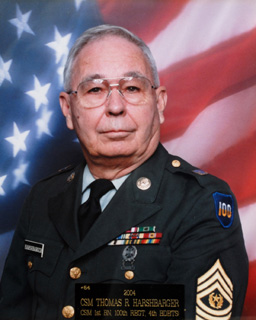
Thomas R. Harshbarger
Command Sergeant Major Thomas Russell Harshbarger enlisted in the 100th Division in November of 1958 and completed basic training and advanced individual training at Fort Knox in May of 1959. He served as Supply Clerk and then as Supply Sergeant of Company I, 3rd Bn, 399th Regiment. In September of 1991, Harshbarger was called to active duty at Fort Chaffee, Arkansas with the rest of the 100th Division. He continued in his capacity as Company Supply Sergeant for Company I until the unit’s release from Active Duty in August 1962.
With over 30 years in the 100th Division, Harshbarger has held a myriad of positions to include 4 years as an Instructor and after a 5 year break in service spent 5 years as a Training NCO for units of 3rd Bn, 399th Regiment, 2d Brigade. He served as the Battalion Operations Sergeant for 3rd Bn for almost 5 years and in 1981 was selected as the 3rd Battalion’s Command Sergeant Major where he served for 7 years. He later served over a year as CSM for the 3rd Bn, 398th Regiment, two years as CSM of 2d Brigade Headquarters and three years for Hqs, 1st Bn, 100th Regiment, 4th TSB located at Fort Knox, Kentucky retiring from this assignment in 1994.
CSM Harshbarger’s exceptional professional competence and outstanding organizational ability resulted in his units receiving numerous superior ratings from both evaluators and counterparts. His standards of discipline, appearance, military courtesy and exceptional knowledge of instructing helped greatly in preparing his soldiers for the expected and unexpected rigors of annual training periods. Under his tutelage, the 3rd Bn, 399th Regiment, representing the 2d Brigade won the 1987 100th Division Color Guard Competition. In 1991, when he was CSM, the 2d Brigade had the highest school attendance by enlisted soldiers in the Division. Also during his stint as 2nd Bde CSM, his soldiers exceeded 2nd Army’s goals in every area of measurement. His units successful mission accomplishments were a direct result of his capable leadership, unflappable persistency and responsive personality. CSM Harshbarger’s initiative, superior performance, inspiring example and devotion to duty contributed greatly to the successes of the units in which he served as Command Sergeant Major. He is remembered by all those with whom he served as a soldier’s soldier!
Military Schools attended by CSM Harshbarger included MOS training in General Supply School; an 80 hour Chemical, Biological and Radiological School; Audio Visual Media School; Reserve Component Reenlistment NCO Course; Senior Noncommissioned Officer Course for Reserve Components; NBC Refresher Course; US Army Sergeants Major Academy and the Tank Commanders Certification Course.
CSM Harshbarger was born in 1937 in Illinois and graduated from West Lafayette Senior High School. He earned a Bachelor of Science Degree in Forestry from Purdue University in 1958. This led to an outstanding civilian career as the Natural Resources Manager and Chief, Natural Resources Branch, Environmental Division, Directorate of Engineering and Housing for HQs, 101st Airborne Division (AASLT) and Fort Campbell from which he is now retired. During his tenures as the Natural Resources Manager, Harshbarger was selected winner of the Army’s Chief of Staff Conservation Award in 1971; the Secretary of Defense Conservation Award in 1973 and the Forest Conservationist of the Year by the Tennessee Conservation League in 1974.
Harshbarger is married to the former Carolyn Sue Kauffman and they have two children and two grandchildren. They reside in Hopkinsville, Kentucky and are active members of the St. John United Methodist Church serving on numerous boards and committees. He is an energetic member of the Association of the Century, continually encouraging current and former members to join the AOC.
Awards and Decorations Include:
Meritorious Service Medal w/ 2 Oak Leaf Clusters
Army Commendation Medal w/ Oak Leaf Cluster
Army Achievement Medal
Army Reserve Component Achievement Medal w/ 4 Oak Leaf Clusters
National Defense Service Medal w 2nd Award
Armed Forces Reserve Medal w/ Hourglass Device
NCO Professional Development Ribbon, Level 4
Army Service Ribbon
2004 – Inducted into the Corridor of the Century – Inductee #62
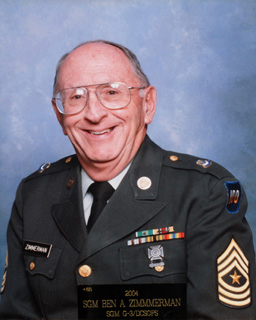
Ben A. Zimmerman
SGM Ben Allen Zimmerman was born January 9, 1940 in Lexington, Kentucky. He obtained the rank of Eagle Scout at age 12 along with Order of the Arrow and God and Country awards. Ben graduated from Henry Clay High School in 1958 and attended the University of Kentucky in 1958-1959.
Zimmerman enlisted in the USAR 728th Railway Transportation Company, 83d ARCOM in August of 1959. He entered into Basic Training at Fort Knox, Kentucky in September of 1959. He graduated from the AIT Combat Engineers Course at Fort Leonardwood, Missouri in March of 1960. Following his active duty for training, Zimmerman returned to the 728th Railway Transportation Company and was later assigned to the 672nd General Supply Company where he was promoted to the rank of First Sergeant.
In March of 1977 Zimmerman transferred to the 2nd Bn, 400th Regt, 3rd Brigade, 100th Division, Winchester, Kentucky as a First Sergeant. In 1977 upon accepting a military technician position as Administrative Supply Technician (AST) Zimmerman transferred to the 1st Sqdn, 302nd Cavalry, 3d Brigade, 100th Division in Frankfort, Kentucky.
In April 1981, Zimmerman accepted a Mil Tech position as Staff Adjutant Technician at the 100th Division Headquarters and also transferred to HHC,100th Division where he was promoted to Sergeant Major and held the following E-8 positions at the Division Headquarters; G-1 SGM , AG SGM, G-2 SGM and G3/DCSOPS SGM until his retirement in December of 1993.
Zimmerman accepted a Mil Tech position in the G3/DCSOPS as a Staff Training Specialist and then as a Staff Operations Training Officer until his civilian retirement in December of 1993.
SGM Zimmerman is retired and lives in Shelbyville, Ky with his wife Renee enjoying grandkids and traveling to Gulf Shores, Alabama. He currently serves as the Secretary of the Association of the Century and has been on the AOC Board of Directors since 2000.
Awards and Decorations Include:
Legion of Merit
Meritorious Service Medal w/ 2 Oak Leaf Clusters
2004 – Inducted into the Corridor of the Century
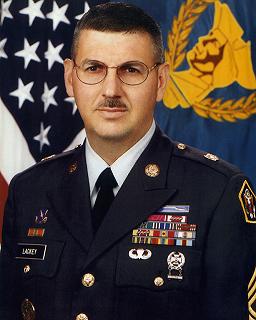
Alex Ray Lackey
CSM Alex Ray Lackey entered the Army in October, 1970 and attended Basic Training at Fort Leonard Wood, MO. His active duty assignments included service as a team/squad leader with the 82d Airborne Division, Fort Bragg, North Carolina, Drill Sergeant duty at Fort Knox, Kentucky and as Platoon Sergeant with the 2nd Infantry Division in Korea.
CSM Lackey left active duty in June 1979 and immediately reenlisted in the Army Reserve’s 100th Division (TNG) as a Drill Sergeant in Echo Company, 2d Battalion, 399th Regiment. He later served as Senior Drill Sergeant, Battalion Operations Sergeant, and First Sergeant in the 2d Battalion, 399th Regiment. Lackey was selected as the Army Reserve Drill Sergeant of the Year in 1982.
From 1991 to 1992 CSM Lackey served as the Commandant of the 100th Division’s Leadership Academy/Drill Sergeant School and was mobilized as part of the 100th Division activated to support Operation Desert Shield/Desert Storm.
From 1993 to1995 CSM Lackey was the Brigade CSM of the 3d Training Support Brigade, 100th Division and later served as Brigade CSM of the 7th Brigade, 100th Division, located at Fort Knox. CSM Lackey finished his tour of duty with the 100th while serving as the 100th Division Command Sergeant Major from Oct 1996 to Sept 1999.
CSM Lackey was selected by LTG Tom Plewes, Chief, Army Reserve to become the 8th CSM of the U.S. Army Reserve in October, 1999. Lackey was on duty in the Pentagon on September 11, 2001 and assisted in rescue efforts that day. Lackey completed his tour as CSM of the Army Reserve in October, 2002
Lackey is retired from the U.S. Postal Service and lives in Bowling Green, Kentucky with wife Debbie. They have four children and 4 grand children.
Ray serves on the Bowling Green/Warren County Veterans Affairs Board, 2d Congressional District Veterans Advisory Board and is a Trustee for VFW Post 1298. He is a Director for the Independence Bank in Bowling Green.
Decorations and Awards Include:
Army Distinguished Service Medal
Legion of Merit Medal
Defense Meritorious Service Medal
Meritorious Service Medal w/ Sliver Oak Leaf
Army Commendation Medal w/ 2 Oak Leaf Clusters
Army Reserve Components Achievement Medal w/ Silver Oak Leaf
National Defense Service Medal w/ 2 Bronze Stars
Armed Forces Reserve Medal w/ “M” Device
Noncommissioned Officers Professional Development Ribbon w/ Numeral 4
Army Service Ribbon
Overseas Service Ribbon
Army Superior Unit Award
Expert Infantry Badge
Parachutist Badge
2006 – Inducted into the Corridor of the Century.
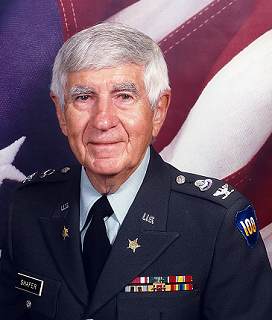
Donald R. Shafer
During his 30 plus years of military service, both Active and Reserve, Colonel Don Shafer held numerous positions of responsibility. He joined the 100th Division Committee Group in 1968 and later went on to serve as Commander, 2nd Battalion, 397th Regiment, 1st Brigade, 100th Division. Colonel Shafer also commanded the 100th Division Training Command from 1979 to 1982. He completed his career with the 100th as 100th Division Chief of Staff.
Throughout his long career, Shafer was devoted to developing young officers and was instrumental in encouraging many to stay until retirement. He also excelled in Non-Commissioned Officer development leading to fulfillment of technical and educational requirements for many soldiers.
Colonel Shafer was instrumental in developing the Association of the Century and served as one of its early Presidents in 1984-1985. He derived great satisfaction in watching the Association’s membership grow in the early years of the AOC.
Colonel Shafer resides in Pace, Florida but keeps his Kentucky roots with three children residing in Louisville and Lexington.
Decorations and Awards Include:
Meritorious Service Medal
Army Commendation Medal w/ 2 Oak Leaf Clusters
Army Reserve Components Achievement Medal w/ 3 Oak Leaf Clusters
National Defense Service Medal
Armed Forces Reserve Medal w/ 2 Hourglass Devices
Army Service Ribbon
2006 – Inducted into the Corridor of the Century.
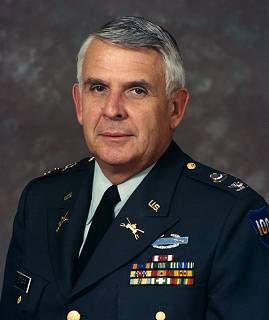
James R. Starr
Upon graduation from Eastern Michigan University, then 2LT Starr was recognized as a Distinguished Military Graduate. His Active Duty positions included a tour in Vietnam as Executive Officer to an Infantry Advisor Team and later Senior Advisor to the 10th Infantry Division (ARVN) training center. He left Active Duty in 1968 and joined the 100th Division (TNG) in 1969 serving in many positions of responsibility in the 100th Division’s Maneuver Training Command, 100th Supply and Service Battalion. Colonel Starr’s final assignments in the 100th Division were as Division Chief of Staff and Assistant Division Commander (Support).
While serving in the 100th, one of Colonel Starr’s most rewarding contributions was a the Division’s Chief of Staff, when in 1991 the Division was activated at Fort Knox, Kentucky to support Operation Desert Shield/Desert Storm. Starr along with the 100th General Staff and the Ft. Knox Armor Center Staff was given the mission to formulate, execute and support a completely new Individual Ready Reserve (IRR) mobilization plan for the 100th Division. This plan was completed and executed within 10 days notice when almost 1200 100th Division soldiers were mobilized for active duty, reporting to Fort Knox to conduct training for activated IRR personnel.
Colonel Starr retired from the 100th Division in 1994 with 30 years of Army service. He is a life member of the Association of the Century and served as President 2005-2006. In addition he is a member of the U.S. Army Armor Association, life member of VFW Post 1170 and Military Officers Association of America. Colonel Starr is retired from General Electric.
Decorations and Awards Include:
Legion of Merit
Meritorious Service Medal w/ 2 Oak Leaf Clusters
Air Medal w/ Oak Leaf Cluster
Army Commendation Medal
Army Achievement Medal
Army Reserve Component Achievement Medal w/ 4 Oak Leaf Clusters
National Defense Service Medal w/ Service Star
Vietnam Service Medal w/ 2 Battle Stars
Armed Forces Reserve Medal w Hourglass Device
Republic of Vietnam Campaign Medal w/ Device
Army Service Ribbon
Combat Infantry Badge
2006 – Inducted into the Corridor of the Century.
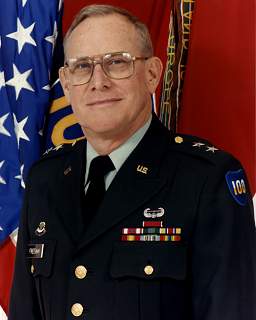
Lindsay M. Freeman
Major General Lindsay M. Freeman is a native of Hopkinsville, Kentucky. He graduated from Murray State University in 1959 where he earned a Bachelor’s Degree in Business Administration. Upon graduation from Murray State University he received his commission as a Second Lieutenant through the ROTC program on June 1, 1959 and was recognized as a Distinguished Military Graduate.
General Freeman’s active duty assignments included the United States Infantry School, Fort Benning, Georgia and Executive Officer, Company C, 14th Bn, Special Training Regiment, Fort Knox, Kentucky.
Freeman had over 36 year’s service in the 100th Division serving in various command and staff assignments. Key assignments included Commander of I Company, 3d Bn, 399th Regt, 2d Bde; Executive Officer and later Commander, 3d Bn, 399th Regt, 2d Bde; Deputy Commander and Commander, 2d Brigade; Chief, OPFOR, Combat Division, Maneuver Training Command; and Assistant Division Commander and Commanding General, 100th Division (Tng).
MG Freeman is a graduate of the Infantry Officers Basic Course, the Military Police Officers Advance Course and the Physical Security Course. He also completed the Command and General Staff College and the National Security Management Program.
During his many years of service in the 100th Division, General Freeman continually provided exceptional leadership and guidance to the soldiers under his command. As Deputy Commander of the 2d Brigade in 1981/1982 Freeman was instrumental in establishing at Weekend Training Site (WETS) at Fort Campbell, Kentucky and oversaw the stationing of six 100th Division M60 tanks at that location. This was extremely important for the 2d Brigade units located throughout Western Kentucky since they could now realistically train and maintain there own armor vehicles and not have to travel great distances to Fort Knox on the weekends. General Freeman was selected to command the 100th Division in July 1991 and under his command, the Division experienced four years of exceptional success in all areas of measurement. He retired from the 100th Division in July 1995.
MG Freeman has been a member of the Association of the Century since it’s inception. He attends every annual meeting and was instrumental in the growth of the 100th Division Historical Holding Center. In 1994, while Commander of the 100th Division, Freeman directed his staff to secure some of the World War II era weapons for the museum. He loaned the museum three display weapons from his own personal collection. His actions resulted in a dialogue with the Center for Military History in which the 100th Division Museum and Archives was accepted into the Center for Military History as the Century Division Historical Holding Center. Few individuals contributed more to the success of the Holding Center than did he.
As an energetic life member of the Association of the Century, MG Freeman continually encourages current and former members of the 100th Division to join the AOC. Active in community affairs, General Freeman is Chairman of the Fort Campbell Retiree Council, an organization that is responsible for providing the Army Chief of Staff and the Installation Commander with insight into vital issues concerning retirees along with assisting the CG, Fort Campbell in setting up and conducting the annual Retiree Appreciation Day. The Fort Campbell Retiree Council represents some 55,000 area retirees. Freeman is also very involved in ‘The Greatest Generation”, an endeavor to recognize WWII Veterans by transporting them to areas of the world in which they served their country. General Freeman is also involved in state, local and national politics.
General Freeman and his wife Nancy reside in Hopkinsville, Kentucky, and have two grown children, Morgan and Elizabeth.
Awards and Decorations Include:
Legion of Merit
Meritorious Service Medal w/2 Oak Leaf Clusters
Army Commendation Medal
National Defense Service Medal
Army Reserve Components Achievement Medal w/4 Oak Leaf Clusters
Armed Forces Reserve Medal
Army Service Ribbon
Air Assault Badge
2007 – Inducted into the Corridor of the Century
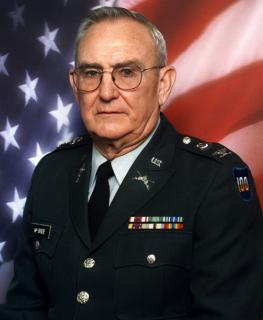
Charles L. McBride
Colonel Charles L. McBride enlisted in the 412th Engineer Brigade, USAR, Vicksburg, Mississippi on September 4, 1956. On December 7, 1964, while serving in the 80th Training Division, Bristol, Virginia, Colonel McBride received a direct commission as a Second Lieutenant.
He completed the Infantry Officer Basic Course, the Infantry Officer Advanced Course, the Command and General Staff College and the Reserve Components National Security Course.
McBride joined the 100th Division in July 1971 and was assigned as Commander, Company C, 3d Bn, 4th Brigade (CST). He served in this capacity until October 1972 when he was reassigned as the Committee Chief, Food Service Committee, 4th Brigade (CST). He held this position until December 1972.
From January 1973 to January 1974, Colonel McBride served as the Maneuver Engineer Officer, 100th Maneuver Training Command.
In February 1974 McBride was assigned to the 100th Division Committee Group (BCT) where he served until December 1978. During this period he held the positions of S-2/3 and S-4. The unit was reorganized in January 1979 and became the 100th Training Command. Colonel McBride served in the 100th Training Command until December 1979 during which time he held the positions of S-2/3 and Committee Coordinator.
Colonel McBride returned to the 100th Maneuver Training Command where he held the position of Chief, Plans, Operations, and Training from December 1979 until May 1980. In May, 1980 he was assigned as Commander, 100th US Army Reception Station where he served until September 1983.
From October 1983 – January 1985 Colonel McBride served as Executive Officer for the Maneuver Training Command. From February 1985 through May 1986, he served as Chief, OPFOR, 100th Maneuver Training Command. From May 1986 to September 1987 Colonel McBride held the position of Chief, Combat Exercise Division, 100th Maneuver Training Command. During this period he led seven Combat Army Training and Evaluation Teams to greatly expand their capabilities to execute all Army combat training exercise missions from platoon through Brigade.
Colonel McBride completed his military career as the Commander, 1667th IMA Detachment. He retired in January 1992.
Colonel McBride is a life member of the Association of the Century and is currently serving on the Board of Directors. He served as President of the AOC in 2004. He is a life member of the Reserve Officers Association and the Military Officers Association of America. He is also an active member in the Louisville Armed Forces Committee.
In civilian life Colonel McBride retired as an Assistant Vice President and Regional Claims Manager of MOAC, a Division of CNA Marine. He is married to the former Kitty Keesling and they have a daughter, son and four grandchildren. He is a volunteer coach in the Jefferson County Optimist youth football program.
Decorations and Awards Include:
Meritorious Service Medal w/2 Oak Leaf Clusters
Army Commendation Medal
Army Achievement Medal
Army Reserve Components Achievement Medal w/3 Oak Leaf Clusters
Armed Forces Reserve Medal w/Hourglass Device
Army Service Ribbon
2007 – Inducted into the Corridor of the Century.
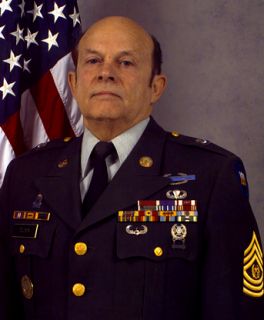
Claud Dunn
Known as a “Soldier’s Soldier”, CSM Claud Dunn began his military career at New Mexico Military Institute, Roswell, New Mexico. After graduation in 1964, he joined the U.S. Army. While on active duty, he served with many airborne units to include the 1/509th Abn/Mech in 1964-1967 and the famous 82d Airborne Division in peace and in war. After returning from Viet Nam he was assigned to Ft. Lewis Washington as a Drill Sergeant where he trained soldiers for the Viet Nam War. He then returned to the 82d Airborne Division for another tour of duty. His last Active Duty assignment was Audie Murphy’s old unit, the Third Infantry Division in Germany.
CSM Dunn served with distinction in Viet Nam with the 82d Airborne Division. He served as squad leader and platoon sergeant. He was wounded and sent back to the rear to rest and recover. Six weeks later he returned to the field and resumed his duties as Platoon Sergeant.
In 1974 CSM Dunn left Active Duty and joined the 100th Division. During his 25 years with the 100th Division he served in many positions with distinction. His first assignment was Senior Sergeant of the first Infantry Team. Later assignments included Operations Sergeant of the Military Intelligence Team and First Sergeant of the MTC. Promoted to CSM, Dunn took over the senior enlisted spot in the 4th Armor Bn 3d Bde and later became CSM of the 1/399. His last assignment in the 100th Division was CSM of the newly formed 8th Brigade (ROTC) of the 100th Division.
During his career, he was destined for noteworthy achievements. During Operation Desert Shield/Desert Storm, MG Dick Chegar, Commanding General of the 100th Division hand picked CSM Dunn as the first enlisted soldier from the Division to report to Ft. Knox and prepare for the arrival of Reserve Component Soldiers being recalled to active duty for the war. Dunn remained on active duty for seven months during which time he was responsible for 40 barracks, overseeing the in-processing, equipping, training and out-processing of soldiers.
In 1994 CSM Dunn was again selected as CSM of Operation Surge at Fort Knox. On active duty for six months, Dunn was responsible for overseeing initial entry training of soldiers by mobilized 100th Division Drill Sergeants as well as maintaining equipment and barracks and shipment of personnel out of Ft. Knox at the completion of training.
CSM Dunn retired in 2001 with 35 years of combined Active and Reserve service. In civilian life, CSM Dunn worked for the United States Postal Service and retired with 27 years as a Postal Mail Carrier. He currently resides in Louisville, Kentucky with his wife Martha.
Awards and Decorations Include:
Legion of Merit
Purple Heart
Meritorious Service Medal w/2 Oak Leaf Clusters
Army Commendation Medal w/”V” device for Valor and 4 Oak Leaf Clusters
Army Achievement Medal w/ Oak Leaf Cluster
Good Conduct Medal
Army Reserve Components Achievement Medal w/5 Oak Leaf Clusters
National Defense Medal 2nd Award
Viet Nam Service Medal w/4 Stars
Armed Forces Reserve Medal w/Silver Hour Glass and “M” Device
NCO Professional Development Ribbon w/Numeral 4
Army Service Ribbon
Overseas Service Ribbon
Combat Infantry Badge
Parachute Badge
Air Assault Badge
Drill Sergeant Identification Badge
2007 – Inducted into the Corridor of the Century
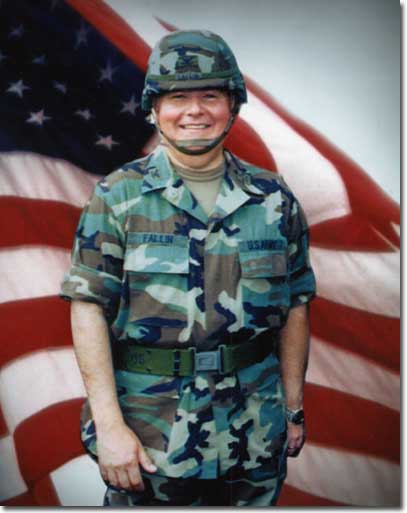
James H. Fallin
Colonel (Ret) James H. Fallin was unanimously selected as the Association of the Century’s 2008 inductee into the Corridor of the Century. Colonel Fallin enlisted in the Army Reserve in 1967 and in 1968, received a direct commission as a second lieutenant.
Colonel Fallin’s 32 years of military service included various command and staff positions within the 100 th Division’s 1 st Battalion, 398 th Regt. and the 3d Battalion, 398 th Regt. Following command of the 3d Battalion Fallin became the Executive Officer of the 2d Brigade Headquarters in Owensboro . Later assignments at the 100 th Division Headquarters in Louisville , Ky included Assistant Chief of Staff G-2 and Deputy Chief of Staff for Operations G-3.
During his years of service in the 100 th Division, Colonel Fallin continually provided exceptional leadership and guidance to the soldiers under his command or direction. He was instrumental in incorporating the Total Army School System (TASS) across the 100 th Division.
Fallin is currently the Executive Director of the Hancock County Industrial Foundation. Previously, he served three terms as the County Judge of Hancock County . Colonel Fallin and his wife, Sharon, reside in Lewisport , Ky. And have three grown children, Angela, Matthew and Bo. He becomes the 72d inductee into the AOC Corridor of the Century.
2008—Inducted into Corridor of the Century.
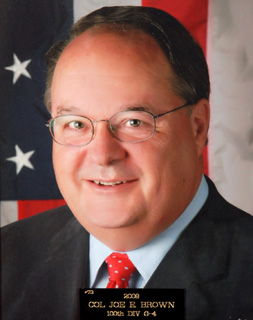
Joe E. Brown
Colonel Joe E. Brown was commissioned a second lieutenant, Adjutant General Corps through the ROTC program at Eastern Kentucky University in May 1968. He then entered active duty to attend the Adjutant General Officer Basic Course at Fort Benjamin Harrison, Indiana. Upon completion of that training he was assigned as Commanding Officer of the 27th Army Postal Unit in Bamberg-Schweinfurt, Germany. The 27th APU provided mail and postal services to 36,000 soldiers and their dependents. LT. Brown commanded this unit for eighteen months which completed his active duty tour.
Colonel Brown’s 24 years of military service included 22 years in the 100th Division in various command and staff positions. His first tour in the 100th began in October of 1970 when he was assigned as a Training Officer in B Company 1/397/1, Berea, Kentucky. Brown later Commander E Company 1/397/1, Richmond and was Battalion Supply Officer, 1/397/1, Richmond. Moving to the First Brigade in Lexington, Brown served as the Brigade Assistant S-4/Property Book Officer and later became the First Brigade S-4. Moving back to Richmond, Brown assumed the position of Squadron Operations Officer, 1/397/1, Richmond and Squadron Executive Officer, 1/397/3 in Richmond before taking Command of 2d Battalion, 400th Regiment, 1st Brigade in Lexington on 1 Oct 1986 where he remained until 12 Sept 1989. Following Command of 2/400 Brown was assigned as Brigade Executive Officer, 4th Leadership Brigade, Ft Knox until becoming the Assistant Chief of Staff Logistics/G4, Division Headquarters, Louisville, Kentucky on July 1, 1990 where he remained until his retirement in October of 1992.
Brown is a graduate of the Adjutant General Basic and Advanced Officers Courses, Phase II of the Armor Officers Advanced Course, The NBC Defense Course, and The Command and General Staff College.
While serving in the 100th Division, one of Colonel Brown’s most rewarding assignments was as the Commander of the 2nd Battalion, 400th Regiment, 1st Brigade. During this time the battalion made tremendous improvements in many key areas. The Battalion strength was steadily increased to over 116 percent, which was second highest in the Division at that time. MOS qualification stood at over 92 percent with an unprecedented 86 percent Duty MOS Qualified. His leadership style was characterized as smooth, yet demanding. His innate ability to make subordinates want to go the “extra mile” contributed to the strength of this unit. LTC Brown continually promoted the Drill Sergeant program, achieving a 84 percent qualification rate. Pass rate for the SQT/CTT was 96 percent testifying to Brown’s dedication to a solid, in-depth training program for his soldiers. The Battalion completed a unit displacement Annual Training mission in which all 2-R areas were rated “Trained”. The rapport between his unit and his AC counterpart was extremely noteworthy.
During Colonel Brown’s last assignment in the 100th Division as Assistant Chief of Staff Logistics/G4 he was recognized as having provided outstanding support and performance during Operation Desert Storm. He provided equipment and logistical support for the mobilized elements of the Division. Readiness and maintenance were significantly improved and he was singled out by higher headquarters for his outstanding support in assembling equipment from various locations for the Reserve Training Concept.
Colonel Brown retired from the 100th Division in October of 1992 with 24 years of Army service. He is a life member of the Association of The Century, the Reserve Officers Association, and the Military Officers Association of America. He is recently retired from First Southern National Bank. Brown has been elected to the Garrard County Board of Education for six terms and is serving in his 23rd year, the last 12 years as chairman of that board. He is also a Founding Director of Friends of Paint Lick, Inc and serves as treasurer of that organization. Colonel Brown and his wife Connie reside in Paint Lick, Ky. They have two children, Stephanie and Kevin, and three grandchildren.
Decorations and Awards Include:
Meritorious Service Medal w/ Oak Leaf Cluster
Army Commendation Medal w/2 Oak Leaf Clusters
USAR Achievement medal
National Defense Service Medal w/ Service Star
Armed Forces Reserve Medal w/ Hourglass Device
Army Service Ribbon
Army Overseas Service Ribbon
2009 – Inducted into the Corridor of the Century
Inductee # 73
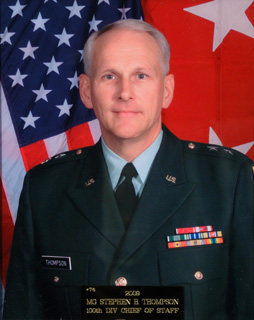
Stephen B. Thompson
Major General Stephen B. Thompson distinguished himself during his career through exceptionally meritorious service in various positions of increasing responsibility, culminating as the Deputy Commanding General, Army Reserve, United States Army Training and Doctrine Command, Fort Monroe, VA. The vast majority of his career was spent in the 100th Division (Institutional Training) and his impact on the Division was significant and lasting.
MG Thompson was commissioned a 2d Lieutenant in the Military Police Corps through the ROTC program at Washington & Lee University in Lexington, Virginia in June 1972. Immediately following his commissioning he served three years on active duty at Ft. Ritchie, MD. His assignments there included Security Platoon Leader, Military Police Duty Officer and then Assistant Operations Officer, Troop Command. It was during these early assignments that 1LT Thompson began developing his ability to build teams and establish strong rapport with subordinates, peers and superiors.
Following his release from active duty, 1LT Thompson returned to his home in Lexington, KY and shortly afterward joined the 100th Division. His first assignment was as Training Officer, Company A, 1st Bn, 397th Regt, 1st Bde in Richmond, KY. Following 16 months in this assignment 1LT Thompson was selected to command Company D, 1st Bn, 397th Regt, 1st Bde in Irvine, KY. During his tenure as Company Commander he led the unit through the reorganization from a BCT Company to a Cavalry Troop. Upon completing his command tenure, CPT Thompson was assigned briefly as the Brigade Assistant S-1, 1st Bde, in Lexington, KY before he was reassigned as the Brigade Assistant S-2/3, 1st Bde. It was in this position that CPT Thompson developed and demonstrated his acumen for planning and operations. After more than four years in this assignment, he was assigned as Battalion S-3, 2nd Bn, 397th Regt, 1st Bde, in Lebanon, KY. It was during this assignment that MAJ Thompson began demonstrating his potential for higher levels of command and staff positions. MAJ Thompson followed this assignment first as the Battalion Executive Officer, 2nd Bn, 399th Regt, 1st Bde in Bowling Green, KY and then as Brigade S-2/3, 1st Bde, Lexington, KY. The last four months of his assignment with the 1st Brigade he served as Acting Brigade Executive Officer. In both assignments he continued to demonstrate his team and rapport building strengths, his focus on mission accomplishment and his care for soldiers.
In November 1990, MAJ Thompson was selected for and assumed command of the 2nd Bn, 398th Regt, 2nd Bde in Madisonville, KY. When he took command, the Battalion was a 19E Armor OSUT Training Battalion. His first job was to successfully transition the Battalion to the 19K MOS (M1 Abrams Main Battle Tank). During his highly successful command tenure LTC Thompson consistently led by example. The Battalion excelled in all missions and the overall performance of the Battalion steadily improved during his three years in command. Rater and Senior Rater comments consistently referred to his
Major General Stephen B. Thompson (Cont)
care for soldiers, his unwavering commitment to mission accomplishment and his unlimited potential for positions of higher responsibility and greater challenge.
Immediately following Battalion Command, LTC Thompson was selected and assigned as the 100th Division G-2. After only two months he was selected as the Division G-4. During his tenure as G-4, the Division underwent another major reorganization and his duty assignment changed to Deputy Chief of Staff for Logistics. Even though the authorized grade for this position was Colonel (O-6), LTC Thompson continued in the assignment for an additional two years. The myriad challenges of the reorganization included the closing of 18 USAR centers and the development and execution of an OCIE cross-leveling plan within the Division, all handled successfully. During his tenure, LTC Thompson, as the DCSLOG, took the lead role in researching, documenting and assuring the designation of the 100th Division Museum as a Department of the Army officially recognized Military Historical Holding. Today, this Historical Holding is one of the Army’s premier showcases of military memorabilia and houses the proud history of the 100th Division.
In 1995, LTC Thompson was selected to attend the U.S. Army War College and graduated in 1997. In May 1996, LTC Thompson was selected for and assumed command of the 7th Brigade, Ft. Knox, KY. He was subsequently promoted to Colonel (O-6) in September 1996. Once again faced with the challenges of unit reorganization, he applied all his skills to ensure success while handling the most complex and diverse missions within the Division. His leadership style and example inspired soldiers to excel. During his tenure, his Brigade won the Recruiting and Retention Award, the Annual Division Color Guard competition, Junior Officer of the Year, Company Grade Officer of the Year, AGR NCO of the year, Junior NCO of the Year and Drill Sergeant of the Year (Army Reserve wide). (SFC Theresa Belles was the first female to be selected as the Army Reserve Drill Sergeant of the Year.) During his assignment, COL Thompson incorporated the APIC process as a means of achieving continuous improvement in all unit areas and he also implemented a computerized resource tracking system that assured the most realistic and highest budget execution rate in the Division.
Following his highly successful Brigade Command, COL Thompson was selected to serve as Division Chief of Staff, his last position with the 100th. During his two year tenure as Chief of Staff, COL Thompson made his most significant impact by embracing and developing an all-encompassing Division Operating System, following the principles of process improvement through the development of vision, mission, goals, accurate measurements and a focus on excellence. As a result of the efforts and successes achieved, the Division competed in the Army and Army Reserve wide “Army Communities of Excellence” (ACOE) competition and was named First Runner Up and “Most Improved Command”. In his second year as Chief of Staff, the Division won the Army’s USAR ACOE award for 2000. The ACOE assessment team noted COL
Major General Stephen B. Thompson (Cont)
Thompson’s direct involvement in the development and implementation of the Division Operating System as the key element in the Division’s ACOE success.
In April 2000, COL Thompson was selected to be the Assistant Division Commander of the 84th Division (IT) in Milwaukee, WI and promotion to Brigadier General. Following a very successful three year tour with the 84th, BG Thompson was selected to be the Deputy Commanding General, Army Reserve, U.S. Army Training and Doctrine Command, Ft. Monroe, VA and promotion to Major General. Serving for five years as the Army Reserve’s senior training advisor to the Commander, TRADOC and the Chief, Army Reserve’s primary liaison to the active Army training community, MG Thompson’s leadership and involvement were instrumental in myriad training initiatives and programs that had and will continue to have a lasting impact on the Army Reserve.
MG Thompson retired from the Army Reserve in June 2008 following 36 years of distinguished service. He resides in Hendersonville, TN, close to his two children and three grandchildren. His remarkable accomplishments and devotion to duty and soldiers are in keeping with the finest traditions and standards of the profession of arms and his service has brought great credit to himself, the 100th Division, the Army Reserve and the United States Army.
Awards and Decorations Include:
Army Distinguished Service Medal
Legion of Merit
Meritorious Service Medal w/ 6 Oak Leaf Clusters
Army Commendation Medal
Army Achievement Medal
Army Reserve Components Achievement Medal w/Silver Oak Leaf
National Defense Service Ribbon w/Bronze Star
Armed Forces Reserve Medal w/Gold Hourglass
Army Service Ribbon
2009 – Inducted into the Corridor of the Century
Inductee # 74
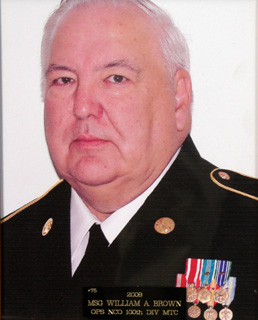
William A. Brown
Master Sergeant William A. Brown was born on 3 April 1943 in Louisville, Kentucky. In 1960, Brown enlisted for three years in the United States Army and completed Basic Training and Armor Crewman Training. While on active duty, MSG Brown received his high school GED in August 1962 and was assigned as an Armor Crewman with HHC, 4th Armored Division in Germany.
Upon release from active duty in 1963, MSG Brown was assigned to the Individual Ready Reserve (IRR) until he joined the 100th Division Maneuver Training Command in September 1976 as an Administrative Specialist on the Combat Division’s Armor Exercise Team. Other assignments on the Armor Exercise Team included OPFOR NCO from Nov 1980 to Nov 1982, Operations NCO from Nov 1982 to Oct 1987; Senior Operations NCO for the Combat Division from Oct 1987 to Oct 1988; and Operations NCO for the Armor Team from Oct 1988 to Oct 1993. At that time, the 100th Division MTC was deactivated and MSG Brown was transferred to the 2d Brigade, 87th Division (Exercise) serving as the NCOIC of the Armor Team until Nov 1994, at which time he transferred to the IRR until his retirement on 3 April 2003. While assigned to the 100th Division, Brown was voluntarily activated for Operation Desert Shield/Storm in early 1991.
MSG Brown’s exceptional professional competence and outstanding organizational ability resulted in receipt of numerous citations and accolades from evaluated units and counterparts. As Operations NCO for the Armor Exercise Team, 100th Division MTC, his standards of appearance, military courtesy and exceptional knowledge of armor tactics helped immensely in preparing his team members to conduct highly successful evaluations of armor units.
MSG Brown’s military schooling included 71L MOS training in 1978, Enlisted Leader Development Education Program in 1985 followed by PLDC, ANCOC, SNCOC and introduction to M1 Abrams Commander’s Course in 1992.
His civilian activities demonstrate his commitment and devotion to his community, church and business associations. He is on the Board of Deacons and sings in the choir at the Brownsville Missionary Baptist Church, a member of Gideon’s International and Vice Chairman of the Republican Party in Edmondson County, Kentucky. Prior to his retirement, MSG Brown owned and operated an independent insurance agency in Louisville, Kentucky. He was a founding member and president of the Kentucky Association of Health Underwriters and a founding member and president of the Greater Louisville Association of Health Underwriters.
MSG Brown’s loyalty and devotion to the 100th Division is evidenced by his membership in the Association of the Century. Brown currently serves on the AOC Board of Directors and is the 2008-2009 President of the AOC. As the AOC Vice President in 2007-2008, Brown was instrumental in planning and executing one of the AOC’s most successful annual meetings in Bowling Green, Ky.
MSG Brown is married to the former Cleota Sanders and they have two children and two grandchildren. They reside in Mammoth Cave, Kentucky.
Decorations and Awards Include:
Meritorious Service Medal
Army Commendation Medal w/ Oak Leaf Cluster
Army Achievement Medal w/ Oak Leaf Cluster
Good Conduct Medal
Army Reserve Component Achievement Medal w/ 3 Oak Leaf Clusters
National Defense Service Medal with Bronze Star Device
Armed Forces Reserve Medal with Hourglass Device
NCO Professional Development Ribbon, Level 3
Army Service Ribbon
Overseas Service Ribbon
Expert Marksmanship Badge, M-16 Rifle
2009 Inducted into the Corridor of the Century
Inductee # 75
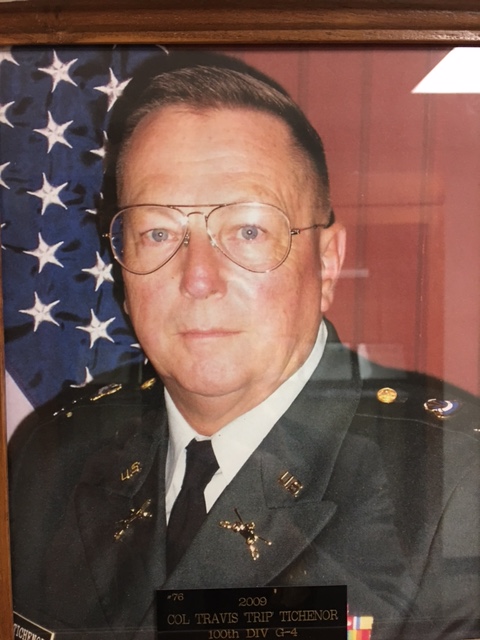
Travis W. Tichenor
Colonel Travis W. “Trip” Tichenor, III was born on February 14, 1949 in Louisville, Kentucky. He is a graduate of Western Kentucky University, with a bachelor’s degree in industrial education in 1973, and received his master’s degree in education in 1978 from Indiana University. His military education includes the Infantry Officer Basic Course, the Infantry Mortar Platoon Leaders Course, Infantry and Armor Officer Advanced Courses, and the Command and General Staff College.
Colonel Tichenor has been both an Army National Guardsman and an Army Reservist with over 30 years of combined service. He was commissioned a Second Lieutenant through the Reserve Officers Training Corps Program on March 7, 1973. His service with the 100th Division spans the years of 1984 to 2003. Colonel Tichenor Transferred to the Inactive/Retired Reserves in April, 2003.
His command assignments have included: Anti-Armor Platoon Leader, Heavy Mortar Platoon Leader, Combat Support Company Commander, Special Training Company Commander, Division Headquarters and Headquarters Company Commandant, and Training Support Battalion Commander. His staff assignments have included Combat Support Company Executive Officer, Battalion Supply Officer, Training Group Test Officer, Division Assistant Intelligence Officer, and Division Logistics Officer.
In civilian life, Colonel Tichenor is an Industrial Technology teacher at South Central High School, Elizabeth, Indiana. He and wife Marty reside in Perry County, Indiana. They have three grown children and four grandchildren. He is a life member of the Association of both the Century and the Reserve Officers Association. He has been an AOC Director since 2006 and is the Editor and Publisher of the Century Sentinel. He is also a Past State President of ROA.
Awards and Decorations Include:
Legion of Merit
Meritorious Service Medal (with one oak leaf cluster)
Army Commendation Medal
Army Achievement Medal (with one oak leaf cluster)
Army Reserve Forces Achievement Medal (with five oak leaf clusters)
National Defense Medal
Armed Forces Reserve Medal (with gold hourglass device)
Army Service Ribbon
Excellence in Competition Badge (Rifle).
2009 – Inducted into the Corridor of the Century
Inductee # 76
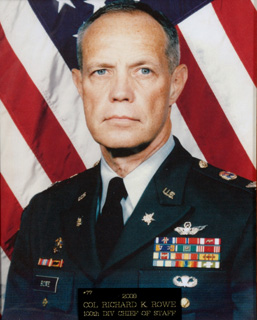
Richard K. Rowe
Colonel Richard ‘Rick’ Rowe’s military career began in February 1966, when he entered military service at Niagara Falls, New York, as an enlisted soldier attending basic training and parachute school with the 3/187th Inf., 101st Airborne Division. In April 1967, he received his commission to 2d Lt. upon completion of the Armor Officer Candidate School, Fort Knox, Kentucky. After a six month assignment as an Armor Platoon Leader, he moved on to begin a career as an Army Aviator completing rotary wing school at Fort Rucker, Alabama subsequently assigned to the 1st Armored Division; followed in October 1968 by an AH-1G “Cobra” transition at Hunter Army Airfield, en route to Vietnam.
Rowe was assigned to A Troop 1/9th Air Cavalry Squadron, 1st Cavalry Division performed duties as a cobra pilot logging 855 combat flight hours in the execution of reconnaissance, scout coverage, combat assaults and direct, and indirect, fire missions; he held leadership positions as Weapons Platoon Section leader and six months as the Weapons Platoon Leader. Upon leaving Vietnam in November 1969 he was assigned to Fort Knox, Kentucky as a student in the Armor Officer’s Advance Course. Upon completion, he was assigned to Fort Benning, Georgia where he held assignments in the Inspector General Office and as a Company Commander in The School Bridge until he left active duty in 1974.
Colonel Rowe joined the 100th Division in 1977 as a rotary wing aviator in the Division Aviation Section, followed by assignments as the Assistant G-2, then three years as the Division Aviation Officer achieving an excellent training and accident free safety record. In 1985, he was selected as the Chief Test Officer, 100th Training Group. In 1987,
Rowe was assigned to the 100th Maneuver Training Command (MTC) as Chief Administrative Division responsible for both the MTC’s personnel functions as well as serving as an exercise team leader. He completed the C&GS non-residence Course in 1988.
In April 1989, Rowe was selected for Battalion Command outside the 100th Division in the 33rd Aviation Group, 121st ARCOM. His mission was to form, activate, equip and train a new, and only the second Army Reserve Cobra Aviation Attack Battalion, the 8th Bn 229th Aviation Regiment at Fort Knox, Kentucky. Over the next four year period, he worked to ensure that the unit trained safely and effectively both on individual as well as unit skills in order that unit was deemed to be individually and tactically proficient. In 1993, the unit was selected to transition to an “Apache” Attack Battalion. Upon completion of command, he served as the DCOPS for the 121 ARCOM. Specific performance was highlighted by the appointment of the DCSOPS as project director for the 8/ 229th Apache conversion to provide staff over site to achieving certification in aerial gunnery and Bn level combat operations. In addition to his duties as DCSOPS, in August 1994 he was appointed Acting Commander 33rd Aviation Group, Fort Rucker, for a six month assignment to restore training and administration of the Command to an effective and safe level. Subsequently, in 1995 the 121st transitioned to become the 81st Regional Support Command and Rowe was selected as the DCSOPS for the RSC. \
In April 1996, after a seven year sabbatical from the 100th Division he was selected by Major General William Barron, CG, 100th Division to return to the Division as its Chief of Staff. Colonel Rowe completed his military career as the 100th Division Chief of Staff in April 1998 serving a total of 14 years with the 100th.
Col Rowe’s Military Decorations and Awards are:
• Legion of Merit
• Distinguished Flying Cross with Two Oak Leaf Clusters
• Bronze Star
• Meritorious Service Medal with Three Oak leaf clusters
• Air Medal with “V” device for Valor
• Air Medal for Meritorious Service with thirty-three Oak Leaf Clusters
• Army Commendation with Oak Leaf Cluster
• Army Good Conduct Medal
• Army Components Achievement Medal with Two Oak leaf Clusters
• National Defense Service Ribbon
• Vietnam Service Medal
• Armed Forces Reserve Medal
• Army Service Ribbon
• Republic of Vietnam Campaign Medal
• Vietnam Cross of Gallantry with Palm
Badges:
• Army Master Aviator Wings
• Army Parachutist Badge
Army Aviation Association of America
• Honorable Order of Saint Michael “Bronze” award
Col Rowe is a life member of the Association of the Century, a past President and a Board member since 1998. He is a member of the Vietnam Helicopter Pilots Association.
He holds a Bachelor of Science in Finance from the University of Louisville. His civilian career began in 1974 at First National Bank of Louisville, and he is currently a Senior Vice President in Wealth Management Group at National City Bank now a part of PNC in Louisville, Kentucky. He and his wife of 38 years, Kay, reside in Prospect, Kentucky, and have two grown children, Jacqueline and Kenneth. They also have two grandchildren.
2009 – Inducted into the Corridor of the Century
Inductee # 77
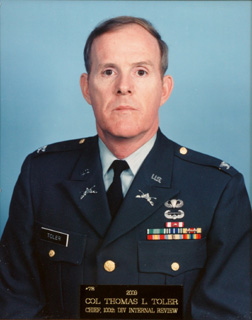
Thomas L. Toler
COL Thomas L. Toler, an ROTC Distinguish Military Graduate at Murray State University, was commissioned a second lieutenant, Air Defense Artillery in January 1965.
Upon successful completion of tours in USAREUR (Germany) and Fort Campbell, KY, he was assigned to the 2D Brigade Headquarters, 100 Division, Owensboro, KY as Headquarters Detachment Commander in January 1968.
In November 1974, COL Toler was assigned to the 100th Division Maneuver Training Command (MTC), Louisville, KY for approximately 3 ¾ years. He held positions in both the Instructor Group and Combat Arms teams.
COL Toler was reassigned to the 2D Brigade, 100th Division, Owensboro, KY in September 1978 and served in various staff positions at both the Battalion and Brigade level. COL Toler’s command assignments include Headquarters Detachment Commander, 2D Brigade; Commander, B Co, 1st Bn 398th Regt, 2D Brigade; Commander 1st Battalion, 398 Regt, 2D Brigade; and Deputy Commander, 2D Brigade.
COL Toler’s final assignment with the 100th Division Headquarters was Chief of Internal Review from August 1989 to February 1991 when he transferred to the USAR Control Group.
COL Toler retired in Jan 1996 with 31 years of Army service (25 yrs-100th Division; 6 yrs-Active/Other reserve units). His service reflects professional competence, high standards, and mission accomplishment.
As Commander of the 1st Bn, 398th Regt, 2D Brigade, the battalion received commendable ratings in the area of training during Command Readiness Inspections. Additionally, the 1st Bn was the first unit in the 100th Division to perform a (OSUT) Unit Displacement mission. COL Toler assumed command of the 4th Training Battalion, 1st Training Brigade, Fort Knox, KY. Gate test results were among the highest ever achieved within the 4th Bn and among the highest ever achieved by a Reserve Component Unit,
As Chief of Internal Review, COL Toler effectively reorganized the operation of the Internal Review Section and redeveloped the Auditable Entry File. He provided (a) supervision of the 1990 Command Inspection Program audit, which was labeled as a command concern; and (2) emphasis necessary to tie it in with the priorities of the Division Management System, to all Division units. The strength and effectiveness of the IR Program was recognized with a Memorandum of Commendation by the Second Army Commander.
COL Toler, who is retired, currently resides in Hanson, Kentucky. He does volunteer work for the American Red Cross, the Disabled Veterans of America, and the KY Prison System. He makes handcrafted waterfowl decoys and is a lagenaria agriculturalist.
Awards and Decorations include the following:
Meritorious Service Medal (1OLC)
Army Commendation Medal
Army Achievement Medal
Parachutist Badge
Air Assault Badge
Basic Missleman Badge
2009 – Inducted into the Corridor of the Century
Inductee # 78
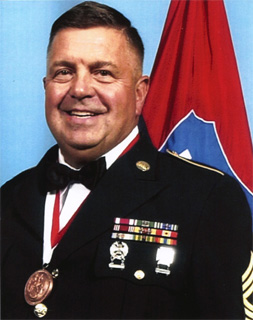
Richard C. Talbott
MSG Richard Talbott was born in Louisville, Kentucky in 1946. At the age of 21, Talbot was drafted into the Army in September 1967 during the Vietnam Conflict. Following the normal two year required enlistment, Talbott left active duty. In 1980, he returned to military service with the 100th Training Division, headquartered in Louisville. In 1990, Talbott was assigned to duty with the 100th Division at Ft. Knox where his unit was mobilized in support of Operation Desert Storm/Desert Shield. Talbot was promoted to First Sergeant in January of 1991. Over the years, Talbott’s leadership positions include Platoon Sergeant, Operations NCOIC, Senior Weapons Instructor and NCOIC of the Army ROTC Basic Camp at Fort Knox.
Over his many years of service with the 100th Division, Talbott was a participant on six winning color guard teams and once received the “Centuryman of the Year” award from the 100th Division. His duty stations have included Ft. Knox, Ft. McClellan, Ft. Bragg, Ft. Lewis and Ft. Campbell.
Talbott’s military schooling included Basic Combat Training; Advanced Infantry Training, Basis and Advanced Noncomissioned Officer Training; Advanced Leadership Course and the First Sergeant Course.
After a 31 year career characterized by devotion to duty, personal initiative, sustained superior performance and attention to detail, MSG Rick Talbott retired at the age of 60 in September of 2006. Talbott served 26 of those 31 years in the 100th Division.
Still serving today, MSG ® Talbott continues to work with soldiers at Ft Knox in a civilian capacity. He has been a member of the AOC Board of Directors since 2003 to include a tour as President in 2006-2007. Talbott’s vision helped to start the Association’s highly successful Support our Soldiers (SOS) Program. Talbott continues to donate many hours of his personal time to insure that deployed 100th Division Soldiers receive a “Care Package” from the folks at home. Talbott is a 32d Degree Master Mason and attends Little Flock Baptist Church. He currently resides in Shepherdsville, KY with his wife Lo Ann who is also a great supporter of the Association over many years.
Decorations and Awards Include:
Meritorious Service Medal w/Oak Leaf Cluster
Army Commendation Medal w/ 3 Oak Leaf Clusters
Army Achievement Medal
Army Reserve Component Medal
National Defense Service Medal w/Bronze Star Device
Armed Forces Reserve Medal w/ “M” Device
2010—Inducted into Corridor of the Century.
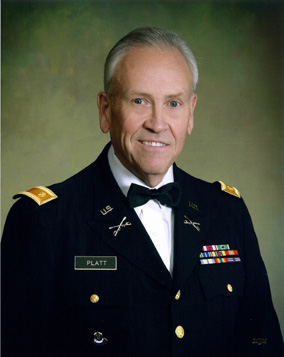
A. Carl Platt II
Major A. Carl Platt II enlisted in the Army Reserve on 16 January 1962 by joining the 210th Overseas Radio Station located at the Nichols Support Facility, Louisville, Kentucky when he served for the next 7 years. After a break in service, Platt reenlisted in January 1976 as a Specialist 5th Class in HQ& HQ Company, 100th Division Training, Louisville, Kentucky as a Legal Assistant in the JAG Section. On 13 December 1977, Platt was commissioned as a First Lieutenant in the Transportation Corps and assigned to the HQ Detachment of the 100th Division Support Battalion in Louisville where he served as Detachment Commander from 1978 to 1980. In 1980, Major Platt transferred to the 100th Division Maneuver Training Command (MTC) and also branch transferred to Armor. During his tour with the MTC from 1980 to 1988 Platt served as Evaluator/Controller, MTC Transportation Team 2, Logistics Officer and as the NBC Officer. In 1989 Platt transferred to the Headquarters of the 3d Brigade (AR Cav), 100th Division Training in Lexington, Kentucky where he served as the Brigade Adjutant, S-1 in the 3d Bde HQs Detachment until his retirement on 22 May 1992.
Major Platt is a life member of the Association of the Century and currently serves on the Board of Directors of the AOC. Major Platt has served as the General Counsel to the Board since March of 2002. The decision by the AOC in 2008 to seek a professional fund manager for the MG Benjamin J. Butler Scholarship Fund was based on the vision and guidance provided by Major Platt.
In civilian life Major Platt is a Practicing Attorney, admitted to the Bar in both Kentucky and Indiana. Carl and wife Nancy reside in Floyds Knobs, Indiana.
Decorations and Awards Include:
Meritorious Service Medal w/ Oak Leaf Cluster
Army Commendation Medal w/ Two Oak Leaf Clusters
Army Component Achievement Medal w/ Two Oak Leaf Clusters
Army Service Ribbon
Army Achievement Medal
National Defense Service Medal
ECB-P
Overseas Duty Training Ribbon
Pistol 45 Cal Expert Marksman Badge
2010 – Inducted into the Corridor of the Century
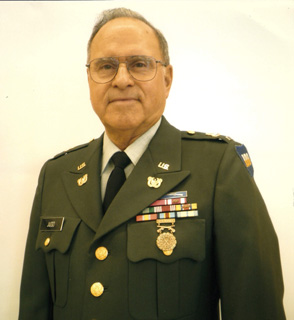
Hobart H. Judd
After serving two years on Active Duty as a Sergeant E-5 Infantry Fire Team Leader assigned to the 2nd Armor Brigade, 3d Armor Division in Germany where he earning the Expert Infantry Badge, CW4 Hobert Judd joined the 100th Division in April of 1960 as a Sergeant E-5, Senior Movement Specialist, assigned to the Division’s HHC in Louisville, Kentucky. Judd remained in this position during the 100th Division’s mobilization to Ft. Chaffee, Arkansas in 1961 during the Berlin Crisis. During the period of 4 January 1963 through 30 November 1965
Judd was reassigned to Headquarters and Headquarters Company of the 399th Regiment, 100th Division with a duty MOS of Intelligence Sergeant. Later Judd was assigned to the Intel SGM position in the HHC. During the summer of 1964, Judd was reassigned at the A Company First Sergeant, 1st Battalion, 100th Regiment (CST), 100th Division (Tng).
On 1 December 1965 Judd received a Direct Appointment to Warrant Officer One (WO1) with a primary MOS of Personnel Technician. Warrant Officer Judd remained assigned to the HHC, 100th Regiment (CST) until January 1968 when he became Detachment Commander of HHD, 4th Bde (CST). Judd also served as an Instructor Supervisor in the 4th Bde before being reassigned to the HHC, 100th Committee Group on 2 Feb 1970. While assigned to the Committee Group, Chief Judd held positions as Assistant S-1, Assistant S-2/3 and Personnel
Technician. From 14 May 1984 to 27 December 1995, Chief Judd was assigned to the HHC, 100th Division as Personnel Technician, Branch Chief, S-1 Section until his retirement after proudly serving as a soldier for 34 years and five months in the 100th Division. Judd also served as a Civilian Technician with the 100th
Division from 1964 thru mid 1981.
While assigned to the HHC, 100th Division, Chief Judd was responsible for the control and timely submission of both Officer and NCO Evaluation Reports within the 100th Division. Due to Judd’ leadership and abilities as a trainer, the 100th Division often received special recognition as the best Divisional unit for submitting OER and NCOERS on time and with the lowest error rate. During Judd’s simultaneous assignment as the Asst S2/S3 with the 100th Division Committee Group and his civilian position as Staff Training Assistant he was responsible for daily coordination for REP Train 76 at Fort Polk, LA. Judd’s leadership and professionalism again resulted in high ratings and praise from the Division’s evaluators and counter parts. Chief Judd’s expertise with military
firearms training significantly benefited the 100th Division Committee Group as they supported BRM and Pistol Ranges and provided general subject training for both Army Reserve and Army National Guard Units conducting training at Ft Knox.
In civilian life, Mr. Judd lives with wife Edith in Taylorsville, Kentucky where he is active in both his community and his church.
Decorations and Awards Include:
Legion of Merit
Meritorious Service Medal w/ 2 Oak Leaf Clusters
Army Commendation Medal
Army Reserve Component Achievement Medal
National Defense Service Medal
Armed Forces Reserve Medal
Good Conduct Medal
Expert Infantry Badge
Excellence in Competition Badge (.45 Cal Pistol)
2010 – Inducted into the Corridor of the Century
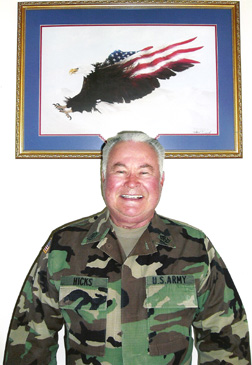
Robert O. Hicks
Sergeant Major Robert O. Hicks was born on 23 October 1946 in Jacksonville, Florida. In 1966, he enlisted for 4 years in the United States Air Force and served one year in Utapao, Thailand during the Vietnam War and 3 years at Patrick Air Force Base in Coca Beach, Florida. While stationed at Patrick Air Force Base he was involved in supporting Apollo 8, 10, 11 and 12 lunar missions.
SGM Hicks was released from Active Duty in 1970 and he joined the 3358th US Army Reserve Reception Station as a Finance Specialist in 1975. He served one year and was honorably discharged in 1976. In 1983 SGM Hicks reenlisted in the 100th USAR Reception Station and served until December 1984 as a personnel records specialist (73D20) and a Finance Specialist (73C20). In January of 1985, SGM Hicks was promoted to Staff Sergeant and served as an Admin Specialist (71L30) in HHC,100th Division. In September 1988, Hicks was promoted to Sergeant First Class and was assigned as a Operations NCO in the 100th Maneuver Training Command. During March of 1989, SGM Hicks transferred to HHC, 2d Bn, 4th Bde,100th Division, Ft. Knox, Kentucky as a PAC Supervisor (75Z40). During this time, Hicks attended a 19K Re-class Phase II Course taught by the 2/399, 1st Bde, 100th Division and was selected the best student from 140 classmates. Hicks was awarded the Army Commendation Medal for his selection as top student.
SGM Hicks then transferred to Co B, 2d Bn, 4th Bde, 100th Division as a Senior Instructor (19K4H). The following July, Hicks was promoted to E-8 and transferred to HHC 100th Division as First Sergeant. In 1994, SGM Hicks was promoted to E-9 and transferred to HHC 100th Division G8 as the Senior Resource Management NCO. In 2002, SGM Hicks transferred to HHC 100th Division Force Development where he served as the Senior NCO until his retirement in October 2006.
SGM Hicks military schooling includes BNCOC, ANCOC, 19K phase I and phase II Reclass Tng, RC Instructor Course, USAR Pay Course, USAR Budget Manager Course, Planning, Programming, Budget and Execution System (PPBES) Course, Manpower and Force Management Course and the US Army Sergeants Major Course. SGM Hicks held the following MOS’s during his long career; 73C, 75D, 71L and 19K.
During most of SGM Hicks’ Reserve military career he was also a dual-status military unit technician serving as a Unit Administrator for the 100th Division Band, Budget Analysis for the 100th Div G8 and Management Analyst with the 100th Div HHC Force Development. SGM Hicks received the Commanders Award for Civilian Service in October of 1992. SGM Hicks holds a Bachelor of Science Degree with a Finance Major from the University of Louisville. Hicks has served as a member of the AOC Board of Directors since 2007 and was President of the organization 2010-2011.
Awards and Decorations Include:
Legion of Merit
Meritorious Service Medal w/Oak Leaf Cluster
Army Commendation Medal w/4 Oak Leaf Clusters
Army Achievement Medal w/3 Oak Leaf Clusters
Army Reserve Component Achievment Medal w/6 Oak Leaf Clusters
National Defense Service Medal with Bronze Star Device
Armed Forces Reserve Medal with Hourglass Device
NCO Professional Development Ribbon, Level 4
Expert Marksmanship Badge (M-16)
2011 – Inducted into the Corridor of the Century
Inductee # 82
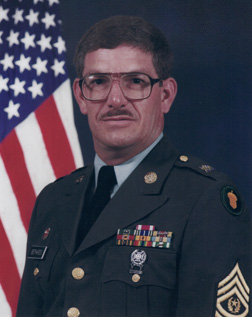
Gregory M. Bethards
CSM Gregory M. Bethards was on December 15, 1951 in Louisville, Kentucky. At the age of 19, he was drafted into the US Army and completed Basic Training and Advanced Individual Training (AIT) at Fort Knox, Kentucky. His determination to best at whatever he did was evident from the start of his career. He was selected to be the 1st Squad Leader in Basic Training and graduated at the top of his class in AIT.
His next assignment was in the Republic of Viet Nam. In a short period of time, he changed MOS’s from a Turret Mechanic to a Small Arms Repairman, quickly recognized as a leader, and was promoted to the NCO of his new section. The mission of SGT Bethards section expanded to include classifying and inspecting all the weapons of the units standing down in Vietnam and processing out of the country as well as their normal mission of weapons repair. Under Bethards direction and leadership, his section received great praise from both his superiors and the numerous units that he assisted. When his unit stood down and began to process out of country he was assigned to over see all of the unit’s out-processing paper work.
Upon the completion of his tour in Vietnam and Active Duty, he was assigned to the USAR Control Group for a short period of time before deciding to join the 100th Division in 1973. His first assignment in the 100th Division was with the 4th Brigade. He was quickly recognized for his professionalism and military bearing and was recruited to be a member of the Color Guard Team in addition to his regular duties as the Unit Armorer and later a Construction Draftsman.
The 4th Brigade, 100th Division was reorganized in 1973 and became the 100th Division Maneuver Training Command (MTC). Bethards advanced through the ranks quickly and held a number of Operations NCO positions before becoming the NCOIC of the Combat Support Division and later the 1SGT of the MTC. He received many awards, letters of commendation and appreciation. Bethards was also recognized for his achievements as a Controller/Evaluator in numerous exercises such as ATT’s, ARTEP’s and Lanes Training Exercises. He held additional duties as a member of the promotion/reduction and awards board and the Sr. NCO Advisory Council. Bethards continued to be a member of the Color Guard for seven years and was the Commander of the 1978 Color Guard of the Century. During his tour with the MTC, he was nominated as the Best Individual Soldier in the Second U.S. Army Competition for 1991.
He volunteered to be the NCOIC of the MTC’s team in the 100th Division’s Boeselager Tank Gunner Competition for 1991. In 1992, Bethards was the MTC’s nominee for the AOC’s Centuryman of the Year award. His energy and desire to be the best at all he attempted was indicated by his ratings received in courses such as ANCOC, FSC and the many Army engineering courses he completed. In 1991, Bethards was selected to attend the SGM Academy non-resident Course. He was a main contributor in the development of the Enlisted Leadership Development Education Program (ELDEP) and also conducted the first all NCO Command Post for the MTC. Bethards continually achieved the standard of the MTC’s Motto, “The Professionals”.
In 1993 the MTC was reorganized as the 2nd Brigade of the 87th Exercise Division which ended 20 years of service for Bethards in the Century Division. CSM Bethards was instrumental in the reorganization and reassignment of personnel during this transition period. He graduated from the Sergeant Major’s Academy at the top of his class and then went on to complete the CSM Course. In 1993, he was promoted and assigned as the Command Sergeant Major of the 2d Bn, 2d Bde, 87th Division. He and wife Wynella were the driving force in the establishment of an outstanding Family Support Group for the 2d Brigade. On his completion of a three year assignment as CSM, Bethards retired in 1997 with 26 years of Army Service.
CSM Bethards has been an active member of the AOC Board of Directors since 2009 and is currently the 2nd Vice President and serves on the annual convention committee. He currently resides with wife Wynella in Louisville, KY and is a major supporter of the AOC Support our Soldiers Program.
Awards and Decorations Include:
Meritorious Service Medal w/Oak Leaf Cluster
Army Commendation Medal w/2 Oak Leaf Clusters
Army Achievement Medal
Army Reserve Component Achievement Medal w/ Silver OLC
National Defense Medal w/2 Bronze Stars
Vietnam Service Medal w/Bronze Star
Armed Forces Reserve Medal w/Silver Hour Glass Device
NCO Professional Development Ribbon w/numeral 4
Army Service Ribbon
Vietnam Campaign Medal w/ 60 device
2011 – Inducted into the Corridor of the Century
Inductee # 83
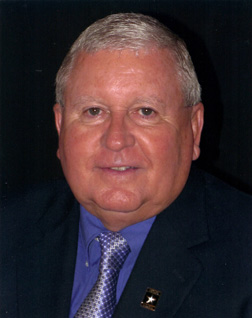
Maurice K. Allgeier, Jr.
Sergeant Major Maurice K. Allgeier, Jr was born on 14 October 1946 in Louisville, Kentucky. He entered Active Duty with the US Army in December of 1965. Following Basic Training, Allgeier attended Signal AIT. His first duty assignment was with the Signal Platoon, HHC, 1/19th Inf Bn,1st Bde, 24 Inf Div in Augsburg, W. Germany. Allgeier participated in numerous NATO exercises in Europe. Over the course of one year Allgeier became the 4.2” Mortar Plt Fire Direction Chief. He was subsequently promoted to Sergeant and was nominated by his Battalion Commander to attend West Point Preparatory School. Having already been accepted to the University of Kentucky for Pre-Med studies he was released from active duty in December of 1967. While assigned to the IRR he volunteered for Annual Training at Ft. Drum N.Y. in 1969 and was honorably discharged from active duty in December of 1971. In March of 1975, after considering returning to Active Duty, Allgeier came to the 100th Division and enlisted for a “Try One” program with the 100th Division Maneuver Training Command.
Assigned initially to the AG Section, Allgeier’s infantry background prompted him to volunteer frequently for duty with the MTC’s Infantry Team. This duty included ATT’s, Map Maneuvers & CAMMS exercises throughout the 5th Army Area. He was also active on the MTC Color Guard Team and in 1978 the MTC Color Guard won the 100th Division’s Color Guard of the Century Competition.
Allgeier performed additional amounts of duty in the MTC AG and S-1 Sections using MDS, ATA and points only. His extensive training in admin, finance and personnel as a Reservist received over a three year period gave him a solid background to become a Unit Technician. In April of 1979 Allgeier transferred to the 100th Division IG Section. He was selected into the Military Technician Program in December of 1979 and was assigned to HHC, 100th Division.
In November of 1984 he was reassigned to ARPERCEN as a Signal Branch Career Advisor. In this capacity, SGM Allgeier managed over 3,000 enlisted IRR soldiers in Career Management Field 31. He also participated in the first CONUS wide IRR Muster Exercise. In April 1987 Allgeier requested reclassification training in the Chemical Corps. He attended resident BNCOC-R at Ft. McClellan, Alabama. Upon graduation from BNCOC, he was assigned as the AGR Operations NCO for the 224th Chemical Company, 212 S&S Bn. Between the fall of 1987 and 1990 the 224th Chemical Company was recognized as the best Company sized unit with the 123d ARCOM. SGM Allgeier was selected as the AGR NCO of the Year by the 123d ARCOM, the American Legion HQs and the Indianapolis Star.
In September 1990 Allgeier was promoted to MSG and transferred to the 5th Medical Group in Birmingham, Alabama where he trained and prepared subordinate medical units for deployment to Operation Desert Storm/Desert Shield.
Allgeier graduated from the Resident Course of the Army Sergeants Major Academy in February 1993 as member of Class #040. He was re-assigned to the Headquarters, 123d ARCOM G-3 Section as the AGR NBC Senior NCO.
Allgeier was singled out during this time period as being responsible for the successful individual training and small arms qualification training for 123 ARCOM HQs personnel. Promoted to SGM, Allgeier was reassigned to the 460th Chemical Brigade in N. Little Rock, Arkansas. During this time Allgeier was selected to be part of the USAR NBC team to validate a select group of Eastern Block countries for compatibility and possible transition to NATO. SGM Allgeier was the NCOIC of this team. It is said that Allgeier was the first US NCO to visit Romania since the end of WWII.
SGM Allgeier civilian education includes an Associates Degree in Arts from Columbia College (1993) and Continuing Studies, University of Louisville
SGM Maurice Allgeier, Jr. retired from the US Army on Sept 30,1997. He is an active member of the Association of the Century Board of Directors since 2007 and is a key player in the Associations Convention Committee.
Awards and Decorations Include:
Meritorious Service Medal w/4 Oak Leaf Clusters
Army Commendation Medal w/6 Oak Leaf Clusters
Army Achievement Medal w/Oak Leaf Cluster
Good Conduct Medal w/6th Award
National Defense Service Medal with Bronze Star Device
Army Reserve Component Achievement Medal,
Armed Forces Reserve Medal w/Hourglass Device
Army Service Ribbon
Overseas Service Ribbon
Army Reserve Components Overseas Training Ribbon
NCO Professional Development Ribbon w/Numeral 4
Expert Infantryman Badge
2011 – Inducted into the Corridor of the Century
Inductee # 84
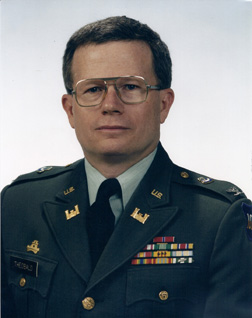
Joseph L. Theobald
COL Joseph L.Theobald enlisted in the U.S. Army on September 8, 1966 after earning a BA in accounting from Thomas Moore College in Northern Kentucky. He graduated from the Army Engineer Officer Candidate School, Ft Belvoir, VA and was commissioned a 2d LT in the Corps of Engineers Branch. His early assignments included duty as Adjutant of the 16th Armor Group and Platoon Leader of the 522d Engineer Company at Ft. Knox, Kentucky from 1967 thru 1968. Theobald next assignment to him to the Republic of Viet Nam as an Army Advisor in budget and finance of construction engineering with the Military Assistance Command (MAC J4) in Saigon, Vietnam from June 1968 to June 1969. Returning to the US, 1st Lt Theobald completed the Army Engineer Office Advanced Course in 1970 and was assigned as an instructor in the Army Engineering School from 1969 through 1970.
After completing his active duty tour, CPT Theobald became the Executive Officer and later Company Commander of HHC, 478th Eng Bn, USAR, Ft. Thomas, Kentucky in 1970 to 1972. In 1972, Theobald received his MBA from Xavier University. Major Theobald transferred to the 100th Division Army Reserve in 1972 as an Evaluator/Controller, Engineering Team of the 100th Maneuver Training Command (MTC) and as a LTC became Chief of the MTC Engineer Team. Transferring to the 100th Division Headquarters, LTC Theobald was assigned as the Deputy Chief of Staff Comptroller 1982 thru 1984. Upon completion of the Command and General Staff College Theobald was promoted to the rank of Colonel in January of 1984 and assigned as the Deputy Chief of Staff Logistics thru 1985. Colonel Theobald was appointed Commander, 100th Division Maneuver Training Command in 1986 before transferring to the USAR Individual Ready Reserve where he performed numerous senior level Officer tours of duty from 1987 through 1994 when he transferred to the Retired Reserve in 1994.
As Deputy Chief of Staff Comptroller, Colonel Theobald created the resources required by the 100th Division to successfully conduct the new training concept of One Station Unit Training (OSUT) at Fort Knox, Kentucky. Colonel Theobald was a life member of the Association of the Century and served on the Board of Directors of the AOC from 2007 until his death in 2011. Theobald was President of the AOC in 2007 – 2008. Theobald’s leadership and organizational abilities expanded the AOC’s Scholarship programs, the 100th Division Museum and the Support Our Soldiers program.
In civilian life, Theobald was Chief, Contracting Division, Louisville Engineer District, U.S. Army Corps of Engineers, responsible for military and civil works procurement for a five state area. During 2003, Theobald volunteered for duty in Iraq and was assigned by the US Army Corps of Engineers to serve as a U.S. Civilian Contracting Advisor in the Iraq Theater of Operations in Bagdad. As a leader in his community and church, Joe Theobald served decades as a Police Commissioner for the community of Clarksville Township in Indiana. He coached elementary school and little league football and baseball leagues. Until the time of his death on May 7, 2011, Joe Theobald resided in Clarksville, IN with his wife Susan. The family includes children, Matt, Adam and Amy, several siblings, grandchildren, nieces and nephews.
Awards and Decorations Include:
Bronze Star Medal
Meritorious Service Medal
Army Commendation Medal
Army Reserve Components Achievement Medal
National Defense Service Medal
Vietnam Service Medal w/3 Oak Leaf Clusters
Armed Forces Reserve Medal
Army Service Ribbon
Vietnam Campaign Ribbon w/60 device
Vietnam Armed Forces Honor Medal, 1st class
Vietnam Fourragerre Color of Merit
Vietnam Engineer Badge
Expert Badge (Rifle)
2011 – Inducted into the Corridor of the Century
Inductee # 85
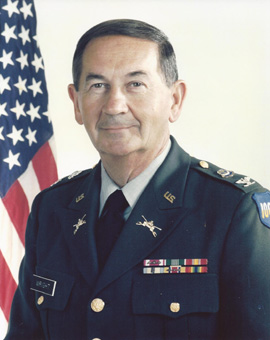
Arvin Leo Wright
COL (Retired) Arvin Leo Wright enlisted in the U.S. Army Reserves in Bowling Green, KY, in 1956 and completed basic training at Ft. Meade, Maryland. Assigned to Co C, 1st Bn, 399th Regt, 100th Div (Tng), and having attained the rank of SSGT (E-6), he was called to active duty at Fort Chaffee, AR in 1961. There he served as Company First Sergeant. While serving at Ft. Chaffee, SSGT Wright was chosen “Soldier of the Quarter” two times and completed the pre-commission course resulting in his being commissioned an Infantry Second Lieutenant in 1962.
Born in Greensburg, KY, COL Wright graduated from Bowling Green College of Commerce with a BS degree in Business Administration and a minor in Accounting. Colonel Wright’s civilian career was spent with General Electric Company, Microdot Corporation, and CRA (Con Zinc, Rio, Tinto) a world class mining company headquartered in Melbourne, Australia with world-wide holdings. His position with all these corporations was in the managerial ranks and was General Manager of Internal Audit for the US, South America and Europe for CRA. He also has served on numerous bank boards and civic organization boards.
COL Wright’s 35 years of military service included many various command and staff positions within the 100th Division. Beginning in 1962, he was a Platoon Leader and Assistant Adjutant for HHC, 399th Regt, 100th Div (Tng). Assigned to 100th Committee Group in 1967, he was an Assistant S-3 and a Company Commander. As Company Commander of the NCO Academy, his unit was responsible for the Drill Sergeant program and was the first to run the program at Fort Knox on drill weekends. Moving the program to Fort Knox resulted in standardized instruction, higher graduation rates, and a more qualified Drill Sergeant.
For the next 4 years, in 1971, COL Wright was assigned as Assistant G-3 for the Division and became the Division Briefing Officer during that time. His next assignment, for almost 3 years beginning in 1975, was as Division G-3 and during that time he oversaw the 100th Division’s successful conversion from Infantry to Armor Branch for all division personnel within a restricted time line of one year. COL Wright then served for 2 years as Commander, 2nd Squadron, 302nd Cav, 3rd Bde, 100th Div (Tng); for 7 months as Assistant S-3, 78th Div (Tng), Fort Dix, NJ; for 2 years as Director, Leadership Academy, 100th Div (Tng); and for 8 months, Chief OPFOR, CSS Division, 100th Div MTC.
COL Wright’s last two assignments with the 100th Division were certainly his most successful. In 1984, under his leadership as Commander, 100th Training Group, his unit conducted during Annual Training a first time refresher course for armor trained NCO’s who were at the time assigned to Control Group. The next year, 1985, Committee Group conducted three courses of instruction, Primary Leadership Development Course
(PLDC), Drill Sergeant School, and Basic Reserve Training Course (BRT) – a first during one Annual Training period for the 100th Division.
During COL Wright’s last three years prior to his retirement in 1989, he was most successful as Commander, 1st Bde (OSUT-AR), 100th Div (Tng). During this command tenure, the 1st Bde won 68% of all Division Awards and placed first in the division when comparing statistics of strength, attrition, and supply administration.
COL Wright is a graduate of the Basic and Advanced Infantry Officer Courses, the Command and General Staff College, the Army War College (RCNIS), and the Senior Officer Logistics Maintenance Course.
In his current civilian life, COL Wright has a very successful small business consulting company specializing in increased productivity and profitability. His business works with the Economic Development Corporation in Owensboro, KY. One patriotic duty he performs regularly is the swearing in of all army recruits for the Owensboro Army Recruiting Office. COL Wright and his wife, Joyce, currently reside in Owensboro. They have two grown children, three grandchildren, and one great-grandchild. He is a life member of both the Reserve Officers Association and the Association of the Century. COL Wright continually encourages current and former members of the 100th Division to join the AOC.
His decorations and awards include the following:
- Legion of Merit
- Meritorious Service Medal with Two Oak Leaf Clusters
- Army Commendation Medal with One Oak Leaf Cluster
- Army Reserve Components Achievement Medal with Two Oak Leaf Clusters
- National Defense Service Medal with 2nd Award
- Armed Forces Reserve Medal with Two Hourglass Devices
- Army Service Ribbon
2012 – Inducted into the Corridor of the Century
Inductee # 86
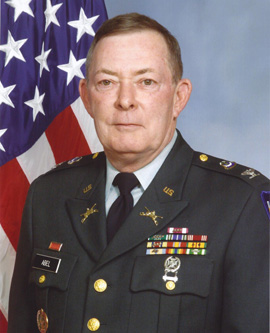
Lawrence D. Abel
Col Lawrence D. Abel enlisted in the United States Army on March 24, 1968 and received his BCT and AIT training at Fort Knox, KY. COL Abel’s next assignment was in the Republic of Vietnam, where he served in an eight inch Artillery unit with B Battery, 1st Battalion 83rd Field Artillery. COL Abel participated in three major campaigns, including the Battle of Hue, the Ashau Valley Campaign and Hamburger Hill Campaign in 1969.
After completing a year in Vietnam, COL Abel returned to the states and attended Drill Sergeant School at Fort Jackson, SC. Upon completion of the school, he was assigned to a BCT unit at Fort Gordon, GA. During this time the BCT Brigade was closed and he was assigned to the Military Police Training Brigade as a Drill Sergeant.
After completing his Active Duty tour, COL Abel joined the United States Army Reserves in Owensboro, KY in 1974 and was assigned to A Company, 1st Battalion, 398th Regiment 100th Division as a Drill Sergeant. COL Abel attended the Kentucky National Guard OCS and graduated in 1976. COL Abel was also awarded the Leadership Award upon graduation.
COL Abel was then assigned as a Training Officer and was instrumental in training the Division to Armor standards as they transitioned from an Infantry Training unit to an Armor Training unit in 1978. COL Abel continued up the ranks as a Company Commander, Battalion S3 and Battalion Executive Officer. COL Abel was assigned to Division Headquarters in October 1994 as the Division Retention Officer. During his tenure in this position the Division was restructured and picked up units in Alabama, Tennessee and Mississippi.
In 1996 COL Abel was reassigned to Owensboro, KY to Command the 1st Battalion, 398th Regiment 100th Division. During his command, the unit was commended at the best unit in the Division, with 145% Strength and 98% DMOSQ. In September 2001, COL Abel was assigned to the Division G3 office to assist in training the force to go to war prior to the Iraq War. COL Abel was instrumental in training and deploying hundreds of the 100th Division soldiers for the Iraq War. COL Abel retired from the Army Reserves in July 2006.
In civilian life, COL Abel was a Kentucky State Police Officer. He was promoted in 1991 as the Public Affairs Officer and was responsible for six counties until his retirement in July 1999. Larry served for years as a softball coach and served on numerous boards for his church and community. Larry resides in Owensboro, KY, with his wife Shelia. They have three children, Kristy Fulkerson, Amy Claycomb and Greg Abel, with four grandchildren.
Awards and Decorations include the following:
Legion of Merit Medal
Meritorious Service Medal w/4 Oak Leaf Clusters
Army Commendation Medal w/5 Oak Leaf Clusters
Army Achievement Medal w/1 Oak Leaf Cluster
Army Reserves Components Medal w/4 Devices
National Defense Service Medal w/1 Bronze Service Star
Vietnam Service Medal w/2 Bronze Service Stars
Armed Forces Reserve Medal w/ Silver Hour Glass
Vietnam Campaign Medal
Good Conduct Medal
Drill Sergeant Badge
Expert Badge (Rifle)
2012 – Inducted into the Corridor of the Century
Inductee # 87
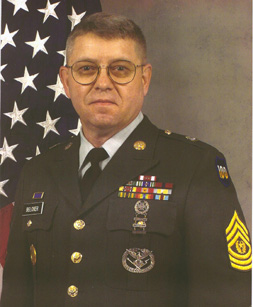
David L. Belcher
CSM David Belcher enlisted in the United States Marine Corps in November 1968 and entered active duty in March 1969 at San Diego, CA. After serving four years, he was separated from active duty in March 1973.
CSM Belcher’s active duty assignments were as an Air Traffic Controller with the 2nd and 4th Marine Air Wings in the United States and with the 1st Marine Air Wing WESTPAC.
CSM Belcher began his service with the United States Army Reserve in 1976 with his enlistment in D Company, 3rd Battalion, 398th Regiment, 2nd Brigade, 100th Division (Training) in Murray, KY.
His many assignments with the 100th Division included: Career Counselor, Training NCO, Drill Sergeant, Senior Drill Sergeant, First Sergeant, Battalion Command Sergeant Major and Brigade Command Sergeant Major.
CSM Belcher left the 100th Division (Training) to serve as the Command Sergeant Major of the 332nd Medical Brigade in Nashville, TN, returning as the Division Command Sergeant Major in the 100th Division (Institutional Training), in September 1999.
CSM Belcher was selected for the assignment as the Command Sergeant Major of the 87th Division (Training Support), Birmingham, AL, in January 2004.
September 2007, CSM Belcher was reassigned to Fort Jackson, SC, as the Command Sergeant Major of the United States Army Reserve Readiness Command where he remained until his retirement. CSM Belcher served the 100the Division for more than 25 years.
Following a five year mobilization with the Army Reserve, CSM Belcher retired on April 4, 2009, after more than 37 years total service and lives in Benton, KY with his wife of more than forty-one years, Ruth. He was employed as the Yard Operations Supervisor at the Tennessee Valley Authority’s Shawnee Power Plant in West Paducah, KY. CSM Belcher retired on September 11, 2009.
Awards and Decorations include the following:
Legion of Merit (2nd award)
Meritorious Service Medal (4th award)
Army Commendation Medal (3rd award)
Army Achievement Medal (2nd award)
Global War on Terrorism Service Medal
Army Good Conduct Medal
Marine Corps Good Conduct Medal
Army Reserve Components Achievement Medal (9th award)
Armed Forces Reserve Medal w/gold hour glass and “M” Device
National Defense Service Medal (3rd award)
Army Service Ribbon
Overseas Service Ribbon
2012 – Inducted into the Corridor of the Century
Inductee # 88

Ned McWhorter
CSM Ned McWhorter was drafted into the United States Army in September 1970. He was assigned to the 43rd Engineers at Fort Benning, GA. CSM McWhorter was separated from active duty in1972.
CSM McWhorter began his service with the United States Army Reserve in 1977 with his enlistment into Delta Company 2nd Battalion, 1st Brigade in Burkesville, KY.
In 1979, he became a Drill Sergeant, which he said was one of his favorite jobs in the Army.
CSM McWhorter was mobilized to Fort Knox, as part of Task Force 100 for Operation Desert Storm in 1991. During the mobilization, he was assigned as headquarters company first sergeant and was responsible for the 88 tanks the unit has to train with.
After the mobilization, McWhorter was as a first sergeant again, this time at B Co, 2nd Battalion, 399th Regiment in Bowling Green, KY.
His military schooling includes Primary Non-Commissioned Officer Course, Basic Non-Commissioned Officer Course and Advanced Non-Commissioned Officer Course. He also attended the First Sergeant’s Course.
In 1985, CSM McWhorter went to the Sergeant’s Major Academy and became the Command Sergeant Major for the 6th Brigade’s 10th Battalion in Lexington. That Unit taught Combined Arms Staff and Service School to officers.
In 1998, he became the Command Sergeant Major for the 100th Division’s Second Brigade in Owensboro, KY. Five years later he became the 100th Division’s Command Sergeant Major.
CSM McWhorter lives in Albany, KY, with his wife, Helen. He has three children, David, Cheryl and Erica. He has four grandchildren, Keri, Taylor, Gavin and McKenna. In civilian life, CSM McWhorter farms and helps his son, David, in the transportation business.
Awards and Decorations include the following:
Legion of Merit
Meritorious Service Medal (2OLC)
Army Commendation Medal (4OLC)
Army Achievement Medal
Army Reserve Component Achievement Medal (4OLC)
National Defense Service Medal (2BRZ Star)
Armed Forces Reserve Medal w/ Silver Hour Glass and “M” Device
2012 – Inducted into the Corridor of the Century
Inductee # 89
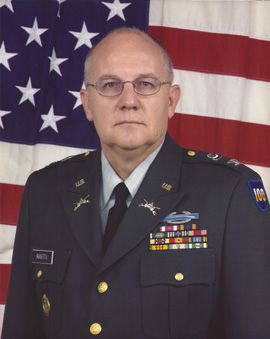
Clarence R. Martin, Jr.
COL Clarence R. Martin, Jr. enlisted as a Private in the US Army in 1969. He served two years on active duty as an Infantryman assigned to the 25th Infantry Division that included a tour of duty to Vietnam in 1970. His next assignment was in Germany as an Infantryman with 2d Battalion, 15th Infantry, 3rd Infantry Division.
Upon successful completion of tours in Vietnam and Germany, COL Martin was released from active duty and, in November 1972, enlisted in the US Army Reserve with initial assignment to Company D, 2nd Battalion, 398th Regiment, 2nd Brigade, 100th Division (TNG) in Providence, Kentucky where he served as a Drill Sergeant and Senior Drill Sergeant for the next 8 years.
In 1981 COL Martin received a Direct Commission to 1LT, Armor. His initial assignment was as Executive Officer/Training Officer for D Company, 2-398th Regiment, 2nd Brigade. While still a 1LT, he was selected to command Company B, 2nd Battalion, 398th Regiment, 2nd Brigade located in Madisonville, Kentucky. COL Martin commanded this company for the next 5 years.
Over the next 23 years COL Martin served in various command and staff positions within the 100th Division. They included assignments as 2nd Brigade Assistant Operations Officer and Project Officer for Operation Steel Eagle; S-3/ Operations Officer for 1st Battalion, 398th Regiment, 2nd Brigade followed by 2nd Brigade S-3; Commander for 3rd Battalion, 399th Regiment in Hopkinsville; Assistant Chief of Staff and Division IET/Branch Chief within the G-3 section at 100th Division headquarters.
COL Martin’s final assignment with the 100th Division(IT) was Brigade Commander, 8th Brigade (SROTC) at Fort Knox, Kentucky from July 2003-October 2004. He was then selected to become the Assistant Division Commander-Support at the 80th Division(IT).
COL Martin retired in Oct 2008 with 40 years of Army service (32 yrs-100th Division; 8 yrs-Active/Other reserve units). His service reflects professional competence, high standards, and mission accomplishment.
While assigned as Senior Drill Sergeant with Company D, 2nd Battalion, 398th Regiment, 2nd Brigade COL Martin maintained the highest standards of training new Privates for the Army. After commissioning, he excelled at improving morale and recruiting/retention greatly improving unit strength, DMOSQ and SQT scores that resulted in the company’s recognition as “Best Company” during Annual
Training at Camp Grayling, Michigan. While Company Commander, unit strength improved and consistently exceeded 100%; MILES equipment was used during Annual Training and COL Martin was selected as Battalion “Outstanding Company Grade Officer” during multiple years.
COL Martin’s excellent performance was recognized and he was assigned as Commandant for the 2nd Army Basic Armor School, Fort Campbell executing 19K reclassification and as Officer-In-Charge of the Leadership Reaction Course for 2nd Region ROTC Cadet Command at Fort Bragg, North Carolina. He and his soldiers received laudatory remarks/outstanding ratings in both of these missions.
While assigned as Assistant Chief of Staff at Division Headquarters, COL Martin was instrumental in rewriting the highly successful Organizational Inspection Program; provided key input to the planning and execution of Commander Conferences and ensured support for IET Brigades in the performance of their missions. He was then assigned as the 100th Division’s IET/ROTC Branch Chief providing oversight for 5 extremely successful BCT missions resulting in more than 1200 soldiers receiving training. Extensive command experience at both company and battalion levels, combined with his staff experience at Division level more than prepared Colonel Martin for command of the 8th Brigade (SROTC). Soldiers under his command taught courses and trained over 1,000 cadets attending the ROTC Leaders Training Course (Fort Knox, KY) and another 500 cadets at the ROTC Leader Development and Assessment Course (Fort Lewis, WA).
COL Martin is a retired Human Resources Manager with the coal industry and resides in Providence, Kentucky. He is a Life Member of the Association of the Century actively attending annual reunions. COL Martin is also lead trustee at the White Oak General Baptist Church and Vice President, Cemetery Committee.
Awards and Decorations include the following:
Legion of Merit Medal
Meritorious Service Medal with 3 Oak Leaf Clusters
Air Medal with Numeral 3
Army Commendation Medal with 3 Oak Leaf Clusters
Army Achievement Medal with 3 Oak Leaf Clusters
Good Conduct Medal with Bronze Conduct Knots
Army Reserve Components Achievement Medal with 4 Oak Leaf Clusters
National Defense Medal with 1 Bronze Service StarArmed Forces Expeditionary Medal
Vietnam Service Medal with 3 Bronze Service Stars
Global War on Terrorism Service Medal
Armed Forces Reserve Medal with Gold Hourglass
Army Service Ribbon
Vietnam Campaign Medal
Vietnam Gallantry Cross
Combat Infantryman Badge
Drill Sergeant Badge
2012 – Inducted into the Corridor of the Century
Inductee # 90
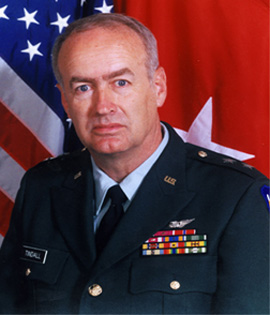
John R. Tindall, Jr.
MG John R. Tindall, Jr., an ROTC Distinguished Military Graduate at the University of Tennessee, was commissioned Second Lieutenant, Armor in March 1967.
Upon successful completion of more than 7 years on Active Duty, that included assignments as an Armor Platoon Leader, Battalion Adjutant, a combat tour as an Aviator in Vietnam, Company Commander and Battalion Executive Officer at Fort Knox, MG Tindall was assigned to 100th Division Maneuver Training Command (MTC) in Louisville, KY. For the next 7 1/2 years he held positions as Administration Officer for the Armor Team and Headquarters Commandant.
From June 1982 until July 1996, MG Tindall served in various key staff positions at both the Brigade and Division level. These include Executive Officer for 2nd Brigade, Assistant G3 for Mobilization, Assistant Chief of Staff, G3 and Chief of Staff at the 100th Division Headquarters. MG Tindall’s command assignments include Commander of 2nd Battalion, 399th Regiment, 1st Brigade; Commander 1st Brigade, 100th Division (TNG). MG Tindall’s final US Army Reserve assignment was Commanding General, 100th Division (IT)
MG Tindall retired in June 2003 with more than 36 years of Army service (over 26 yrs-100th Division; 10 yrs-Active/Other reserve units). His distinguished service reflects professional competence, high standards, and mission accomplishment.
As Commander of 2nd Battalion, 399th Regiment, 1st Brigade, MG Tindall ensured focus and priority in taking care of Soldiers’ pay problems boosting morale, initiating the first-ever Tank Gunnery – Platoon ARTEP training, receiving Excellent ratings on Command Readiness Inspections. This extraordinary achievement resulted in 2/399th recognition as the best battalion in the Division. As Commander of 1st Brigade, MG Tindall spearheaded Division participation with the Reserve Training Concept at Fort Knox receiving accolades for unit excellence from Readiness Group Knox. Under his dynamic leadership, 1st Brigade also won both Boselager and Top Gun Competitions. As Commanding General of the 100th Division , MG Tindall was responsible for the Division winning the US Army Reserve Community of Excellence (ACOE) Award; hosting US Army Reserve Awareness Days for Congressional Staffers and fully supporting the mobilization of Division soldiers for the Global War on Terror in both Operations Enduring Freedom and Iraqi Freedom.
MG Tindall resides in Radcliff, Kentucky where he owns and operates W&T Sales and T&T Rentals. Since his retirement from the military, he continues to be active in the community and with the Association of the Century.
MG Tindall currently serves as Vice-Chairman, AOC Board of Directors and Co-Chairman for the Support Our Soldiers (SOS) Committee and Pickle Packing Campaign. To date, over 1,000 packages and 900 Letters/Cards have been mailed on behalf of the AOC and more than $25,000 dollars raised in support of this effort.
In addition, MG Tindall played a key role in the creation of Kentuckiana/USA Cares and is currently President of the Board of Directors. The mission of USA Cares is to provide financial support to the combat injured, removing financial barriers to employment for Vets, helping to save the homes of military families who have been disproportionately impacted by the housing crisis and meeting their basic needs, such as keeping the lights on, food on the table and a family car in the driveway. USA Cares has assisted 24,000 families and provided 8.4 million dollars in direct support grant money.
Awards and Decorations include the following:
Distinguished Service Medal
Legion of Merit with Oak Leaf Cluster
Bronze Star Medal
Meritorious Service Medal with Silver Oak Leaf Cluster
Air Medal with seven Oak Leaf Clusters
Army Commendation Medal
Reserve Components Achievement Medal with two Oak Leaf Clusters
National Defense Service Medal
Vietnam Service Medal with three Oak Leaf Clusters
Armed Forces Reserve Medal
Army Service Ribbon
Republic of Vietnam Campaign Medal
Army Aviator Badge
2012 – Inducted into the Corridor of the Century
Inductee # 91
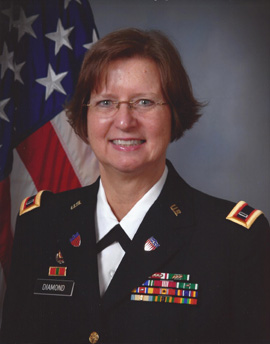
Janie Marie Diamond
CW5 Janie Diamond joined the Army Reserve 5 May 1975 as a member of the 672d General Supply Company in Lexington, Kentucky. In March of 1977 she moved closer to her hometown of Eubank, Kentucky and was assigned to C/2/397/1/100th Division (Tng) in Somerset as first a Unit Clerk then the company Supply Sergeant. Except for a period of time in the 2085th USARF School, CW5 Diamond held various assignments in the 100th Division over the next 28 years including a 4 year AGR tour in the G1 of the 100th from August 1996 to September 2000. She served as a Personnel Staff NCO in 1/400 and Military Personnel Officer in 100th Division Headquarters.
CW5 Diamond began her military technician civil service career in 1/400/1/100 as a GS 5. She was promoted to GS 7 then GS 9 while in the 2085th. After her AGR tour in Division HQ, she was assigned to the G3 as the Schools Officer, GS 11, and then was promoted to Staff Training Officer, GS 12. CW5 Diamond was the first female to hold this position in the 100th Division.
During her tenure in the 100th Division, CW5 Diamond was a direct contributor to the success of many transformations and reorganizations. Her work as a military member in the G1 and civilian in the G3 provided the continuity of staff knowledge that drew from her broad base of skills and expertise. She was the primary initiator and coordinator of the direct appointment process for the 100th Division. Over 30 young NCO’s received direct appointments through her efforts. Many of these officers still return to CW5 Diamond for career advice and mentoring. She reorganized the Official Inspection Program (OIP) for the headquarters staff, creating a viable and effective tool to identify strengths and weak areas in new and existing units. Her ability to develop improvement plans and solve complex issues was instrumental in maintaining the premier status of the 100th Division in the institutional training area.
Military schools attended by CW5 Diamond include; Equipment Storage Specialist, Unit Supply Specialist, Advanced NCO Course, Personnel Senior Sergeant, Unit Administrator Basic Course,
R C Instructor Training Course, First Sergeant Course, USAR Training and Operations Course, Warrant Officer Candidate School, Warrant Officer Basic Course, Personnel Management Course, Warrant Officer Advanced Course, Warrant Officer Staff Course, Unit Mob Planners Course, and Warrant Officer Senior Staff Course. In her civilian life, she earned an Associate of Arts in Retail Merchandising and a Baccalaureate of Science in Liberal Studies/Sociology.
CW5 Diamond is a life member of the Association of the Century, Reserve Officers Association, and the United States Army Warrant Officer Association.
While serving over 37 years of combined Reserve and Active Duty, she amassed many accomplishments. She was selected for the Warrant Officer Program after achieving the rank of Master Sergeant and graduated at the top of her class in academics from Warrant Officer Candidate School. As a member of the 100th Division she was selected as the CW4 Michael Novosel Reserve Officers Association Outstanding Warrant Officer of the Year and served 4 years as the Assistant Vice President Reserve Affairs for the United States Army Warrant Officer Association. For many years she has held the office of Treasurer for the Reserve Officers Association, Department of Kentucky, and previously served as President and Secretary.
CW5 Janie Diamond is currently assigned as the Officer/Warrant Officer Manager for the United States Army Recruiting Command (USAREC). Her branch manages assignments and actions for over 600 RA and 115 AGR officers throughout 6 brigades, 48 battalions and 257 companies across the US to include Alaska, Hawaii, and Puerto Rico.
CW5 Diamond is a trained Dale Carnegie Instructor and Leader Education and Development Trainer. She conducts team building activities for USAREC and various local civilian and military organizations. She has served her community for many years as a Court Appointed Special Advocate for abused and neglected children and is currently a volunteer with Crossway Pregnancy Resource Center in Radcliff. This organization provides support to many unprepared pregnant Soldiers and civilians in the Fort Knox area. CW5 Diamond is facilitating and instructing parenting classes for the center. She is active in her church, Southeast Christian, where she is the Treasurer for her Bible Study Class.
CW5 Diamond has 2 adult children, 6 step adults, and 8 step grandchildren. She lives on the river in West Point, Kentucky.
Awards and Decorations:
Meritorious Service Medal – 5th Award
Army Commendation – 4th Award
Army Achievement Medal – 2d Award
Army Reserve Components Achievement Medal – 6th Award
National Defense Service Medal- 2d Award
Armed Forces Reserve Medal – 3d Award
NCO Professional Development Ribbon (numeral 3)
Army Service Medal
Commander’s Award for Civilian Service – 2d Award
Superior Civilian Service Award
2012 – Inducted into the Corridor of the Century
Inductee # 92
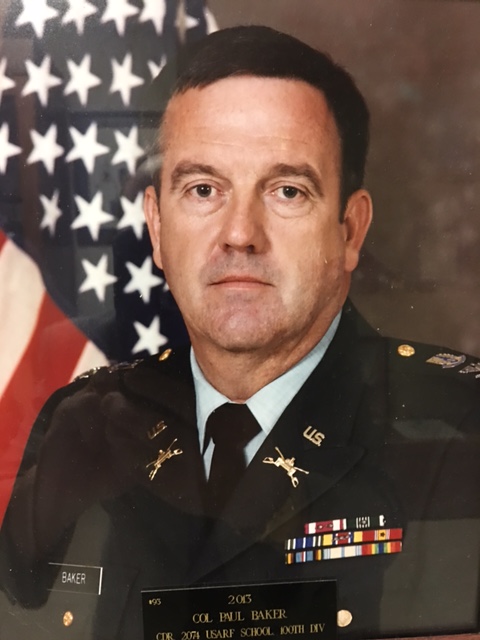
Paul Baker
Colonel Paul Baker entered active duty as a private in June 1968.
After completing Basic Combat Training, Advanced Combat Training, and Infantry officer Candidate School he was commissioned a Second Lieutenant in May 1969. His first assignment was to BCT Committee Group, Fort Dix, New Jersey training newly recruited soldiers in Basic Rifle Marksmanship. In February 1970 he was assigned to Company C, First Battalion, 38th Infantry, 2nd Infantry Division for duty along the demilitarized zone in Korea. For the next 13 months he served as an Infantry Platoon Leader and Executive Officer along the DMZ until March 1971. Upon returning to the United States he was assigned as a Company Commander in the First Training Brigade at Fort Campbell, Kentucky where he completed his active duty obligation. Colonel Baker was discharged in June 1972.
Colonel Baker began his Army Reserve career October 1972 as Company Commander at Company B, 1st Battalion, 397th Regiment, 1st Training Brigade, Berea, Kentucky. Through his enthusiasm, dedication and devotion to superior performance he propelled his unit into a top position within the Battalion. During annual training in 1974 B Company was selected 1 of 2 units to support the 100th Division Leadership Academy at Fort Knox. Colonel Baker’s accumulation of military experience and leadership attributes were reflected in his Company personnel. By the end of his tenure B Company had developed pride to the point that the unit was over strength in personnel but continued to have individual desiring to enlist in the unit.
Colonel Baker held numerous duty positions within the 100th Division over the years.
From May 1976 to January 1977 he was the 1st Battalion 397th Regiment Supply Officer. From January 1977to August 1978 he was the S-1 for the 1st Brigade, 100th Division. Also in August he returned to the 1st Battalion, 397th Regiment as the Battalion S-3. As Battalion S-3 his effective implementation of BTMS and Annual Training program 99% of trainer personnel completed the HOC portion of the SQT. He remained in this position until July 1981. Colonel Baker again was assigned to the 3d Brigade as S-3 and remained there until September 1983 when he was selected to return to 1st Battalion as the Executive Officer where he remained from October 1983 until March 1986. Colonel Baker was selected as the Battalion Commander of the 1st Battalion, 400th Regiment, 3d Brigade, 100thDivision. He approached this position with the same enthusiasm and drive as he had shown in all previous assignments. During his tenure the unit transitioned fro 19E, M60 tank series to the new19K, M-1 tank making the 1st Battalion 400th Regiment 1of 2 19K units within the Reserve components. By the end of his tenure the unit strength was 104%, MOSQ 84, IDT Attendance 95%, 8 Drill Sergeants in School and 6 waiting starting date. In April 1989 Colonel Baker was selected as the 3d Brigade, 100th Division Executive Officer. Colonel Baker performed his role with quiet diligence. He worked well orchestrating staff work developing better communication within the Brigade. His work with promotion selection and awards boards was noteworthy. Colonel Baker held this position until December 1991
After being promoted to Colonel and a break in service from January 1992 to November 1992 Colonel Baker was selected as Acting Commandant for the 2074th USARF School, 125th Army Reserve Command. He held this position until September 1995 when the USARF was reassigned to the 100th Division (IT) in Louisville, Kentucky. Colonel Baker continued as School Commandant until deactivation of the unit in October 1996.
Colonel Baker is a graduate of the Infantry officer Basic Course and the Infantry Officer Advanced Course and the Command and General Staff College.
Colonel Baker retired from the 100th Division in December 1996 with over 28 years of service. He is a life member of the Association of the Century and the Reserve Officers Association. He has been retired from the Madison County Schools in Richmond, Kentucky since 2010 where he had been employed as Teacher, Principal, Director of Pupil Personnel and Assistant Superintendent of Schools spanning 39 years. Colonel Baker and his wife reside in Richmond, Kentucky.
They have one daughter (Paula) and 2 grand children (James) (Madeline) who reside in Philadelphia, Pennsylvania.
Decorations and Awards
Meritorious Service Medal (2OLC)
Army Commendation Medal (2OLC)
Army Achievement Medal
Army Reserve Components Achievement Medal (3OLC)
National Defense Service Medal (3OLC)
Armed Forces Expeditionary Medal
Armed Forces Reserve Medal
Army Service Medal
2013 – Inducted into the Corridor of the Century Inductee # 93
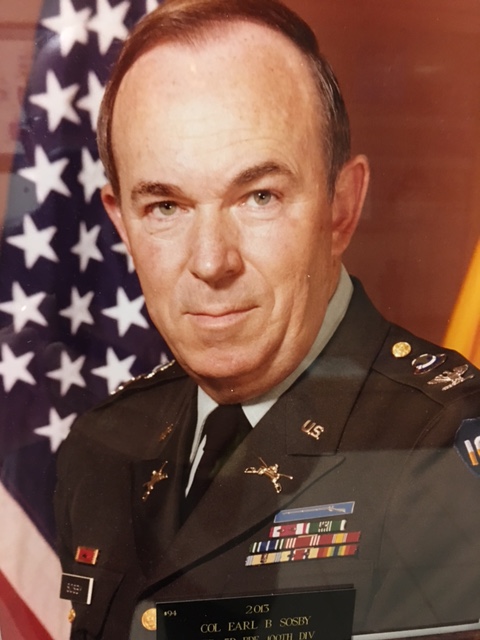
Earl B. Sosby, Jr.
After completing his initial Active Duty tour, COL Sosby joined the United States Army Reserves, 100th Infantry Division (training), in Lexington, KY on November 3, 1955 and was assigned to H/H Company, 397th Infantry Regiment (RCT) 100th Division as a ‘Wireman’ in the Communication Platoon. During his time in this unit, from 3 November 1955 through 16 April 1959, he advanced through several positions including: ‘Intermediate Radio Operator’, ‘Senior Radio Operator’ and ‘Communications Chief’ within that unit’s Communication Platoon.
In April 1959, there was a major reorganization of the 100th Division and COL Sosby was reassigned to Hqs., 100th Division (TNG) and to its ‘new’ Testing Platoon, a unit then a part of the Provisional Battalion of the 100th Division (TNG) and under the direction of the Division’s G-3. COL Sosby became the Armor Platoon Sergeant of that unit and about a year later became its First Sergeant. He served in this position including its mobilization during the Berlin Crisis (Ft. Chaffee, AR) until he was commissioned as a Second Lieutenant (Infantry) on 30 October 1962. During his time in what was now TEST Company, 100th Division (TNG), he served as the ‘Supply Officer’, ‘Executive Officer’ and on 17 December 1963, he became its ‘Commanding Officer’. He continued in this role until 14 April 1966 when he transferred to HHC, 1st Battalion 400th Regiment, 3rd Brigade (AIT), 100th Division (TNG), as its S-3 Operations Officer, S-1 Adjutant, and HQS Commandant.
From 15 April 1966 through 31 December 1974, he served this unit in many capacities as: S-1, S-3, Director of its Training Committee, Battalion Executive Officer, and interim Battalion Commander. He was instrumental in the transition of his unit from Advanced Individual Training (AIT) Infantry to Advanced Individual Training (AIT) Armor. He researched, prepared, and implemented (for the Commander) the ‘execution’ of the Weekend Armor Training for the Army ROTC Students at the University of Kentucky and supervised three different trips to Fort Knox for this mission.
COL Sosby became the S-2/3 Operations Officer of the 3rd Brigade (AIT)(AR), 100th Division (TNG) on 1 January 1975 and served as such until 31 January 1977. As the Chief Planning/Training Officer of the Brigade, he continued to assist the other units as they fine-tuned their respective programs. He was instrumental in ensuring that the latest ‘Armor Doctrine’ was employed in accordance with direction from the 100th Division G-3 and TRADOC.
On 1 February 1977, COL Sosby became the Commanding Officer of the 1st Battalion 400th Regiment, 3rd Brigade (AIT)(AR), 100th Division (TNG) and served in this capacity through 30 November 1978. During his ‘command tenure’ his units continually attained and exceeded all measurement criteria for training, MOS Qualification, AGIs, and STRENGTH. He also led the transition into the ‘One Station Unit Training’ for the 3rd Brigade (OSUT)(AR) as one of the first U.S. Army Reserve units to do so.
On 1 December 1978, COL Sosby was next assigned as the Brigade Executive Officer (XO) of 1st Brigade (OSUT)(AR), 100th Division (TNG). His responsibilities in this assignment was to direct the Brigade staff in planning and implementing the Brigade missions. He served in this position until 1 April 1979 when he was advanced to the position within this unit of Brigade Deputy Commanding Officer (DCO). He served in this position until 30 April 1980. During this time, he was the Chief Planning Officer/Director of the entire Brigade Armor Training Program and charged with the responsibility for its success.
Next, COL Sosby was moved, along with the ‘entire command team’ of BG Merwyn Jackson and COL Gene Simmons, to the position of Brigade Deputy Commanding Officer (DCO) of the 3rd Brigade (OSUT)(AR), 100th Division. In this challenge, he did similar missions as he had done in the 1st Brigade (OSUT)(AR) to turn around this unit’s training program and bring it back to its former status.
On 1 July 1981, COL Sosby was reassigned to the Maneuver Training Command (MTC), 100th Division (TNG) in Louisville. He served as Signal Team Leader within the Combat Support Division and conducted a variety of ‘signal’ exercises with the U.S. Army Reserve and Army National Guard units in Indiana, Kentucky, Michigan, and Ohio. His team continually received the superlatives and highest accolades for their professionalism and conduct of these efforts. Next, he became the ‘Deputy Commanding Officer/Chief of Plans, Operations, and Training (DPOT) Division’ and helped to plan, coordinate and execute the multitude of activities by this unit. COL Sosby left this unit on 30 April 1984 and assumed command of 3rd Brigade (OSUT)(AR), 100th Division (TNG), on 1 May 1984.
This was one of the most rewarding opportunities of a long and successful career. This was a ‘good’ unit at the beginning of his command tenure and through many innovations and leading-edge training techniques; COL Sosby was able to make it even better. He was one of the principals in the ‘start-up’ of the Year Round Training Program with Fort Knox. STRENGTH was brought to its highest allowed levels and maintained as were the many evaluation programs and MOS qualifications. MORALE soared and the ‘esprit de corps’ was outstanding. During one month, fifty-two (52) members of the 3rd Brigade joined the Association of the Century Association. Many more followed. In 1985, COL Sosby and COL Bill Adams (1st Brigade Commander) cohosted the annual convention of the AOC in Lexington. The best of relations between Fort Knox and the 3rd Brigade was reestablished and during this time, COL Sosby was invited/requested by MG Fredrick Brown (Commanding General of Fort Knox) to assume the command of the 1st Armored Training Brigade which allowed COL Bob Phillips (then its commander) to accomplish a ‘special’ project with General Paul Funk for TRADOC and FORSCOM. COL Sosby took the Brigade Colors in a proper ‘change of command’ ceremony and performed the responsibilities for the requested time. This was one of the major ‘highlights’ of his career. Upon his return to the 3rd Brigade, he continued the program that he help start in having one of his Companies/Troops on active duty the year around. After twenty-one months, COL Sosby left this command on 28 February 1986.
COL Sosby retired from the Army Reserves on 22 December 1996.
In civilian life, COL Sosby was a Professional Computer Programmer and Systems Analyst, initially, and later in his career, he became a Manager of the same type of technical, highly trained professionals for the IBM Corporation. By the time that he retired in 1987, he had attained the ‘middle management (third level) position’ in the Information Systems Group which was out of IBM Corporate Headquarters in Armonk, New York. COL Sosby holds a BS Degree in Computer Science with a major in mathematics from Capital University, Columbus, Ohio.
COL Sosby was a CHARTER MEMBER of The Association of the Century
COL Sosby was elected as the President of the Department of Kentucky, Reserve Officers Association of the United States in 1980 – 1981
Awards and Decorations include the following:
Meritorious Service Medal w/4 Oak Leaf Clusters
Army Commendation Medal w/1 Oak Leaf Cluster
Army Achievement Medal w/2 Oak Leaf Clusters
Good Conduct Medal
National Defense Service Medal
Armed Forces Reserve Medal w/Gold Hourglass Device (30 yrs.)
Army Reserves Components Medal w/3 Oak Leaf Clusters
Army Service Ribbon
Expert Infantryman Badge
Expert Badge (Rifle)
Expert Badge (Pistol)
Meritorious Unit Citation w/1 Oak Leaf Cluster
Presidential Unit Citation (temporary while in unit only)
2013 – Inducted into the Corridor of the Century Inductee # 94
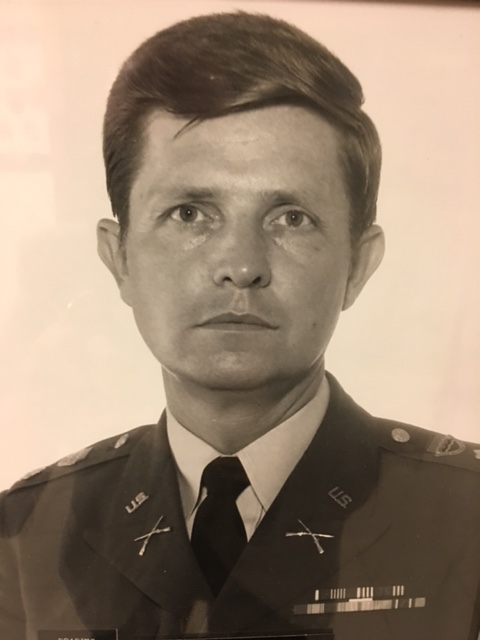
James H. Dearing
Colonel James H. Dearing was inducted to Active Duty, January 1954, near the end of the Korean Conflict, following graduation from Georgetown College (KY). He spent two years (enlisted), BCT, AIT, and was assigned 695th Field Artillery Battalion (SP), Fort Knox, KY. During this time he progressed to SGT (E5), ending as Artillery Fire Direction Center Chief.
Upon separation, he received direct promotion to second lieutenant, assigned to 2d Battalion, 400th Regiment, 100th Division. He completed Officer Basic Course at Fort Sill, Oklahoma, Officer Advance Course, Fort Benning, Georgia. In September 1961, the unit was recalled to Active Duty for one year to Fort Chaffee, Arkansas during the Berlin Crisis. After AD deactivation, he assumed command of Company H, 2nd Battalion, 3rd Brigade, in Georgetown, KY. Later CPT Dearing was assigned 2nd Battalion S3, Operations Officer. With emphasis on training, he was soon promoted to Major, serving as Instructor Committee Chief of the 3rd Brigade. During this time, Major Dearing also completed the Command and General Staff College, at Fort Leavenworth, Ks.
The highlight of his career was as Battalion Commander, 397th, First Brigade in Richmond, Kentucky. He had an outstanding quintet of company commanders, (Captains) Joe Brown, Bill Barron, (Richmond); Paul Baker (Berea), Bob Barnes (Irvine), and Ken Overhults (Beattyville). An equally talented Battalion Staff of Major Verlon Pruitt (S-3), Major Bill Parks (S-1/4) and CSM Harry Bonny. LTC Dearing and the unit received numerous ‘letters of commendation’ from the Brigade and Division commanders for its outstanding merger with its active duty counterparts during Annual Training at Fort Knox. Likewise, all personnel of the Battalion were tested and achieved a grade of 70% or higher, and ‘accomplishment unequaled by any other Battalion of this Brigade and few companies outside of the 1st Battalion’.
Following this assignment, LTC Dearing served as XO of the 1st Brigade and in 1978, was promoted to commander, 3rd Brigade, 100th Division in Lexington, KY. His brigade was recognized for exemplary success in recruiting and retention and was recipient of the Ova C. Bradley award because of the extreme importance in attainment of strength objectives.
His final three years, were spent in the Maneuver Training Command, 100th Division, as Chief of the Combat Division, Louisville, KY.
COL Dearing retired February 1983 with 29 years of Army service. He is a life member of the Association of the Century and the Reserve Officers Association. He also retired from the IBM Corporation in 1987 with 30 years of civilian service. In retirement he has spent 18 years as a volunteer board member/officer for a non-profit organization for the mentally challenged. Colonel Dearing and his wife, Kaye, reside in Versailles, Ky. They have three adult children and one granddaughter.
Decorations and Awards Include:
Meritorious Service Medal w/Oak Leaf Cluster
Army Commendation Medal w/2 Oak Leaf Clusters
USAR Achievement medal
National Defense Service Medal
Armed Forces Reserve Medal
Army Service Ribbon
Army Good Conduct Ribbon
2013 – Inducted into the Corridor of the Century Inductee # 95
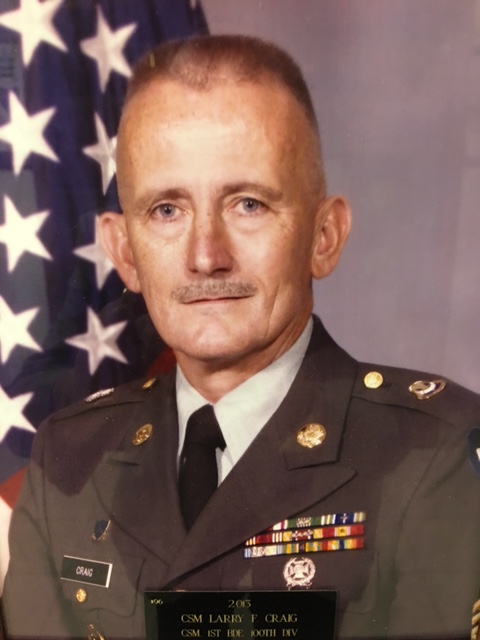
Larry F. Craig
Command Sergeant Major Larry F. Craig enlisted in the U. S. Army and served from 1970 – 1972. He received training as a Redeye Gunner and served as an Intelligence Assistant in the 172nd Infantry Brigade in Alaska.
Following his active duty tour, CSM Craig was assigned to USAR Control Group while attending Western Kentucky University where, in 1974, he graduated earning his Bachelor of Science Degree in Business Administration.
In 1975 CSM Craig was assigned as a Drill Sergeant (OCT 1975 – SEP 1979) with D/2-399/1/100 Div (AR) (OSUT) in Burkesville, Kentucky. Follow on assignments in that unit include Tank Commander (SEP 1979 – SEP 1980), Senior Tank Commander (SEP 1980 – SEP 1990) and Company First Sergeant (SEP 1990-JAN 1996). CSM Craig was then selected as Battalion CSM (JAN 1996 – MAR 1997) for 3-399/2/100 Div (IT) in Hopkinsville, Kentucky. Subsequent CSM assignments in the 100th Division include Battalion CSM (MAR 1997 – SEP 1997) for 1-397/1/100 Div (IT) in Richmond, Kentucky and Brigade CSM (SEP 1997 – JUL 2000) for First Brigade, 100th Division (CAV) (IT) headquartered in Lexington, Kentucky.
He was next selected as CSM (JUL 2000 – SEP 2002) for the 2145th Garrison Support Unit located in Nashville, Tennessee. His final assignment was CSM (OCT 2002 – JAN 2006) for the 640th Area Support Group in Nashville, Tennessee.
CSM Craig retired in JAN 2006 with more than 35 years of Army service (24 years, 9 months – 100th Division; 10 years, 7 months – Active/Other reserve units). His service reflects professional competence, high standards, and mission accomplishment.
CSM Craig was Company First Sergeant mobilized in 1991 for Operation Desert Storm D/2-399/TASK FORCE 100th Division. In all his assignments, CSM Craig’s senior NCO leadership ensured soldiers’ displayed high morale and professionalism in successfully completing all assigned OSUT, BCT Battalion C2 and BCT missions and providing support to SROTC.
CSM Craig and his wife, Gail, live in Albany, Kentucky. His civilian occupation is with the U.S. Army Corps of Engineers, Nashville District where he serves as Power Project Manager for the Eastern Kentucky Area, which includes Wolf Creek and Laurel Power Plants and Dams.
Awards and Decorations include the following:
Legion of Merit
Meritorious Service Medal (3 OLC)
Army Commendation Medal (2 OLC)
Army Achievement Medal (2 OLC)
National Defense Service Medal w/Bronze Star
Army Good Conduct Medal
Armed Forces Medal with Gold Hourglass and M device
Noncommissioned Officers Professional Development Ribbon with/4
Army Service Ribbon
Rifle and Pistol Expert Badges
2013 – Inducted into the Corridor of the Century Inductee # 96
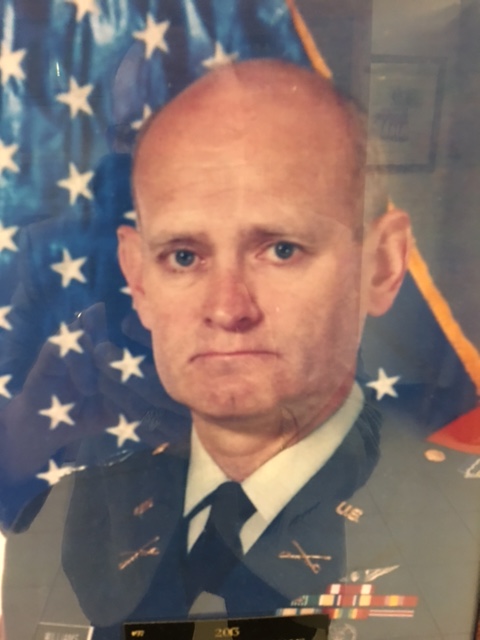
Norman K. Williams
Colonel Norm Williams was commissioned a 2nd Lieutenant in 1972 in Field Artillery. He served as platoon leader, executive officer, battery commander and staff officer in Artillery units of the Kentucky Army National Guard.
Joining the 100th Division Maneuver Training Command (MTC) in 1981, Colonel Williams served as operations officer, executive and NBC officer on the Field Artillery and Cavalry Teams through 1986.
He later completed assignments as S3 of the 2nd Squadron, 302d Cavalry, Georgetown, KY, and S3 of 3rd Brigade, Lexington, KY in 1986 – 1992.
Colonel Williams commanded 1st Battalion, 397th Regiment, Richmond, KY, in 1992 – 1994. Upon completion of battalion command, he served in 100th Division Headquarters, Deputy Chief of Staff for Operations, as Initial Entry Training Officer and as Assistant Chief of Staff for Operations in 1994 -1997. He served as the Deputy Chief of Staff for Personnel in 1998.
Colonel commanded the 7th Brigade, 100th Division, at Fort Knox, K in 1998 – 2000 and then retired.
Colonel Williams is a graduate of the Field Artillery Basic and Advance Schools, Armor Basic and Advance School, the Command and General Staff Officers College and Basic and Advance NBC School. He graduated from Army War College in 1997.
Colonel Williams was the S3 for the 3rd Brigade during the 100th Division mobilization for Desert Shield and Desert Storm. He ensured the Brigade units deployed were fully trained and that personnel were qualified for mobilization. Colonel Williams also coordinated with Task Force 100 during its command of those units to ensure the 3rd Brigade performed to standard. He served as interim S3 for the 1st Armor Training Brigade (OSUT), Fort Knox, KY, coordinating the operations of Armor and Cavalry OSUT.
Colonel Williams’ most rewarding experiences were as Commander, 1st Battalion, 397th Regiment and as 7th Brigade Commander. He transitioned the 1-397 from M113 to M3 Bradley and successfully conducted M3 OSUT at Fort Knox, KY. He then transitioned the 1-397 to Armor and conducted Armor OSUT. He later transitioned the unit to Basic Training and then conducted a highly successful Mobilization Army Training Center (MATC) operation at Fort Knox.
As 7th Brigade Commander, Commander, Colonel Williams completed two successive highly successful ROTC Basic Camp cycles at Fort Knox, KY, training more than 3,000 Army cadets. His brigade also provided dynamic personnel, Operational and Logistic support to Fort Knox, Fort Campbell and 100th Division Reserve and Regular Army units. He also was the senior commander of 100th Division Drill Sergeant School and fully supported the Division’s push for higher quality instruction in the school.
Colonel Williams retired in 2001 with 32 years of military service. For 30 years, he has been a lifetime member of the Association of the Century. He has been a board member of the Association of the Century for the past four years. He is also a longtime member of the Association of the United States Army and Reserve Officers Association.
In civilian life, he is CEO of Williams Financial Investigations, LLC, Lexington, KY. He and his wife Janet live in the Lexington area and have two children and two grandchildren.
Colonel Williams’ decorations include:
The Legion of Merit
Meritorious Service Medal (2OLC)
Army Commendation Medal (1OLC)
Army Achievement Medal (Eighth Award)
National Defense Service Medal (with Hour-Glass)
Army Overseas Training Ribbon
2013 – Inducted into the Corridor of the Century Inductee # 97
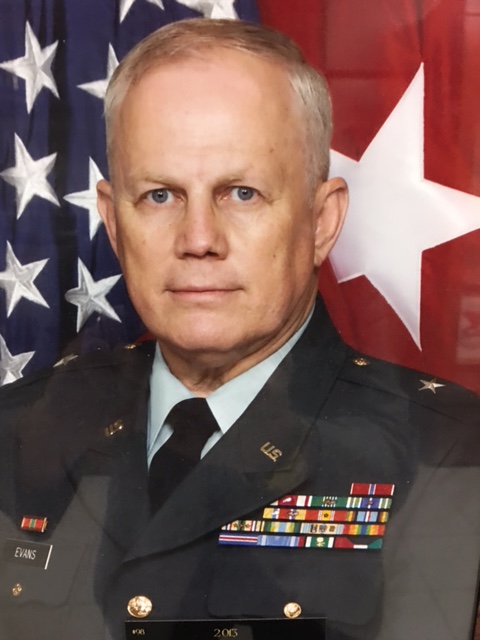
David L. Evans
Major General David L. Evans enlisted as a Private in the US Marine Corps in 1968. He served two years on active duty assigned to Headquarters, US Marine Corps in Washington, D.C. Following active duty he was assigned to the US Marine Corps Reserve until his assignment to the Army National Guard, where he served as an Infantry Platoon Squad Leader. MG Evans was commissioned Second Lieutenant, Infantry in 1974. His ensuing assignments included Infantry Platoon Leader, Special Forces Operational Detachment Executive Officer, Tactical Training Officer for OCS, and Detachment Commander/Executive Officer for a Mechanized Infantry Company.
In 1979, MG Evans transferred to the 2-399th Regiment, 1st Brigade, 100th Division where his initial assignment was Executive Officer/Training Officer for E Company located in Scottsville, Kentucky. In April 1980 he was assigned as E Company Commander and later as B Company Commander headquartered in Bowling Green, Kentucky. MG Evans company command time was 41 months. MG Evans always exhibited strong command emphasis and positive leadership “leading the way” in successfully completing every assigned mission. While Company Commander his unit was the first to begin a 16-week OSUT cycle at Fort Knox, which set the stage and performance standard for the companies that followed. He was selected as the Outstanding Company Grade officer at Battalion two years in a row and one year at Brigade.
From September 1983 until March 1988, MG Evans served as S1/Adjutant and S3/Operations Officers at 2-399th Regiment, 1st Brigade. While Battalion S-3, he was instrumental in planning the unit’s 19K conversion, coordinating M-1 Tank conversion training while ensuring soldiers obtained school quotas to the Tank Commander Certification Course at Fort Knox.
From 1988 until 1991 he was assigned to the 401st Military Police Camp (EPW) as Camp S3/ Operations Officer serving in Desert Storm during the Persian Gulf War. In 1991 he returned to the 100th Division serving in various command and staff positions including 1st Brigade S2/S3 (1991-93) in Lexington where he planned, directed and executed complex annual training missions including support for the highly visible and successful Reserve Training Concept at Fort Knox. 1st Brigade received accolades from TRADOC, USARC and 2d US Army. MG Evans also planned and executed Brigade Boselager and Top Gun competitions leading to 1st Brigade winning Division Boselager competition. His leadership ensured Brigade units conducted highly successful recruiting missions while flawlessly executing OSUT, BCT Battalion C2 and BCT missions and providing support to SROTC. MG Evans spearheaded Brigade’s implementation of the Division Operating System and his Brigade played a key role in the 100th Division winning the USAR Army Communities of Excellence award.
MG Evans was next assigned as Squadron Commander (1993-94) for the 2-302 Cavalry, 3rd Brigade in Georgetown; and Battalion Commander (1994-95) of 1-400, 1st Brigade in Lexington. Following Battalion Command, MG Evans deployed in 1996 serving in Operation Joint Endeavor assigned as Operations Officer and, later, Commander of Task Force Sava with the 1st Armored Division in Bosnia and Croatia. Upon his return to the 100th Division, MG Evans served as Schools and IET Officer (1996-97) at 100th Division Headquarters in Louisville, Kentucky. He was selected for resident attendance to the US Army War College (1997-98). Upon return from War College, MG Evans served as Executive Officer for 1st Brigade, 1st Brigade Commander (1999-2001), and 100th Division Chief of Staff (2001-02). As 100th Division Chief of Staff, he provided guidance, assisted with coordination and fully supported the highly visible US Army Reserve Awareness Day weekend event for Congressional Staffers hosted by the 100th Division.
His last assignment with the 100th Division was Assistant Division Commander-Operations (2002-05) at the Division Headquarters in Louisville where he ensured the successful merger of 84th Division with the 100th Division and provided oversight for the realignment of units in Mississippi and Alabama to the 108th Division. At the same time, his units provided highly trained soldiers in support of the Global War on Terror.
MG Evans’ final US Army Reserve assignment was Commanding General, 80th Division (IT) / 80th Training Command (TASS) from 2005-08. His military career spanned 40 years including 36 years of Army service (22 yrs-100th Division; 18 years-Active/Other reserve component units). His distinguished service reflects professional competence, high standards and mission accomplishment.
In civilian life, MG Evans retired as the Director, Joint Management Office for the Joint Knowledge Development and Distribution Capability (Joint Staff J7), one of the three enabling capabilities for Training Transformation within the Department of Defense.
MG Evans resides in Wartrace, Tennessee. Since his retirement from the military, he continues to be active in the community serving as Moderator for the Church Business Meetings and Chairman-Finance Committee, United Way Campaign and President of Leadership Bedford. He is a Life Member of the Association of the Century and attends annual meetings supporting both the Benjamin J. Butler Scholarship Fund and Support Our Soldiers Program. MG Evans is active with the Military Officers Association and Reserve Officers Association serving as President, ROA Department of Tennessee 2012-2013.
His awards and decorations include the Distinguished Service Medal, Legion of Merit, Bronze Star Medal, Meritorious Service Medal (with Silver Oak Leaf Cluster), Army Commendation Medal (with 2 Oak Leaf Clusters), Army Achievement Medal (with Oak Leaf Cluster), Reserve Components Achievement Medal (with silver and 2 Oak Leaf Clusters), National Defense Medal (with Service Star), Armed Forces Expeditionary Medal, Southwest Asia Service Medal (with 3 Bronze Stars), Global War on Terrorism Service Medal, Armed Forces Service Medal, Armed Forces Reserve Medal (with Gold Hourglass and M2 Device), Army Service Ribbon, Reserve Components Overseas Training Ribbon, NATO Medal, Kuwait Liberation Medal (Govt. of Saudi Arabia), Kuwait Liberation Medal (Govt. of Kuwait), Army Meritorious Unit Award and Army Superior Unit Award.
2013 – Inducted into the Corridor of the Century Inductee # 98
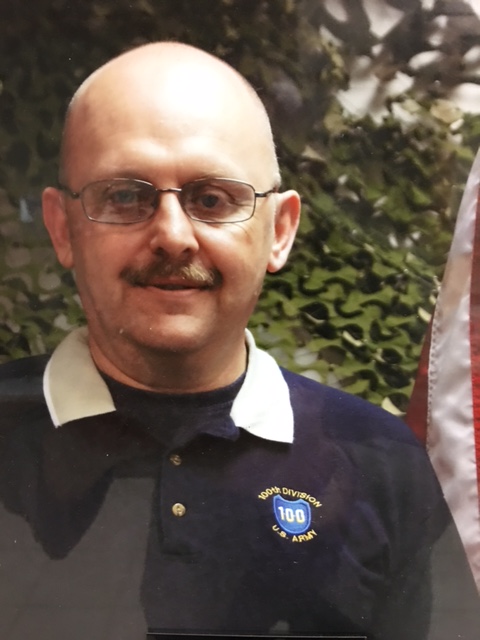
Joe V. Lamkin
Dates of Service in the 100th Division: September 1981 to March 2001
SGT (Retired) Joseph V. Lamkin entered military service on September 27, 1977 in the Delayed Entry Program as a senior at Marion County High School in Lebanon, Ky. Upon graduating on June 9, 1978 he entered OSUT on June 13, 1978. At Ft. McClellan, Alabama he completed basic training and AIT (95B10 Military Police and CID). In September 1978 went on to Ft. Benning, GA. for additional MOS training in 11B for Inf. In December 1978 was assigned to the 8th Infantry Pathfinder Division, 18th MP Brigade & attached to the 2/87th Company A at Robert E. Lee Barracks in Mainz/Wackernheim, Germany. While assigned to this post was further attached to the Wiesbaden Army Hospital as security task force for the return of the 52 American Hostages who were held for 444 days in Iran. In January 1981, he escorted former hostages back to the United States to Walter Reed Hospital for debriefing and further medical treatment. After this duty He returned to Germany and was assigned to the 8th Division Special Pathfinders Squad. In June 1981 he returned to CONUS and left active duty and joined the Army Reserves. He was assigned to the 728th Eng. Brigade in Bardstown, Ky. & served as a truck driver. In September 1981 he transferred to the 100th Div. MTC located at Bowman Field in Louisville, KY. and served as an Administrative Specialist,71L10 on Infantry Team One. In this position he participated in five team training exercises.
In 1983 I was transferred to the MTC Signal Team. In a two year period while in this assignment, he participated in a total of 9 training exercises. He then transferred to the MTC MP Team. Over this two year assignment He participated in a total 12 exercises. He then transferred to the 4th BDE in Lexington, KY as an Administrative Specialist Clerk, MOS 71L.
In January 1990 the 100th Division was called up for the Gulf War. As a member of the 100th Division he was attached to the 450th MP Co. as a MP/CID Investigator Specialist. During the Gulf War I was stationed in Sheffield, Alabama. The unit received orders to deploy to the Gulf. The Gulf War ended prior to his deployment to the Gulf. In June1991 he was released back to HHC 100th Division. His work assignments included work in the G2 and G3, DCSOP, and DCST. This challenging assignment enabled him to work closely with Mr. Ben Zimmerman. In working part time in this challenging environment, he performed a wide variety of jobs and he also assisted with a total of six Commander’s Conferences. On March 1, 2001 He transferred to the Retired Reserves.
AOC Board Member since November 2010
AOC Committees: 100th Division Museum & Funding Raising
MOS’s: 95B20, 96B30, 11B20, 76Y20, and 71L20
Awards and Decorations:
MSM
AAM
Overseas Service Medal
Good Conduct Medal
ASR
ARCAM with 4 OLC
NDSM
AFRM with 3 OLC
8TH Infantry Pathfinder Badge
Other Awards:
Kentucky Admiral
Kentucky Colonel
Commonwealth of Kentucky Citation of Appreciation for U.S. Military Service
Minister and Missionary of the Commonwealth of Kentucky:
Family, Civic and Religious Activities:
Since retiring from the 100th Division his family life has been an integral part of his life. He has a daughter and a friend /adopted daughter of Latin American heritage. He is a part-time auctioneer.
He is a past Chairman and presently working with Men for Christ, a group of Christian men building churches in non-church communities in KY. He also is doing missionary work in Brazil, Mexico, Russia and the United States working with churches in disaster relief for victims in humanitarian aid. He has preached
Gospel meetings and held Campaigns for Christ in all areas of our country. He has worked with high school and college students in the capacity as a Christian leader for their spiritual needs. He has worked in planning over 50 new churches and overseen over 500 new members commit to living a new spiritual life.
He is presently on the Warren County Minister Association in Bowling Green, KY. in Warren County, he serves as a team leader and minister of the Campbellsville Emmaus Community and the Alabama Emmaus Cluster. He is also a lifetime member of the Forkland Community Center in Boyle County.
2013 – Inducted into the Corridor of the Century Inductee # 99
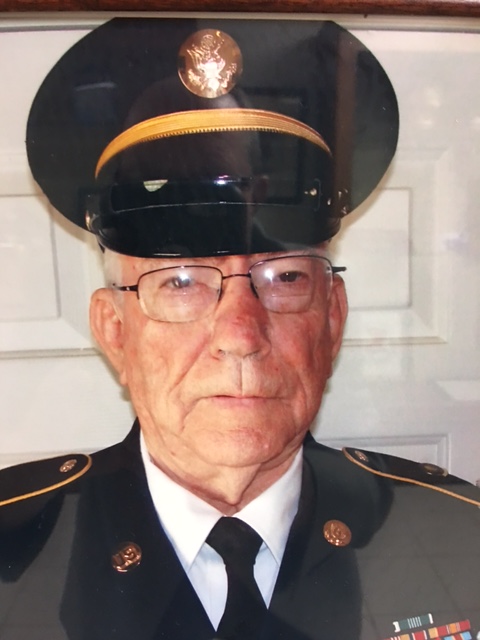
Ernest C. Taylor
Time served in the 100th Division: October, 1958 to May, 1979
Positions he held in the 100th Division: Classroom instructor, Drill instructor, Senior Drill Sergeant (instructor), First Sergeant and Battalion Command Sergeant Major. He first served in C Company of the 399th Regiment but due to re-organization he later served in the 397th Regiment.
He was activated with the 100th Division to Fort Chaffee, Arkansas in 1961. During this time, he served as the NCOIC of the 400th Regiment Tactics committee he completed the Pre-commission course and served as the Field First Sergeant of Company C of the 399th Regiment, training basic trainees.
His other service: He entered the Army in January of 1957 and he was separated in October of 1958. During this time, he took basic training at Fort Knox, Kentucky and Military Police training at Fort Gordon, Georgia. He was stationed briefly at Fort Dix, New Jersey and Fort Hamilton, New York. He was then sent to Europe, where, although he was assigned to the 537th Military Police Company he spent considerable time on TDY which resulted in his service throughout Europe and even Turkey during the Lebanon crisis. His duty assignments included: MP patrol, shift supervisor, desk sergeant, squad leader and assistant Platoon Sergeant. He rose in rank from Private to Acting Sergeant during this period of time.
Decorations and Awards: While at Fort Chaffee he was awarded the Army Commendation medal and he was chosen to be one of the representatives of the 100th Division serving in Fort Chaffee from Kentucky in the Sunday magazine of the Courier-Journal. Also, he was awarded the Good Conduct medal, National Defense medal and the Armed Forces Reserve medal. He was a candidate for the Centurymen of the year in 1972.
As indicated by his assignments and advancements in the 100th Division, CSM Taylor was one of the trail blazers for the 100th Division Training mission, having been a member of the Division when it was reorganized to (Training) in 1959. He advanced from classroom instructor to Command Sergeant Major of his Battalion. He was an outstanding leader and set the example for the soldiers serving in his command. His battalion was ranked as one of the top units in the Division each year.
In civilian life CSM Taylor was a teacher in the Marion County School system and later advanced to be Supervisor of the School Transportation Division. CSM Taylor and his wife Evelyleen have four children, ten grandchildren and two great grandchildren.
2013 – Inducted into the Corridor of the Century Inductee # 100
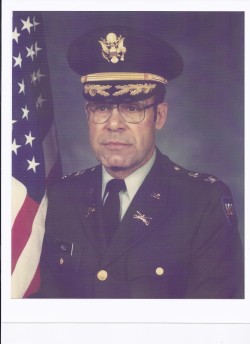
Leo Hill
Colonel Leo Hill joined the 100th Division December 6, 1959. He received a direct appointment as a 2nd Lieutenant on 29 August 1960 in Armor. His first military duty experience was an active tour as an Armor Crewman from October 13, 1953 through October 6, 1955. Sixteen months of the time was spent in the Far East Command (FECOM) with the 56th Amphibious Battalion and the 1st Cavalry Division. Colonel Hill was called back for one year of additional active duty during the Berlin Crisis of 1961.
He completed assignments from Aug, 1960 through Jan, 1975 in the 399th Regiment as a platoon leader & instructor and company commander, in the 400th Regiment as an instructor, assistant brigade S3, tactics committee chief, battalion operations officer.
He then completed assignments from Jan, 1975 through May, 1980 in the 302d Cavalry, 2nd Squadron as an operations officer and the squadron executive officer and 1st Squadron as the commander and then assignments in the 3rd Brigade as an S4 and deputy brigade commander
He was then assigned to control group from May, 1980 through Sep, 1982.
Colonel Hill served the 100th Division Maneuver Training Command (MTC) from Feb 1983 until Mar 1986, with assignments as a combat exercise division assistant chief, combat service support and combat opposing forces chief and the combat exercise division chief and then reassigned back to control group until retirement in Feb 1993.
Colonel Hill’s military education includes the completion of the Methods of Instruction Course, Safety Management School, Basic and Advanced Armor Officer Schools, the Command and General Staff Officers College, National Security Management Program and Industrial College of the Armed Forces. He also graduated from Air Force War College in 1985.
Colonel Hill retired in Feb 1993 with 32 years of military service, 7 years as enlisted and 25 years as an officer. He is a lifetime member of the Association of the Century.
Colonel Hill’s civilian education includes a BS Degree with distinguished honors from Murray State University. He also was the recipient of a scholarship in which he graduated from the Management Internship Program in 1973 from the University of Nebraska.
In civilian life, he is an active participant in the affairs of his community. He has been president of the Kentucky Member Service Association, distinguished president of The Danville Kiwanis Club, distinguished Lieutenant Governor of the Kentucky/Tennessee Kiwanis District, chairman of the Kentucky American Private Enterprise System Study course sponsored by the University of Kentucky Extension Service, president of the Danville-Boyle County Chamber of Commerce in 1987, a director on the National City (now PNC Bank) advisory Board of Directors, Campaign Chairman of the United Way and chairman of the Danville Fireman and Police Merit Board.
His civilian occupation was as the Manager of Member Services, Inter-County Rural Electric Cooperative Corporation in Danville, KY and President and Chief Executive Officer of Inter-County Energy Corporation.
Colonel Hill and his wife Barbara live in the Danville, KY and they are the parents of a daughter, Debbie Hill, a graduate of Center College and University of Kentucky and attorney.
Awards and decorations include:
Meritorious Service Medal
Army Commendation Medal
Army Achievement Medal
Armed Forces Reserve Medal
National Defense Service Medal
2014 – Inducted into the Corridor of the Century
Inductee # 101
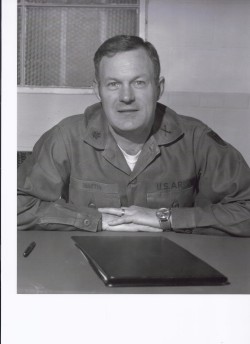
Elmo Martin
Colonel Elmo Martin joined the 100th Division in 1954 after completing studies at Eastern Kentucky College (now Eastern Kentucky University). At EKU he participated in the ROTC program and was commissioned as a 2nd Lieutenant at graduation in 1954. He continued his military career and service in a variety of assignments with the 100th Division until his retirement in 1984. His assignments in the 100th Division began in 1954 as the Executive Officer of the Supply Battery. In 1955 as a 1st Lieutenant he became the Assistant S-3 of the 373rd Field Artillery Battalion followed in 1956 as the S-1 of the 373rd. In 1959 he joined the cook section as a Food Advisor and in 1961 was promoted to Captain. It was in this status that he mobilized and deployed with the 100th Division to Ft. Chaffee, Arkansas from September 1961 to October 1962 during the crisis days of the Cold War. In 1963 he served as the 3-4 of the 100th Regiment and in 1964 assumed duties as the S-2 of the 100th Regiment. In 1965 he completed the Basic Artillery Officer Course and was promoted to Major. He continued in this role while completing the Artillery Officer Career Course in 1967. In 1968 he assumed duties as the Committee Director of the 4th Brigade; in 1970 he became the Executive Officer of the 2nd Battalion, 4th Brigade. In 1972 he was promoted to Lieutenant Colonel and Commanded the 1st Battalion, 4th Brigade, in 1973 he became the G-4 of the 100th Division. In 1974 he joined the Maneuver Training Command (MTC) Field Artillery Section. In 1976 he became the S-1 of the MTC and in 1978 was promoted to Colonel. In 1979 he became Chief of the OPFOR Combat Division of the MTC and in 1980 the Chief of the Combat Support Exercise Division where he continued to serve until his retirement.
COL Martin’s military service began in 1946 when he enlisted in the United States Air Force. During that time he was assigned to the Pacific Theater and served in Japan as part of the occupation force. He left the Air Force in 1949 to attend College and participate in the ROTC program. He graduated with a Bachelor’s Degree in Industrial Arts in 1954 then joined the 100th Division. COL Martin’s military education included Basic Artillery Officer Course (completed 1965), Artillery Officer Career Course (completed 1967), Command and General Staff College (completed 1973), and completion of the Industrial College of the Armed Forces-National Security Management in 1976. Civilian education includes a Master of Arts in Education with an additional 30 graduate hours in Administration and Leadership.
COL Martin spent many personal hours developing programs and activities for 100th Division Soldiers. He coordinated food and recreation services, developed skills as a Tactical Intelligence Officer, and accepted extra duties as the Race Relations and Equal Opportunity Officer. In addition to expertise in Artillery he studied and trained to obtain MOS 41A – Army Personnel Programs Management Staff. COL Martin is a life member of the Reserve Officers Association and served as President of the Kentucky Department of the ROA in 1982. He remains an active member of the ROA and the Association of the Century. While assigned to the Maneuver Training Command he was recognized for implementing new and innovative programs for exercises and realistic scenarios. He performed these activities while managing resources carefully conducting training while decreasing unit costs. His many contributions to the Division were significant. Most notable, he was known for his efforts in recruiting and retention throughout his service with the 100th Division. COL Elmo Martin is a solid example of service to his country and to the 100th Division.
Awards and Decorations Include:
National Defense Service Medal
Meritorious Service Medal
Reserve Certificate of Achievement
Pacific Theatre Medal
Army Occupation Medal
Good Conduct Medal
2014 – Inducted into the Corridor of the Century
Inductee # 102
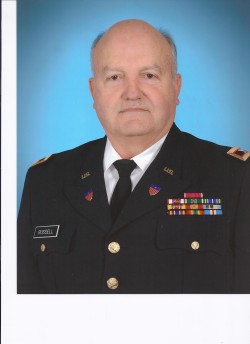
James G. Russell
Colonel James G. Russell is a native of Marion County, a graduate of Marion County High School and the Marion County ROTC Program in 1972.
Colonel Russell graduated from Morehead State University in 1976, was awarded a Baccalaureate Degree, and was commissioned a Second Lieutenant into the US Army from the Morehead State University ROTC Program. Colonel Russell has served in multiple staff positions from the Battalion through Division level, and has commanded at the Company, Battalion, and Brigade level, while serving with the 100th Division in Lebanon, Fort Knox, Lexington, Owensboro, and Louisville. Colonel Russell’s current assignment as a Reserve officer in the Emergency Preparedness Liaison Officer for the Commonwealth of Kentucky, coordinating the Federal Government response when Disaster Assistance is requested by the Governor.
Colonel Russell holds a Master’s Degree in Military Strategic Studies from the US Army War College.
Colonel Russell and his wife Lynn have a son, Daniel, and a daughter Jamie, and live in Loretto, Kentucky. Colonel Russell is a Lifetime member of the Association of the Century.
Awards and Decorations include:
Legion of Merit
Meritorious Service Medal wl7 Oak Leaf Clusters
Army Commendation Medal with Oak Leaf Cluster
Global War on Terror Service Medal
Army Achievement Medal
Kentucky Distinguished Service Medal
2014 – Inducted into the Corridor of the Century
Inductee # 103
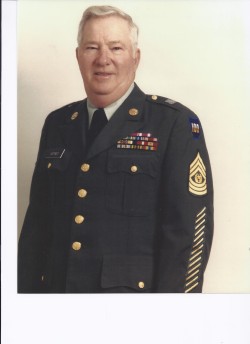
Paul I. Haynes
Paul I. Haynes, as Command Sergeant Major for the 1/398/2/100thDivision served with nine different (9) Battalion Commanders. He always performed his duties in an outstanding manner. His Battalion always produced an outstanding group of trained Drill Sergeants, who were always willing to volunteer for any assignment such as two tours to Fort Jackson, SC and Fort Polk, LA. There were also many tours at Fort Knox, KY, and beyond. When the Battalion’s mission changed from Infantry Basis Combat Training to an Armor OSUT mission, the job of cross training many of the Drill Sergeants and others soldiers in the Battalion to be Tank Commanders was done in an outstanding manner.
Under CSM Haynes’ leadership, the 1/398th Battalion always maintained near or above 100% strength and always had a high number of MOS Qualified Personnel. CSM Haynes worked very close with the Battalion Commander and staff and all the support personnel of the Battalion. He always made sure everyone had the needed items to do their job. CSM Haynes always made a priority for all soldiers to get their pay on time along with all other required paperwork. Haynes also served as a BN and BDE Unit Technician.
Awards and Decorations include:
Legion of Merit Meritorious Service Medal
Army Commendation Medal w/OLC
Army Achievement Medal
Good Conduct Metal
Army Reserve Components Achievement Medal
Army of Occupation Medal (Germany)
National Defense Service Medal w/OLC
Armed Forces Reserve Medal w/1, device
NCO Professional Development Ribbon 4
Army Service Ribbon
Meritorious Civilian Service Award
Achievement Medal for Civilian Service
2014 – Inducted into the Corridor of the Century
Inductee # 104
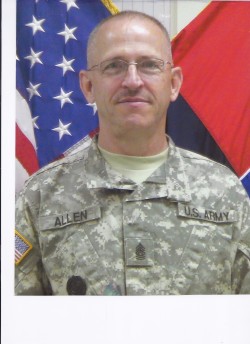
Otha Allen
Command Sergeant Major Otha Allen is a native of Taylor County and graduated from Taylor County High School.
CSM Alien entered the Army in May 1971, served three years on active duty and was released in May 1974. From May 1974 to October 2005 CSM Allen served in the 100th Division. His assignments include Helicopter Repairman, Tank Commander Instructor, Battalion Supply Sergeant, First Sergeant, G4 Sergeant Major, Battalion Command Sergeant Major and 8th Brigade Command Sergeant Major. These assignments demonstrate a wide variety of skills and his performance was always rated as outstanding. His military education ranged from NCO Development Course thru Drill Sergeant School, First Sergeant Course and Sergeant Major Academy. He was recalled to active duty during operation Desert Storm January -1991~March 1991, serving with Task Force 100 at Fort Knox, Kentucky.
Command Sergeant Major Allen and his wife, Susan, live in Lebanon, Kentucky. They have three children, Jennifer, Cari, and Joel.
AWARDS AND DECORATIONS INCLUDE:
Legion of Merit
Meritorious Services Medal with two Oak Leaf Clusters
Army Commendation Medal with two Oak Leaf Clusters
Army Achievement Medal with one Oak Leaf Cluster
Good Conduct Medal
Army Reserve Component Achievement Medal with seven Oak Leaf Clusters
National Defense Service Medal with one Bronze Star
Korean Service Medal
Armed Forces Expeditionary Medal
Armed Forces Medal with M Device and Hour Glass
Non Commissioned Officer Professional Development ribbon with numeral 4 Army Service Ribbon
Overseas Service Ribbon
Drill Sergeant Badge
Aircraft Crew Member Badge
2014 – Inducted into the Corridor of the Century
Inductee # 105
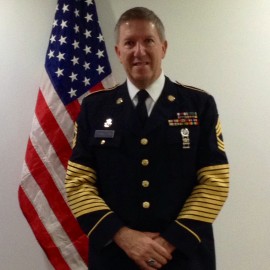
Joseph P. Hamilton III
MSG Joseph P. Hamilton III (RET) has distinguished himself by exceptionally meritorious service, exemplary leadership and impeccable performance throughout his almost 40 year military career culminating in a mobilization assignment as Chief, Human Resource Sergeant at the Total Army School Training Center (TTC) at Fort Knox, Kentucky from January 31, 2009 to September 30, 2010. Assigned to the 100th Division from November 1972 to October 2010, MSG Hamilton began his career in the Army by enlisting as a private in May 1971; he swiftly rose through the ranks attaining the rank of Master Sergeant by 1989. His meticulous attention to the complex details of human resource management resulted in a positive and everlasting impact on thousands of Soldiers trained for war fighting by the 100th Division. His exceptionally broad knowledge of administrative and personnel procedures, coupled with his initiative, resourcefulness, and intellectual strength along with his willingness to cooperate with leadership has enabled him to perform masterfully in various positions of great responsibility throughout the Division Headquarters. MSG Hamilton took on many additional active duty tours and with the knowledge he gleaned from these active duty tours only added to the smooth operations of this headquarters which resulted in the efficient and effective execution of all mission assignments. MSG Hamilton’s genuine concern for not only his Soldiers but their families was observed by his many years as an integral part of the Family Readiness Program; guiding six Division Commanders’ and working within their program doing whatever was needed to have successful Holiday and Summer Family Day events. In 1980 MSG Hamilton energized a previously faltering color guard and vigorously developed it into a professional organization. Serving as Color Guard Commander for over 20 years his team performed at numerous military funeral details, and various other events to include high visibility public, local and national functions such as being the chosen color guard for General Norman H. Schwartzkopf during a welcome home celebration after Desert Storm as well as MSG Hamilton being the Army Representative at the induction of the Louisville Patriot’s Peach Memorial to only name a few. The same professionalism MSG Hamilton gave to each event reflects greatly upon the positive public perception of our military.
MSG Hamilton’s almost four decades of professional soldiering have been a remarkable model for his subordinates and superiors alike. His outstanding achievements and devotion to duty during his career brings great credit to himself, the 100th Division and the United States Army. MSG Hamilton has continued to serve the 100th Division volunteering whenever possible. If asked he will go, like a few years ago when he played Santa Claus for their Christmas Family Day, helping with the move from Louisville to Fort Knox and setting up at Ft. Knox as well as assisting with needs for the Association of the Century to include becoming a Lifetime Member. MSG Joe Hamilton (RET) bleeds the 100th Division and always will and is so very proud of it.
Military Decorations and Awards Include:
Meritorious Service Medal with Two Oak Leaf Clusters
Army Commendations Medal with Three Oak Leaf Clusters
Army Achievement Medal with Silver Oak Leaf
National Defense Medal with 3 bronze stars
Global war on Terrorism Service Medal
2014- Inducted into the Corridor of the Century
Inductee # 106

KimberLee A. Hamilton
Master Sergeant KimberLee Hamilton enlisted in the United States Army Reserve in 1985, and completed basic training at Fort Jackson, South Carolina. Upon returning from Active Duty, she was assigned to the 100th Reception Station as an Administrative Specialist from September 1985 to January 1991. Master Sergeant was activated in 1991 as part of the Presidential Call-up of Reserve Forces at Fort Knox, Kentucky. Upon returning from Active Duty, she was assigned to 100th Division Headquarters Company as a Records Specialist, While using her vast knowledge of administrative and personnel management, she quickly moved from the Records Branch to the NCOER/OER Branch, and then to the Awards Branch, and attaining the rank of Master Sergeant. MSG Hamilton used her extensive skills and meticulous attention to detail to reduce a backlog of evaluations and awards from months down to weeks in processing time. Serving a short time as Assistant Inspector General and with her initiative and resourcefulness in the Administrative Branch, she was selected to work directly with the Commanding General as the Organizational Inspection Program Coordinator. MSG Hamilton demonstrated leadership, teamwork, and attention to detail as she led the OIP team to a twenty percent rise in the initial command inspection result submission to brigade leaders and a 100 percent submission rate going to United States Army Reserve Command.
MSG Hamilton was mobilized as part of a Joint Command at Special Operations Command Central in Tampa, Florida, and then being forward deployed as the NCOIC of SOCCENT Headquarters J1 section, where she is in direct contact with the DA G1 SGM at the Pentagon.
MSG Hamilton is a life member of the Association of the Century.
Decorations and Awards Include:
Meritorious Service Medal
Joint Service Commendation Medal
Army Commendation Medal with 4 Oak Leaf Clusters
Army Achievement Award with one Oak Leaf Cluster
Army Reserve Component Achievement Medal w/ five Oak Leaf Clusters
National Defense Service Medal with two Bronze Stars
Global War on Terrorism Service Medal
Global War on Terrorism Expeditionary Medal
Armed Forces Reserve Medal with M Device
Army Service Ribbon
2015 – Inducted into the Corridor of the Century, Inductee # 107
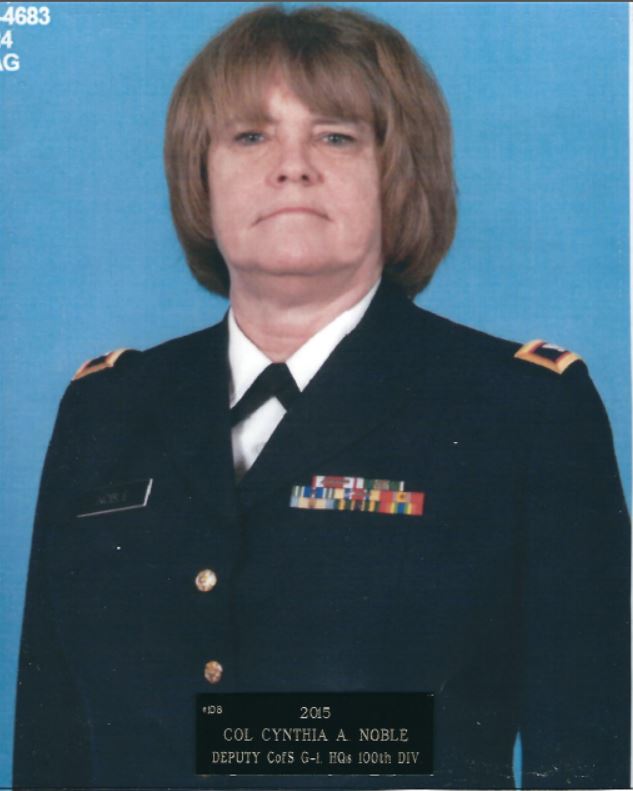
Cynthia A. Noble
Colonel Cynthia A. Noble began her career of over 35 years with Company B, 302nd Squadron, 1st Brigade, Frankfort, KY. She received a direct commission as a First Lieutenant in February 1981, and was assigned as Adjutant, 100th Division Maneuver Training Command, Louisville, KY, from January 1982 until August 1986. Colonel Noble continued with the 100th Division MTC service as Public Affairs Officer until 1992. Colonel Noble was selected as Commander 590th Personnel Service Company, serving from September 1992 until March 1994. She then returned to the 100th Division as Personnel Management Officer, DCSPER, serving until October 1996.
Colonel Noble was assigned as 100th Division Deputy G1 in November 1996 serving until October 2001. She was selected as Commander, 1-399 Reception Battalion, commanding from November 2001 until December 2003. She again returned to the 100th Division HQ as the Recruiting and Retention Officer from December 2003 until June 2009. During this period, the 100th Division (IT) went from an Institutional Training Division to an Operational Support Division, adding 1200 Soldiers from nineteen states throughout the US. COL Noble developed, coordinated, and managed a personnel process where unit administrators from newly assigned units brought Soldiers’ records for processing into Division Headquarters to process assignment to new units. COL Noble was selected as the ADCS G1 in June 2009 and served until September 2010. In September 2010, she accepted assignment as the Emergency Preparedness Liaison Officer, Office of the Assistant Secretary of Defense for Reserve Affairs, where she served until retirement.
COL Noble is a graduate of the Basic and Advanced Adjutant General Officer Courses, and completed the Army Command and General Staff Course, and is a graduate of the US Army War College. She is a Life Member of the Association of the Century, and Reserve Officer’s Association.
Decorations and Awards Include:
Meritorious Service Medal with Five Oak Leaf Clusters
Army Commendation Medal with Six Oak Leaf Clusters
Army Achievement Medal
Army Reserve Component Achievement Medal w/ Six Oak Leaf Clusters
National Defense Service Medal
Armed Forces Reserve Medal with Three Oak Clusters
Army Service Ribbon
2015 – Inducted into the Corridor of the Century, Inductee # 108
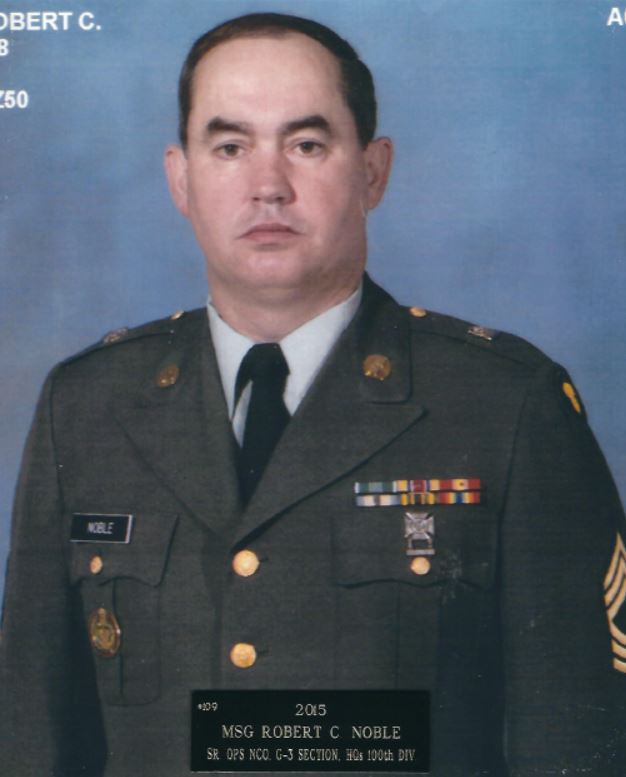
Robert C. Noble
Master Sergeant Robert C. Noble enlisted in the United States Army Reserve in November 1971, assigned to Company A, 1-302nd, 3rd Brigade, 100th Division, serving as Senior Drill Instructor, tank turret mechanic, and cavalry scout. MSG Noble was then selected as NCOIC for Infantry Team 2, 100th Division Maneuver Training Command from June 1985 until May 1990. MSG Noble was selected as the Operations NCO, Armor Division, 100th Division MTC, serving until March of 1992. As the Senior NCOIC, he was first line supervisor for enlisted Soldiers of the Infantry Team and assisted in the planning and execution of lanes training exercises until April 1994, preparing monthly status reports for the 100th Division Command Sergeant Major. MSG Noble was selected in May 1994 as the NCOIC for the Transportation Team, MTC, serving until December 2001 when he was selected as Senior Operations NCO responsible for coordination and inspection of training throughout the 100th Division (IT), for both Brigade and Battalion units.
MSG Noble’s final assignment was with 4-398, 8th Brigade, 100th Division (IT), from January 2002 through November 2002, as the NCOIC for the 100th Division Coordination and Support Headquarters, CSHQ. He supervised and managed a team of 11 full time staff and was responsible for the preparation and execution of Senior ROTC missions at Fort Knox. MSG Noble received a letter of commendation for his contribution to CSHQ’s mission from the Command Sergeant Major of the Army.
MSG Noble is a life member of the Association of the Century.
Decorations and Awards Include:
Meritorious Service Medal
Army Commendation Medal
Army Achievement Award
National Defense Service Medal
Armed Forces Reserve Medal
Army Service Ribbon
2015 – Inducted into the Corridor of the Century, Inductee # 109
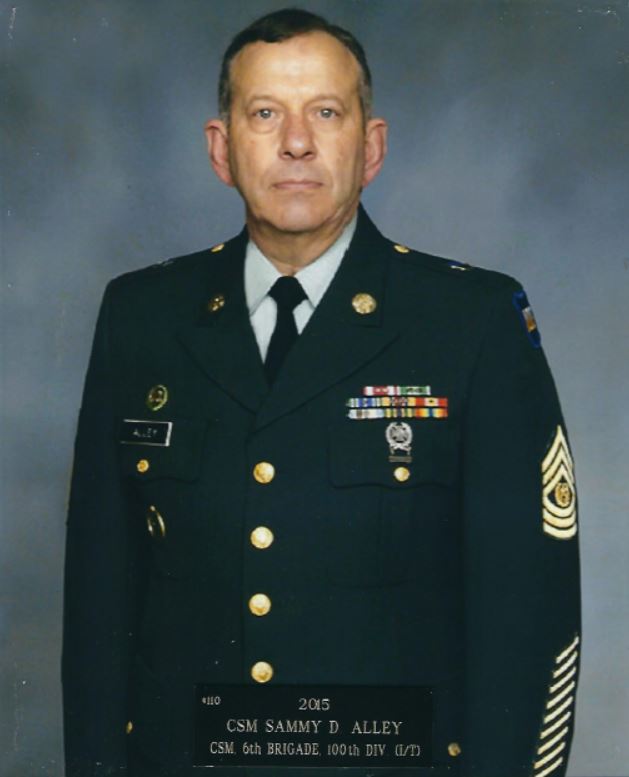
Sammy D. Alley
CSM Sammy D. Alley, enlisted in the Army and served on Active Duty from 1970 through 1972, and attending Basic Training and Air Defense Training at Fort Knox, KY, with subsequent assignments to Fort Carson, CO, and Fort Riley, KS. Upon release from Active Duty he was assigned to USAR Control Group. In 1976, CSM Alley joined Company D, 2-399th, 1st Brigade, 100th Division in Burksville, KY, and graduated Drill Sergeant School. He then served as Drill Sergeant and Senior Drill Sergeant of D/2-399 until being mobilized in January 1991 for Operation Desert Storm, where he served as Senior Drill Sergeant. Upon demobilization, he was selected as First Sergeant of E/2-399, serving until July 1994. CSM Alley’s next assignment was Operations NCO at Division HQ until his promotion to SGM in 1996. In May 1996, CSM Alley was assigned as Acting Battalion CSM for 9th Battalion, 6th Brigade (PDE), and board selected for the position, serving from October 1997 until September 2001. He served as Brigade CSM of 6th Bde (PDE), Louisville, KY, in February 2004 until April 2006, followed by SGM assignments to the Division G5 and Division G1. In February 2007, CSM Alley’s final assignment returned him to Richmond KY, as the Battalion CSM for the reorganized 2-397, 3rd Brigade, 98th Division (IT), until retirement in December 2010.
CSM Alley is a Lifetime Member of the Association of the Century.
CSM Alley and his wife Vicky, currently reside in Brydstown, Tennessee.
Decorations and Awards Include:
Meritorious Service Medal with Three Oak Leaf Clusters
Army Commendation Medal with Two Oak Leaf Clusters
Army Achievement Medal with Two Oak Leaf Clusters
Army Reserve Component Achievement Medal w/ Five Oak Leaf Clusters
National Defense Service Medal with Bronze Star
Armed Forces Reserve Medal with M device and Hourglass
Army Service Ribbon
2015 – Inducted into the Corridor of the Century, Inductee # 110
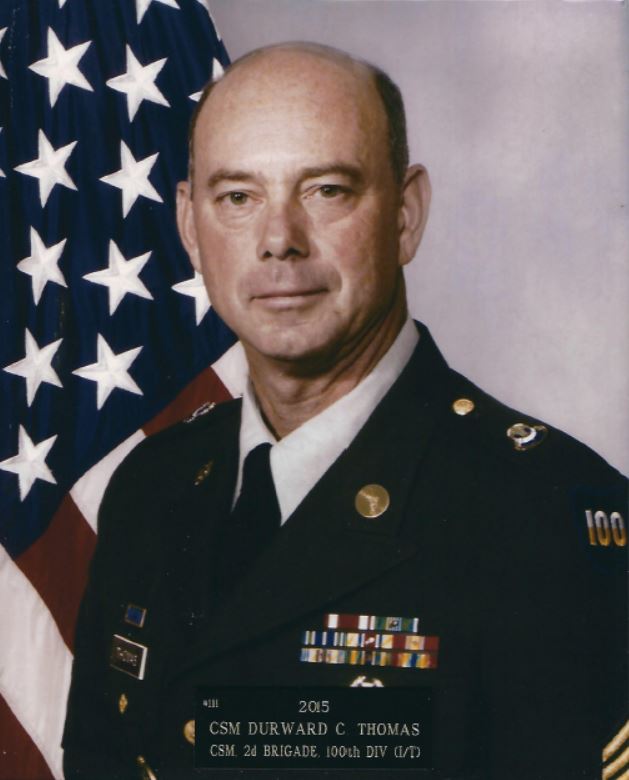
Durward C. Thomas
CSM Durward C. Thomas, entered the Army Reserve in December 1969, and attended Infantry Basic Combat Training and Advanced Individual Training at Fort Benning, Georgia, in June 1970. Upon completion of Active Duty Basic Training, he returned to Company C, 2-398th, Madisonville, KY as Company Clerk. In August 1972, CSM Thomas attended and graduated Drill Sergeant School, then served as Drill Sergeant and Senior Drill Sergeant of C/2-398 until appointed as Acting First Sergeant of 2-398 in July 1990. CSM Thomas was selected to an ADSW tour as 2nd Brigade Assistant Operations Sergeant from August 1991 to May 1992, returning as Senior Drill Sergeant. CSM Thomas was selected as First Sergeant in October 1995 for D/3-398 in Paducah, and also served as First Sergeant of E/2-398, until February 1998. He served as Brigade Operations Sergeant until selected to attend Sergeant’s Major Academy. CSM Thomas attended and graduated US Army Sergeant’s Major Academy in 2001, and was selected as CSM of 1-399, Owensboro, KY, in August 2001, and then CSM of 2nd Brigade in Owensboro in December 2002.
CSM Thomas was mobilized in November 2004, serving as AC/RC Liaison Officer, Mobilization Integrator, Fort Benning, Georgia, until May 2007.
CSM Thomas transferred to the IRR and retired in August 2007 with 37 years of Army service (34 yrs-100th Division; 3 yrs-Active/Other reserve units). His service reflects professional competence, high standards, and mission accomplishment. CSM Thomas served on Promotion Boards, Retention Boards, Unit Safety Councils, and Family Support Councils while assigned to the 100th Division. He continues to maintain contact with past and present members of the Division. He is a Lifetime Member of the Association of the Century.
CSM Thomas, who is retired, currently resides with his wife in Central City, Kentucky.
Decorations and Awards Include:
Legion of Merit
Meritorious Service Medal
Army Commendation Medal with Three Oak Leaf Clusters
Army Achievement Award with Three Oak Leaf Clusters
Army Reserve Component Achievement Medal w/ six Oak Leaf Clusters
National Defense Service Medal
Armed Forces Reserve Medal
Army Service Ribbon
2015 – Inducted into the Corridor of the Century, Inductee # 111
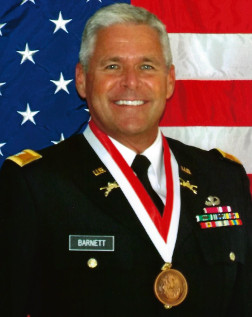
David M. Barnett
COL David M. Barnett, first joined the 100th Division (IT), in April of 1983 as a Cadet serving as part of the Simultaneous Membership Program (SMP), that allowed for Troop Program Membership and training while completing required training in the University of Kentucky’s ROTC program. COL Barnett, was commissioned a Second Lieutenant, Armor, through the University of Kentucky ROTC program in May 1985. He began his service to the United States Army and the 100th Division as a Committee Chief for the 100th Division (IT) Committee Group, Headquarters, 100th Division (IT), Louisville, Kentucky.
Following a reorganization in 1988, COL Barnett served as a Platoon Leader and Company Executive Officer for 2/100, 4th Brigade, 100th Division (IT), Fort Knox, KY., being mobilized in January 1991, in response to the Presidential call up in support of Operation Desert Storm. Upon release from active duty COL Barnett continued to serve with the 100th Division (IT) at Fort Knox, KY through several additional reorganization and re-designations, resulting in his selection and service as, Company Commander, Co. B, 2/100, 7th Brigade, 100th Division. COL Barnett was selected and served two additional Company Command tours for the 7th Brigade, including Commander, Co. A, 2-399, 7th Brigade, 100th Division and Commander HHC, REC BN. Additionally, upon promotion to the rank of Major, he was selected as the S-3, 7th Brigade, 100th Division (IT).
COL Barnett next returned to the 100th Division Headquarters, Louisville, KY where he briefly served as the Deputy Branch Chief, Force Development/Force Structure as part of the Division’s G5 section. This tenure was cut short due to COL Barnett’s promotion to Lieutenant Colonel and his selection as Battalion Commander, 1-399, 100th Division, Richmond, KY. COL Barnett served 24 months as the Commander of 1-399, before another reorganization and a second Battalion Command, assignment, assuming Command of 4/100, Chemical, 100th Division, Harvey, IL.
In February 2006, COL Barnett began 10 years of service to the 100th Division as a dual status Military Technician, being selected as the Division’s G3/5/7, Supervisory Operations and Training Officer. Upon successful completion of his second Battalion Command tenure, COL Barnett, returned to the Division Headquarters, as the Deputy Division G3/7, where he was directly responsible for the planning and oversight of the BRAC directed move of the Headquarters, 100th Division (OS), to Fort Knox, KY in August of 2011. COL Barnett was selected and promoted to full Colonel in September 2011 and served the next three years as the 100th Division (OS), Division G357, providing leadership and oversight to the Division’s continued efforts towards achieving One Army School System (OASS) compliance as part of the overall Generating Force transformation. COL Barnett’s culminated his career and final year of military service, as the Deputy Division Commander, 102d Division (MS), Fort Leonard Wood, MO. COL Barnett retired 1 June 2015, following 30 years of commissioned service and a total of nearly 32 years of service in the USAR, with 31 of those years serving in the 100th Division. COL Barnett is a Life Member of the Association of the Century.
Decorations and Awards Include:
Legion of Merit
Meritorious Service Medal (2 OLC)
Army Commendation Medal (4 OLC)
Army Achievement Medal (4 OLC)
National Defense Service Ribbon with Star Device
Parachutist Badge
2016 – Inducted into the Corridor of the Century, Inductee # 112
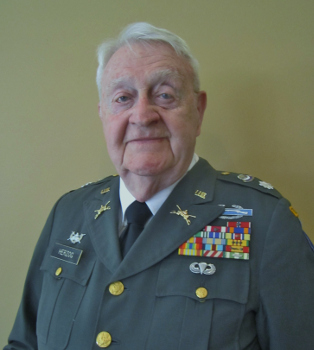
Lawrence A. Herzog
LTC Lawrence A. Herzog was commissioned a Second Lieutenant, Armor, through the ROTC program at the University of Connecticut on 11 June 1961.
After completion of the Armor Officer Basic Course and Ranger and Airborne Schools, he was assigned to 69th Armor, 25th Division, serving as Tank Platoon Leader, Company XO, Battalion S1, and Company Commander. He then attended the Armor Officer Career Course, followed by his first tour in Vietnam as an Advisor to the Vietnamese. Upon return to CONUS he became an instructor in the ROTC Department at Yale University. As the senior officer, closed the Department as the Professor of Military Science. He then returned to Vietnam as an Advisor to a Vietnamese Cavalry Regiment. Following that tour he returned to Fort Knox and served as the XO of the 2/6th Cavalry, becoming a Test Officer for the M60A3 tank.
Upon release from Active Duty in November 1975, LTC Herzog joined the 100th Division MTC as the Cavalry Team Chief where he and his team developed and conducted training and evaluation exercises for Reserve and National Guard Battalion, Squadron, and Regimental units. After a number of years as the Cavalry Team Chief he was selected as Deputy Chief of the Combat Division where he advised the Division Chief on exercise personnel, team exercises, and defining exercise parameters. LTC Herzog is a graduate of the Command and General Staff College and is a Life Member of the Association of the Century.
While serving as a Reserve Officer with the 100th Division, LTC Herzog entered civil service with the Department of Training in the Armor School at Fort Knox, KY. As an equipment specialist, his office prepared requirements documents for fielding training aids, devices, and simulations to support the fielding of the M1 Abrams Tank and the M2/M3 Bradley Fighting vehicles.
Decorations and Awards include:
Bronze Star Medal with 1 OLC
Meritorious Service Medal with 1 OLC
Air Medal Army Commendation Medal
Army Achievement Medal
Army Reserve Components Achievement Medal
National Defense Service Medal
Vietnam Service Medal with 3 stars
Armed Forces Reserve Medal
Army Service Ribbon
Army Overseas Service Ribbon
RVN Gallantry Cross Medal with Gold Pin
RVN Armed Forces Honor Medal
Vietnam Campaign Medal
Combat Infantry Badge
Ranger Tab
Parachutist Badge
Vietnamese Armor Badge
Order of St. George – Silver Medallion
2016 – Inducted into the Corridor of the Century – Inductee # 113
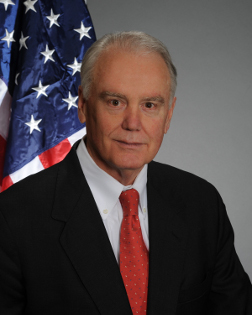
George K. Kapp
LTC George K. Kapp was commissioned a Second Lieutenant, Field Artillery, through the ROTC program at the University of Kentucky on 8 May 1971.
After completion of the Field Artillery Basic Officer Course at Fort Sill, Oklahoma, he was assigned in April 1972 to the Transportation Company, 100th Support Battalion, 100th Division (TNG), as Executive Officer. From April 1972 until May 1989, LTC Kapp served in various staff and command positions in the 100th Division (TNG): Company Commander, HHD, 100th Support Battalion; Ammo Officer, Company A, 100th S&S Battalion; Operations Officer, Company A, 100th S&S Battalion; S-4, 100th S&S Battalion; Company Commander, Company A, Logistics Group; and Chief, Weapons & Equipment Pool, Logistics Group. He transferred to Armor Branch in February 1985. A meaningful experience for LTC Kapp was the Transportation Company’s achievement of receiving the Major General Dillman A. Rash Award for Excellence for two consecutive years.
In June 1989, LTC Kapp was reassigned to 100th MTC, 100th Div (TNG) as Finance & Accounting Officer and in October 1989 as Budget Officer. During this time, LTC Kapp developed a financial tracking system that allowed the MTC to establish complete control over its exercise related expenditures; significantly improved planning and financial accountability. In July 1992, LTC Kapp accepted the position of Chief, Resource Management Branch, 100th MTC, 87th USA MAC.
LTC Kapp came back to the 100th Division (IT) in August 1993 accepting the position of Program Management Officer, HHC. He immediately enrolled in and completed the DCSRM/DCSCOMPT Financial Management Course at Fort McCoy, Wisconsin. He was responsible for the Command Operating Budget (COB), budget fund control, accounting and management control studies. In these difficult years of downsizing, reorganizing and transition units, his contribution was a key factor in the success of the Division. This was LTC Kapp’s final position in the 100th Division retiring in May, 1998; this completed 27 years of Army service, 26 years with the 100th Division. LTC Kapp is a graduate of the Field Artillery Basic Officer Course and the Adjutant General, Armor, Finance and Quartermaster Advanced Officer Courses; and he completed the U.S. Army Command and General Staff College in 1993.
LTC Kapp is a Life Member of the Association of the Century and the Reserve Officer’s Association since 1972. LTC Kapp serves on the Board of Directors and as Treasurer of the Association of the Century since November 2008. He suggested and facilitated the use of the Community Foundation of Louisville for the administration and investment of the MG Benjamin J. Butler “Century Division” Scholarship Fund.
LTC Kapp is a Certified Public Accountant and the Managing Director of Allston Advisory Group, a Merger & Acquisition Firm; he also serves as Chairman of the Board of King Southern Bank. He does volunteer work as Chairman of the Board of Hosparus, Inc., one of the largest non-profit Hospice’s organizations in the U.S. He and his wife Marguerite reside in Louisville, Kentucky and have four adult children and one granddaughter.
Decorations and Awards include:
Meritorious Service Medal
Army Commendation Medal
Army Reserve Components Achievement Medal with 5 Oak Leaf Clusters
National Defense Service Medal
Armed Forces Reserve Medal with 2 Hourglass Devices
Army Service Ribbon
2016 – Inducted into the Corridor of the Century, Inductee # 114
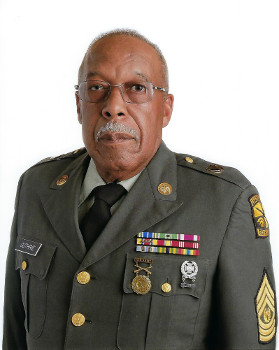
Harrison H. Guthrie
CSM Harrison H. Guthrie was born in Shelby County, KY, in 1945. He joined the 100 th Division Army Reserve in Shelbyville, KY in 1963, at the age of 18. He served six months of active duty attending Basic Training at Fort Knox and Advanced Individual Training at Fort Jackson. He returned to the 100 th Regiment, Company E, serving as supply clerk. In 1975, CSM Guthrie was assigned to the 100 th Division 399 th Committee Group as an 11B, Infantry instructor until promoted in 1978 to the 100 th Division HQ Company as First Sergeant.
This is where he further developed his personal leadership traits while directing the multifunctional staff requirements of a Headquarters Command. In 1982 he was promoted to CSM of the 100 th Supply and Service Battalion. In 1984, the S&S Battalion was re-designated as the Logistics Group and he continued serving as CSM. In 1988 he was assigned as CSM of the 100 th Division Maneuver Training Command, and served as CSM until 1990.
IN 1990, CSM Guthrie was assigned as CSM of the Leadership Academy at Fort Knox. He had the responsibility of supervising the JROTC and ROTC programs run by the Reserve and Active Army NCOs. He retired from this assignment and the Army in 1996.
CSM Guthrie is a member of Chapter 89, Disabled American Veterans, and Post #1 of the American Veterans. He is a Lifetime Member of the Association of the Century. CSM Guthrie is retired, and currently resides with his wife Mattie Louise in Louisville, Kentucky.
Decorations and Awards Include:
Meritorious Service Medal
Army Commendation Medal Oak Leaf Cluster
Army Achievement Medal
Good Conduct Medal
Army Reserve Component Achievement Medal w/ four Oak Leaf Clusters
National Defense Service Medal
Armed Forces Reserve Medal
Army Service Ribbon with 2 Hourglass Devices
Expert Infantry Badge
Sharpshooter Badge
Bronze Grand Aggr Badge
All Army Rifleman
2016 – Inducted into the Corridor of the Century, Inductee # 115
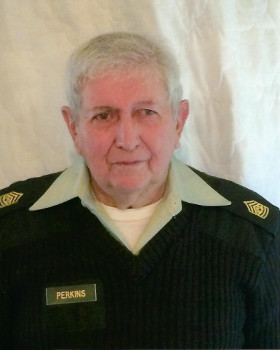
Jack A. Perkins
CSM Jack A. Perkins enlisted in the US Army on 11 August 1960 after completing one year of college at Campbellsville University. He completed Basic Training and Specialist training as a Radio Operator at Fort Knox, KY, and in December 1960 was assigned to 36th Artillery Group, Giessen, Germany. In May 1963, CSM joined Company C, 2nd Battalion, 397th Regiment, 100th Division, in Campbellsville, KY. When the Drill Sergeants were authorized in the 100th Division in 1966, CSM Perkins enrolled in Class 67-2, First US Army NCO Academy Drill Sergeant School, at Fort Knox, KY. He graduated in October 1966 as one of the first two qualified drill sergeants in the 100th Division.
CSM Perkins used his new skills and additional duty time to instruct 100th Division Drill Sergeant students in Phase 1, three weekends each month from November 1966 to May 1967 at Hopkinsville, Bowling Green, and Lebanon, KY. CSM Perkins was promoted to Sergeant First Class in December 1966, and served as an instructor for Phase 2, Active Duty, at Fort Jackson, SC, at Annual Training 1969. He was selected as the Battalion Operations Sergeant of 2nd Battalion, 397th Regiment, 1st Brigade, 100th Division, Lebanon, KY, in June 1970, and promoted to Master Sergeant in October 1972. He continued his outstanding performance while directing the multifunctional staff requirements of an Army Reserve Training Battalion that was selected to conduct weapons qualification training for 93 Cadets from the University of Kentucky, and Basic Rifle Marksmanship qualification at Fort Knox, KY. In 1973, the Battalion was selected to conduct an Escape and Evasion field exercise for Eastern Kentucky University ROTC students.
In September 1974, CSM Perkins was assigned as First Sergeant of Company C, 2-397th Regt. In Campbellsville, KY, and took that unit to Annual Training each year to Fort Knox, KY. He was selected as CSM of 2-397th Regiment in May 1978, and promoted to Command Sergeant Major in October 1979. CSM Perkins continued outstanding performance earned him the assignment as CSM of 1st Brigade, 100th Division, and served as CSM until September 1986, when he was selected to serve as an AGR Operations Sergeant for 2-397th Regiment in Lebanon, and 2-399th Regiment in Bowling Green, until he retired in April 1994.
He currently resides with his wife Irene in Campbellsville, Kentucky.
Decoration and Awards include:
Meritorious Service Medal
Army Commendation Medal
Good Conduct Medal
Army Reserve Component Achievement Medal w/ 5 Oak Leaf Clusters,
National Defense Service Medal w/Gold Star,
Armed Forces Reserve Medal w/2 Hourglass Devices,
Army Service Ribbon, Drill Sergeant Badge,
Advanced NCO Leadership Badge
2016 – Inducted into the Corridor of the Century, Inductee # 116
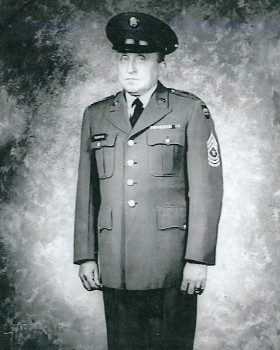
Manuel H. Thornton
CSM Manuel H. Thornton entered the Army in January 1943. Upon completion of Active Duty Basic Training, he was assigned to 1st Battalion, 35th Infantry Regiment, serving in four campaigns during the Liberation of the Philippines: Luzon, Southern Philippines, Battle of Visayas, and Battle of Mindanao. After returning to the US, CSM Thornton elected to separate and transfer from Regular Army to the Inactive Reserve, as a Master Sergeant. In the late 1940’s, CSM Thornton began drilling as a reserve soldier for points only.
CSM Thornton entered the 100th Division in 1954 as a Master Sergeant, serving with 2nd Battalion, 100th Regiment, 4th Brigade. In 1961 he was called to active duty at Fort Chafee, AR. He was further assigned as the Sergeant Major of Company’s D and E of the 100th Regiment. In the span of a year, these units housed, fed, clothed over 1000 soldiers being trained as cooks. During training cycles, both Companies were “Best Company in the Regiment” several times. After Demobilization, CSM Thornton served in positions as First Sergeant, Sergeant Major, and was the Command Sergeant Major when the 1st Battalion, 400th Regiment, was re-designated as the 1st Squadron, 302nd Cavalry, 3rd Brigade in 1973. CSM Thornton retired August 31, 1980, having served over 35 years of military service.
CSM Thornton is most remembered as a Mentor to many of the young enlisted soldier and officers who passed through his unit. His leadership and military knowledge was respected by subordinates and his peers. CSM Thornton believed in being proactive in the unit and keeping the unit leadership involved. In 1971, CSM Thornton was a major coordinator for the reorganization of the unit to a Field/Radio Communication Committee. In 1973, he was involved in the reorganization of the unit to an Armor Cavalry Reconnaissance Training Squadron. CSM Thornton placed emphasis on the career path the Drill Sergeant Program offered, the importance of the NCO Professional Development Program, Duty MOS Qualification, and Retention.
In civilian life, CSM Thornton served more than 25 years as an Army Reserve Technician for the 100th Division units in Frankfort, KY. He was also involved in the Boy Scouts of America, the Masonic Organization of Kentucky, and was a LOYAL fan of the University of Kentucky.
His decorations and awards include:
Meritorious Service Medal with 1 OLC
Army Good Conduct Medal
Army Reserve Component Achievement Medal
American Campaign Medal
Asiatic Pacific Campaign Medal with 4 Bronze Stars
World War II Victory Medal
National Defense Service Medal
Armed Forces Reserve Medal with 2 Bronze Hour Glasses
Philippine Liberation Medal
2016 – Inducted into the Corridor of the Century, Inductee # 117
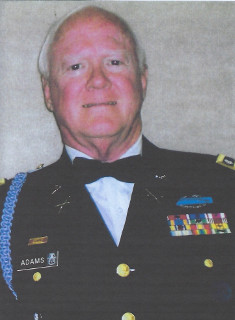
John A. Adams III
LTC John Amos Adams III, born 1945 in Washington, D.C., a former resident of Montana and a 1967 Montana State University Graduate, earned his BS Commerce Degree, Major in Accounting. He enlisted for active military, U.S. Army, February, 1968, was promoted to SP5 (E5), and was commissioned Second Lieutenant (02), U.S. Army Reserve, Infantry at Ft. Benning, GA (OCS), April 1969. After active duty, including service in Vietnam, on 1 January 1975, Adams began his 13 year assignment and promotions in 100th Division (Tng), Maneuver Command (MTC), including as Commanding Officer, Headquarters Company of 4th BDE, Administration/Policy Officer Supply & Service Team, and Chief Umpire/Controller Transportation II and Infantry Teams. He was promoted to Lieutenant Colonel (LTC, 05), 1986, and assigned as Leader of the MTC Infantry Exercise Team, through 1 FEB 1988. LTC Adams was assigned as CAS3 Instructor, 3283rd USARF School, Chamblee, GA, 1988, and 3388th USARF School, Tampa, FL, 1990. LTC Adams was appointed Adjunct Faculty Member, School of Corresponding Studies, C&GS, 1995.
LTC Admas led training in MTC’s largest BN and BDE level ARTEP Exercises and with opposition force defense infantry training teams. LTC Adams was recognized among his peers and superiors for his effective mentoring skills, active subordinate development, and aggressive training leadership, consistently resulting in high ratings for 100th Division MTC. He entered Retired Reserve Infantry, USAR in 1997, receiving the Certificate of Appreciation from U.S. Army Chief Army Reserve.
LTC Adams was a Life Member of the Association of the Century (AOC) and Purple Heart Association, attending every AOC Annual Reunion in recent years. He is survived by his wife (Maggie) and a son, Samuel.
Awards and Decortations include the following:
Bronze Star Medal (w/OLC), Purple Heart, Meritorious Service Medal, (w/OLC), Air Medal, Joint Service Commendation Medal, Army Commendation Medal (w/OLCs), Good Conduct Medal, Army Reserve Components Achievement Medal (w/OLCs), National Defense Service Medal, Vietnam Service Medal (w/Device), Army Achievement Medal, Armed Forces Reserve Medal, Army Service Ribbon, Republic of Vietnam Campaign Medal (w/60 Device), and the Combat Infranty Badge.
2017 – Inducted into the Corridor of the Century, Inductee #118.
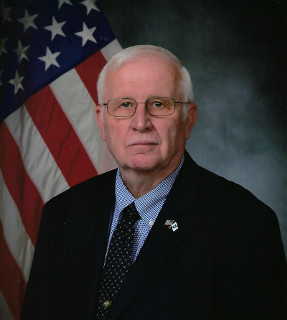
Richard Wayne Gerding
MSG Wayne Gerding entered military service in June 1967, with his enlistment in the United States Air Force. He graduated from Advanced Technical School as an Air Frame Repairman. His duty stations included Dover AFB, Delaware, Vung Tau and Cam Ranh AFB, Republic of Vietnam and Eglin AFB, Florida. He was discharged as a SSG/E5 in July of 1974 after serving over 7 years and 1 month.
MSG Gerding enlisted in the Army Reserve Program in Reading, PA as a Tank Turret Mechanic with Company A, 6th BN, 68th Armor, 157th SIB (M). He transitioned to a 19E Armor Crewman/Tank Driver. He was promoted to E7 and became a Tank Commander and Platoon Sergeant. In June of 1983 he entered into the AGR program as the Company Full Time Training NCO/Platoon Sergeant. MSG Gerding graduated from the US Army Armor School M60A1 Master Gunner Course in January of 1985 and was detailed as the Battalion Master Gunner. MSG Gerding was promoted to MASTER SERGEANT in November of 1986 and was assigned to the 1st Squadron 302nd Cavalry, 3d BDE, 100th Division, Frankfort, KY in January of 1987 as the first AGR Squadron Operations Sergeant. MSG Gerding was instrumental in the Squadron’s Transition to the M3 Bradley. MSG Gerding mobilized with the 1-302/3/100 Division as part of Task Force 100 during operation Desert Storm (22 January – 18 March 1991). His experience and training allowed the Squadron’s 19D Drill Sergeants and Track Commanders to augment 5-15 Cavalry, 1st ATB, training mobilized Soldiers on the M3 Bradley. MSG Gerding graduated from the United States Army Sergeants Major Academy in July of 1991. MSG Gerding was reassigned as the Training NCO to 1st Battalion 400th Regiment, 1st BDE, 100th Division in Lexington, KY. The unit was shortly deactivated, and MSG Gerding was detailed to DCSIM, 100th Division Headquarters, Louisville, KY. MSG Gerding retired from the AGR program on August 31st 1996, with 22 1/2 years of Total Active Federal Service and over 26 years total military service. Mr. Gerding has served the 100th Division as an Automation Support Contractor for 20 plus years.
MSG Gerding is a Charter Member and past of the Century Division Order of the Spur, and currently serving as President; he is also a Life Member of the AOC. MSG Gerding is a hot air balloon enthusiast and is Crew Chief qualified. He holds the Master Crew Chief award from the Balloon Federation of America.
Decorations and Awards include:
Meritorious Service Medal (5OLC), Air Force Commendation Medal, Army Commendation Medal (1OLC), Army Achievement Medal (1OLC), Army Good Conduct Medal, Air Force Good Conduct Medal, Air Force Longevity Service Medal, National Defense Service Medal, Vietnam Service Medal, Vietnam Campaign Medal, NCODP (4) Medal, M16 Expert Marksmanship Badge.
2017 – Inducted into the Corridor of the Century, Inductee #119.
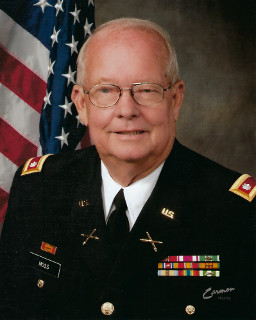
Ronald E. Moss
LTC Ronald E. Moss, a Distinguished Military Graduate at Murray State University, was commissioned an 2LT of Field Artillery in May 1968. Following his graduation and commissioning, 2LT Moss attended the Field Artillery Office Basic Course followed by the Field Artillery Advacned Course at Fot Sill, Oklahoma in 1968 and 1969. During this time Moss was promoted to 1LT in 1969 and served as an Artillery Instructor at Ft. Sill. 1LT Moss served a year in Vietnam as an Artillery Battalion Executive Officer and Battalion Commander from 1969 to 1970.
Following his tour in Vietnam, Moss left Active Duty and joined the 100th Division as a Training Officer in Bravo Company, 3d Bn, 399th Regt, 2d Bed, 100th Division in Hopkinsville, KY. 1LT Moss was promoted to CPT in 1975 and served in the following positions in the 100th DIV 2nd Brigade: Company Commander of Delta Company, 3d Bn, 399th Regt, 2d Bede and Bn S-1, HQs, 3d Bn, 399th Regt, 2d Bde in Hopkinsville. Moss then transferred to the 2047th USAR School in Louisville, KY as the Assistand Director of the MOS Division. CPT Moss was promoted to Major in 1983 and served as an UMP/Controller in the 100th Division Maneuver Training Command (MTC) in Louisville, KY. Moss then returned to the 2nd Bde HQs in Owensboror, KY where he served as the Brigade S-4 before finishing up his career as Battalion Executive Officer of HHD, 3d Bn, 399th Regt, 2 Bde in Hopkinsville, KY.
Moss graduated from the Command and General Staff College as an Honor Graduate in 1984, and was promoted to LTC in July of 1990. LTC Moss is a past Presidend and Life Member of the AOC and serves on the Board of Directors. He is also a life member of the KY Department of the ROA and the Disabled Veterans. He is a member of the Veteran’s of Foreign Wars, MOAA and the KY-TN Chapter of the Hopkinsville Rotary Club.
LTC Moss lives in Bowling Green with is wife Glenda. Together they have four married children, Monica, John, Jennifer and Daniel, along with six grandchildren.
Decorations and Awards include: Bronze Star w/V Device, Meritoriouse Service Medal, Army Commendation Medal (2OLC), Army Acheivement Medal (4OLC), National Defense Service Medal, Overseas Service Ribbon, Armed Forces Reserve Medal, Vietnam Campaing Ribbon (2 OLC)
2017 – Inducted into the Corridor of the Century, Inductee #120
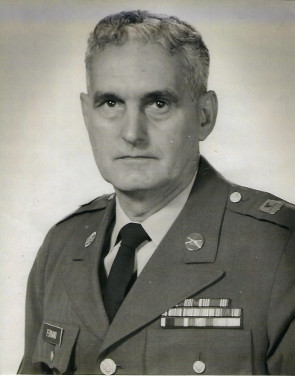
Michael A. ‘Tex’ Fernand
Command Sergeant Major Michael Anthony Fernand enlisted in the 100th Division in 1946 in Lexington, Kentucky after spending four years on active duty during WWII. CSM Fernand rose through the ranks and was promoted to SGM in 1961. He was called to active duty with the 100th Division at Ft. Chaffee, Arkansas in 1961. With over 34 years in the 100th Division he held many positions including several years as the 3rd Battalion Command Sergeant Major and 3rd Brigade Command Sergeant Major. He later became Command Sergeant Major of the 100th Division under MG Charles Beach, Jr. in 1978, where he served until his retirement in May 1980.
CSM Fernand’s standards of discipline, military courtesy, and exceptional leadership ability helped prepare his soldiers for the rigors of annual training. During CSM Fernand’s tenure as 3rd Brigade Command Sergeant Major the 100th Division Mission changed from infantry to armor and the 3rd Brigade led the transition to armor for the rest of the division. CSM Fernand’s leadership was again called to the forefront as Division CSM in 1978 when the 100th Division, under the leadership of MG Beach was selected to be the first Army Reserve Unit to be equipped with its own M-1 tanks. It was also the only division with the mission of conducting training on the M-1 Abrams tank and the M-3 Bradley Cavalry Vehicle.
CSM was born in 1920 in San Antonio, Texas and was one of seven children. He was married to Bernice Ward and had three children and six grandchildren. His oldest son Ricky Fernand is a disabled Vietnam veteran and two of his grandsons are combat veterans. CSM Fernand passed away at the age of 94 leaving a legacy for his family to be proud.
Decorations and Awards Include:
American Theater Campaign Medal
EAME Campaign Medal with Four Bronze Stars
Good Conduct Medal
WWII Victory Medal
Army Reserve Medal
National Defense Service Medal
Army Commendation Medal with Oak Leaf Cluster
Meritorious Service Medal
2018 – Inducted into the Corridor of the Century, Inductee # 121
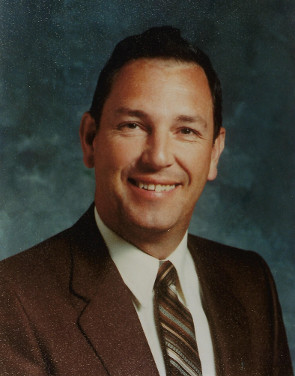
Roland C. Haun
COL Roland C. Haun, enlisted in the Tennessee National Guard in August 1961. After completion of basic training, he completed the Officer Candidate School and was commissioned a 2LT of Armor in July 1964. He served as a General’s Aide in 1964-1965, and an Armor Platoon Leader from 1965-1966 in the TN National Guard. In 1966 he transferred to the 100th Division (Tng) as an Infantry Company Executive Officer and was Company Commander from 1968 to 1974.
COL Haun was an Armor Training Officer in MTC in 1976 and became the Armor Training Officer in the 100th DIV G3. COL Haun began Battalion Staff assignments in 1977, and quickly became Battalion Commander in 1984. Following his Battalion Command tenure, COL Haun went back to the MTC as the Chief, Plans, Operations and Training Branch, and in 1987 became the Executive Officer for the MTC. COL Haun was noted as most successful while preparing the MTC for the Inspector General annual inspection, passing the inspection for the first time in MTC history! COL Haun continued his career in 1987 as an instructor in the 2074th USARF School in Lexington, KY, culminating as Commandant of the 2074 USARF School in 1992, and a following assignment as Commandant of the USAR School in Nashville, TN in 1995. COL Haun transferred to the Retired Reserve in July1998.
COL Haun’s civilian career was spent in public education, teaching from high school and Military Academies. He was a middle school principal, and in 1973 received his doctorate in Education from UK. He served as Superintendant of Carrol County, and Fort Knox Community Schools, from 1974 to 1994.
COL Haun is a graduate of the Basic and Advanced Infantry Officer Courses at Ft. Benning GA, and a graduate of the Command and General Staff College. COL Haun is a Life Member of the Association Of the Century and the Reserve Officers Association. COL Haun lives in Cecilia, KY with his wife Mary Tom. They have three sons and six grandchildren.
Decorations and Awards Include:
Meritorious Service Medal
Army Commendation Medal (2 OLC)
Army Reserve Components Achievement Medal (3 OLC)
National Defense Service Medal
Armed Forces Reserve Medal (2 Hourglass Devices)
Army Service Ribbon (2 OLC)
2018 – Inducted into the Corridor of the Century, Inductee # 122
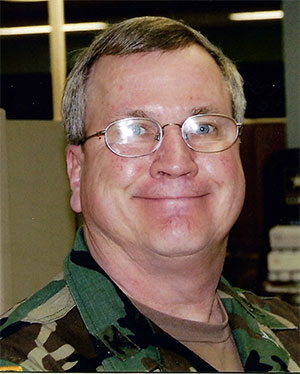
Robert A. Cobb
COL Robert A.Cobb, began his Army career as an enlisted soldier with the 100th Division in 1971. He quickly achieved the rank of Sergeant First Class before receiving a Direct Appointment in 1979 to First Lieutenant, in the Branch of Adjutant General. He completed of the AG Officer Basic Course and served as the OIC for the records section of the Division G1. In 1985 he Branch transferred to Armor. COL Cobb subsequently served as Company Commander, S-3 Operations Officer, and later as Battalion Commander for 2-399th Regiment in Bowling Green, KY.
COL Cobb was specifically instrumental as the Operations Officer for 2-399th, 7th Brigade in the preparation and training for tank crewmen for the M1A1 and Bradley fighting vehicle. The battalion later trained ROTC cadets in the Basic and Advanced Courses. COL Cobb was hugely responsible for the successful conduct of the ROTC training mission. His final assignment was the Deputy Chief of Staff, G1, where he assisted in the preparation for the Communities of Excellence Award received by the 100th Division. COL Cobb retired in 2006, after 35 years of faithful service. His service reflects professional competence, high standards, and many years of successful mission accomplishment.
COL Cobb has received numerous awards, including the Meritorious Service Medal(2OLC), Army Commendation Medal(1OLC), Army Achievement Medal(6OLC), Good Conduct Medal, Army Service Ribbon, National Defense Service Medal, and the Armed Forces Reserve Medal.
COL Cobb is an active member of the Association of the Century, a member of the Board of Directors and currently 1st Vice President, and responsible for the activities of the Supply Room, generating funds for the AOC. He is a Lifetime Member of the Association, and a supporting member of the Franklin Club. He volunteers time supporting the 100th Division museum, and he assists with membership surveys and soliciting membership contact information and feedback.
COL Cobb resides in Bowling Green KY with his wife Mary. COL Cobb is recently retired from his position as advisor to PHD candidates at Western Kentucky University, after serving the university for 44 years.
2019 – Inducted into the Corridor of the Century, Inductee # 123
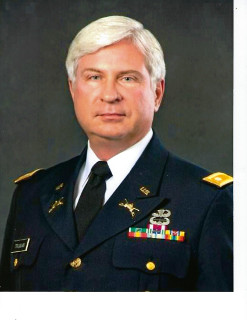
Karl N. Truman
Inductee 124 is LTC Karl N. Truman. Karl began his service in the 100th Division in 1981 as an SMP Cadet while enrolled in Army ROTC at the University of Kentucky and served with 3rd Brigade HQ. Upon commissioning as 2LT, he was assigned to 2-302 in Georgetown KY. LTC Truman served with Task Force 100, as HHC Commander, served as a CAS3 Instructor, and as Deputy Chief of Staff for the 100th Division, and retired in 2009 with 28 years of service. LTC Truman is a Life Member of the AOC and a Life Member of the ROA. He is also a contributing member of the Franklin Club, and a contributing sponsor of the Century Sentinel Newsletter.
2020 – Inducted into the Corridor of the Century Inductee # 124
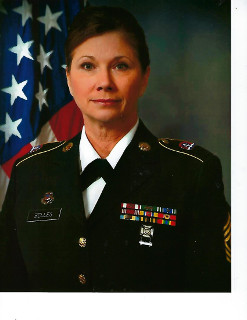
Teresa Belles Bolton
Inductee 125 is CSM Teresa Belles Bolton. CSM Bolton enlisted in 1986 and completed Basic Training at Ft. Jackson SC. She served in Division HHC admin positions and Retention positions. CSM Bolton completed Drill Sergeant School and served as Drill Sergeant and Senior Drill Sergeant with the 100th Reception Battalion. She was the first female Army Reserve and TRADOC Drill Sergeant of the Year in 1997. CSM Bolton completed her service with the 100th Division as CSM, 97th ILE Brigade in Ft Sheridan IL, and retired in 2015 with 29 years of service. CSM Bolton is a Life Member of the AOC.
2020 – Inducted into the Corridor of the Century Inductee # 125
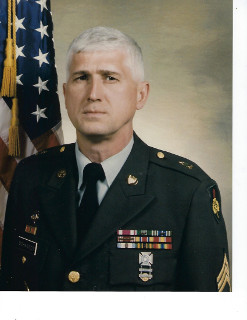
George W. Bohannon
Inductee 126 is MSG George W. Bohannon. MSG Bohannon enlisted in 1970 and served many positions in the Frankfort and Georgetown units. He completed Drill Sergeant School in 1973, serving as Drill Sergeant and Senior Drill Sergeant with 1-302d in Frankfort. In 1976, he was assigned as a Recruiter with US Army Recruiting Command, returning in 1980 as Senior Drill Sergeant with 1-302 in Frankfort. MSG Bohannon also served as a Military Technician with 302d CAV, 3rd Brigade. His final assignment with the 100th Division was as Operations Sergeant, 3rd Brigade. MSG Bohannon concluded his military career with the Regional Support Group. Inspector General at the 300th Military Police Command in Detroit MI, retiring in 1998 with 28 years of service. MSG Bohannon is a Life Member of the AOC, and continues to serve as Historian for 1-302 in Frankfort.
2020 – Inducted into the Corridor of the Century Inductee # 126
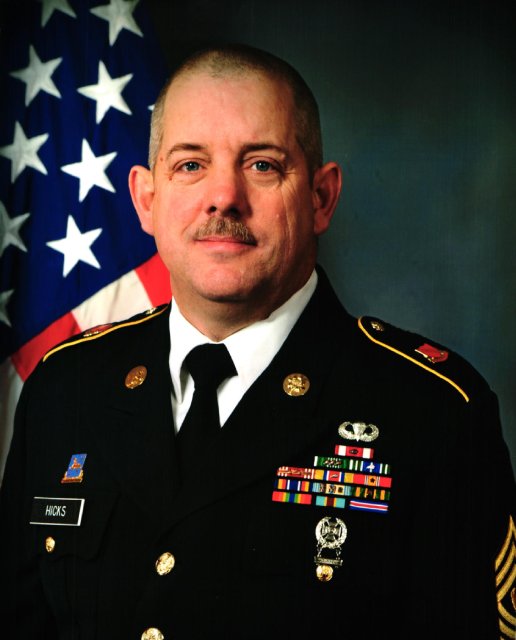
Joseph W. Hicks
G3/5/7, Headquarters, 100TH DIV (OS)
August 1982 – May 2022
CSM Joseph W. Hicks entered military service on 2 August 1982 and attended Basic Training at Ft Dix, NJ. During his initial 4-year enlistment, CSM Hicks served with the 163rd Military Intelligence Battalion, Ft. Hood, TX., and the 103rd Military Intelligence Battalion, Wurzburg, FRG. After completion of his active-duty enlistment, CSM Hicks joined the Alabama Army National Guard, 20th Special Forces Group, and deployed in 1991 in support of Operation Desert Storm. In 2000, CSM Hicks joined the New York Army National Guard 642nd Military Intelligence Battalion in Albany, NY.
CSM Hicks transferred to the USAR in 2002 with the 98th Division (IT), Rochester, NY. In 2004, CSM Hicks transferred to the 100th Division (IT) as the G2 NCOIC and mobilized in 2006 in support of Operation Iraqi Freedom to Ft. Benning, GA, where he was the chief instructor and Master Trainer for the Unmanned Aerial Vehicle until February 2010 when he returned to the 100th Division. In March 2014, CSM Hicks was assigned as CSM for 6th Battalion 108th Regiment (MI) at Ft. Bragg, NC. After his successful assignment as Battalion CSM, CSM Hicks was assigned as the G3 Operations SGM for the 100th Division G3 in 2017. In 2020, CSM Hicks transferred outside of the 100th Division for the first time in 18 years to the 1st Battalion 95th Regiment, Ft. Leonard Wood, MO, where he remained until his retirement in May 2022.
CSM Hicks is a graduate of the United States Army Sergeants Major Academy Non Residency Course, USAR Battalion Pre-Command Course, RQ11 (Raven) Operators Course, Signal Security Course (MOS 05G), USAR Quota Managers Course, Intelligence Course (MOS 98C), First Sergeant Course, Advanced and Basic Non Commissioned Officer Courses, Primary Leadership Development Course, USAR Security Managers Course and the Total Army Instructor Trainer Course.
CSM Hicks served as the 100th Division in civilian capacity as the Division Management Analyst from 2012 until 2022. CSM Hicks is an Association of the Century (AOC) Lifetime Member.
His awards and ribbons include: Meritorious Service Medal (2 OLC), Army Commendation Medal (3 OLC), Army Achievement Medal (1 Silver OLC), Good Conduct Medal, Army Reserve Component Achievement Medal (1 Silver OCL), National Defense Service Medal (1 Bronze Star), Global War on Terrorism Service Medal, Armed Forces Reserve Medal, (w/X/M Device 2), NCO Professional Development Ribbon (5), Army Service Ribbon, Army and Reserve Overseas Service Ribbons.
2022 – Inducted into the Corridor of the Century, Inductee # 127
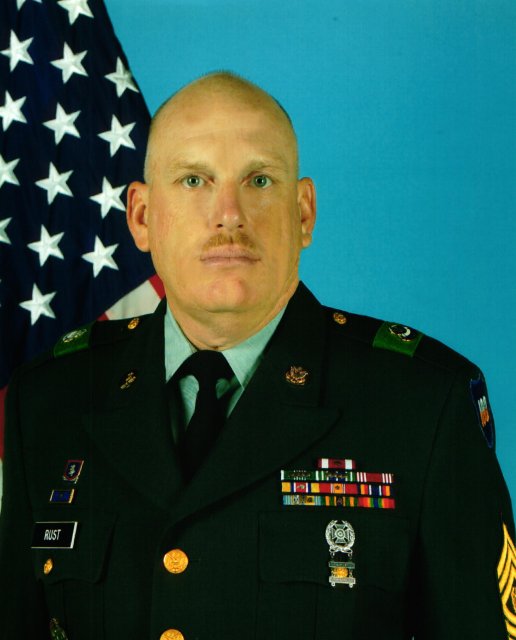
Daniel W. Rust
CSM, 2nd Brigade, 100TH DIV (OS)
April 1977 – June 2008
CSM Daniel W. Rust entered military service on 19 April 1977 in Madisonville, KY with the Kentucky National Guard, and completed Advanced Individual Training as an 19E armor crewman. After completing his initial 6-year enlistment, he was discharged as an SSG/E6 in April 1983. In August of 1983 CSM Rust enlisted in the USAR in Madisonville KY as a Tank Commander with the 2nd Battalion, 398th Regiment, 100th Division, and completed Drill Sergeant School in 1984. He was promoted to SFC/E7 in 1986 and became a Senior Drill sergeant and Platoon Sergeant. He became Acting First Sergeant of Company E, 3-398, 2nd Brigade in February 1988, and was promoted to First Sergeant of Company F, 3-398, 2nd Brigade in October 1998. He was active in recruiting and soon filled the company to 100 percent. He completed the First Sergeants Course in 1999.
CSM Rust was selected as the S3 Operations Sergeant for 2nd Brigade 100th Division in April 2003. He completed the Sergeants Major Academy in July 2004, was promoted to Sergeant Major and selected as CSM for 2nd Battalion, 340th Regiment, 4th Brigade, 85th Division. CSM Rust was selected as Brigade Command Sergeant Major for 2nd Brigade, 100th Division in October 2006, and retired as Brigade CSM in June 2008 with 30 years 9 months total service.
CSM Rust is a graduate of the United States Army Sergeants Major Academy Non Residency Course, USAR Battalion Pre-Command Course, First Sergeant Course, Advanced and Basic Non Commissioned Officer Courses, Primary Leadership Development Course,
CSM Rust mobilized with Task Force 100 in 1991 as a senior instructor, and again in 2004 with 2nd Battalion, 340th Regiment, 85th Division as part of Operation Enduring Freedom training mobilized units for Iraq and Afghanistan.
CSM Rust is an Association of the Century (AOC) Lifetime Member.
His awards and ribbons include the Legion of Merit, Meritorious Service Medal (2 OLC), Army Commendation Medal (4 OLC), Army Achievement Medal (4 OLC), Good Conduct Medal, Army Reserve Component Achievement Medal (8 OLC), National Defense Service Medal (2 M devices), Global War on Terrorism Service Medal, NCO Professional Development Ribbon (4), Army Service Ribbon, Drill Sergeant Badge.
2022 – Inducted into the Corridor of the Century, Inductee # 128
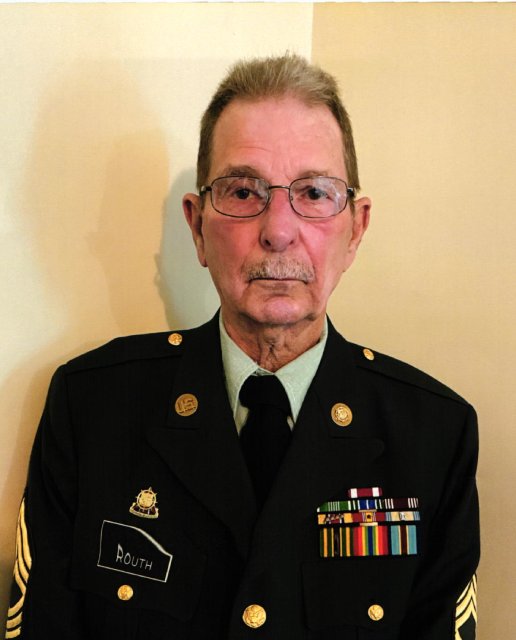
Robert L. Routh
Operations NCO, MTC, 100TH DIV
December 1961 – April 2001
MSG Robert L. Routh entered military service in December 1961 and completed Advanced Individual Training in 1962 as a Radio Teletype Operator at Camp McCoy WI. He was assigned to 5th Infantry Division (Mech), Ft Carson, CO, as a Radio Telegraph Operation with a Top Secret Clearance. MSG Routh was assigned in August 1963 to U.S. Army Europe in Greece, to 5/58th Artillery Group through December 1964 when he was promoted to SP4. After completing his initial active-duty enlistment, he was discharged in November 1967 and assigned to the Inactive Reserve.
MSG Routh joined the 100th Division, USAR in the Maneuver Training Command Transportation Team in 1982 and promoted to SP5. MSG Routh served as Team OPFOR NCO, Operations SGT, OPFOR Intelligence SGT, He completed Basic and Advanced NCO Courses, Traffic Management and Truck Master Schools, NBC and Intelligence Courses, and Resource Management Course. After promotion to SFC, MSG Routh was assigned as Team OPFOR NCO, Operations NCO, and Observer Controller. He continued for 5 successful years of conducting many unit Lanes Training Exercises, ARTEP, CPX, and FTX exercises. MSG Routh was cited for his logistics innovation and enlisted leadership during these readiness exercises.
MSG Routh also served on the MTC M1 Team as NCOIC and as the MTC CSS Group Training NCO. Upon the 100th MTC Reorganization in 1993, MSG Routh was assigned as NCOIC for 3rd Battalion, 345th Regiment 87th Division at Ft Knox, and promoted in 1995 as Master Sergeant. He was assigned in 1996 as NCOIC for Transportation Team III in 3rd Battalion, 337th Regiment, 85th Division, until he retired in April 2001, completing 24 years of dedicated service.
MSG Routh is an Association of the Century (AOC) Lifetime Member.
His awards and ribbons include the Meritorious Service Medal, Army Commendation Medal, Army Achievement Medal, Good Conduct Medal, Army Reserve Component Achievement Medal (3 OLC), National Defense Service Medal, Armed Forces Reserve Medal, Overseas Service Ribbon, Army Service Ribbon, NCO Professional Service Ribbon (3OLC).
2022 – Inducted into the Corridor of the Century, Inductee # 129
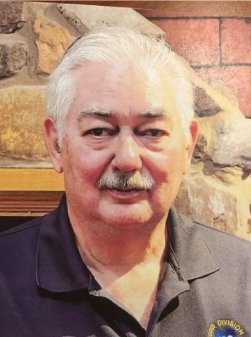
Horace F. Johnson
LTC Horace F. Johnson enlisted in the United States Army in the Spring of 1965. After completing his initial training at Fort Jackson and Fort Gordon, he was assigned to the 8th Army in South Korea. This was a critical assignment during the Vietnam conflict, as South Korea was a key ally of the United States in the region. While serving in Korea, his primary responsibility was Military Intelligence and high security communications.
Johson’s later assignment to Germany provided him with extensive opportunities to continue and refine his skills and experience as a Military intelligence specialist. After completing his active-duty service in 1970, Johnson returned to Bowling Green Kentucky where he joined the Kentucky National Guard and enrolled in Western Kentucky University.
While serving in the Guard, Johnson was chosen to attend the Army National Guard Officer Candidate school and was commissioned as a 2nd lieutenant in 1977. After serving the National Guard for more than 15 years, Johnson elected to transfer to the 100th Division 7th Brigade, 2399 Regiment, at Fort Knox Kentucky. During his tenure at the 2-399th, he served as the assistant Battalion S3 and was instrumental in planning and executing ROTC support missions, range training exercises, and logistical coordination with 3-81 Armor, the active component partner for 2-399.
Johnson’s success at the battalion level presented him with the opportunity to be recognized by the 7th Brigade S3. His consistent diligence for organization at the battalion level let him be subsequently selected and assigned to the Operations cell of the 7th Brigade S3 at Fort Knox. While serving within the brigade S3, his responsibilities focused on planning and coordination of battalion missions while concurrently overseeing the brigade budgeting process. His understanding of logistics was invaluable as the Brigade moved to ever-changing mission requirements with reduced budgets.
In 1999 Johnson was promoted to Lieutenant Colonel and was assigned as the Deputy Chief-of Staff G4 at Division Headquarters. While serving in the G4, he made significant contributions to the evaluation and refinement of logistical processes in support the Division’s Total Army Schol System missions. Johnson retired from the USAR in 2002.
LTC Johnson’s awards and decorations include:
Meritorious Service Medal (2nd award)
Army Commendation Medal
Army Achievement Medal
Good Conduct Medal
Army Reserve Component Achievement Medal (4th award)
National Defense Service Medal (2nd award)
Armed Forces Expeditionary Medal
Amy Service Ribbon
Army Overseas Ribbon
2023 Corridor of the Century Inductee # 130
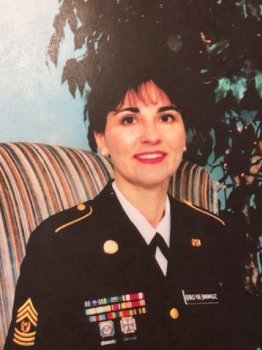
Joyce Summerford
SGM Summerford enlisted in the Active Army in June 1976. She attended Basic Combat Training (BCT) and Advanced Individual Training (AIT) at Fort Jackson, S.C. Upon completion of training, she was awarded the Military Occupational Specialty (MOS) 7 IL, Administrative Specialist; she was also awarded 73C, Finance Specialist and the H instructor designation. After serving three years on Active Duty, she enlisted in the Arizona Army National Guard and US Army Reserve.
ACTIVE-DUTY ASSIGNMENTS: 71L, Office of the Chief of staff, Headquarters, Fort Jackson, SC; 7 IL, 169th Signal Company, Taegu, Korea; 7 IL, US Army Communications Electronics Engineering Installation Agency, Fort Huachuca, AZ RESERVE AND NATIONAL GUARD ASSIGNMENTS: 7 IL, 403rd Combat Support Hospital, Phoenix, AZ; 73C, 158TH Finance Section, Phoenix, AZ, Instructor- 11B, Primary Leadership Development Course 3388th USAF School, Tampa, FL, Noncommissioned Officer Education System (NCOES) Director, 3388th USARF School, Tampa, FL, Managers’ Internal Control Program, 143rd Transportation Command, Orlando, FL; CSM, 439th Medical Battalion, Memphis, TN, CSM, 2145th Garrison Support, Nashville, TN; Operations Sergeant Major, G-3, 100th Training Division, Louisville, Kentucky; Sergeant Major, G-1, 100th Training Division, Louisville, Kentucky
EDUCATION: Doctorate in Human Services with a Specialization in Healthcare Administration from Capella University; Master of Business Administration from Webster University; Bachelor of Science in Accounting from Arizona State University; Certified in Healthcare Compliance, Certified in Privacy Compliance from Health Care Compliance Association
Military education includes United States Army Sergeant Major Course, United States Army Command Sergeant Major Course, ANCOC, BNCOC, First Sergeant Course, NCO Academy, ARNG Retention Training, and Administrative Specialist Course.
As the Chief Enlisted person in the G3 section, SGM Summerford showed the professionalism needed to supervise that section. During her tenure there, she supervised and coordinated training of soldiers throughout the Division during the Iraq Campaign. Her efforts enhanced the soldiers’ readiness within the Division. She was instrumental in the deployment and training prior to that operation. SGM Summerford also was the SGM of the Gl 100th Division HHD during crucial periods of reorganization of the Division. Her guidance enhanced a smooth transition during that time.
SGM Summerford resides in Louisville Kentucky, and currently works at Prestige Healthcare Management. SGM Summerford is an avid supporter of the Association of the Century and is a life member.
AWARDS: Meritorious Service Medal, Army Commendation Medal with I Oak Leaf Cluster, Army Achievement Medal, Army Good Conduct Medal, Army Reserve Component Achievement Medal, Armed Forces Reserve Medal, NCO Development Ribbon with numeral 4, Army Service Ribbon, Army Overseas Service Ribbon, Meh Badge w/dvr Bar Device
2023 Corridor of the Century Inductee # 131
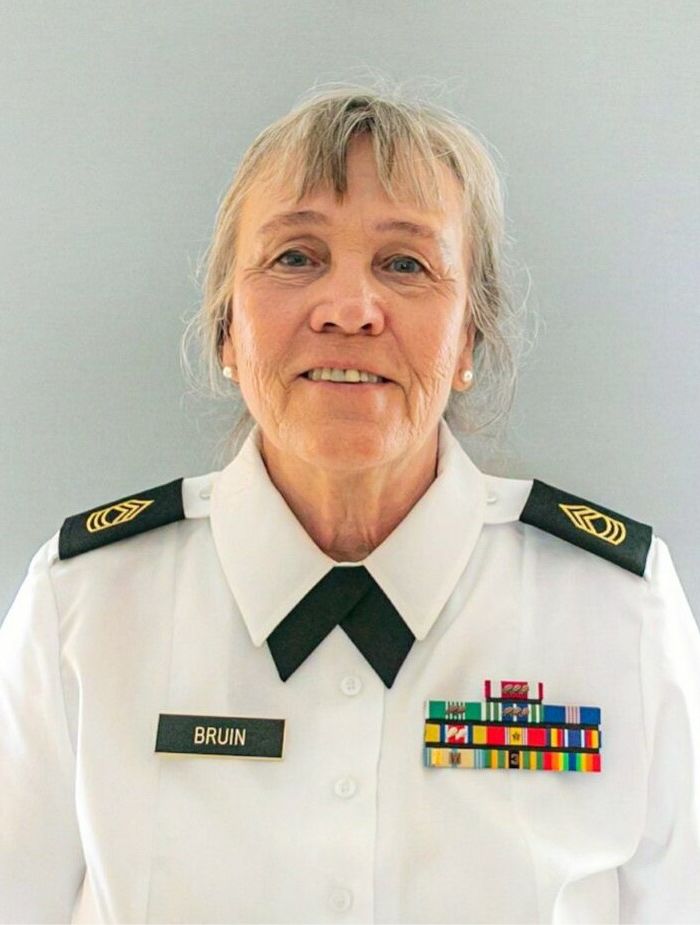
Linda S. Bruin
MSG Linda S Bruin entered military service on 5 August 1977, assigned to 2nd Squadron, 302d Cavalry, 3rd Brigade, 100th Division (Tng), as a legal clerk, completed basic training at Fort Jackson, SC transferred to Fort Benjamin Harrison IN. Due to a Division restructure was realigned as a clerk typist and went back to Fort Jackson, SC to complete training. Served as a unit clerk until 1985.
Reclassified to 76Y in 1985 serving in a troop until 1989. Promoted to Squadron Supply in 1989 and served at that level until 1994, at that time the Squadron was deactivated. In 1994 was reassigned to 1 st Squadron, 302d Cavalry, 1 st Brigade, 100th Division for a brief period.
Oct 1994 was reassigned as Chief Supply Sergeant to HHC 100th Division Training. Served in the 100th Division G-4, working on the Command Supply Discipline Team from 1994 until 2003. Validating Brigade Property Books and consolidation of logistical reports for the command elements. Acting SGM on multiple occasions in the absence of assigned SGM.
Mobilized with 2-100 MP 100th Division TASS Battalion from Oct 2003 until May 2005, as BN Supply Sergeant, reclassifying provisional military police officers, for CONUS and OCONUS assignments. Unit reclassified two Battalion’s per state as well as conducting SQI and ASI training for all Army components.
Activated in March 2006 and 2007 to transfer BCTC and incoming TASS unit property books to and from the 100th Division due to realignments.
Mobilized to the 100th Division G-3 from 2008 and 2009, serving as the Mobilization NCO, during Enduring Freedom. Served as a Human Resource NCO in the G-1 from 2009 until 2010.
Reclassified to 92G Food Service Specialist in 2011, conducted instruction too, and inspection for subordinate units in all areas for food service. Conducted unit site visits in support of contract negotiations for 100th Division schools. NCOIC for the G-4 in all personnel areas. Monitored all 100th Division KYLOC activities.
Retired 31 November 2013 with 36 years and 3 months of service as a Master Sergeant.
Served on the Association of the Century (AOC) Board since 2015, and a Life Member.
MSG Bruin currently resides in Georgetown, KY works part-time at Kroger’s, is actively involved in church, and enjoys working with occasion Samaritans Purse when the occasion arises.
Awards and Decorations include the following:
Army Service Ribbon
NCO Prof Development Ribbon with 3 Device
Armed Forces Reserve Medal with Gold Hourglass and M Device
Army Achievement Medal Ribbon for Civilian Service
National Defense Service Medal with Bronze Star Device
Army Reserve Components Achievement Medal with two Silver Clusters
Global War on Terrorism Service Medal
Army Achievement Medal with 3 Oak Leaf Clusters
Army Commendation with two Oak Leaf Clusters
2023 Corridor of the Century Inductee # 132
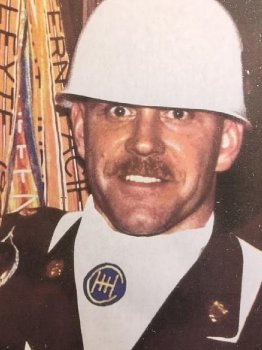
Michael Lyall
Sergeant Mike Lyall enlisted in the US Army in August 1971. He completed Basic Training at Fort Dix, NJ, and was promoted to PV2. He was transferred to Fort Sill, OK, for Advanced Individual Training in Field Artillery in 105 and 155 Howitzers.
Following 10 weeks of training, PV2 Lyall was transferred to the 28th Field Artillery in Auschwitz, Germany, in January 1972. Due to his administrative skills, he was reassigned as Company Clerk and awarded MOS 71H10. Alpha Battery, 2/28th Field Artillery was deployed to Vietnam in the spring of 1972 and completed a tour of duty. Specialist Mike Lyall completed 2 years of Active Duty and completed 4 years of Reserve Duty in August 1976.
Specialist 4 Mike Lyall reenlisted in the Army Reserve with HHC, 100th Division in 1987. He served in multiple assignments within HHC, including driving for the Commanding General. Within his assignments in the G4, SGT Lyall assisted in many logistical maintenance projects, and office realignments. He continually volunteered to assist in any supply and logistical tasks that could use his valued skills. One of SGT Lyall’s accomplishments was performing on the HHC Color Guard where he presented Colors to many distinguished Officers and Guests. He also served on the Color Guard for General Norman Schwarzkopf on his visit to Louisville and the Kentucky Derby after the end of Desert Storm.
SGT Lyall is a Member of the Association of the Century.
Awards and Decorations include the following:
Army Service Ribbon, Army Achievement, Armed Forces Reserve Medal, Vietnam Service Medal, Armed Forces Expeditionary Medal, Army Overseas Ribbon
2023 Corridor of the Century Inductee # 133
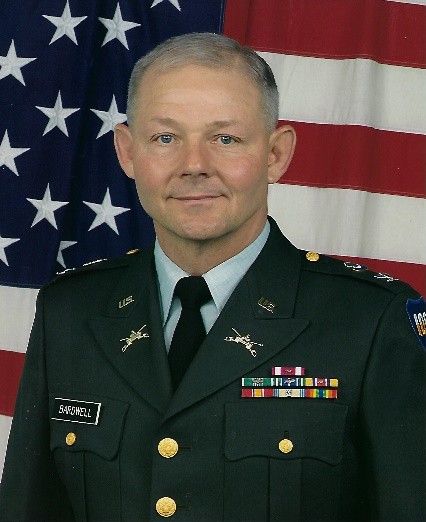
Newton R. Bardwell III
COL Newton Romey Bardwell, an ROTC Graduate at Murray State University was commissioned a second lieutenant, Armor in May 1973.
Upon successfully completing Armor/Cavalry Officer Basic Course at Fort Knox, KY he was assigned to Company B, 3d Battalion 399th Regiment, 2d Brigade 100 Div. For the next 25 years Col Bardwell served in various staff positions at 3d Battalion and 2D Brigade.
Col Bardwell command assignments included Commander; B Co 3d Bn 399’h Regt 2D Brigade; Commander 3d Battalion, 399th Regt 2D Brigade. ln December 1999 Col Bardwell was assigned to DCSOPS IET Officer, HHC, 10oth Division (lT). Col Bardwell’s final assignment was Commander 2D Brigade 100th Division from March 2001 to May 2003.
Col Bardwell retired May 2003 with 30 years of Army service. Col Bardwell was the only Armor officer in the Battalion at the time, his skill and expertise were essential as the unit underwent a mission change to Armor One Station Unit Training. He excelled as a Company Commander for four annual training periods and in the execution of two Field Training Exercises with 101i Air Assault during his command tenure. Examples of his varied staff responsibilities included orchestrating and coordinating the Division’s Tank Gunnery Commander’s Cup, Armor Pass in Review, and supervising five Field Exercises with the 101″t Air Assault.
He next served as Battalion Commander of 3’d Battalion 399th Regiment. His excellent leadership successfully brought the Battalion to the forefront as the best trained and most tactically proficient battalion within the 2d Brigade with an overall strength of 118%, Drill Sergeant strength of 115%, and MOSQ of 89%. Col Bardwell successfully commanded an lnitial Entry Training Brigade that expanded to four Battalions with units in Kentucky, Tennessee, Mississippi, and Alabama.
COL Bardwell is a Life Member of the Association of the Century.
ln civilian life Col Bardwell has spent 51 years as owner/operator of Bardwell Farms. He is Chairman of Christian County Conservation District with 20 plus years of service. He and his wife, Debbie farm with their son, Bradley. The Bardwell’s have been married for 49 years and have five grandsons.
Awards and Decorations include the following:
Legion of Merit, Meritorious Service Medal with 1 Oak Leaf Cluster, Army Commendation Medal with 2 Oak Leaf Clusters, Army Achievement Medal with 2 Oak Leaf Clusters, Army Reserve Component Achievement Medal Silver Oak Leaf Cluster, National Defense Service Medal, Armed Forces Medal with Hourglass Device, Army Service Ribbon, Physical Fitness Excellence Patch Armor Order of Saint George.
2024 Corridor of the Century Inductee #134.
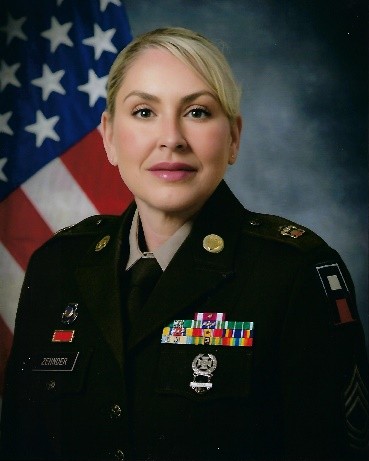
Kasey D. Zehnder
Master Sergeant Kasey Zehnder enlisted in the US Army in 1993 and completed Basic Combat Training and Advanced Individual Training, and was assigned to the 100th Reception Battalion as a clerk and administrative specialist. In 1996 she was assigned to the HHC, 7th Brigade, 100th Division, as processing NCO where she played a key role in supporting Drill Sergeants with training and mentoring new soldiers.
Master Sergeant Zehnder was a distinguished member of the 100th Division HHC Color Guard Team for several years, achieving recognition in multiple 100th Division Color Guard competitions.
In 2007, MSG Zehnder was hired as Unit Administrator for HQ, 100th Division, providing administrative services for 200 soldiers until 2015 when she was promoted to a position in budget planning.
MSG Zehnder was awarded the Patriot Award in 2008, and also became the Aide De Camp for BG Patricia Heritsch, and continued as Aide De Camp for BG Mark Arnold. MSG Zehnder ended her career with the 100th Division as Training NCO for Headquarters Company.
In 2014, MSG Zehnder was promoted to Master Sergeant in the 84th Training Command with Force Management, where she directly worked with US Army Reserve Command. In 2017, MSG Zehnder accepted the First Sergeant position for HHC, 84th Training Command leading 260 soldiers during the COVID restrictions and remote battle assemblies.
In 2021, MSG Zehnder transitioned to First Army Division East serving as G1 Pans and Operations NCO, and two years later became the G1 NCOIC, serving 4 Active Duty Combat Brigades, advising Division Command Staff on manning and productivity issues.
MSG Zehnder is a Life Member of the Association of the Century.
Awards and Decorations include the following:
Meritorious Service Medal w/OLC, Army Commendation Medal w/OLC, NCO Professional Development Ribbon, Army Service Ribbon, Army Reserve Component Achievement Medal, Armed Forces Reserve Medal
2024 Corridor of the Century Inductee # 135

